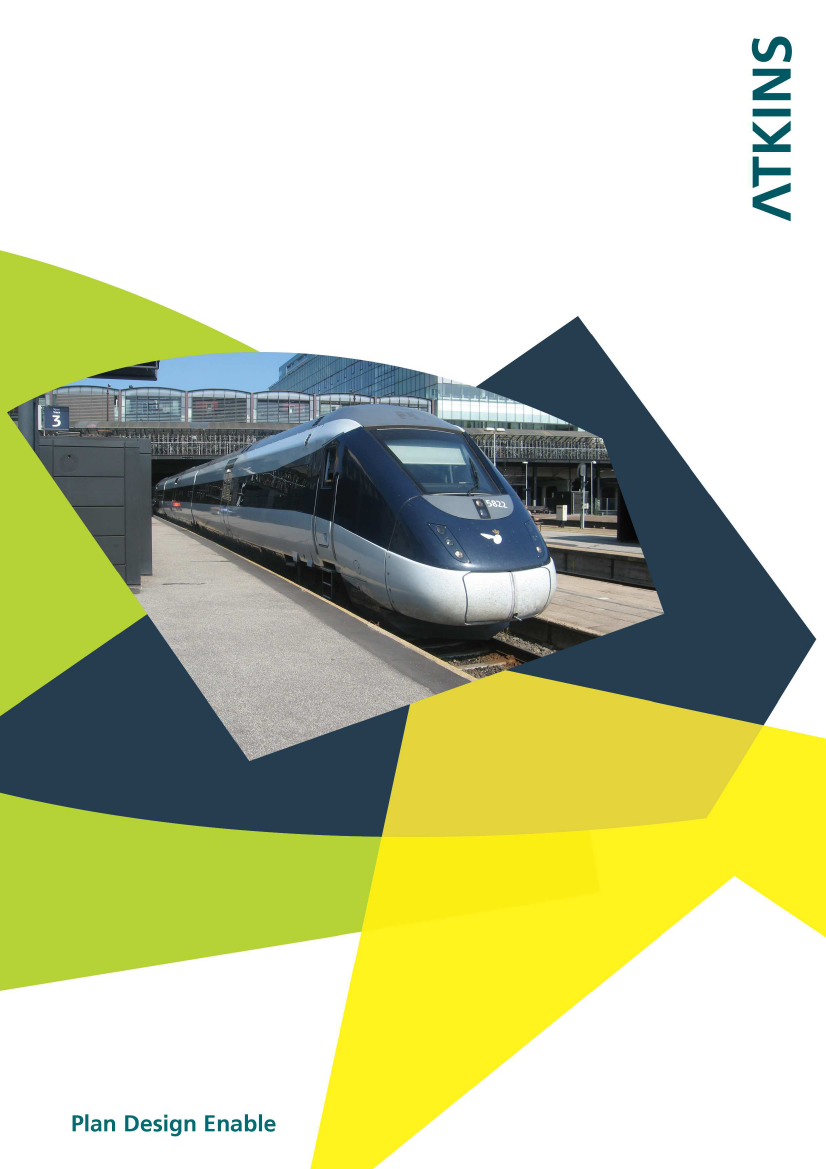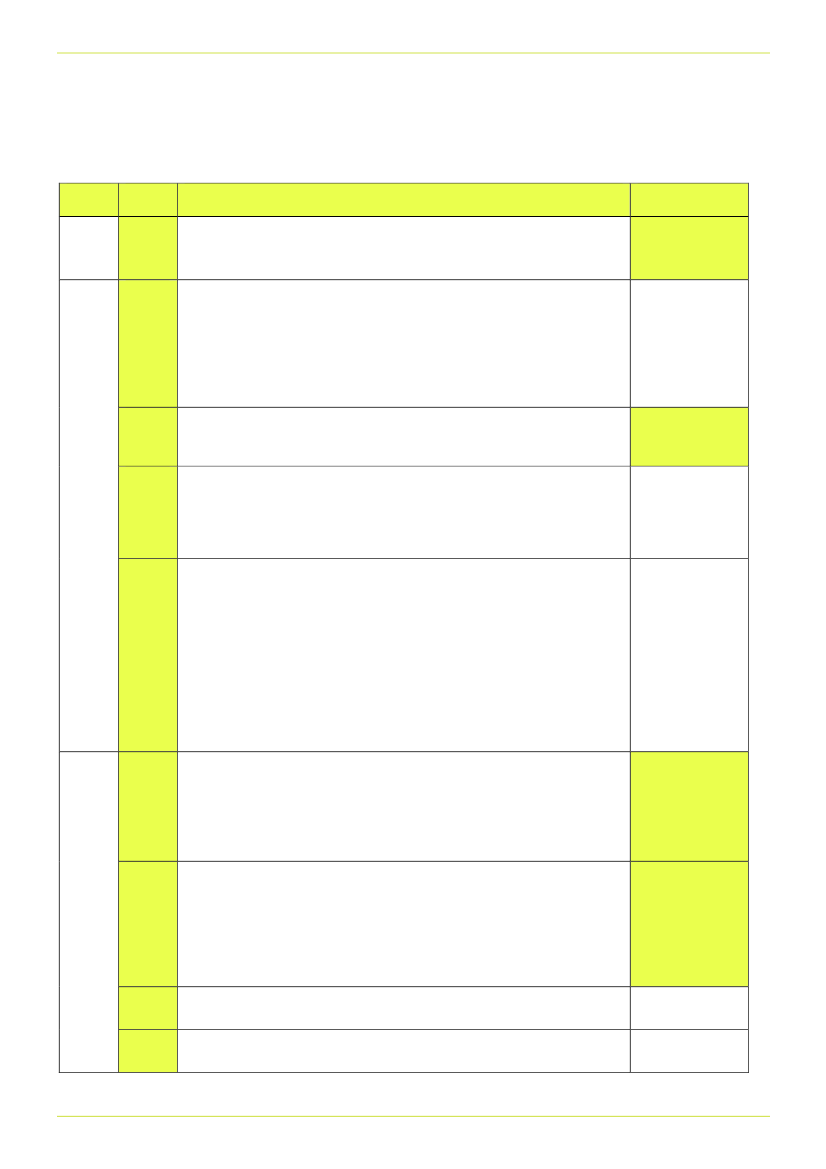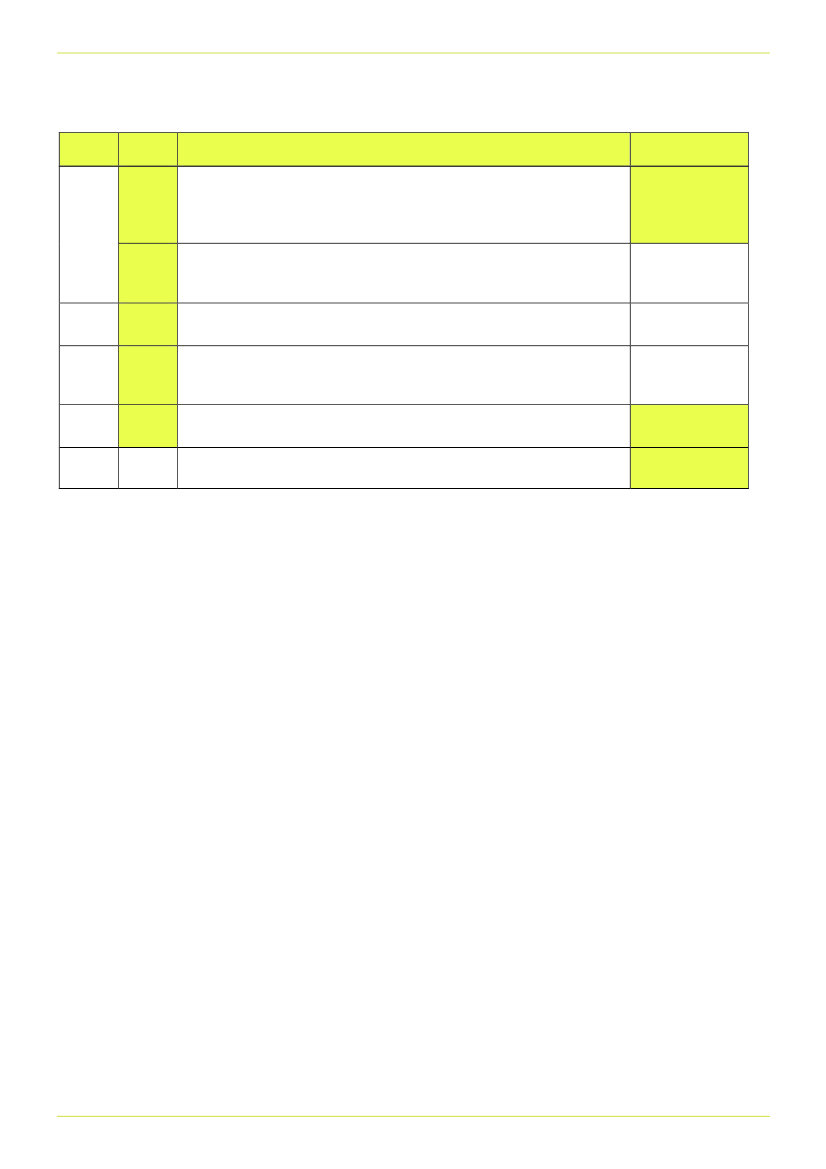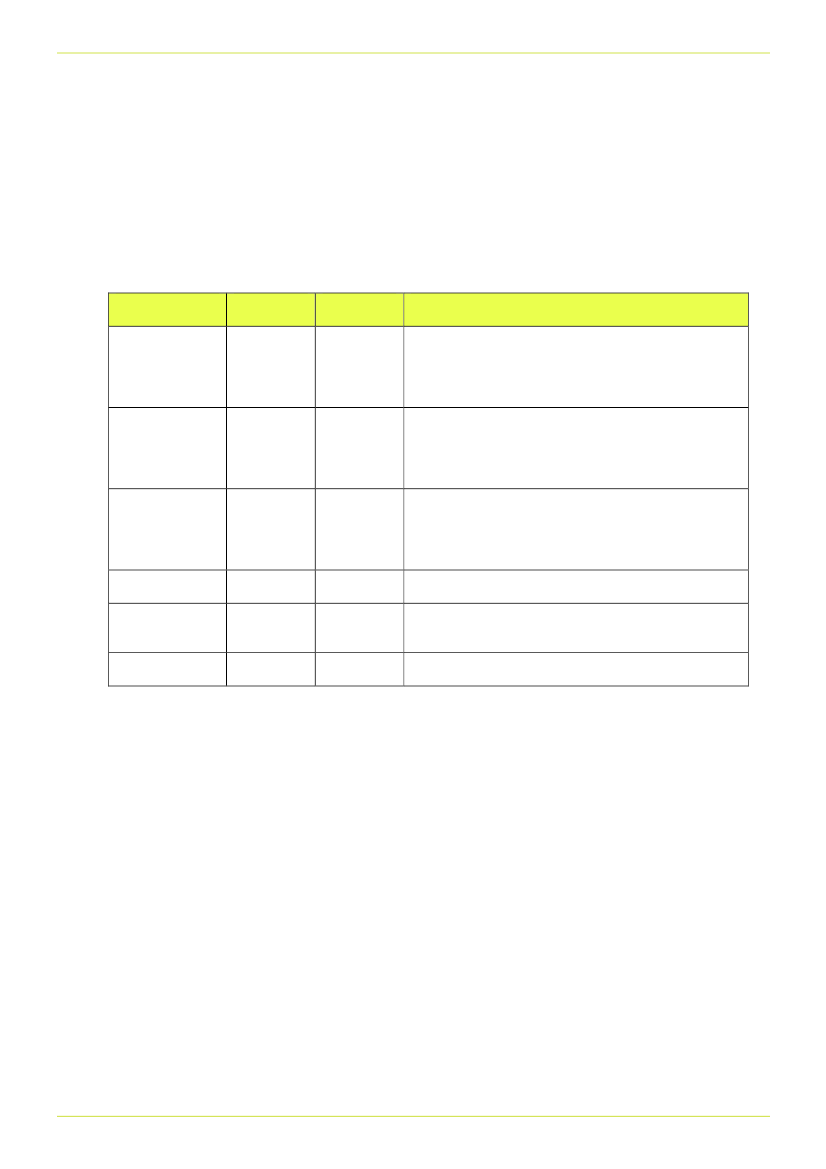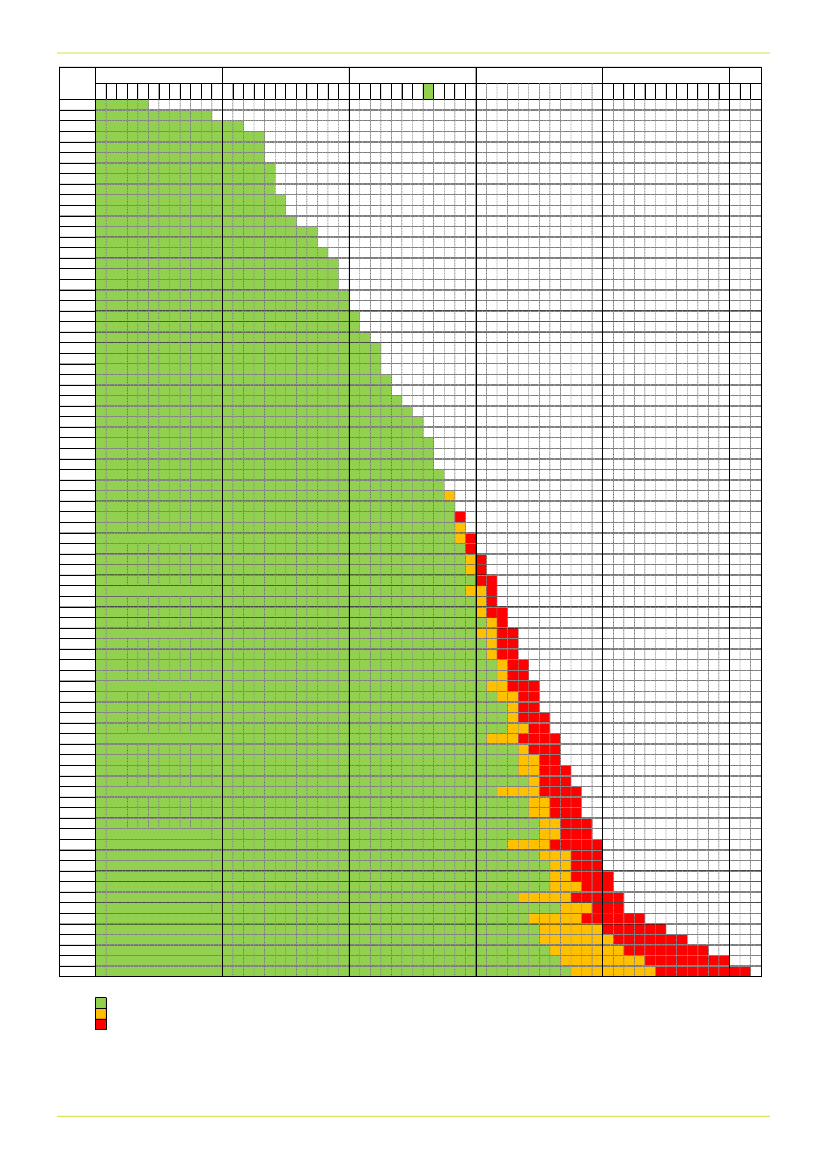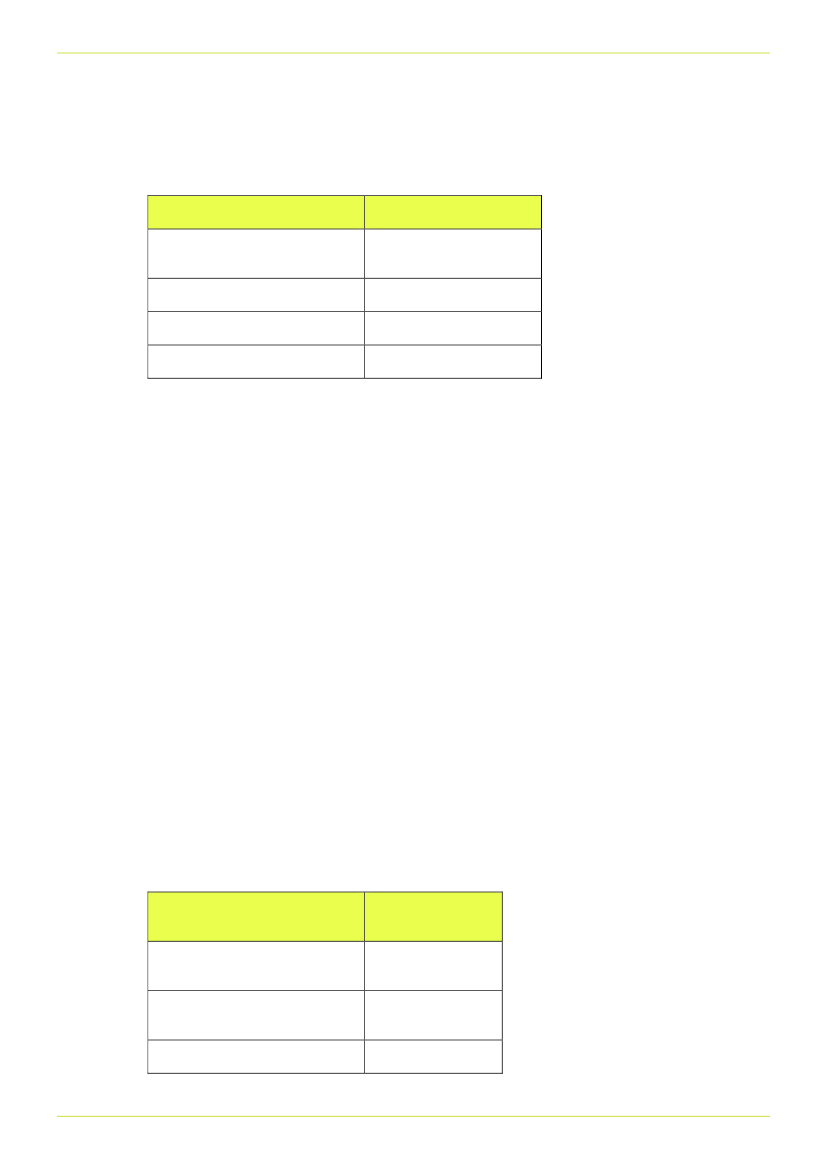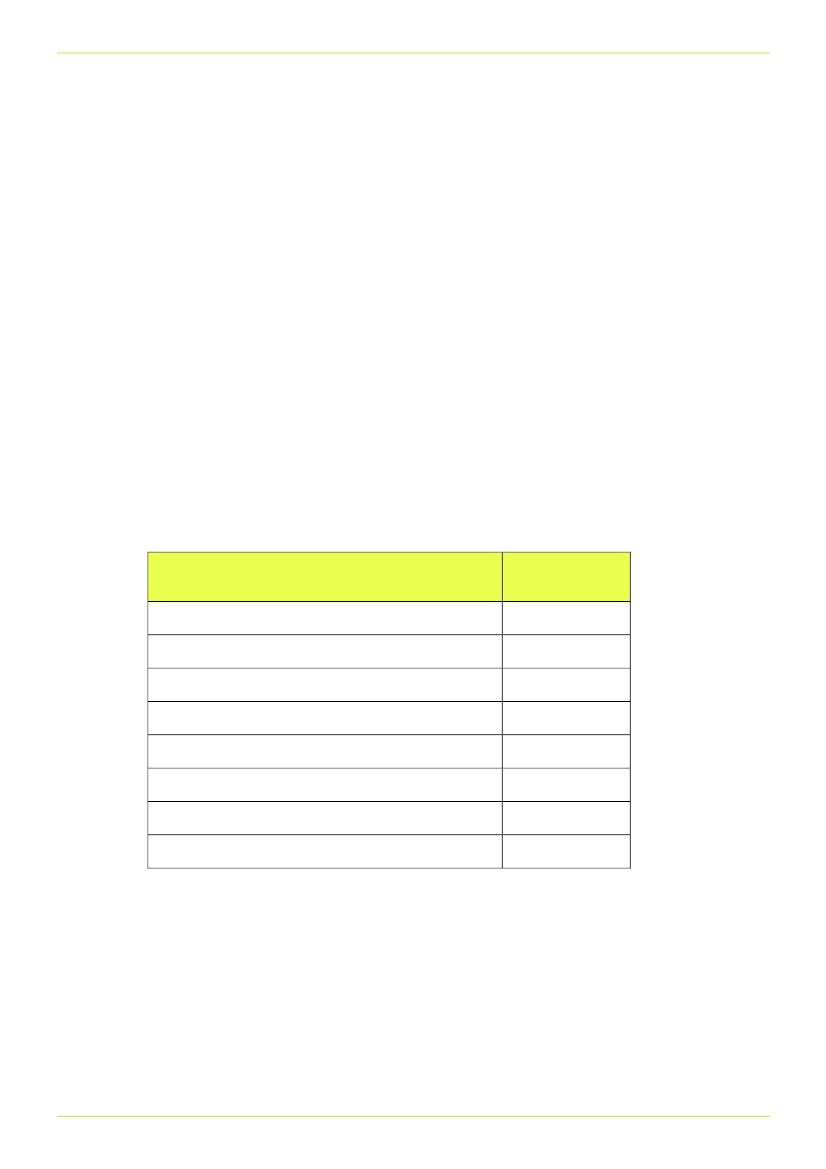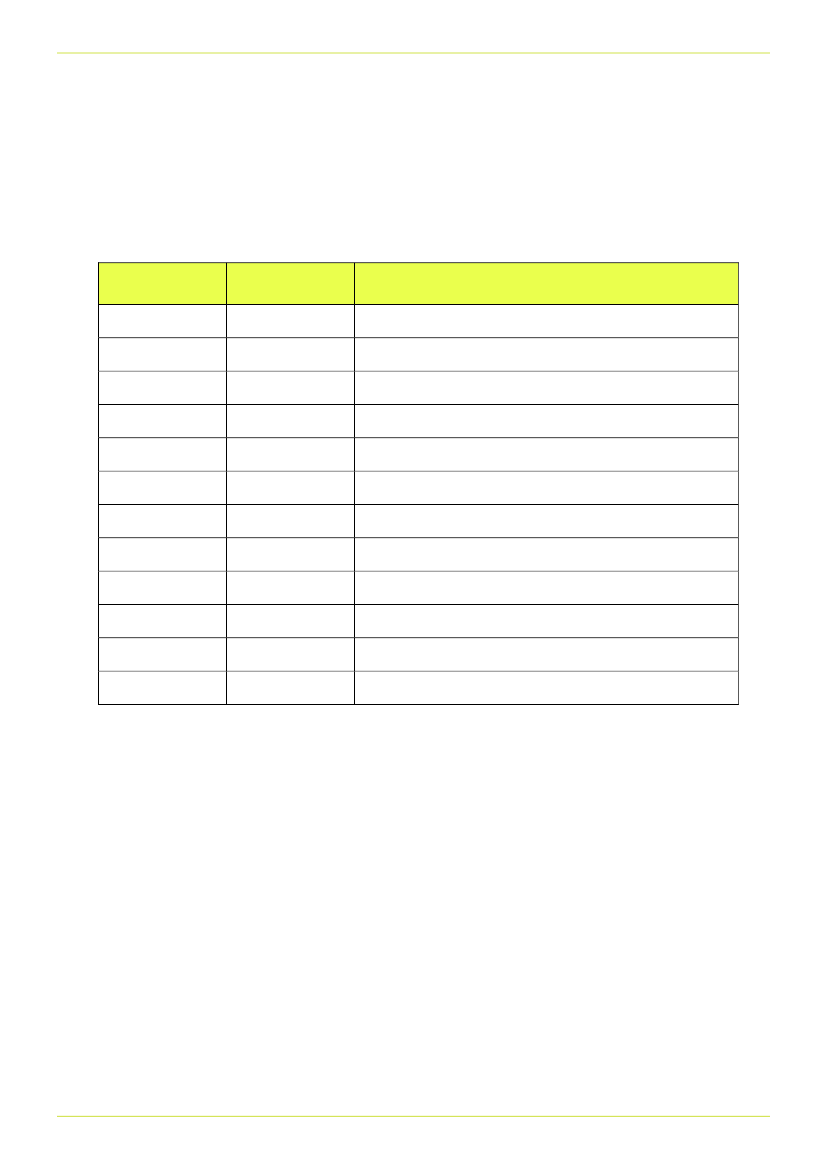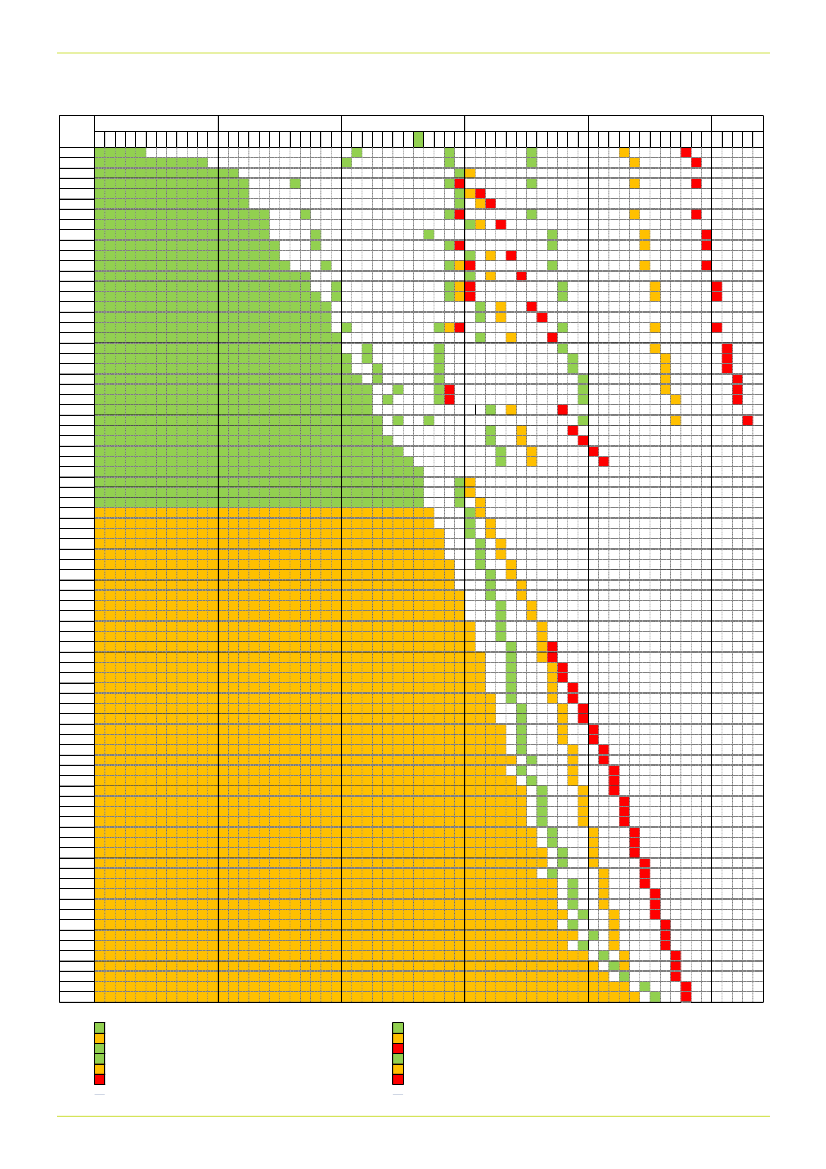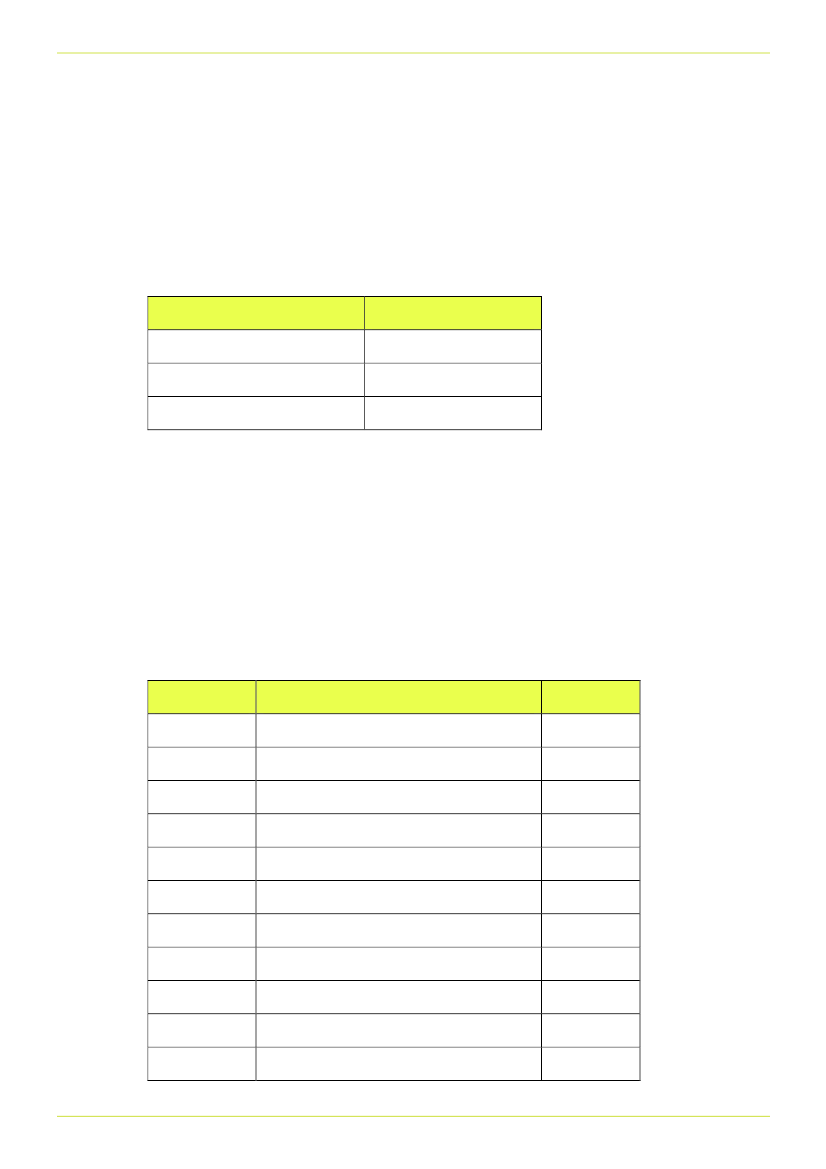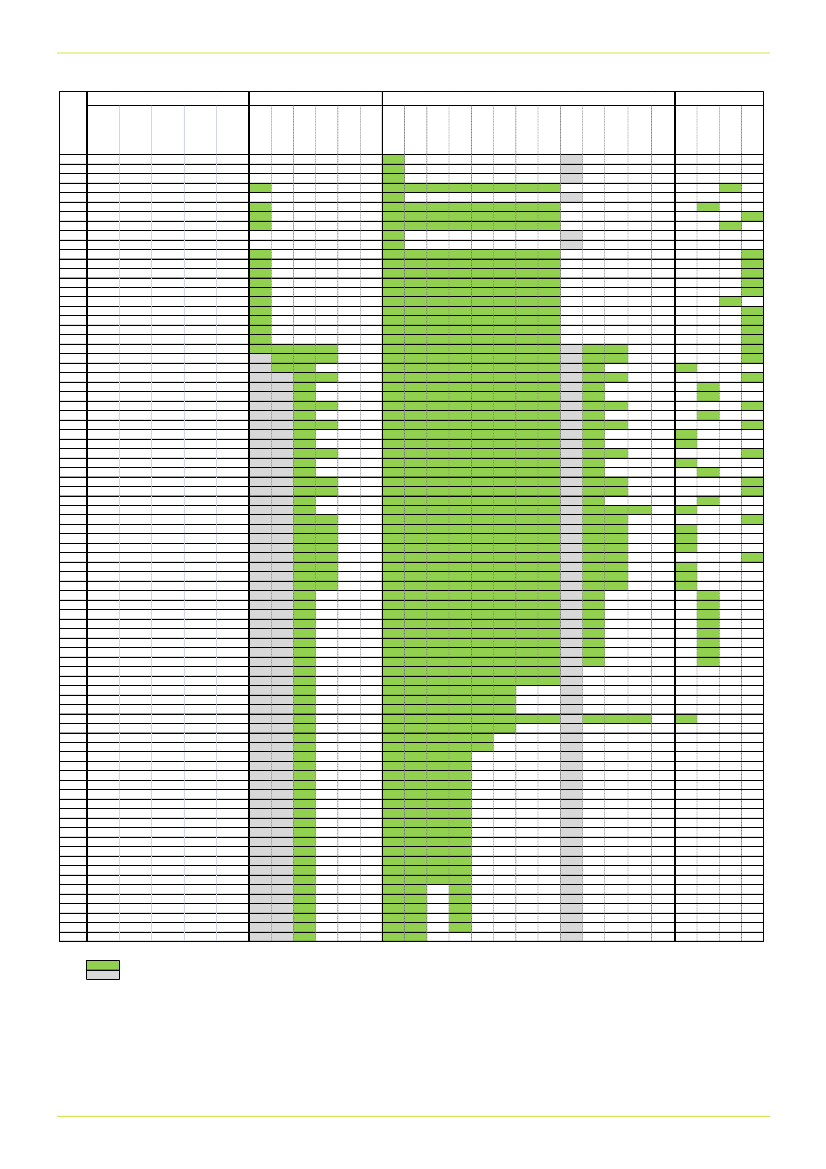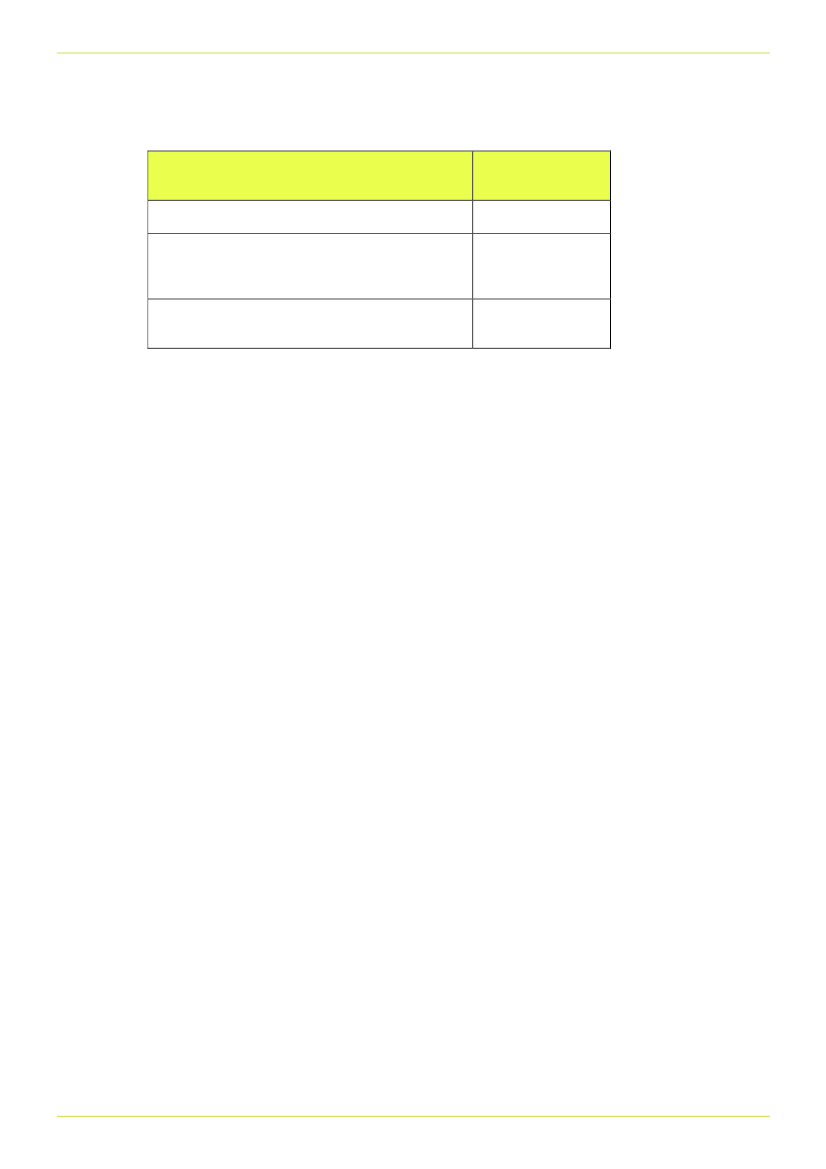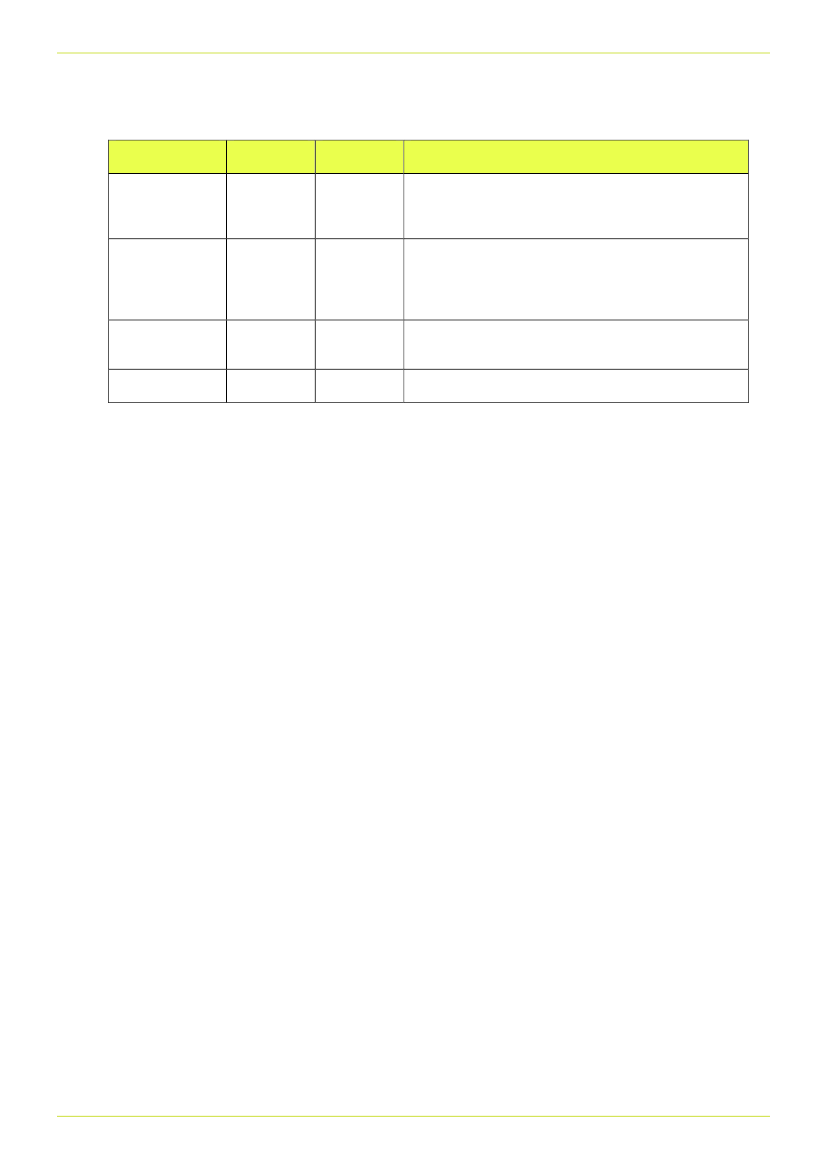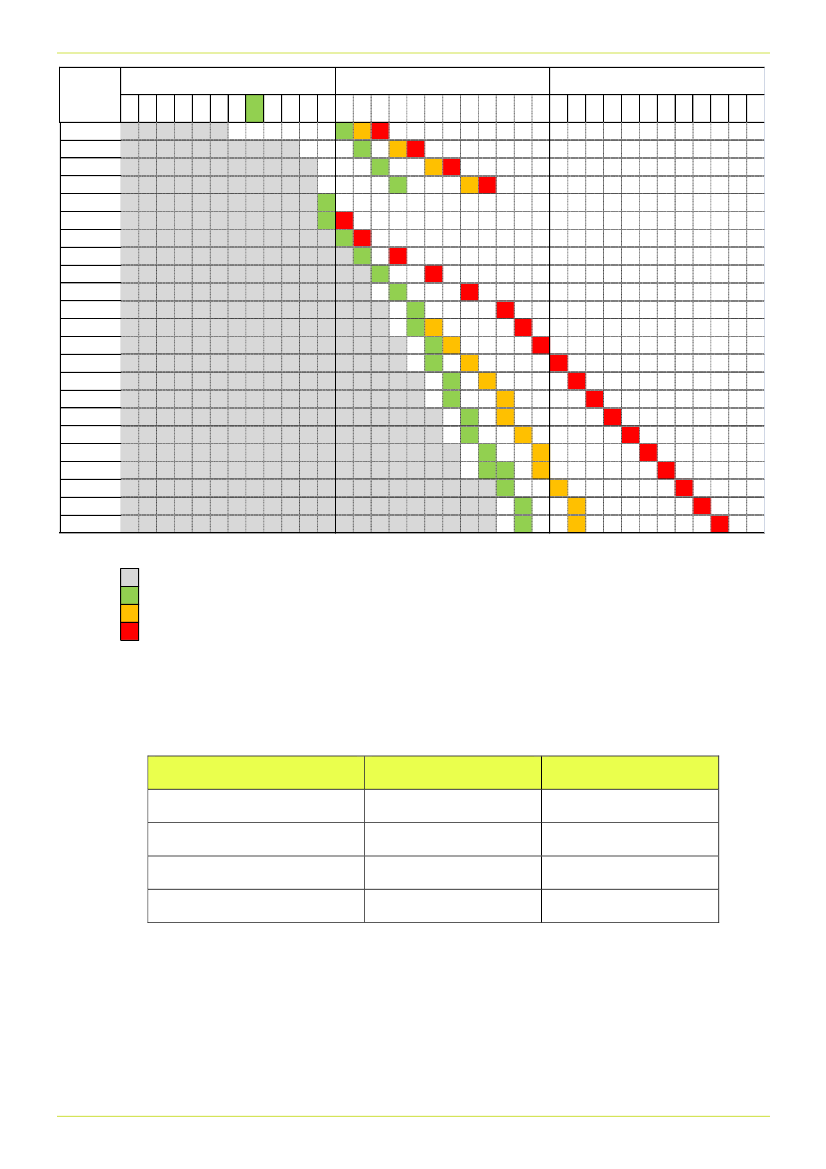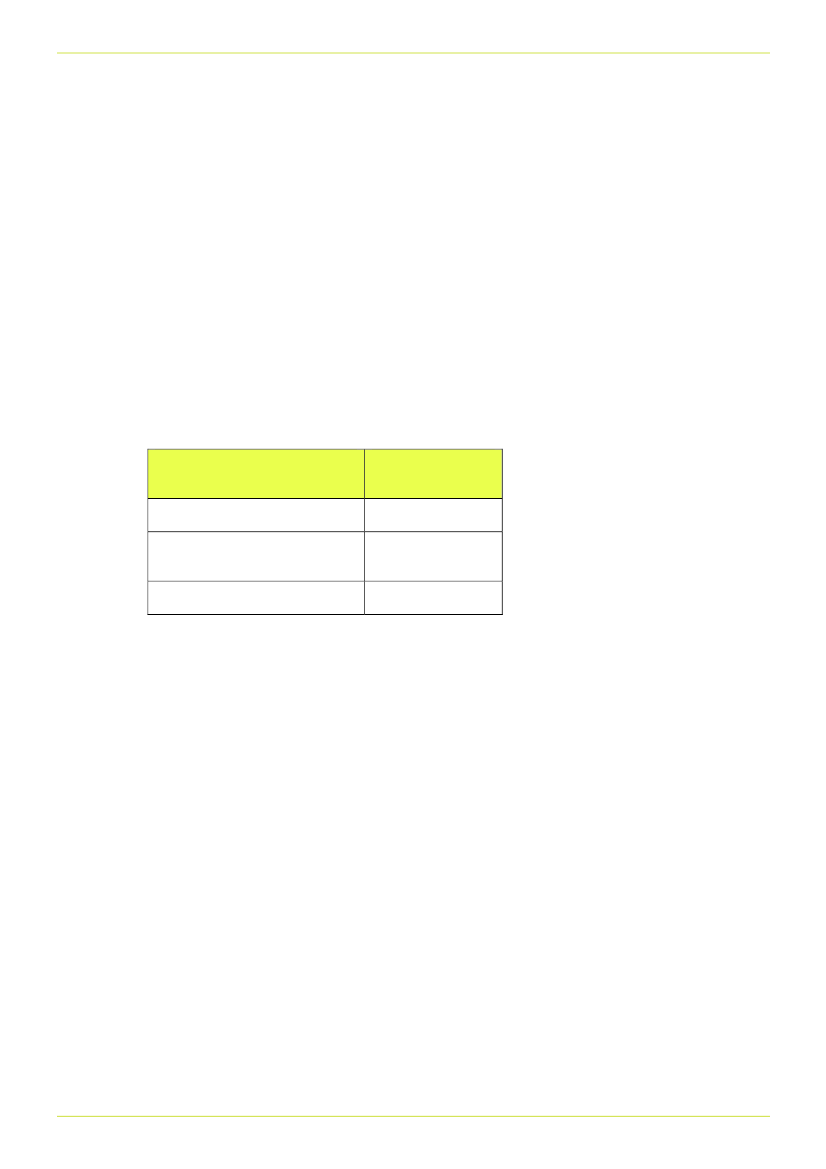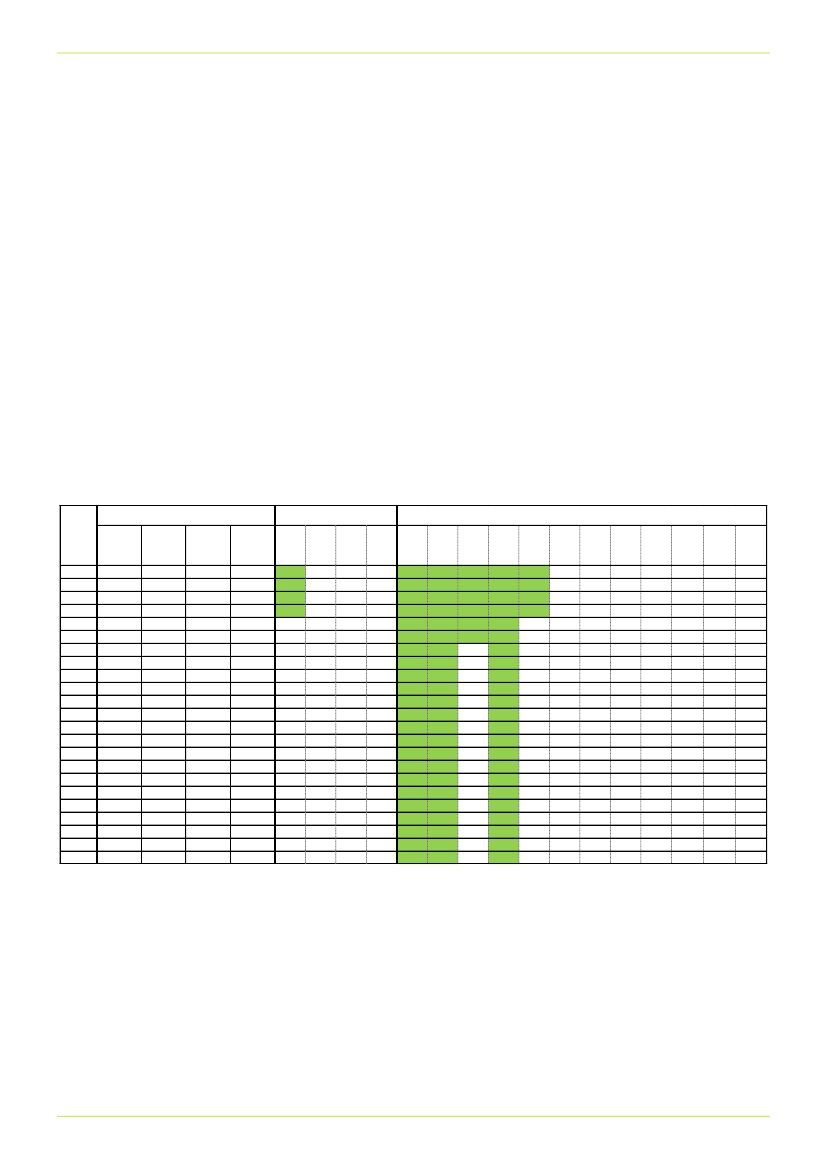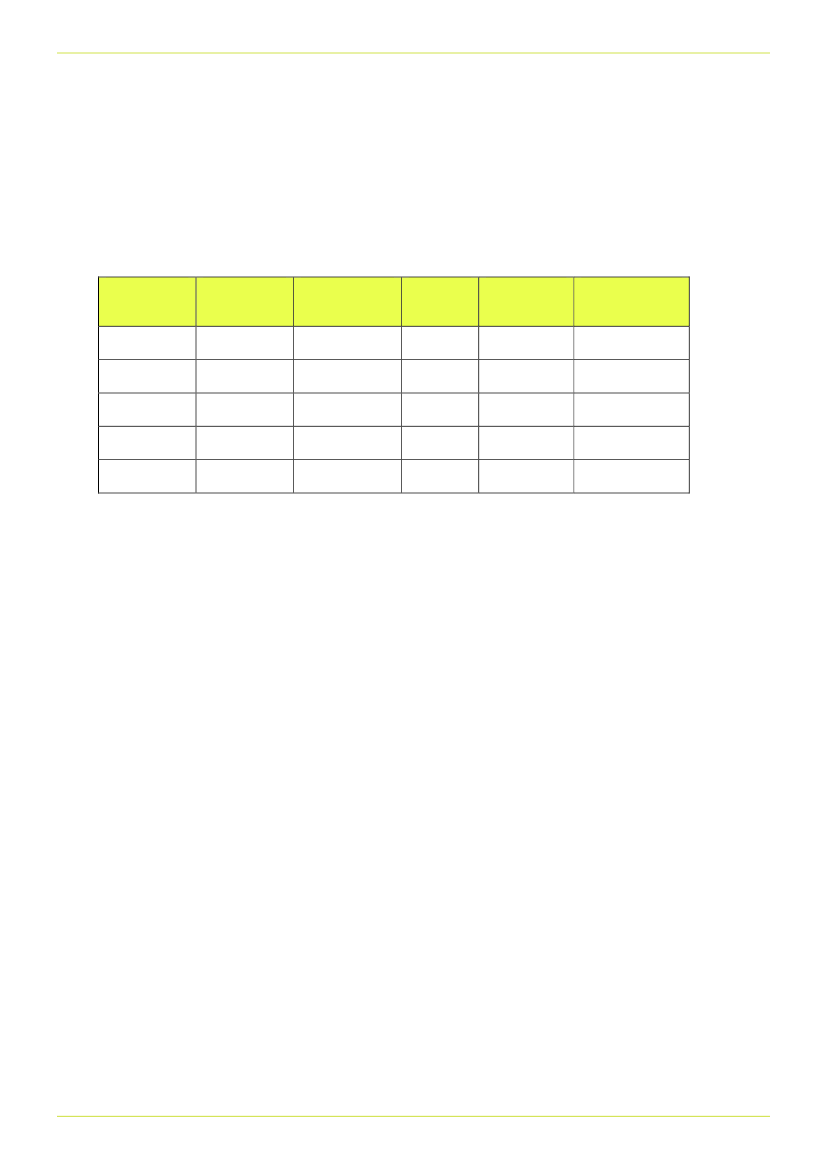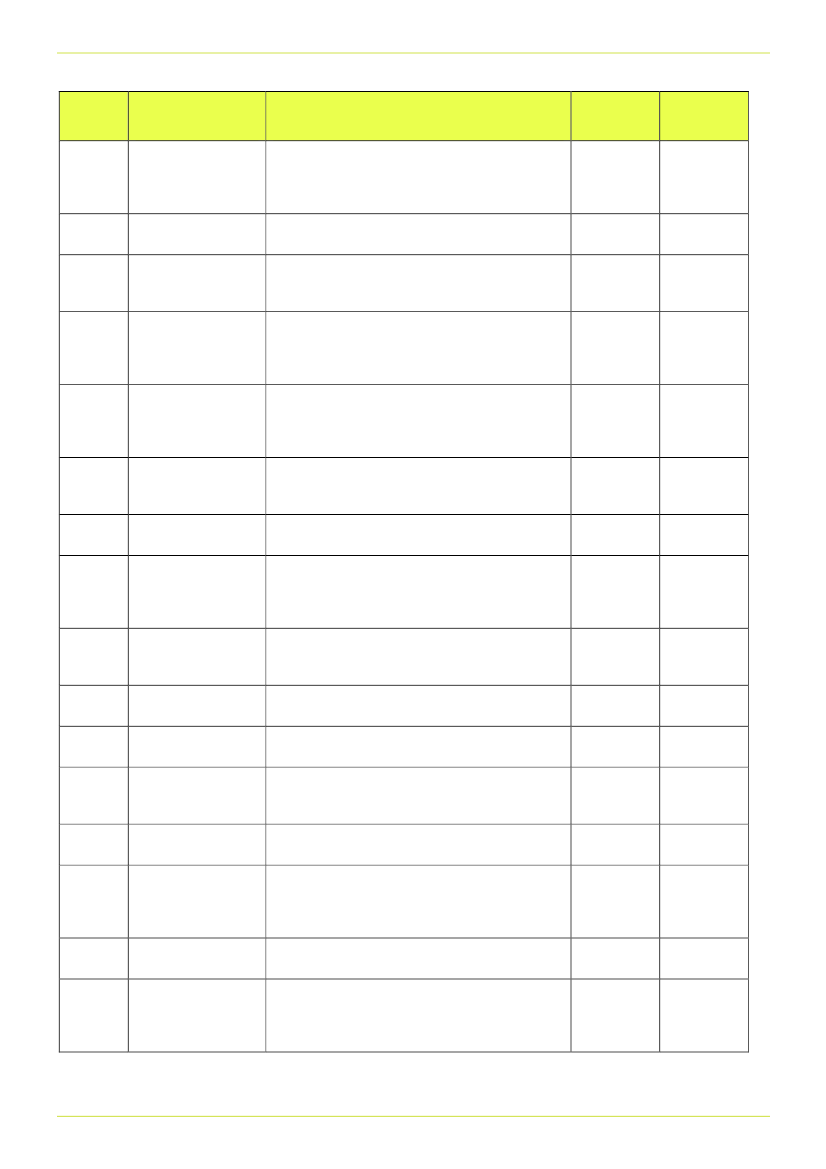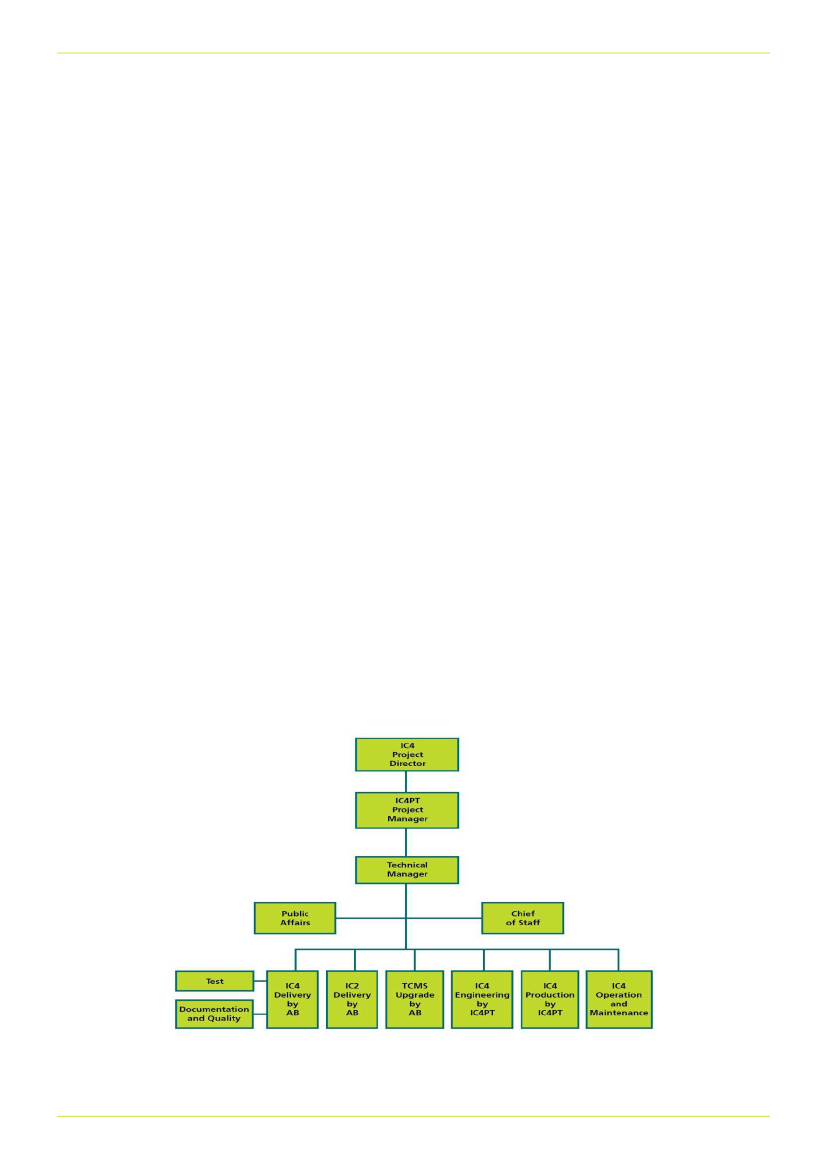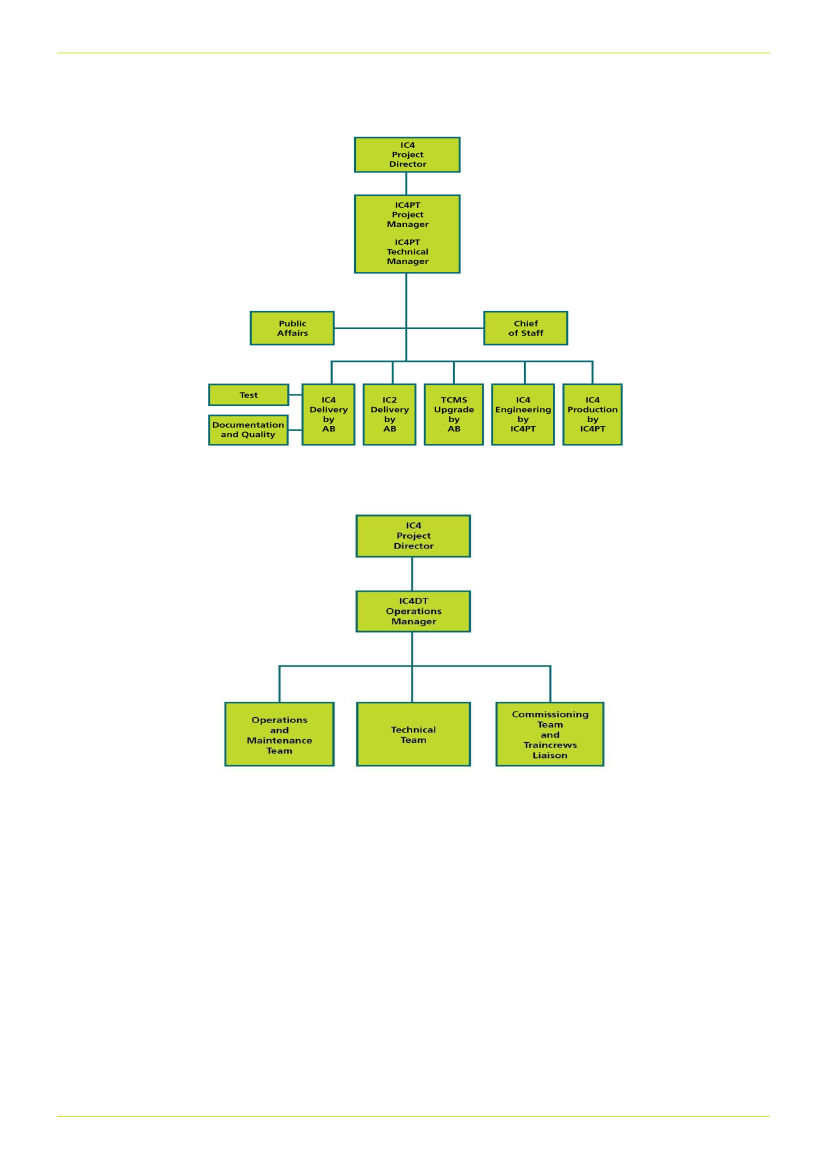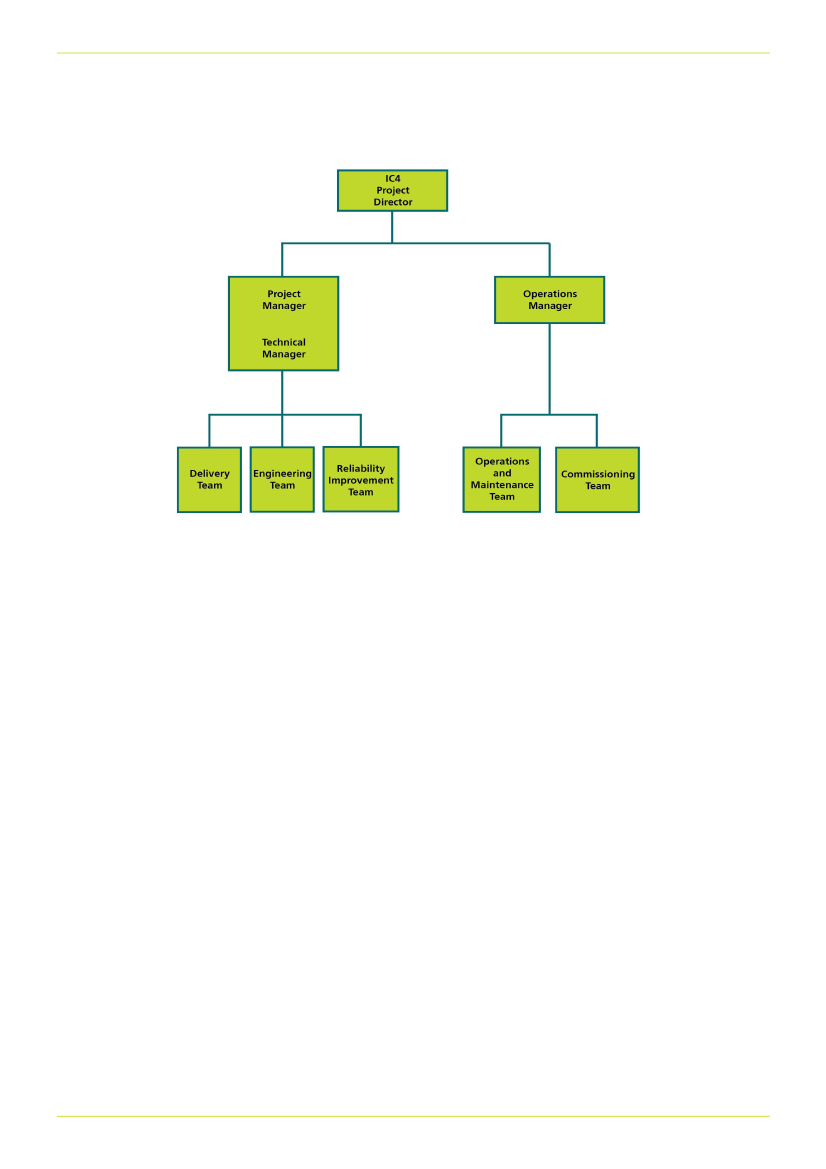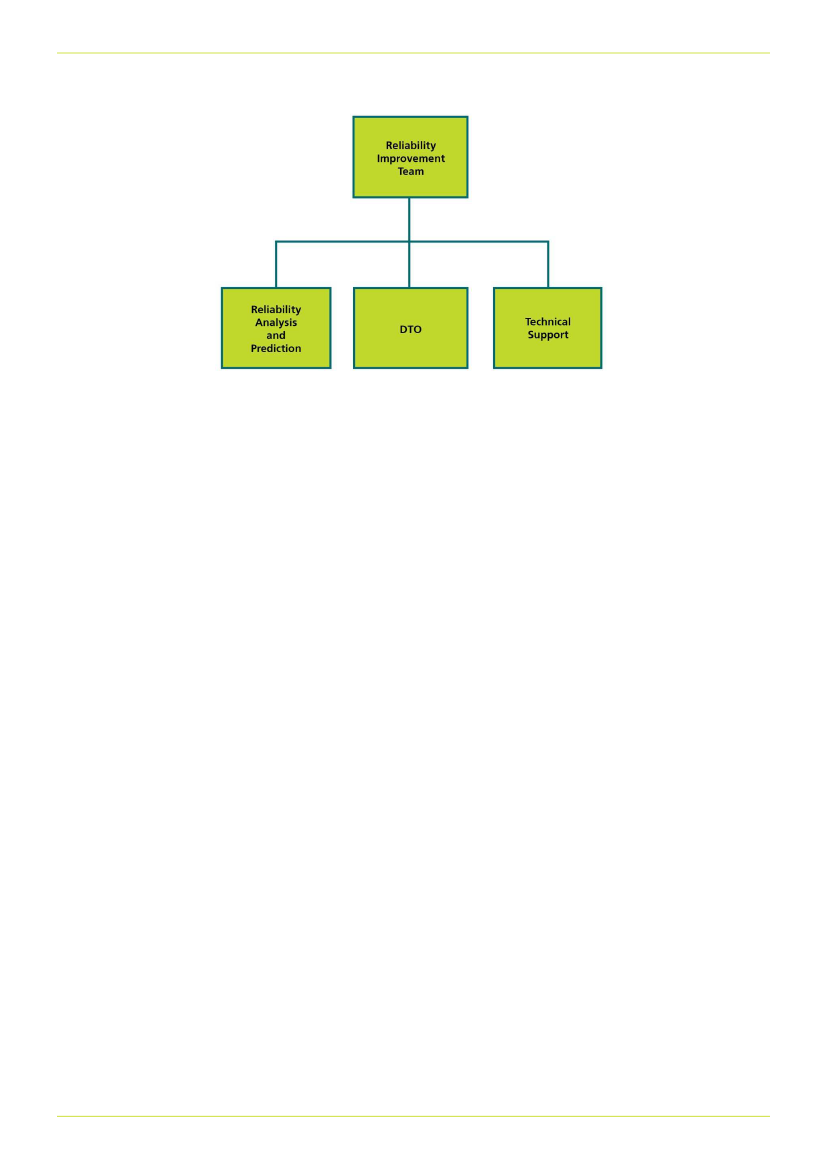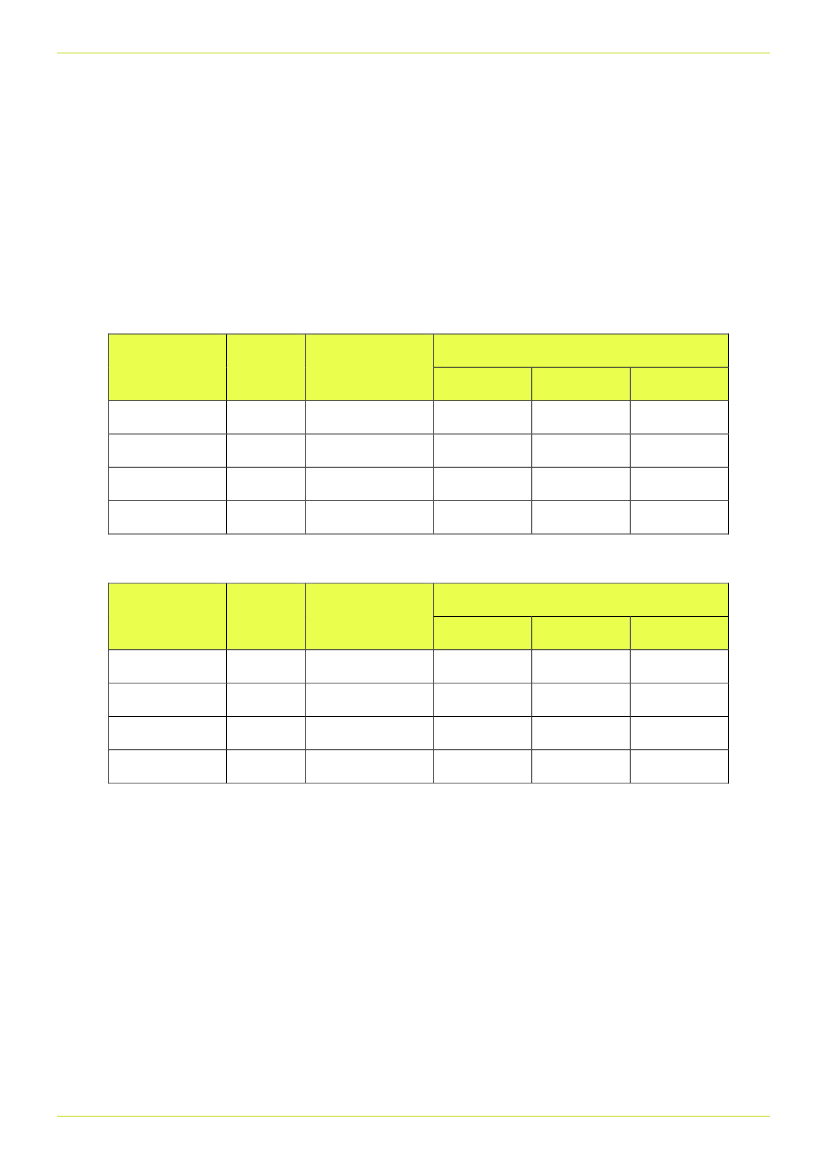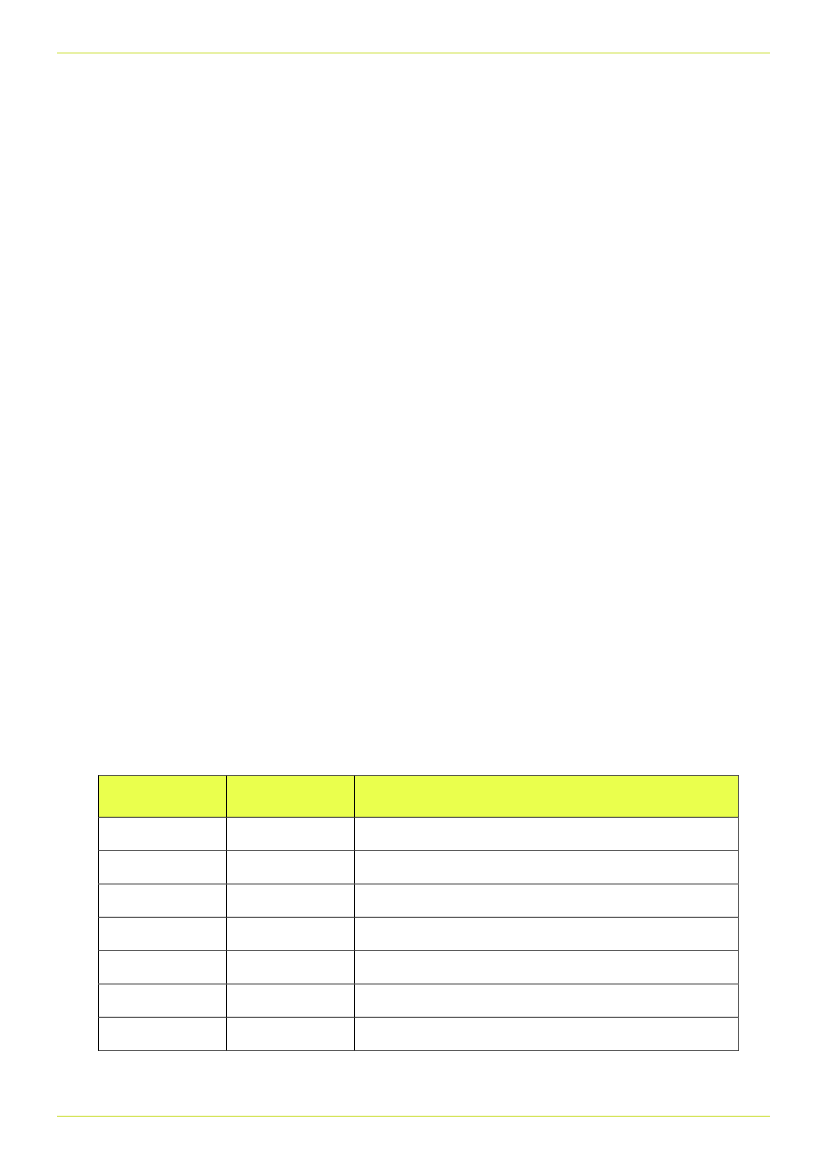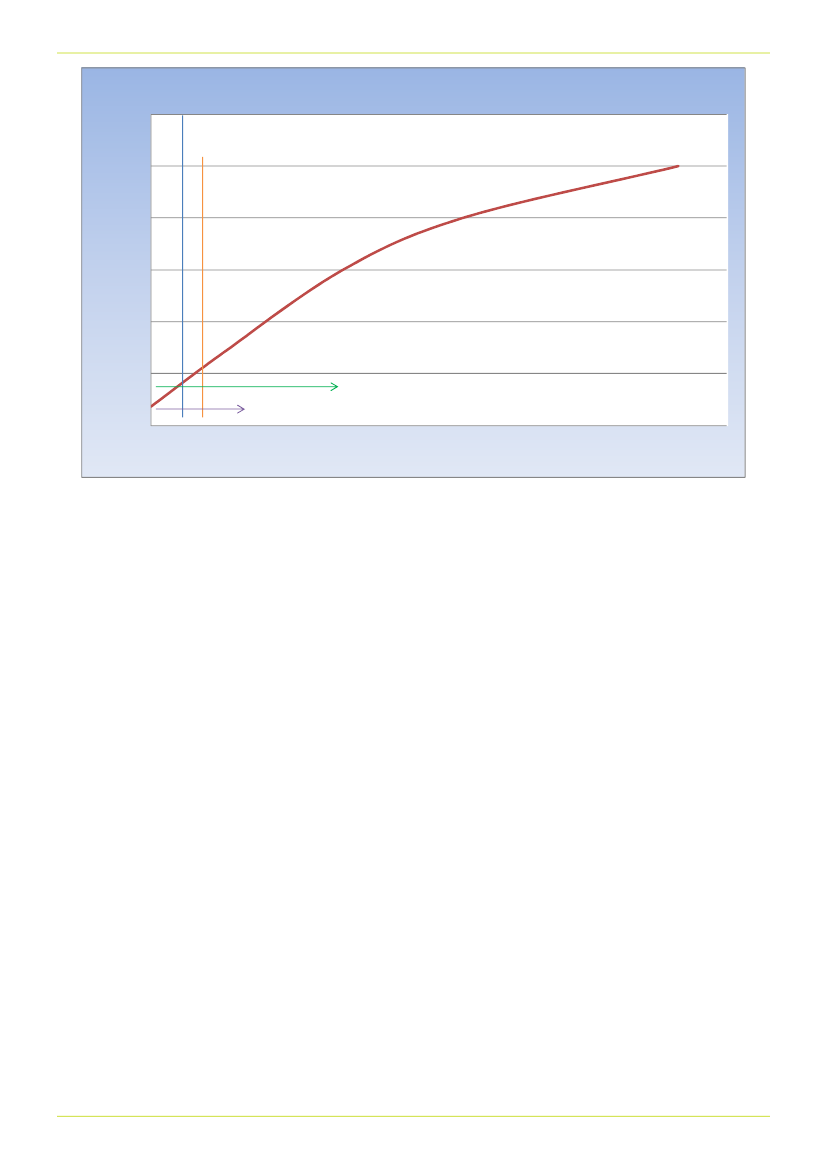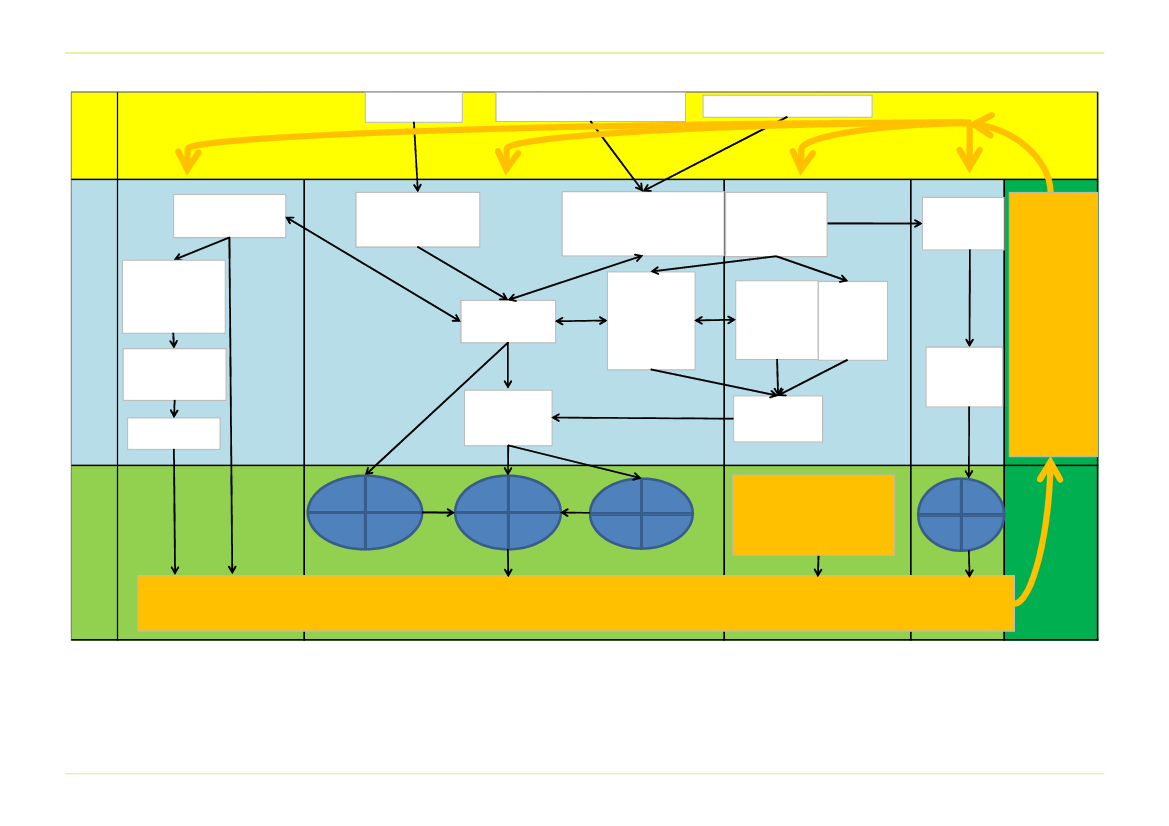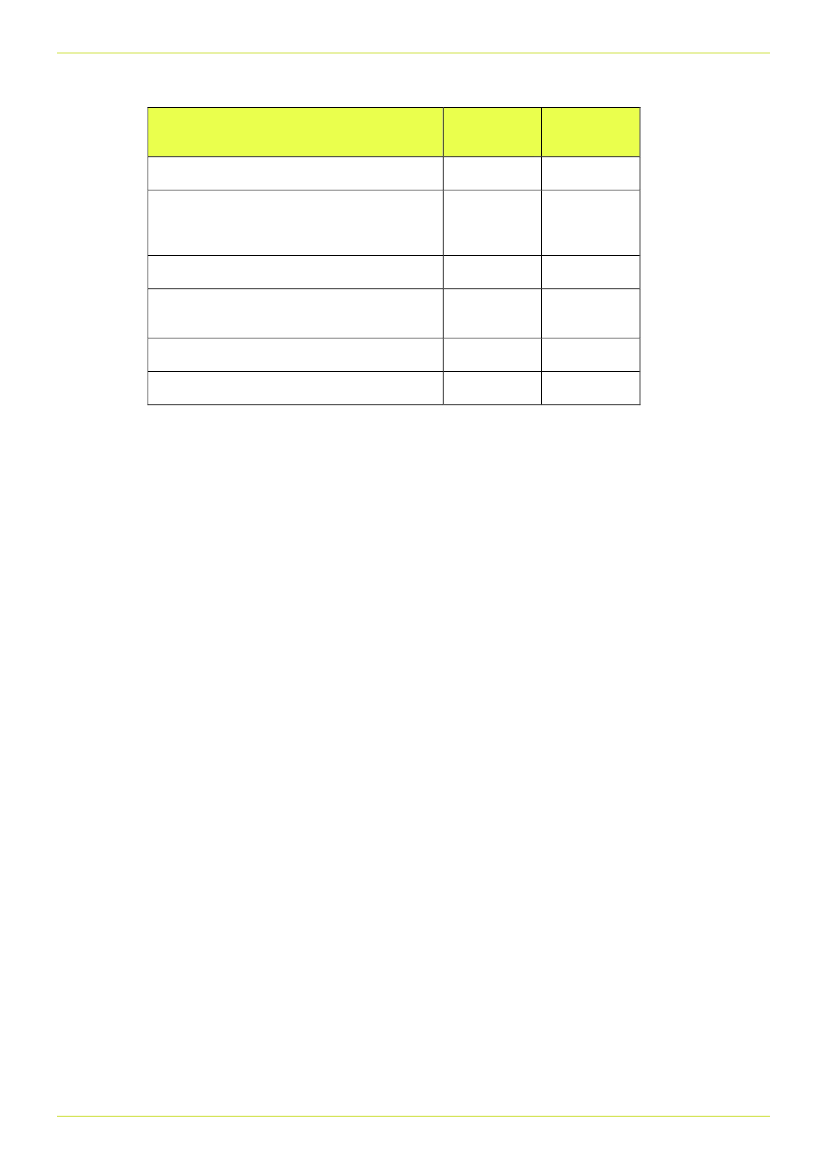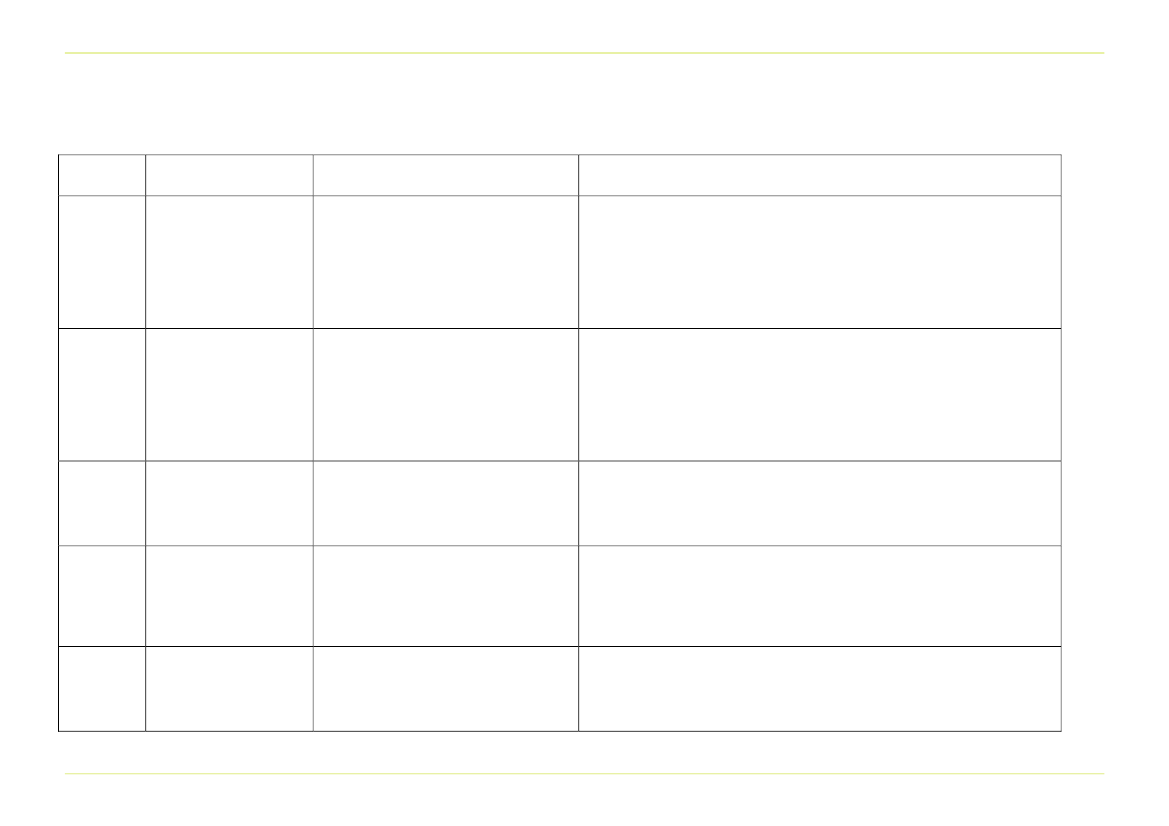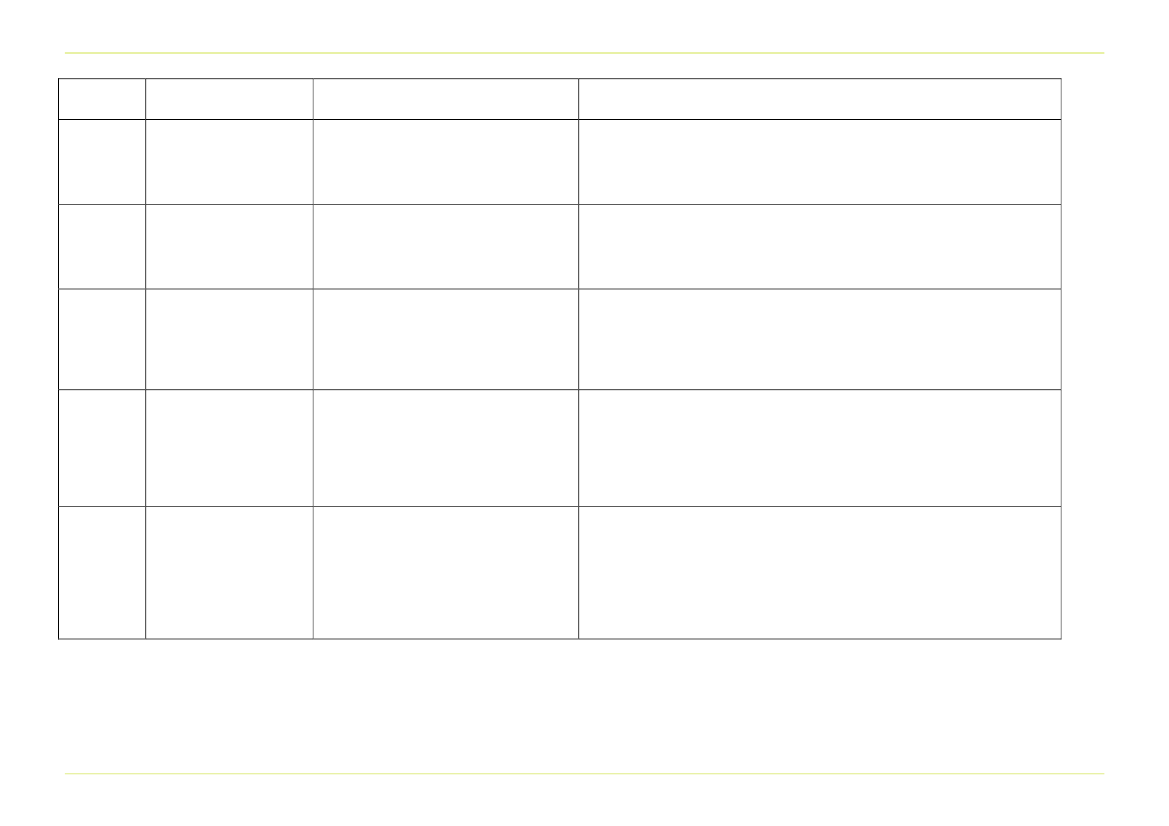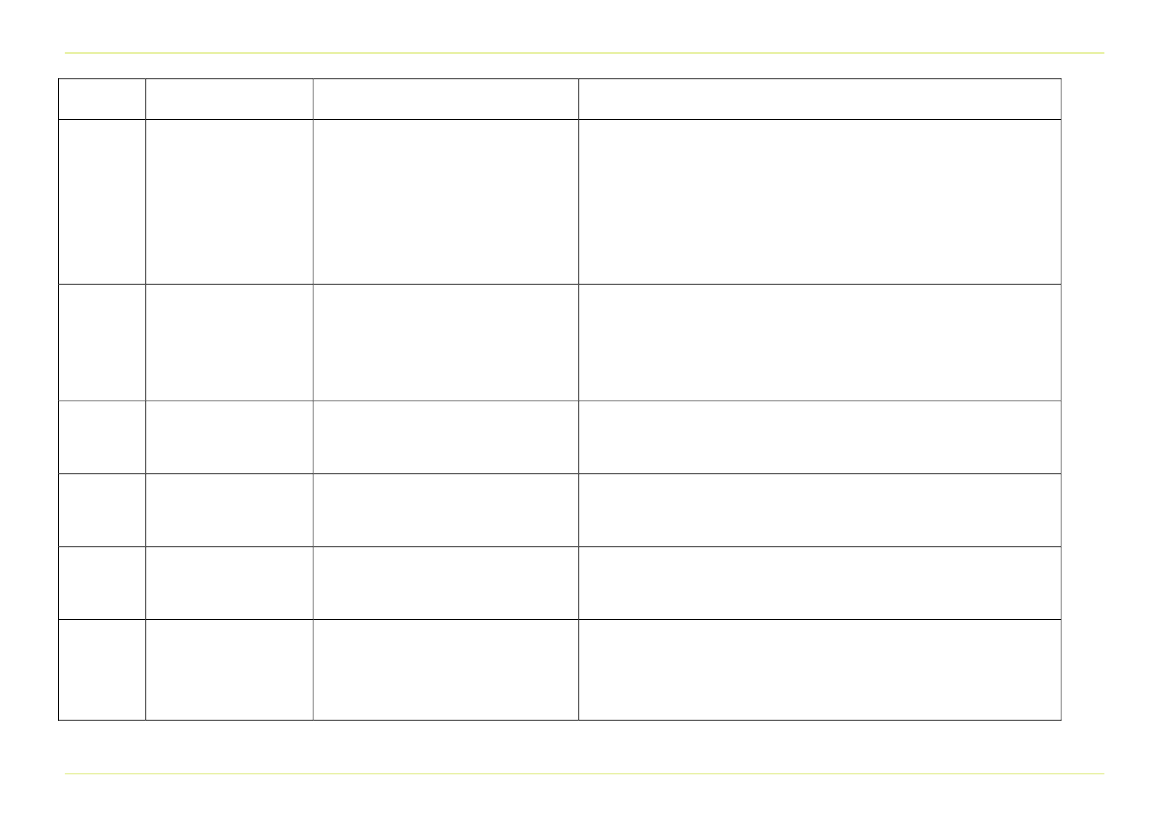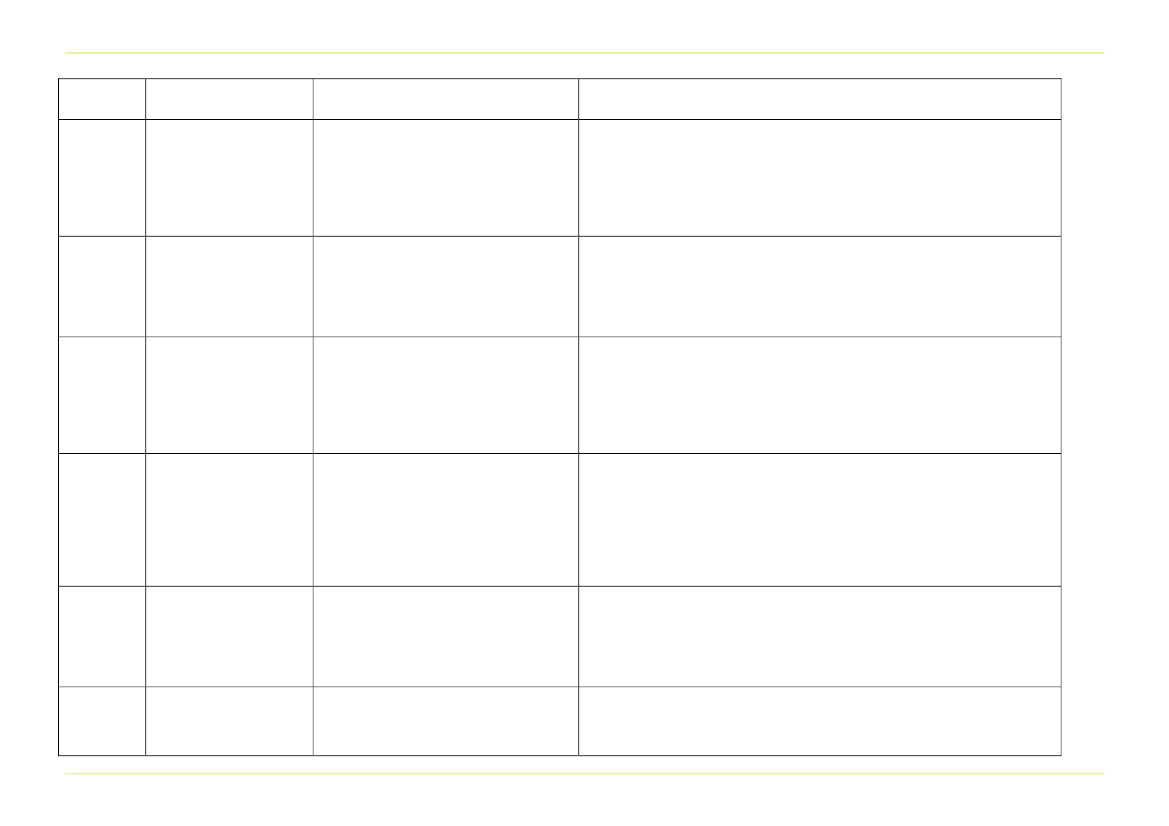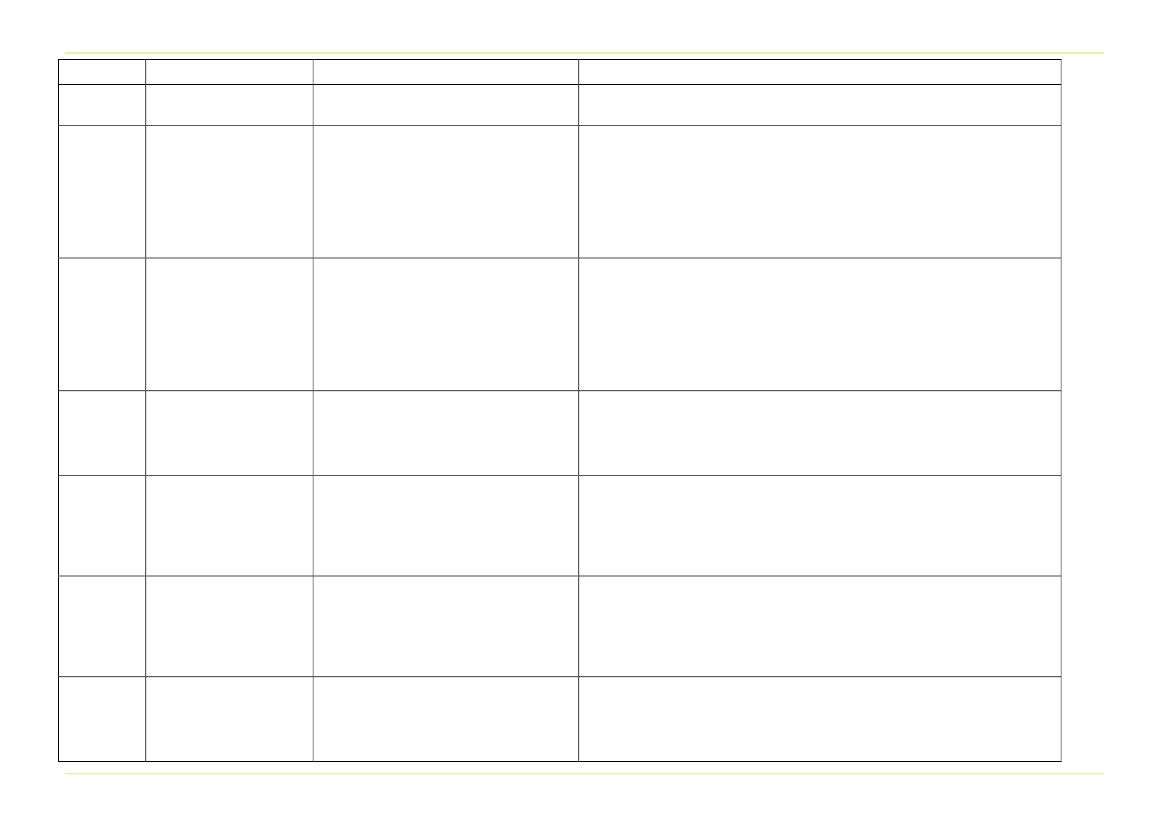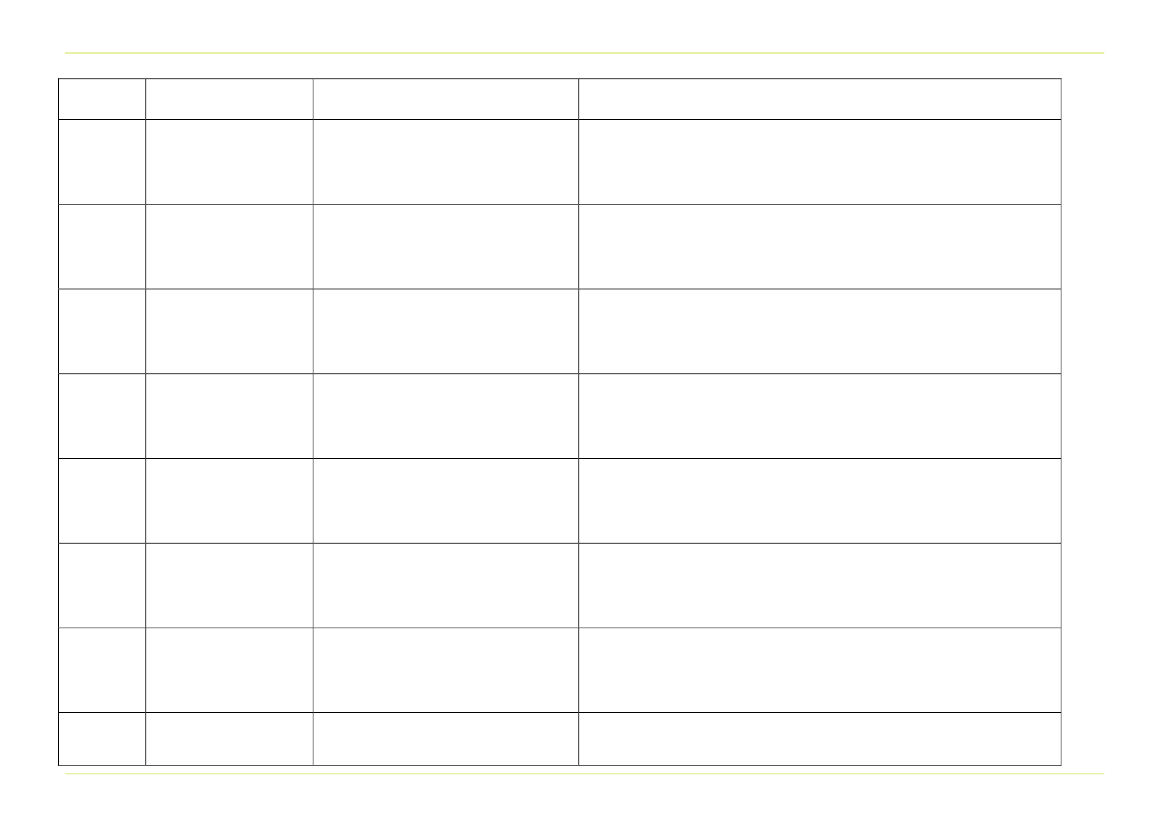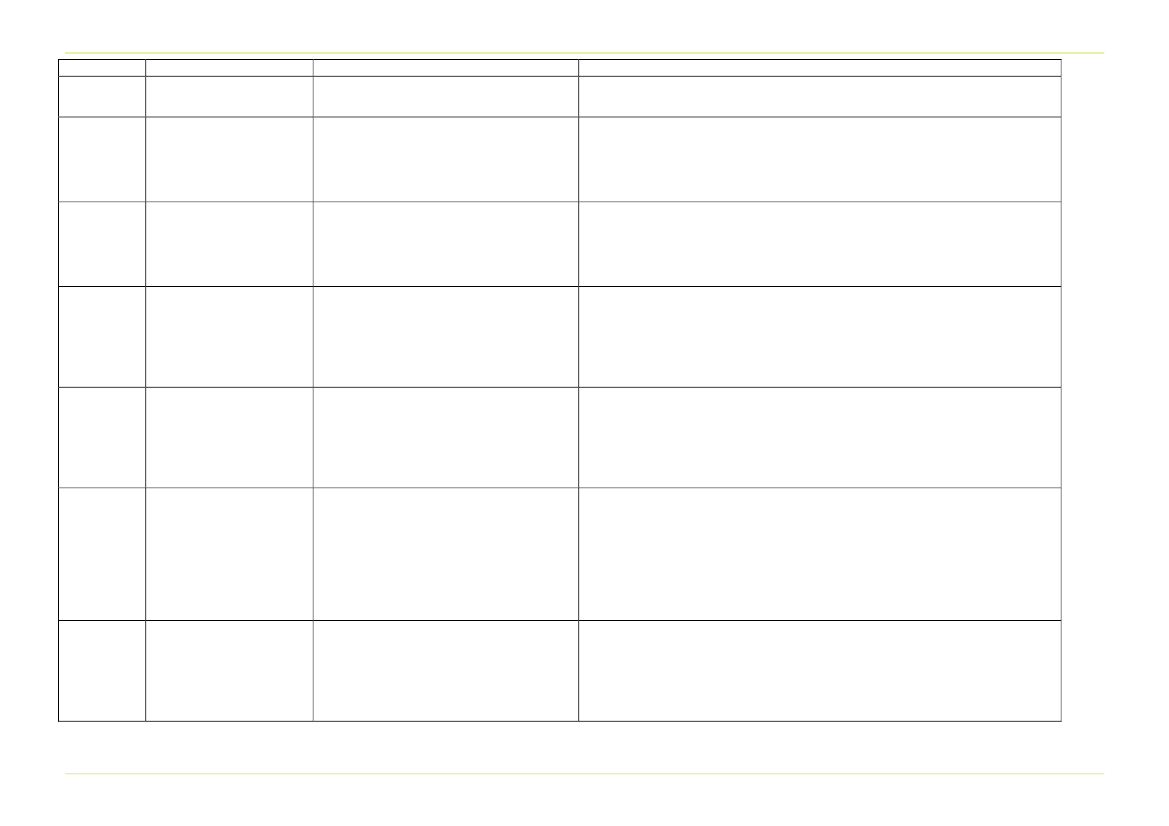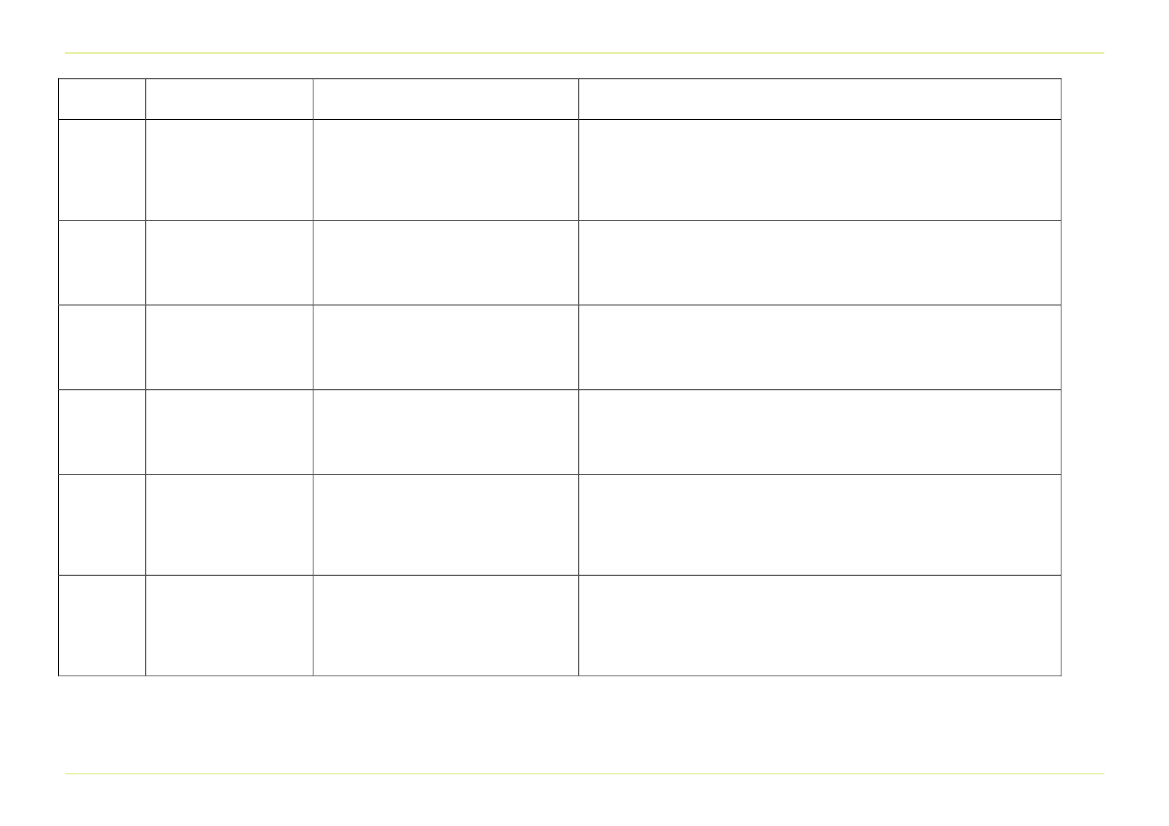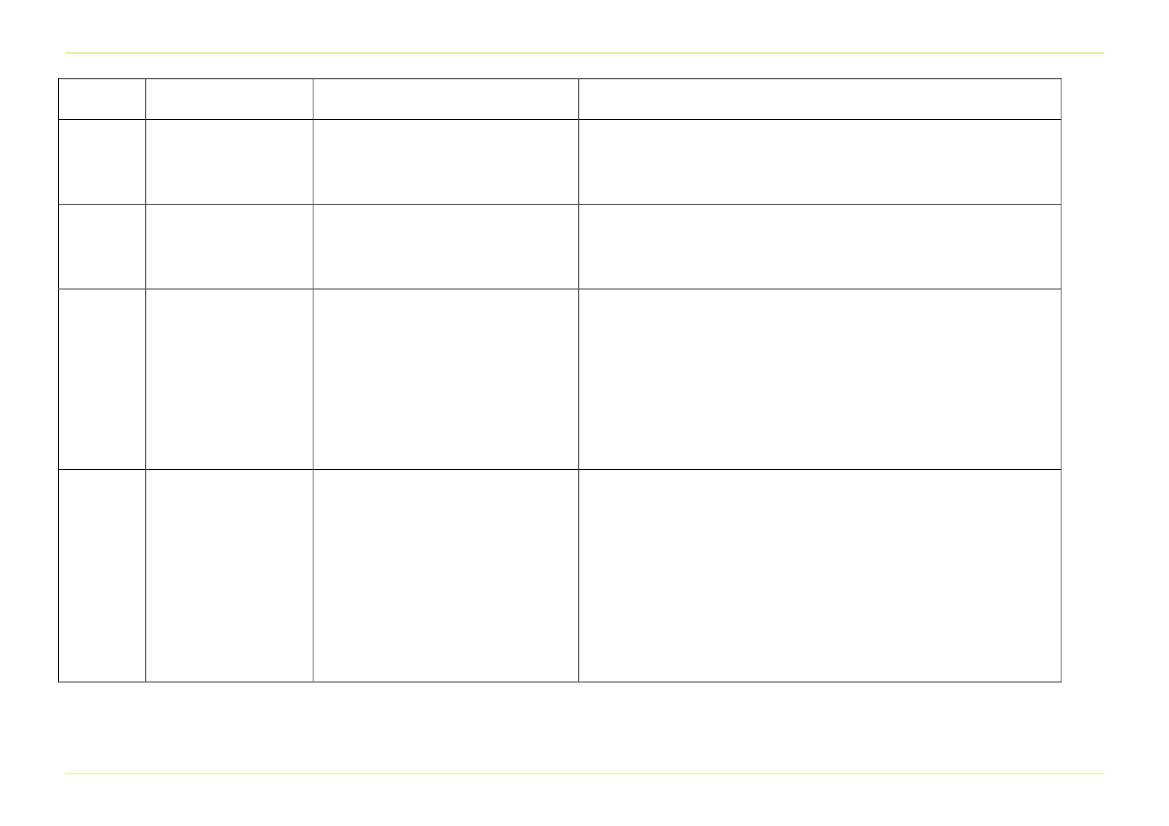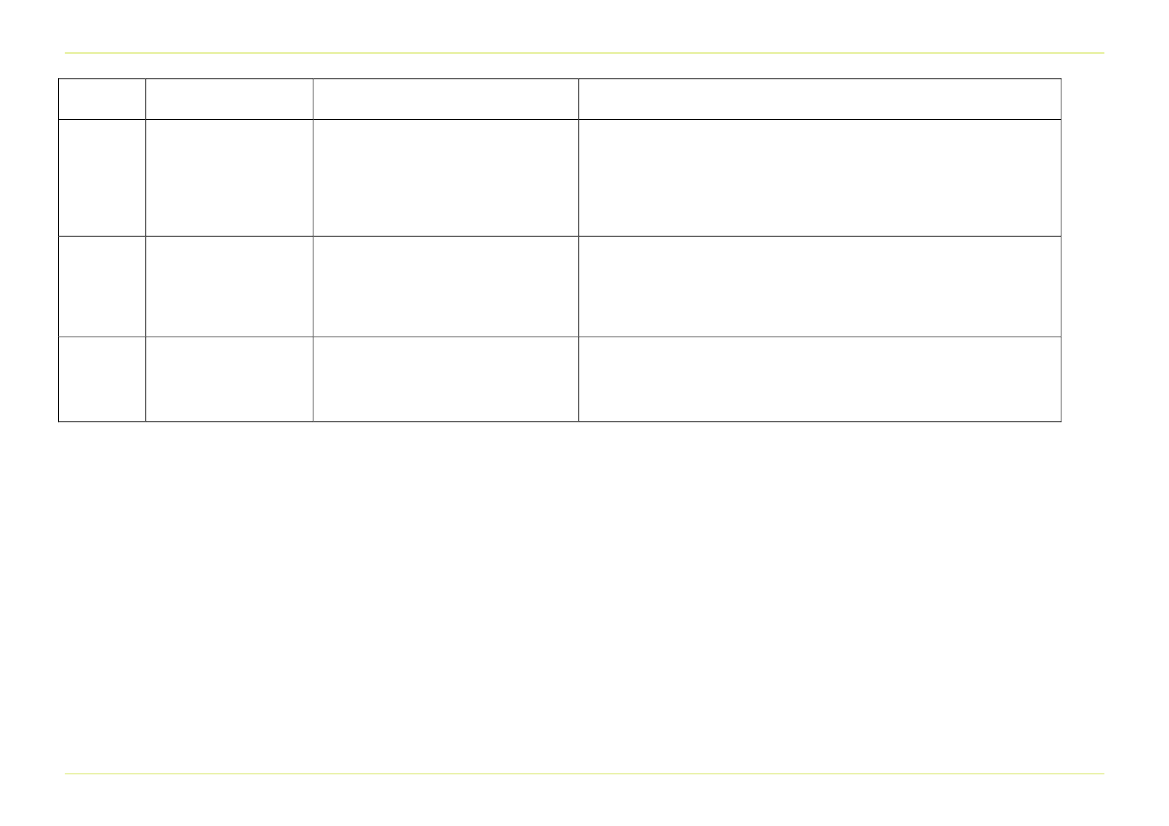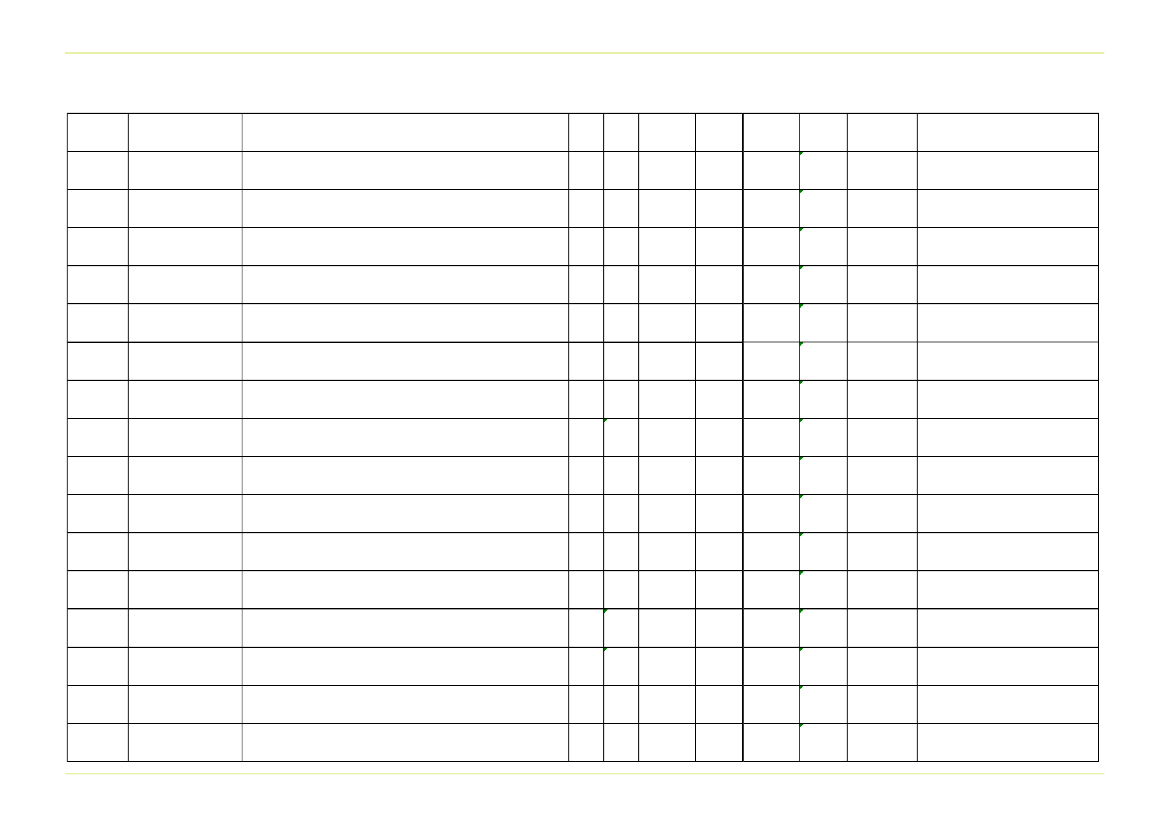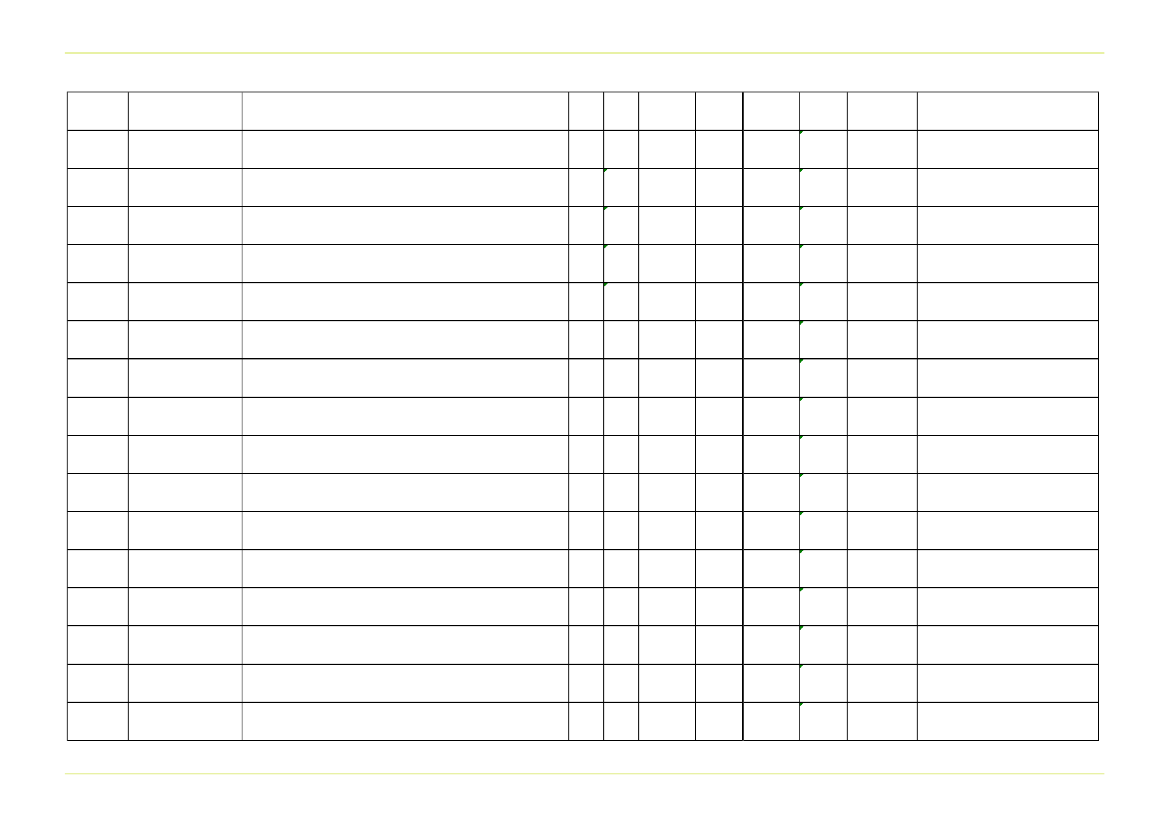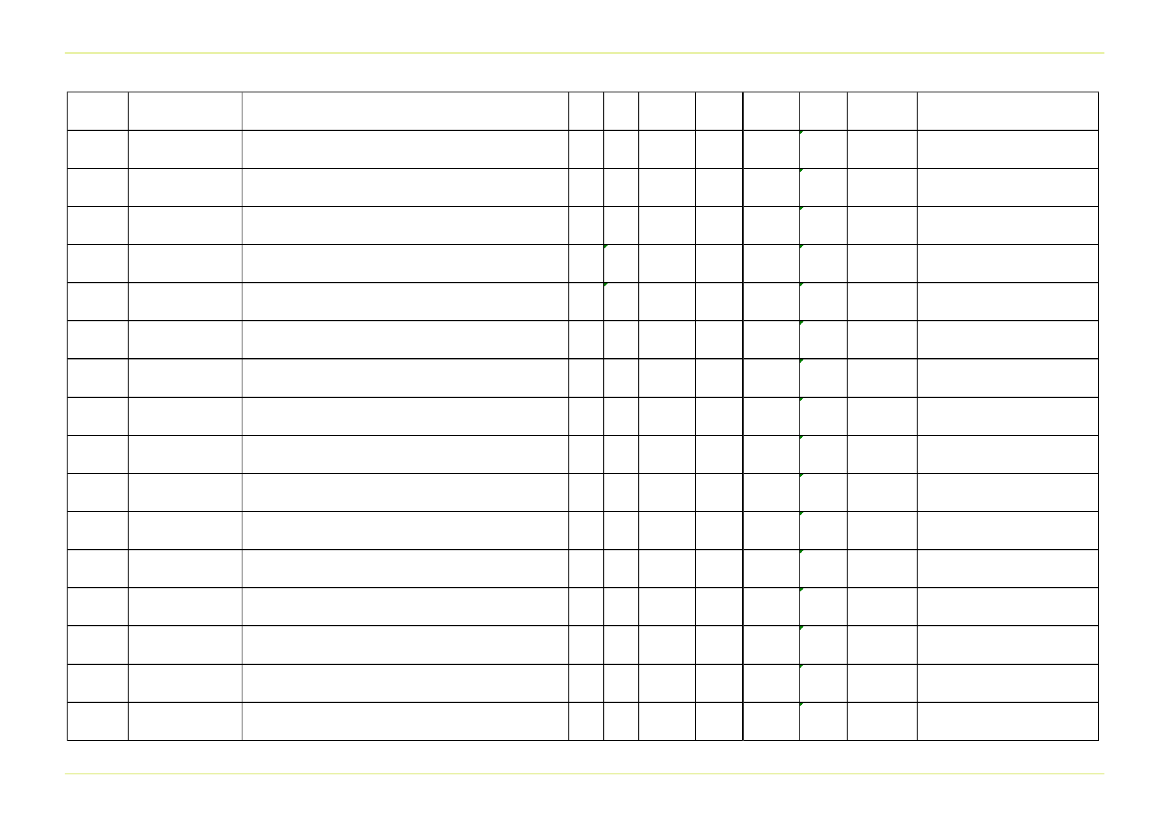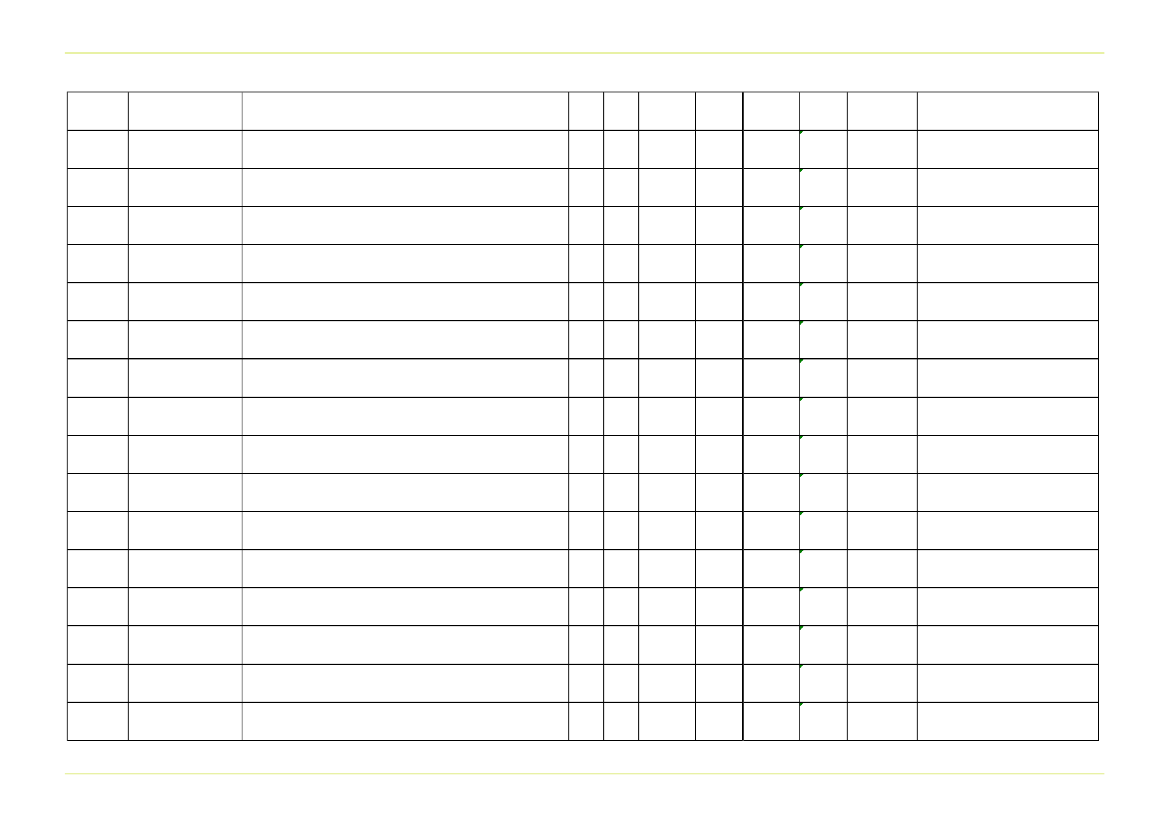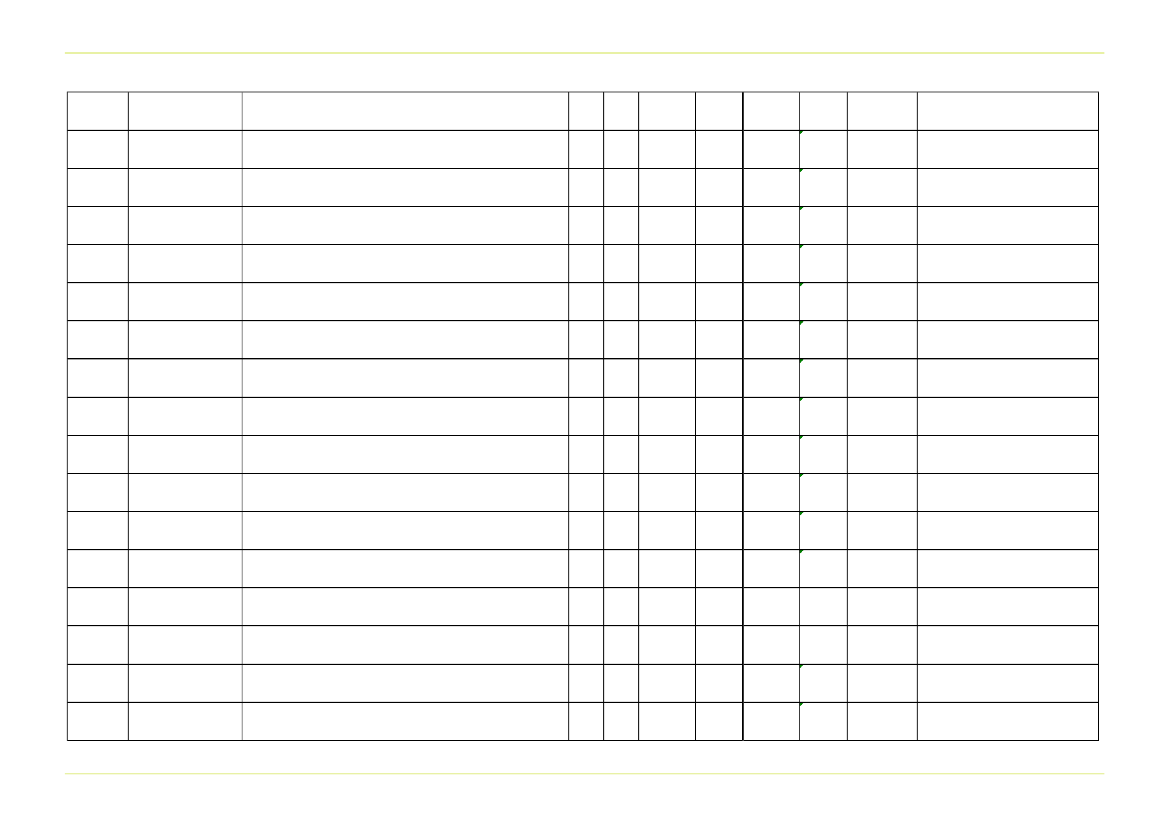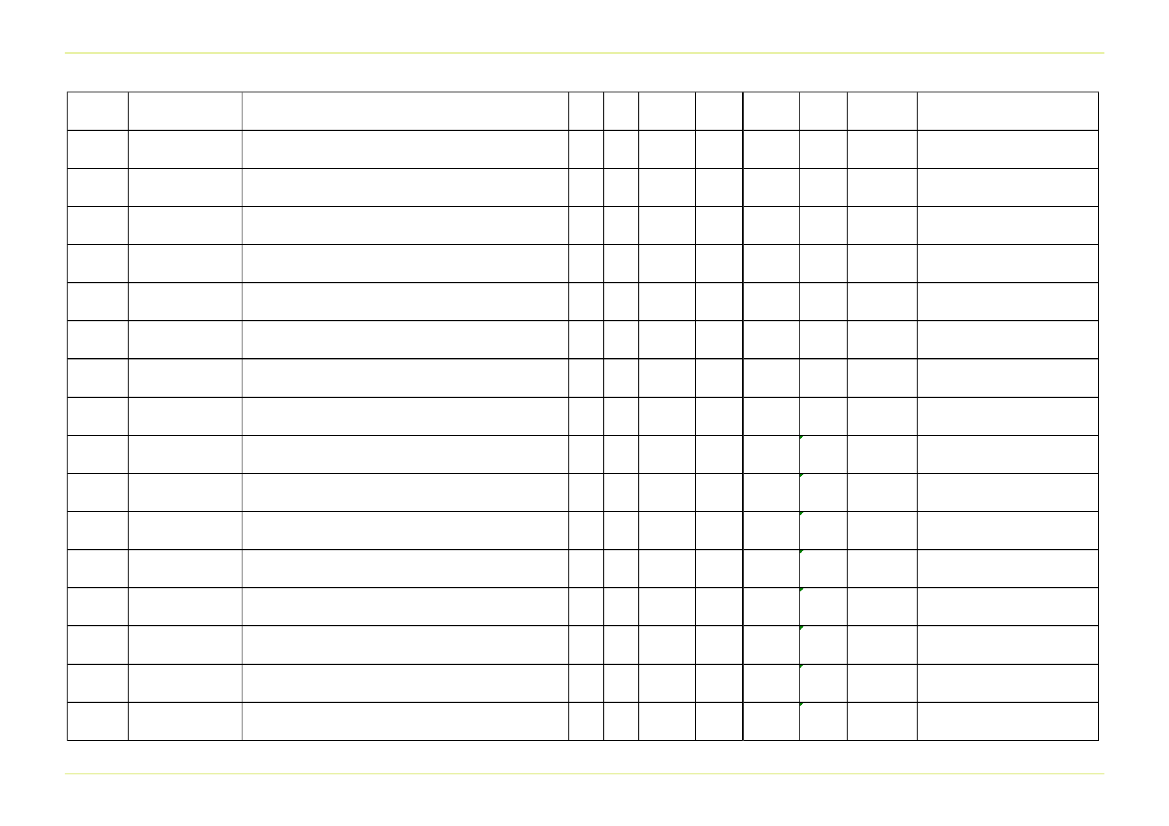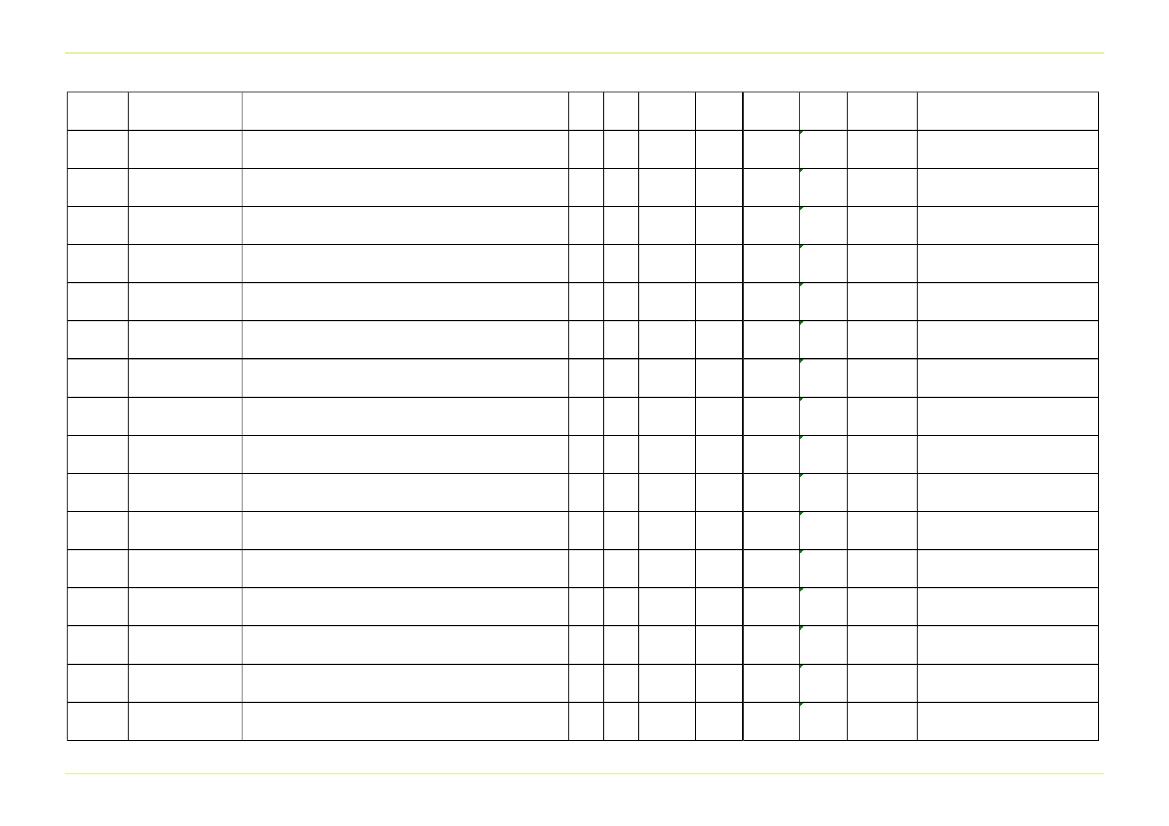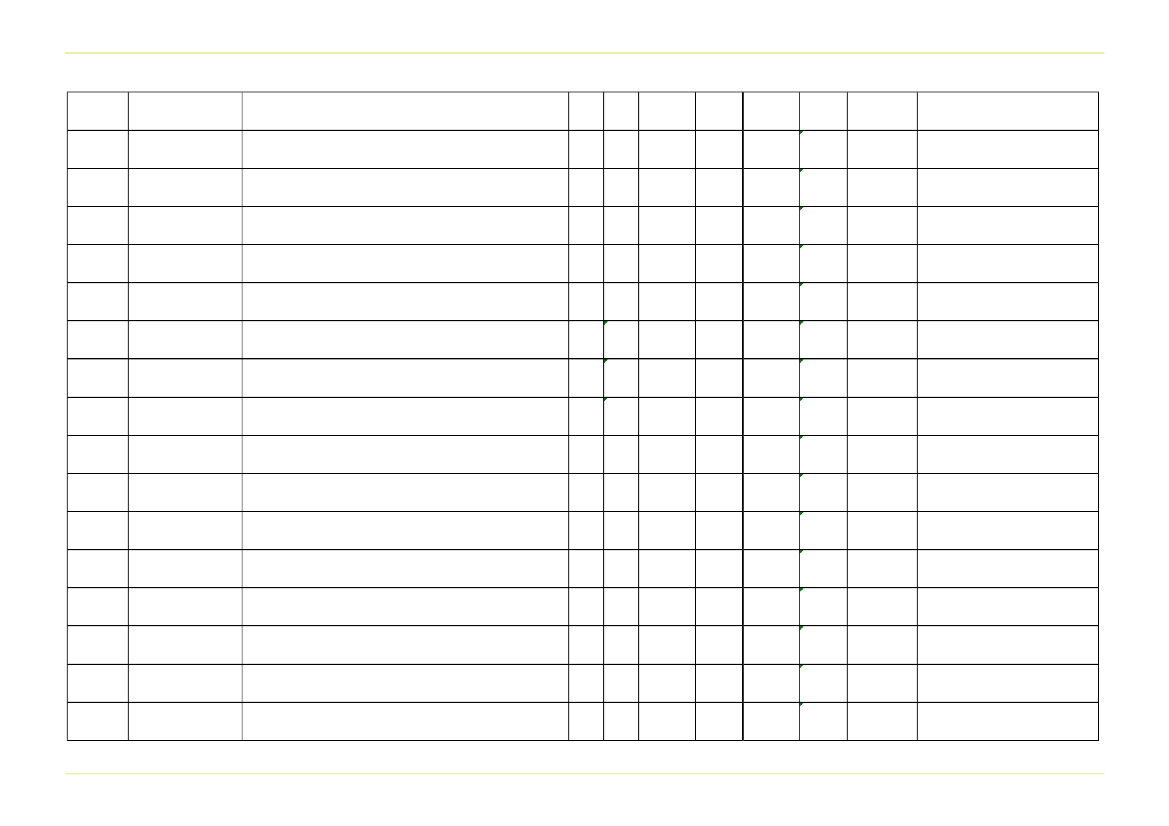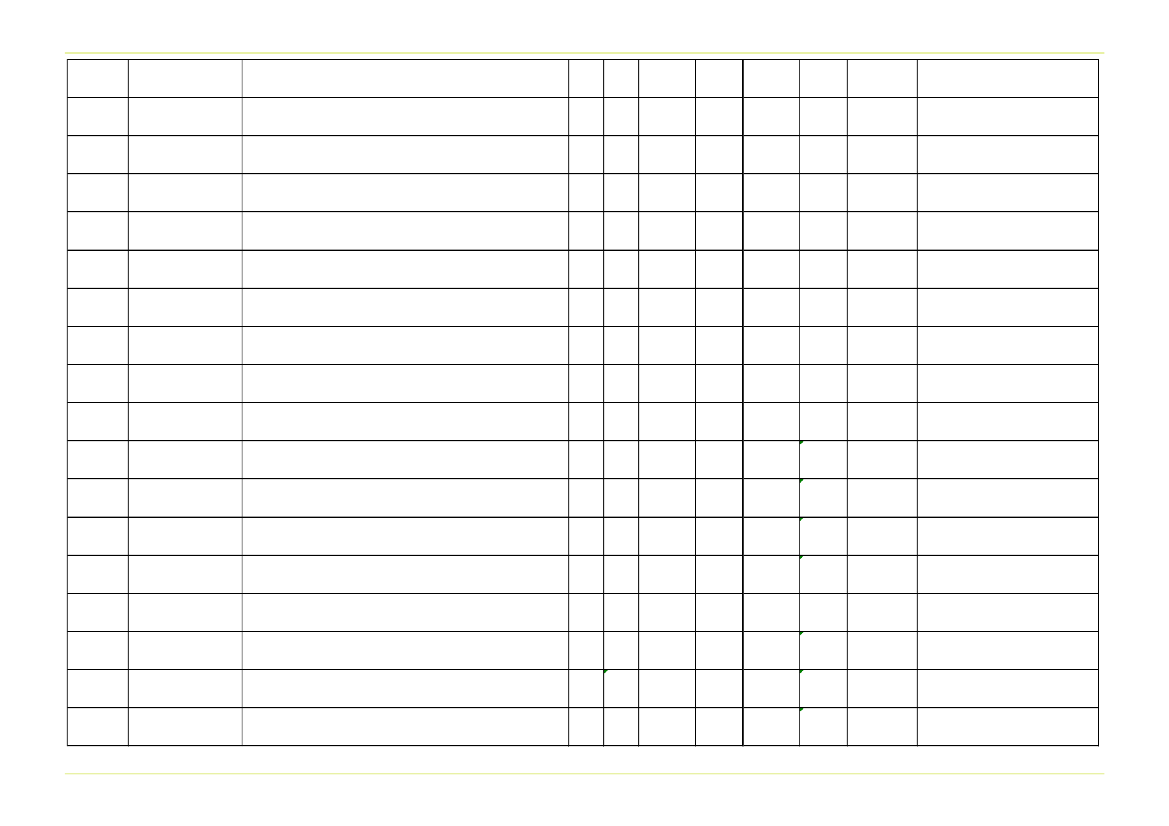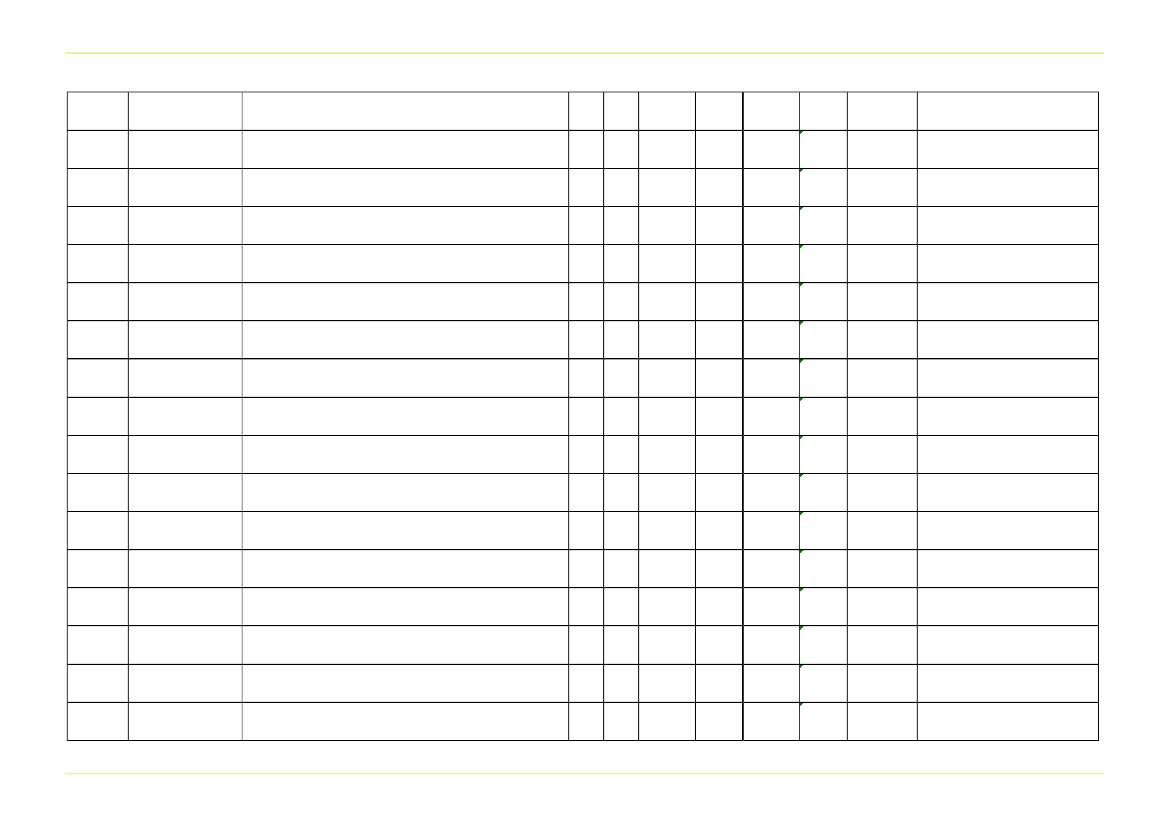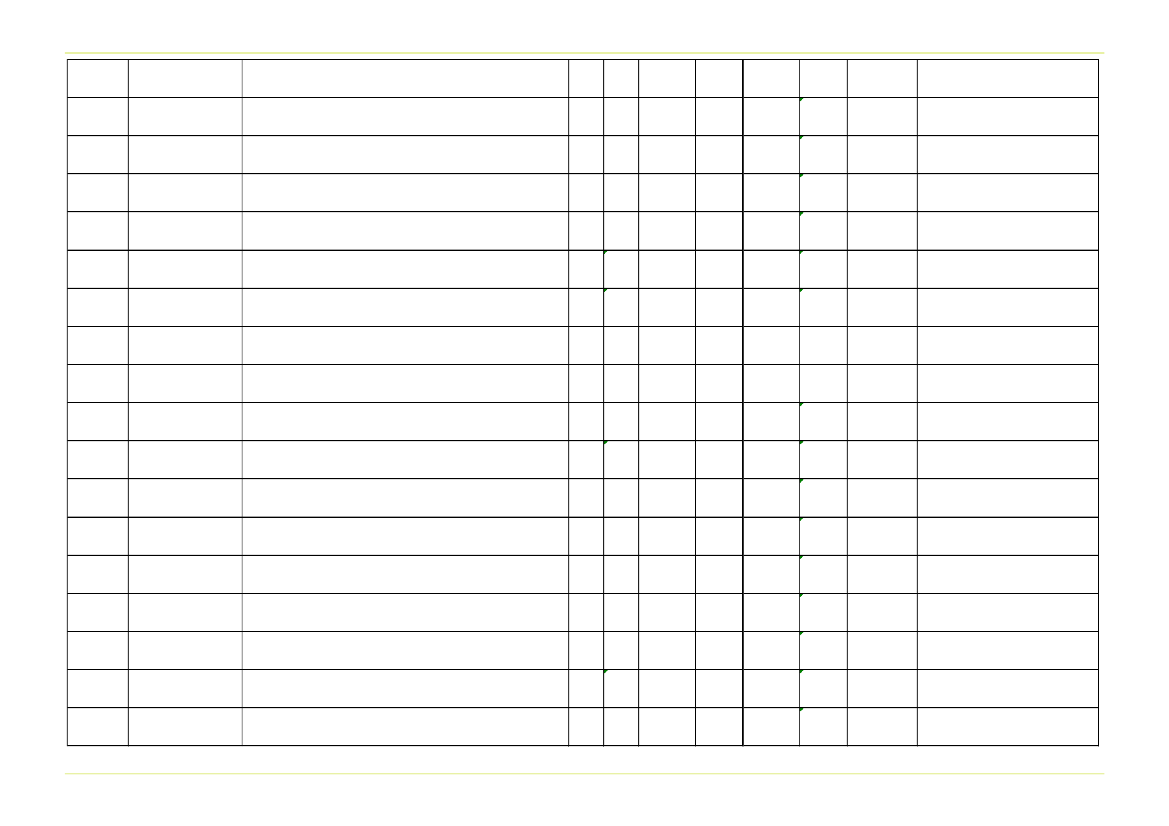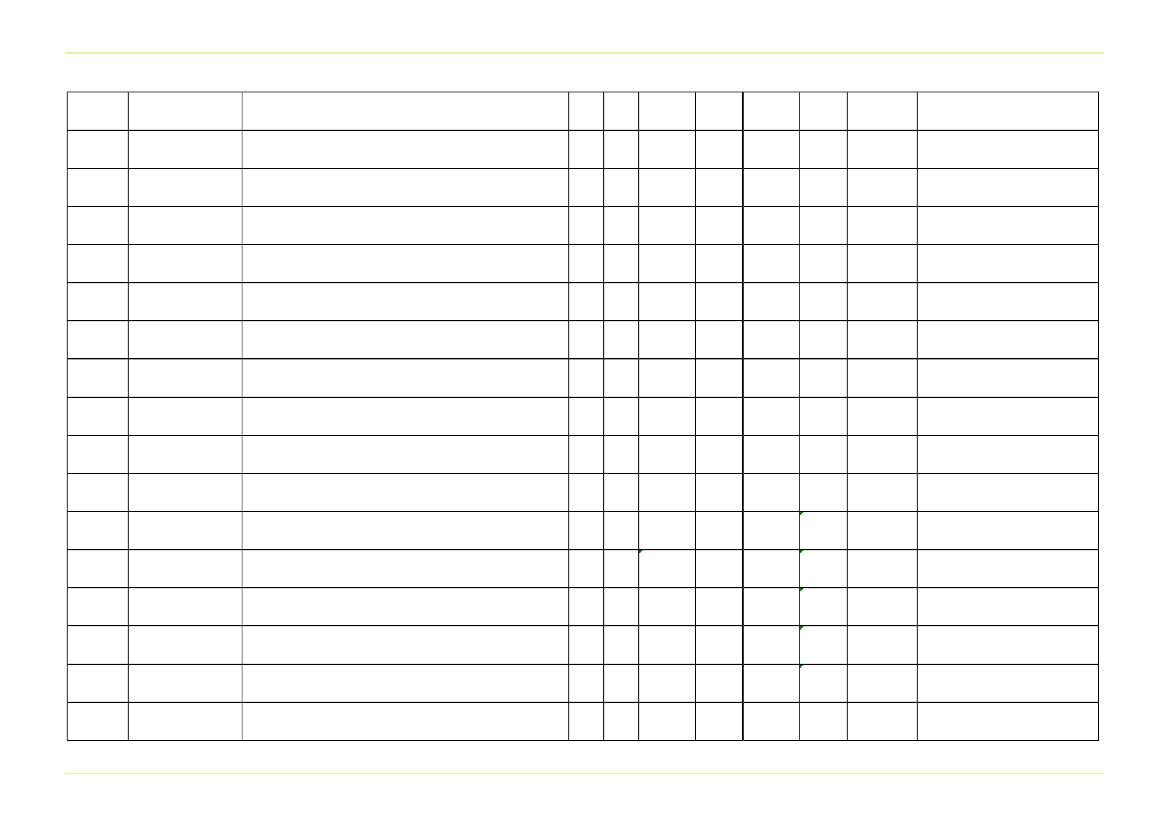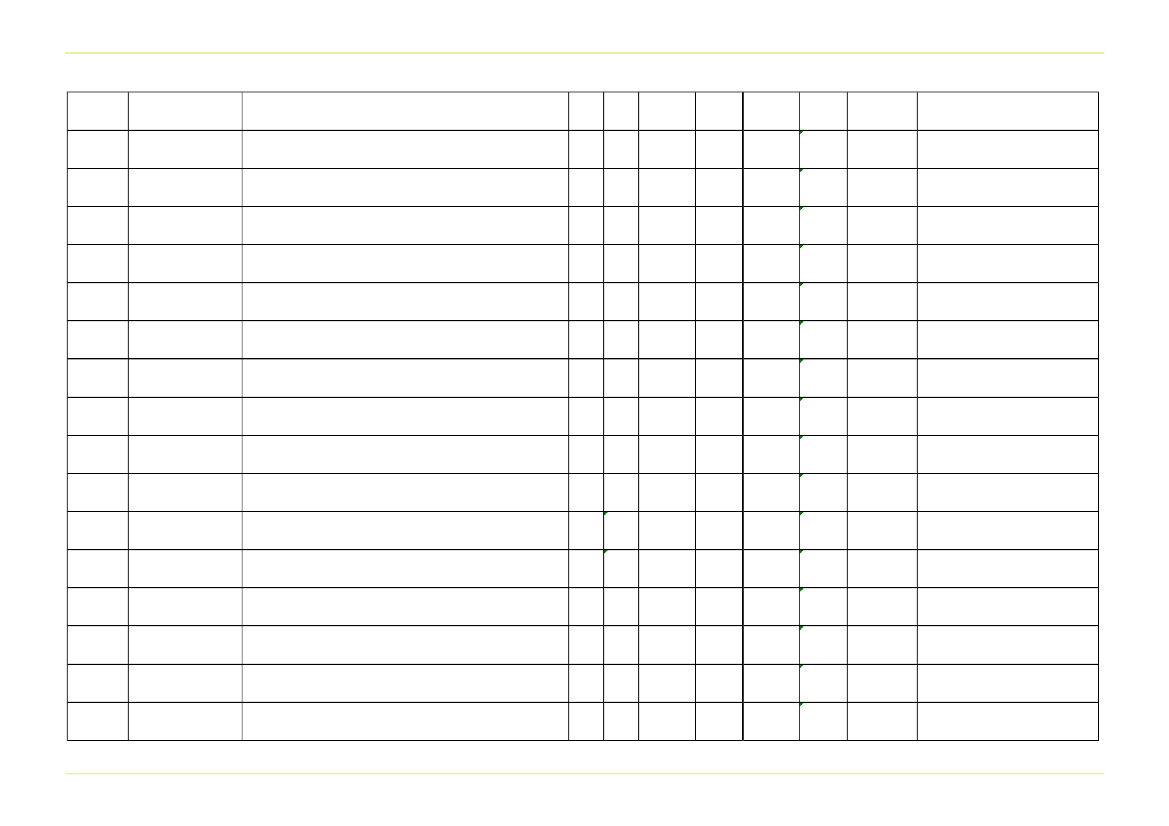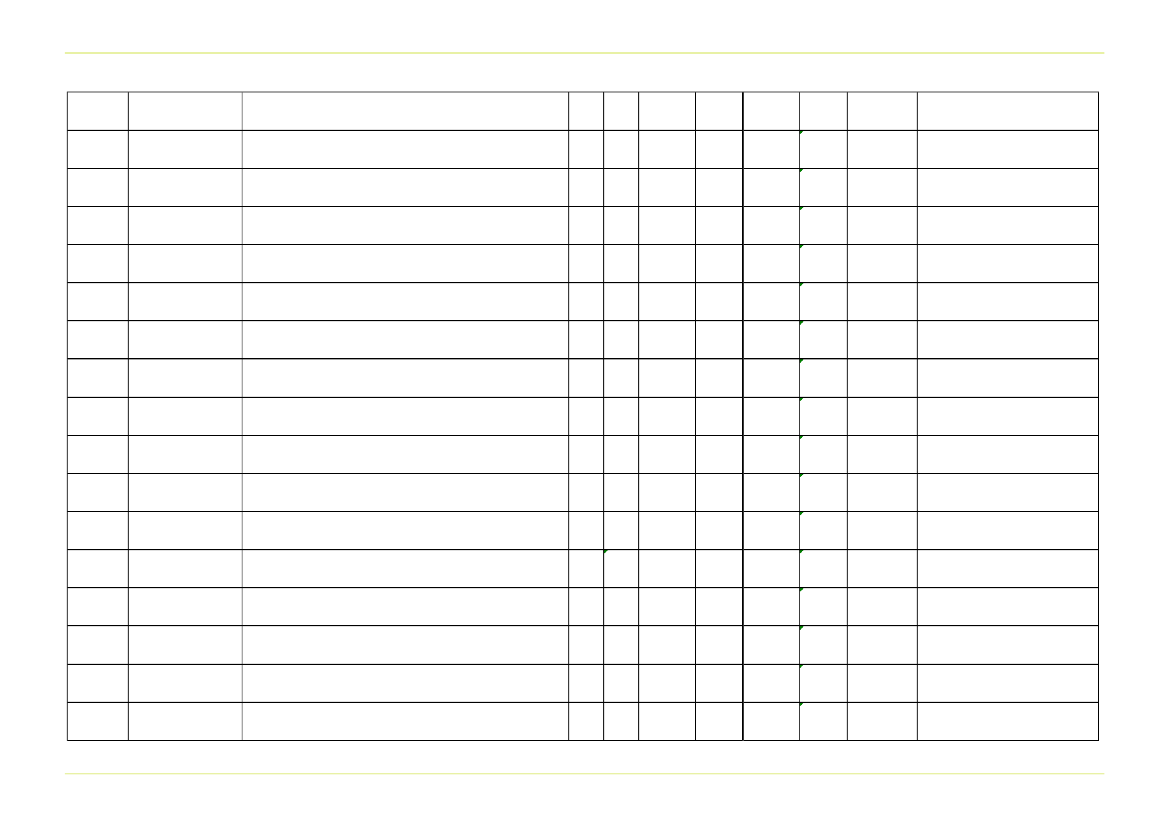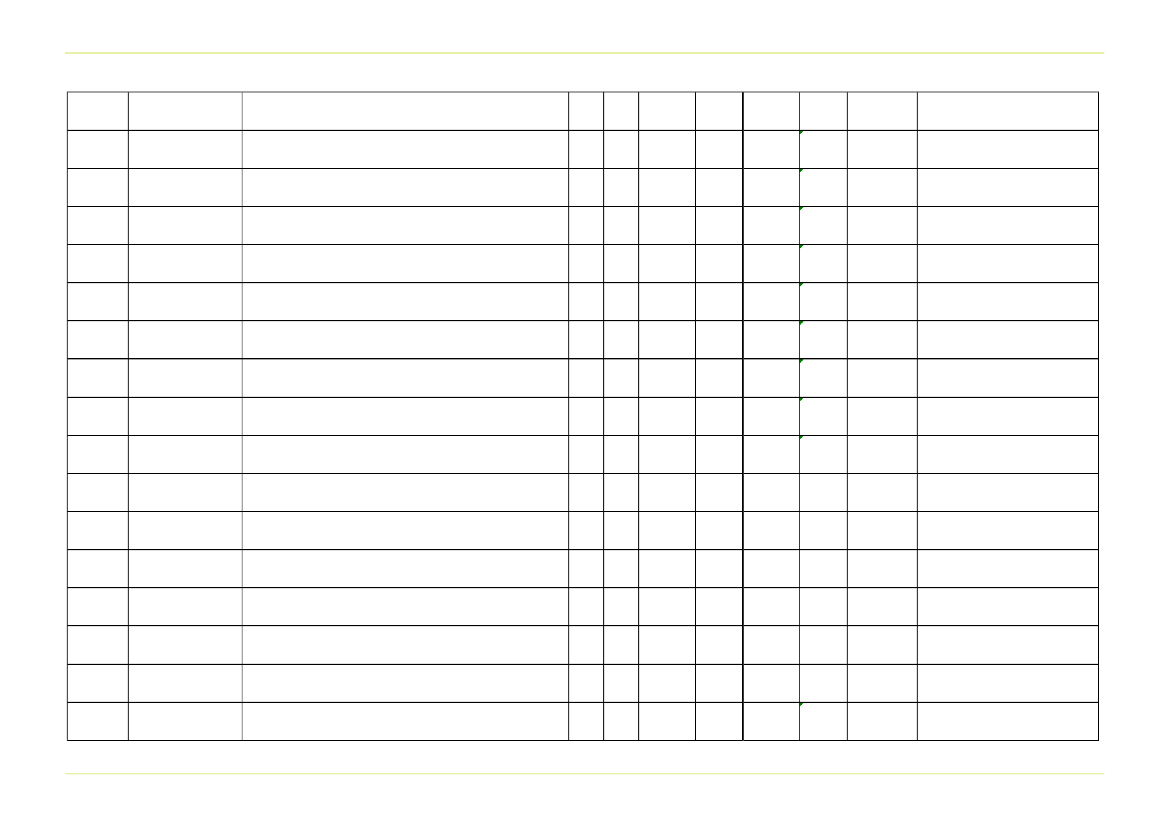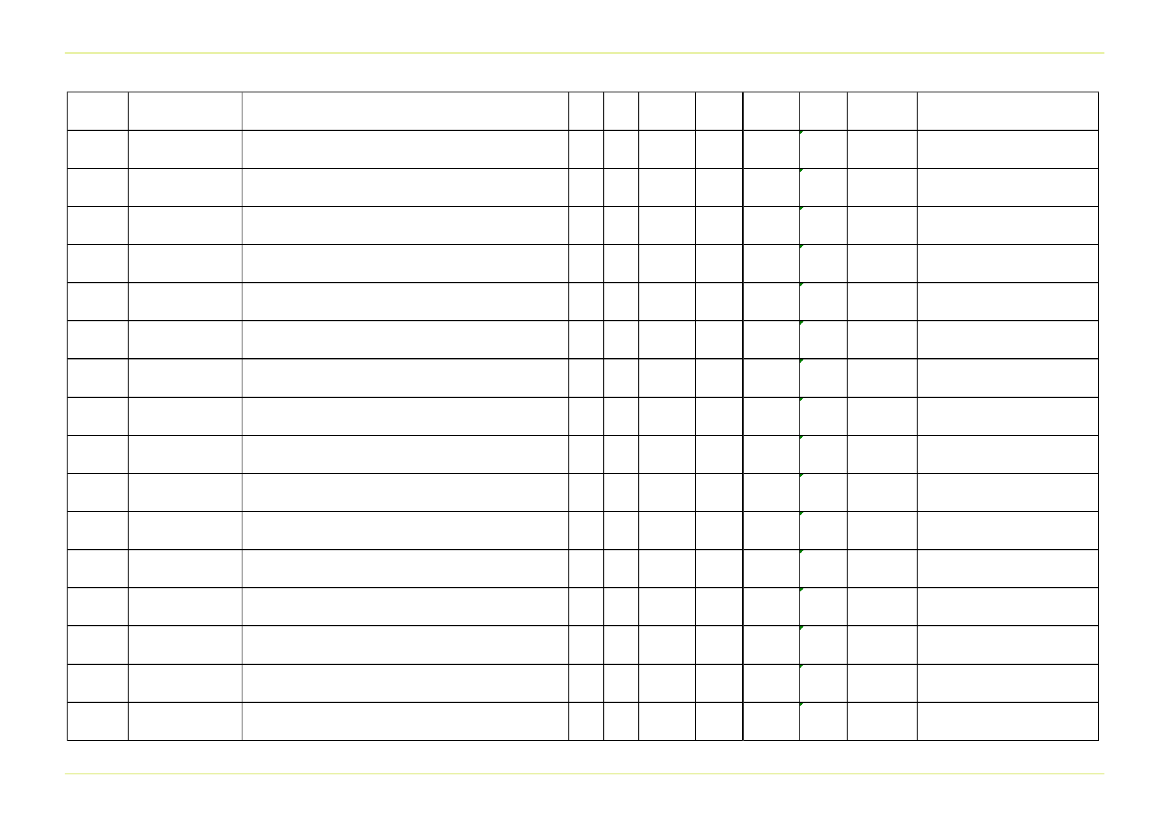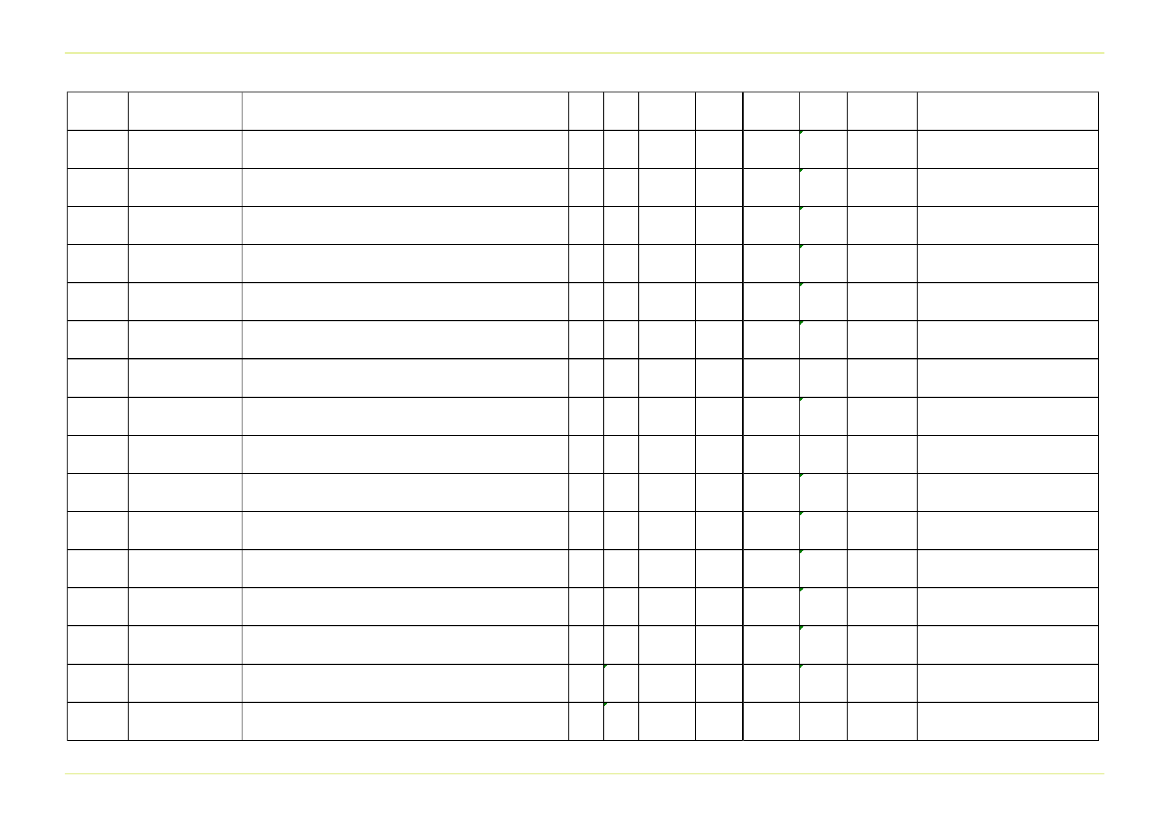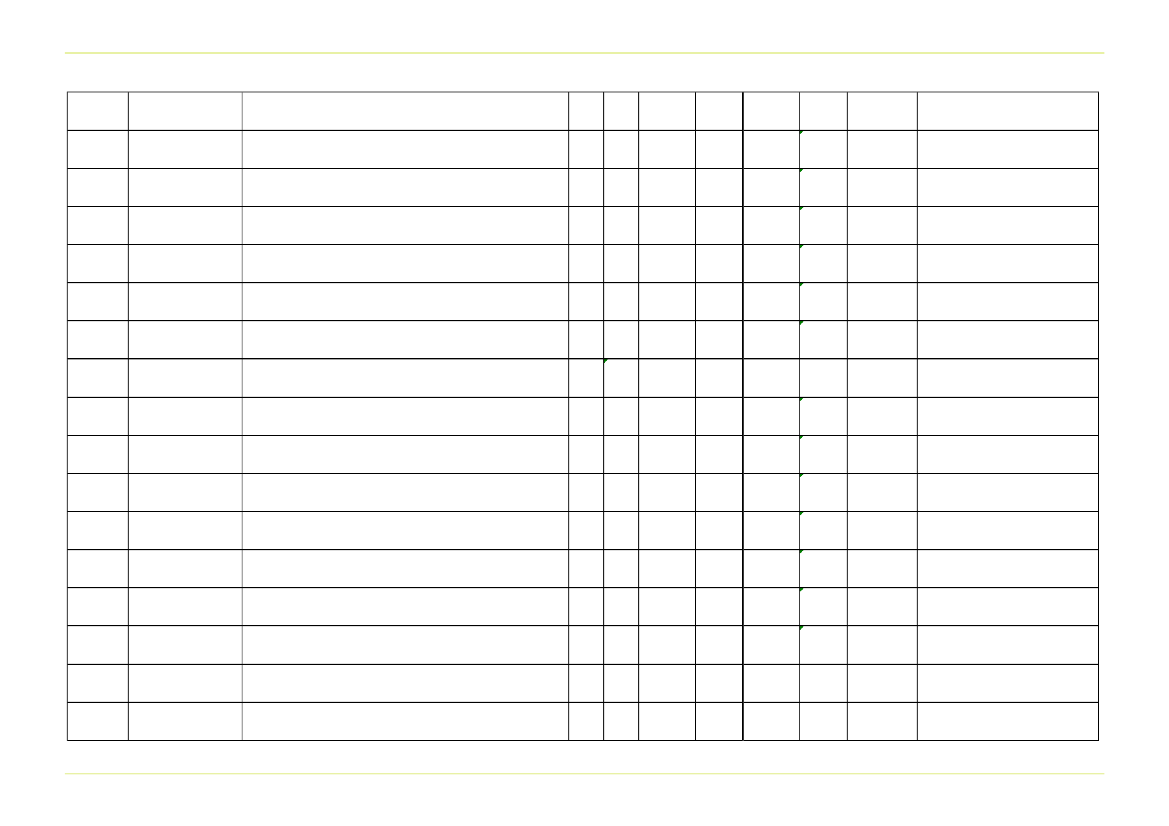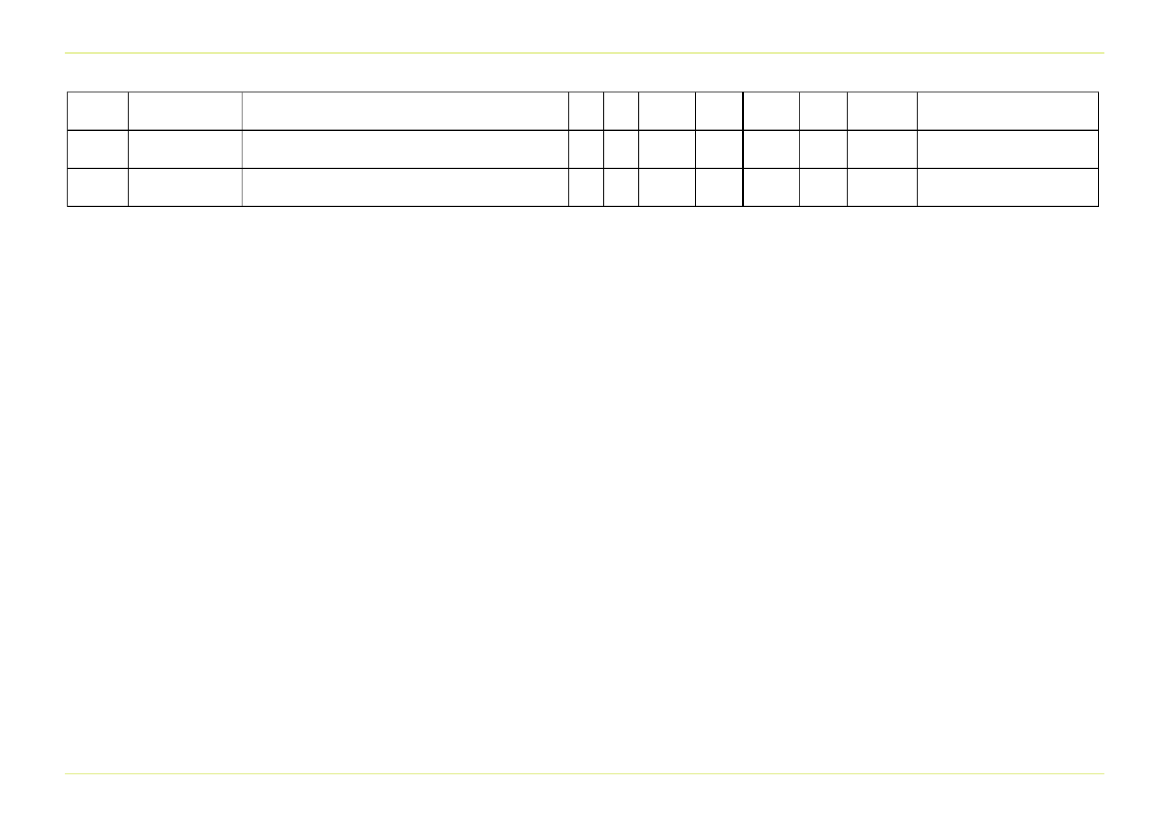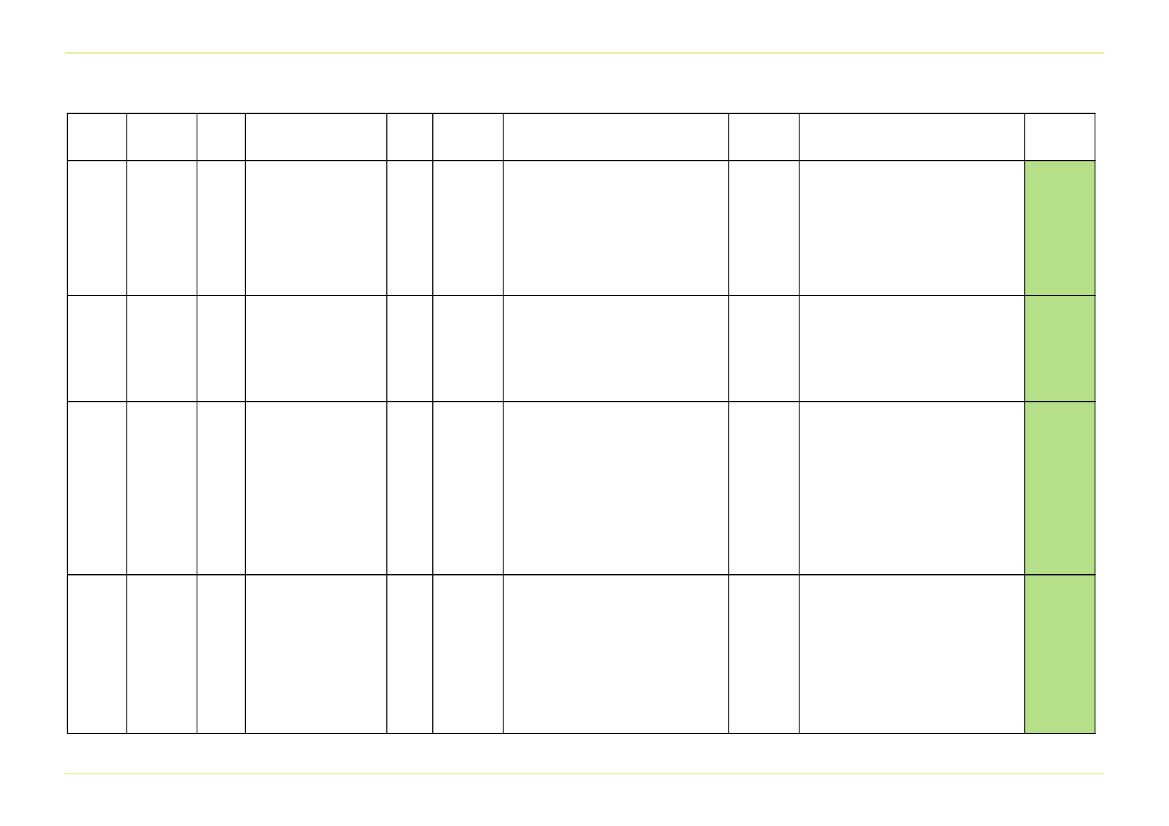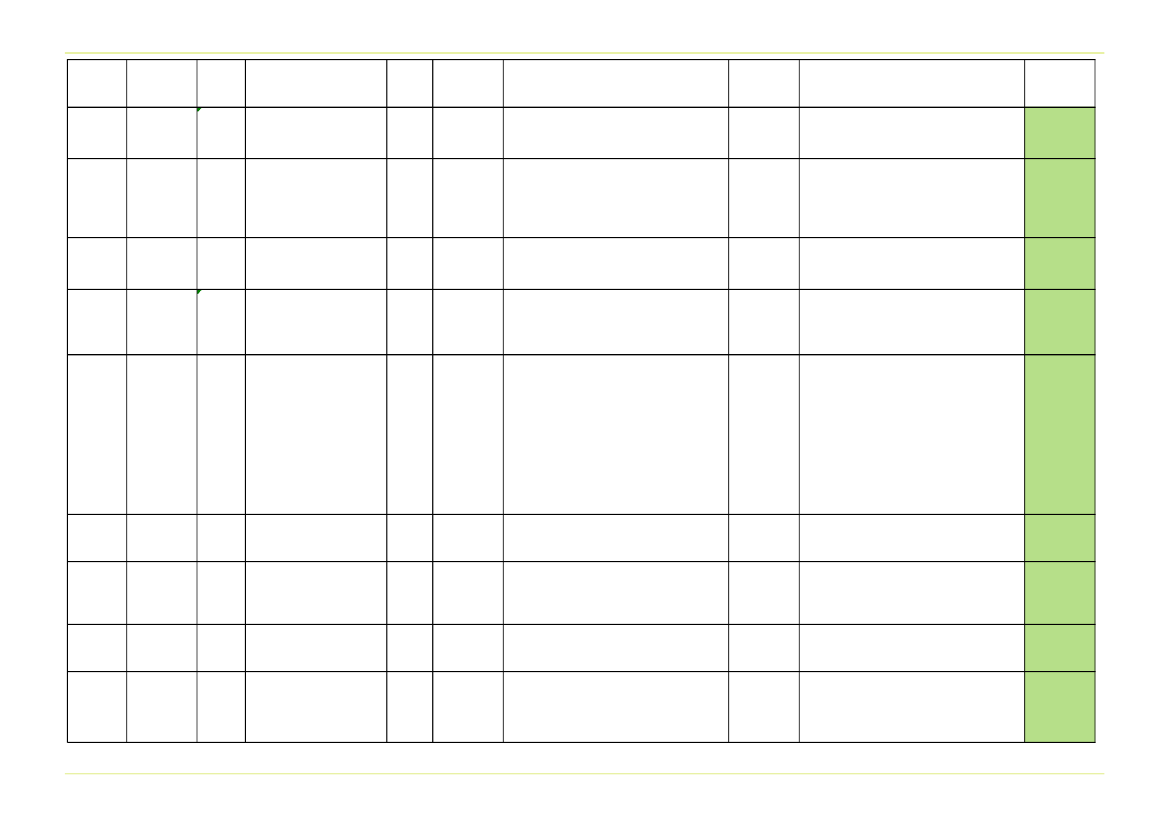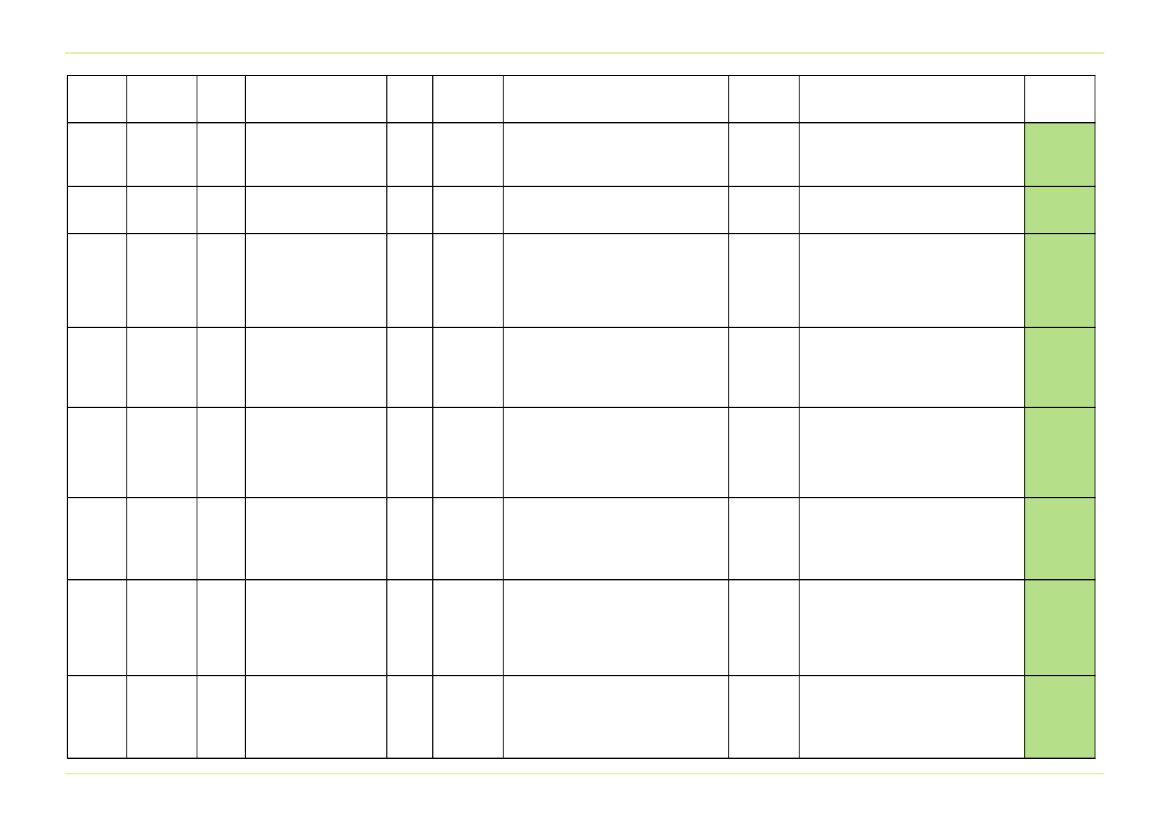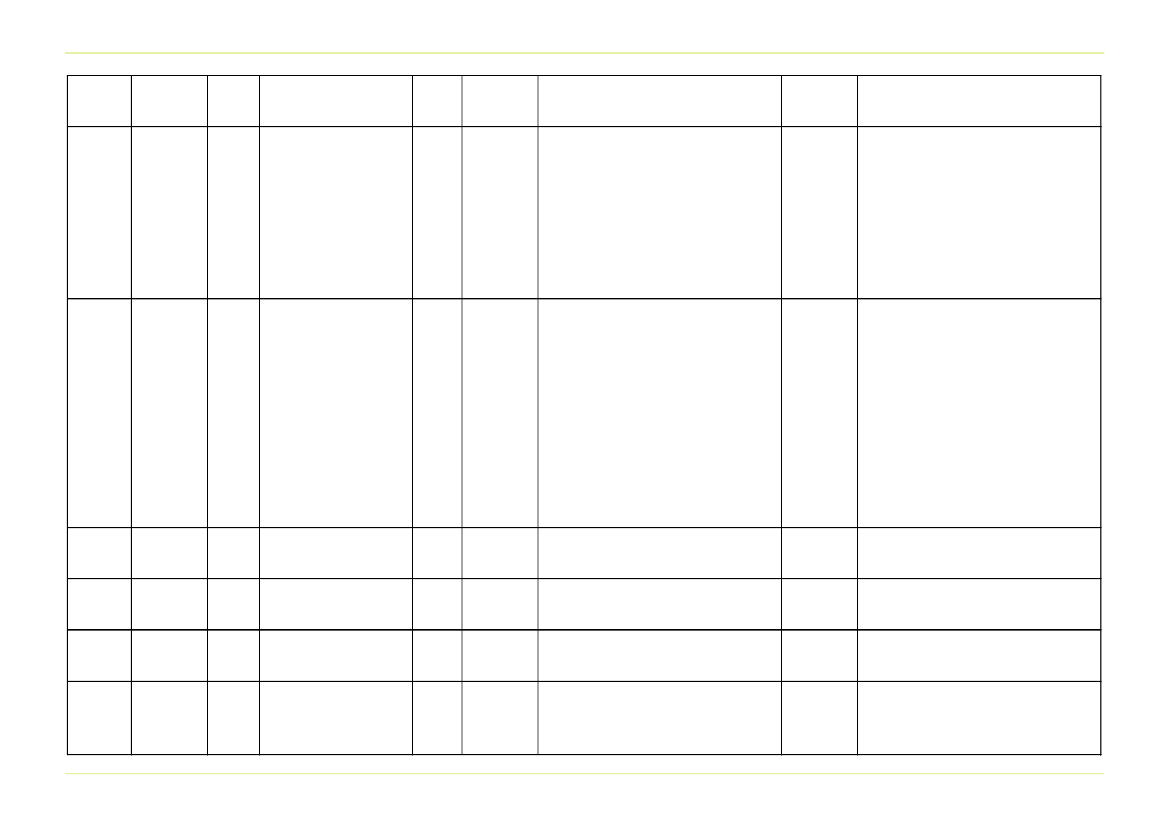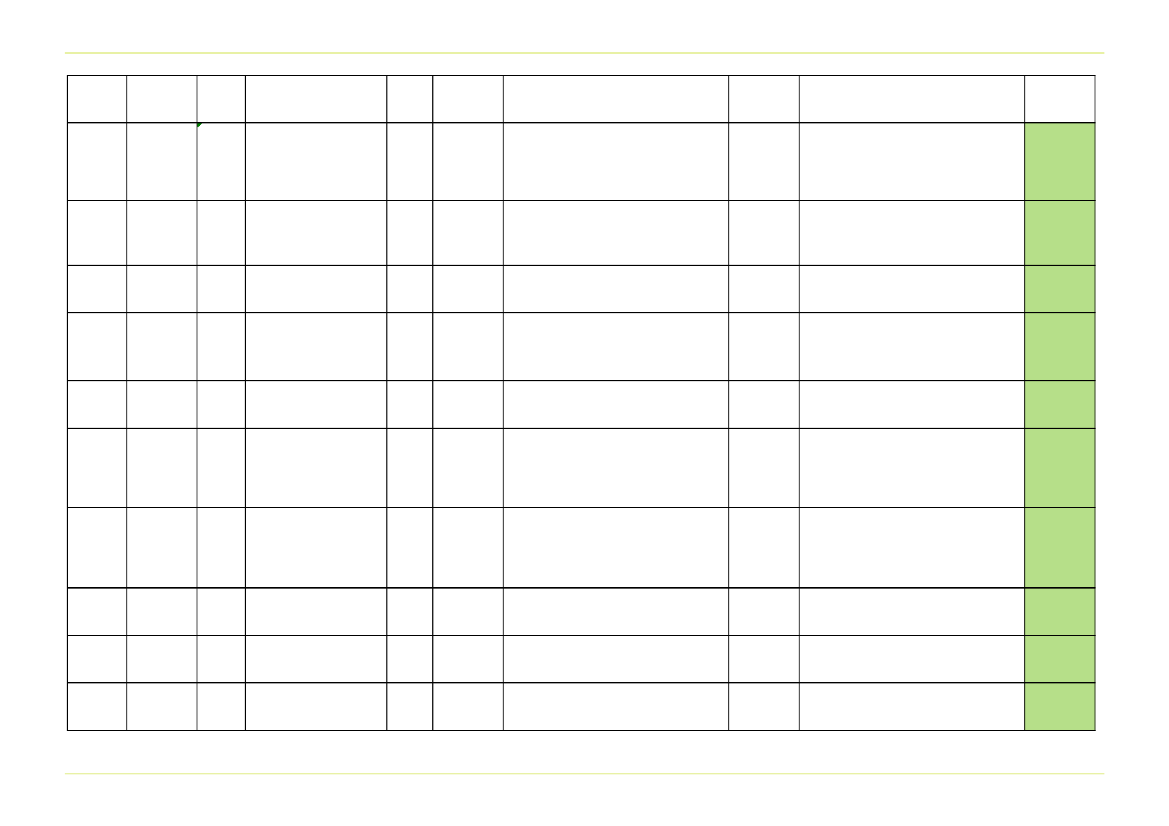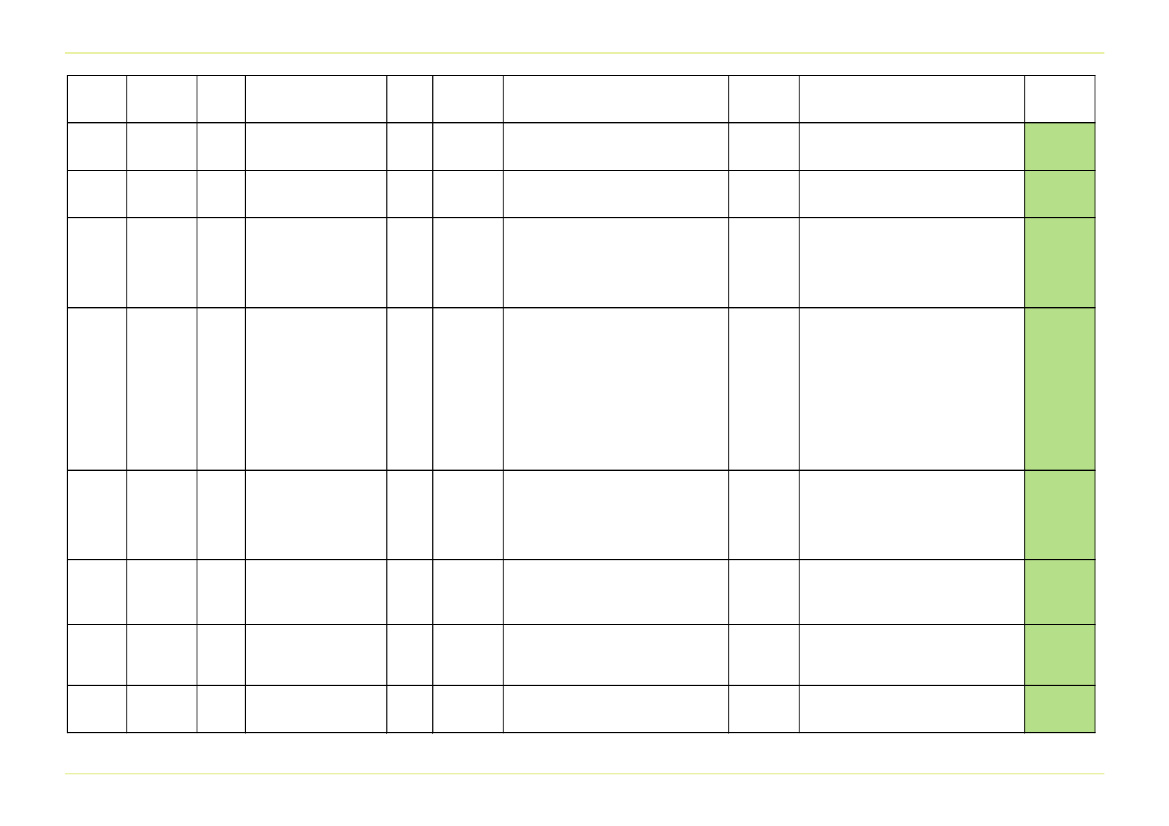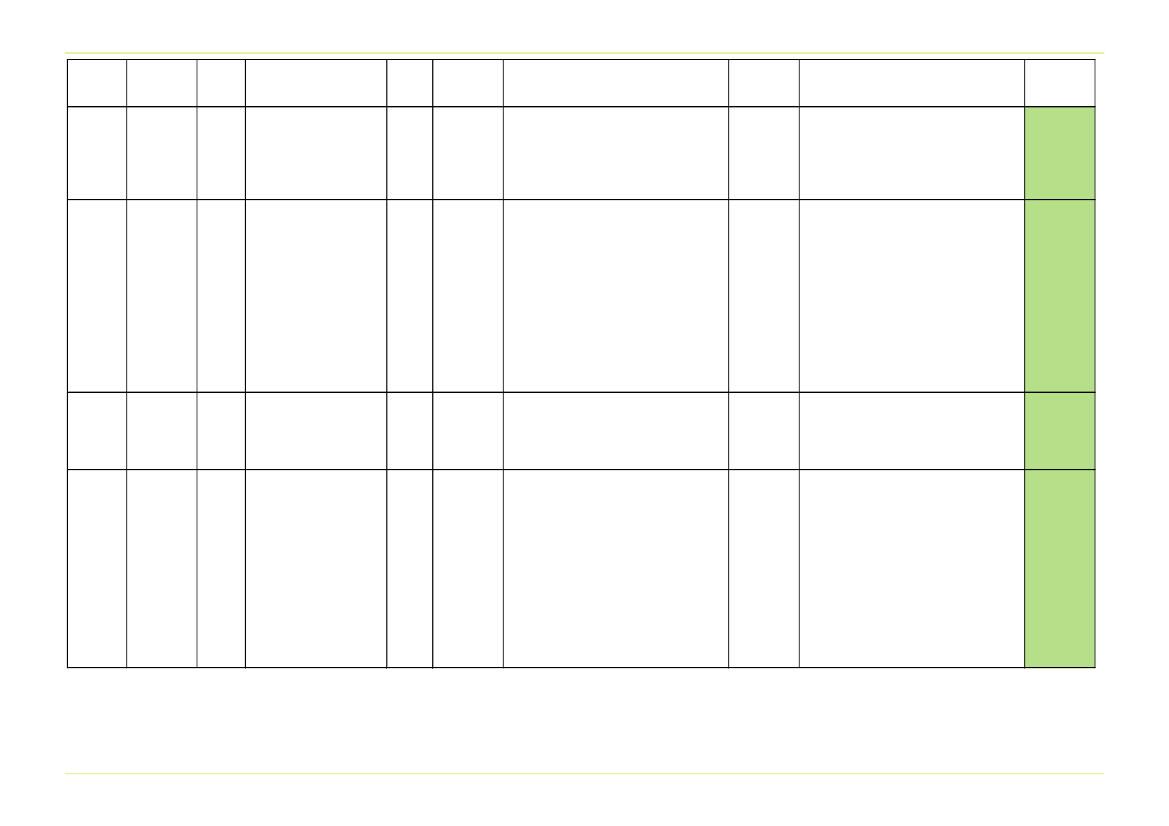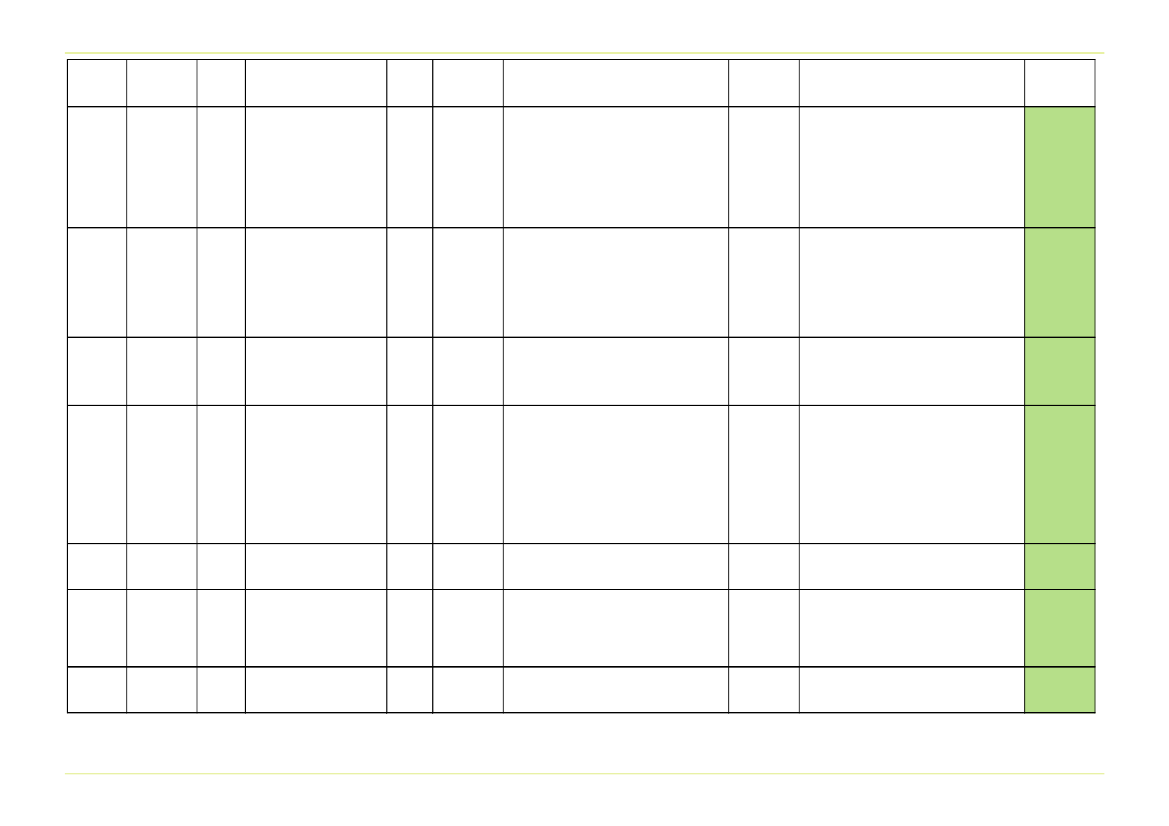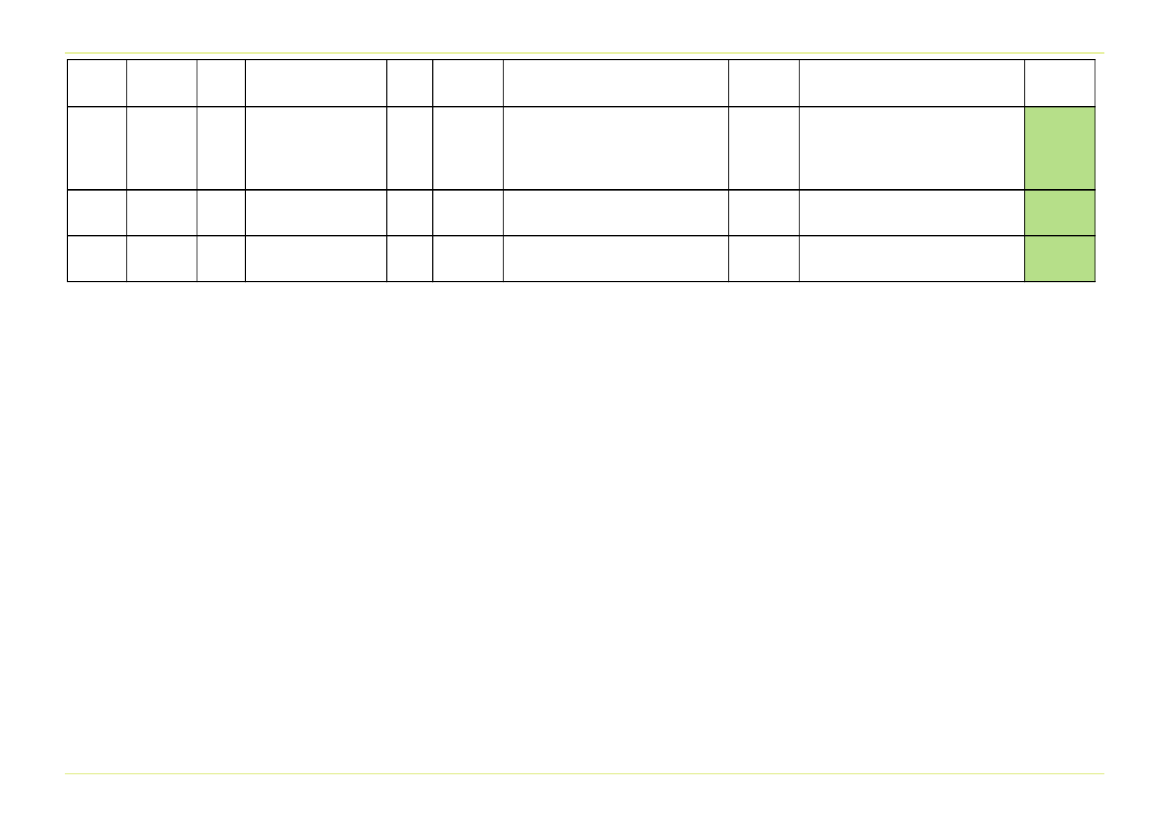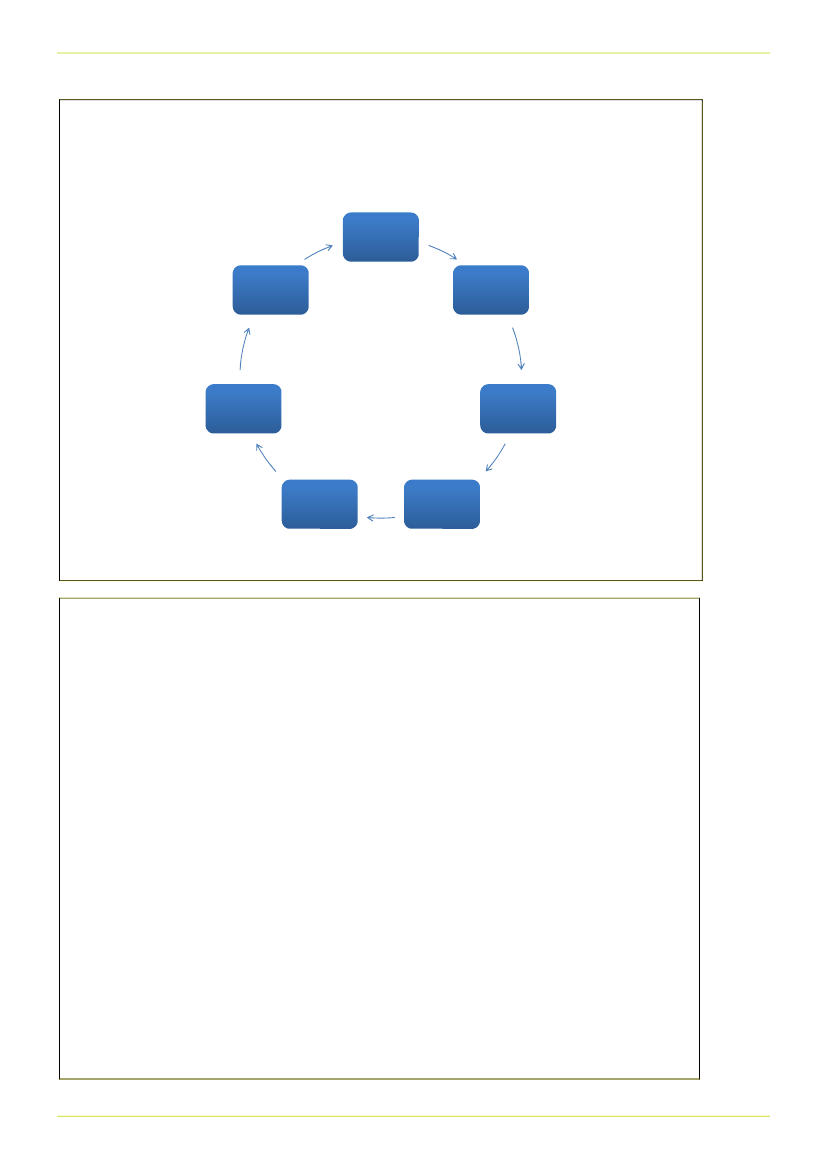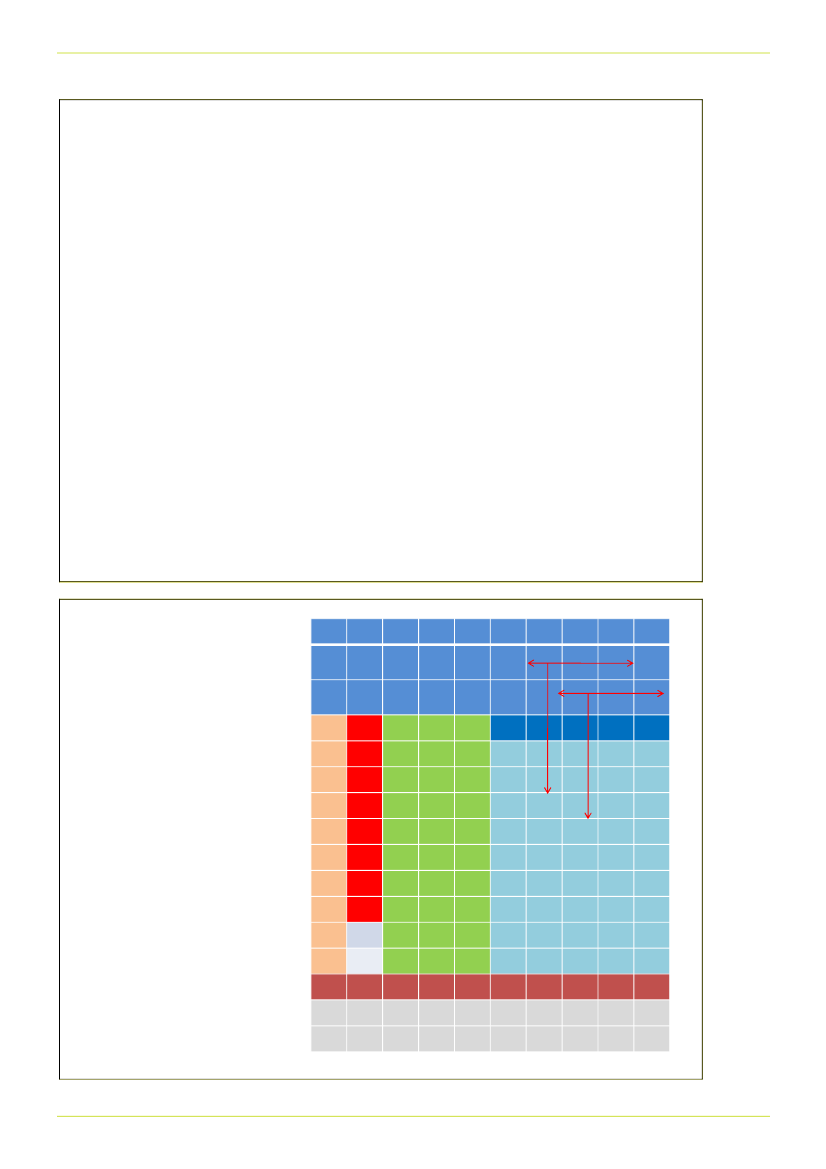Transportudvalget 2011-12
TRU Alm.del Bilag 91
Offentligt
Transportministeriet, Danmark
IC4/IC2 ReviewBackground Report19 October 2011
2
Table of ContentsChapter1.1.1.1.2.1.3.1.4.1.5.1.6.2.2.1.2.2.2.3.2.4.2.5.2.6.3.3.1.3.2.4.4.1.4.2.4.3.5.5.1.5.2.5.3.5.4.5.5.6.7.IntroductionTerminologyAssignmentRemitApproachScheduleDocumentationStatus of IC4 and IC2 DeliveryIC4 Train Delivery by ABIC4 Train Delivery by the DSB IC4 Project Team (IC4PT)IC2 Train Delivery by ABIC2 Train Delivery by IC4PTDelivery QualityApprovalsCurrent Problems with IC4Current Technical Problems and their RectificationAll Other Important Problematic IssuesOptions for Repairing IC4 ProblemsPossibilities for RectificationPlanned Entry to Service in Inter-Regional TrafficIC4 Project OrganisationReliability ImprovementIntroductionCurrent IC4 Reliability PerformanceCurrent Rectification Measures for IC4Reliability Objectives and Setting Reliability TargetsReliability Improvement Team and War Room ActivitiesConclusionsAppendicesA1 Glossary of TermsA2 Schedule of Meetings, Interviews, and VisitsA3 DocumentationA4 Question / Answer LogA5 Reliability Improvement Team - Working Methodology and Implementation
pages4444567881319222325282840434344454949495153556162
AtkinsIC4-IC2 Review - Background Report Iss 1 191011
3
NoticeThis document and its contents have been prepared and are intended solely for the Transportministeriet’sinformation and use in relation to the assignment for an external review of the IC4/IC2 project. It is based upondocumentation and information provided by the parties concerned in the Review and can be relied upon to theextent that the information thus provided can be relied upon.Atkins Danmark assumes no responsibility for omissions or errors in the provided information upon which thisReview is based, but any expression of opinion in this Report is the sole responsibility of Atkins. Atkins assumesno responsibility to any other party in respect of or arising out of or in connection with this document and/or itscontents.
Document History
JOB NUMBER:5105273Issue1PurposeFirst IssueOriginatedNick BrownKeith PalingPaul Finnegan
DOCUMENT REF:5105273.001/002CheckedKeith PalingReviewedAuthorisedDate19 Oct 11
John O’Flynn JohanStranddorf
AtkinsIC4-IC2 Review - Background Report Iss 1 191011
4
1.
Introduction
1.1.
Terminology
In this Report, the following terms are used for the main participants in the Review:-ABATDSBIC4PTIC4DTTRMTSAnsaldoBreda (Italy and Danmark)Atkins (Danmark and UK)Danske Statsbaner (Danish State Railways)DSB IC4 Project TeamDSB IC4 Drift (Operations) TeamTransportministeriet (Danish Ministry of Transport)Trafikstyrelsen (Danish National Safety Authority)
A full Glossary of terms used in this Report is presented in Appendix A1.
1.2.
Assignment
Transportministeriet, Danmark, has commissioned Atkins to undertake an independent external review of thestatus of the IC4/IC2 project. The work is being undertaken by Atkins Danmark with support from rolling stockconsultants in Atkins UK.
1.3.
Remit
The Terms of Reference for this external review of the IC4 and IC2 Project were set out in a TRM memorandum on26 May 11. The requirement for an external review arose due to fundamental uncertainty about the prospects forusing IC4 trains as planned in Danish inter-regional traffic. TRM stated that in order to utilise IC4 trains in long-distance traffic it must be possible to couple up to 4 train sets to meet the demand for high speed and Inter-Citytrains between the regions.At present, it is possible and approved for two trainsets to be coupled while in passenger service and DSB expectsto obtain approval for three trainset coupling before the end of 2011. However, there have been technical andoperating problems with two-coupled trainsets and this, together with other quality and technical problems, havecreated concern that the operational stability of IC4 trains will remain insufficient.This Review is expected to clarify these issues and the realistic possibilities for correcting them and, in this context,to address the following specific issues:-••review the status of IC4 and IC2 deliveryreview all current problems with IC4 by:-osurvey all major technical problems important for the passenger experience in terms of reliability andcomfort including problems relating to:-mechanical parts of the train, e.g. gearboxes, brakes, etccoupling of a number of train setscomputer problems, e.g. in relation to the train computer, other computers, their interaction withother parts of the train, including failure rateother technical and quality-related problemshandling of train sets by the operatoruncover all other important problematic issues
o
AtkinsIC4-IC2 Review - Background Report Iss 1 191011
5
•
review options for repairing the problems with IC4 including:-othe possibilities of rectifying the problems in total or in part including:-time perspectiveeconomic consequencesassess whether IC4 trains can be put into service in inter-regional traffic as plannedconsider the current IC4 project organisation and whether it should be changed
oo
Following a presentation of preliminary findings to TRM on 30 Aug 11, we were requested to undertake thefollowing additional tasks:-•ooo•oooTask 1Reliability Improvement
assess the current processes for reliability measurement, analysis, prediction, and reportingdevelop a plan for a Reliability Improvement Team in the DSB IC4 Project Teamdevelop a prediction for reliability improvementTask 2Technical Problems
further investigate problems with the coupling, brake, door, and HVAC systemsverify the current status of investigations and solutions to the axle reversing gear, compressors, IDU,and battery chargers.identify any other technical issues that are likely to have a high impact on reliability
1.4.
Approach
Our review has been undertaken by a process of meetings and interviews with representatives from AB, DSB, andTS; visits to AB and DSB production facilities in Italy and Danmark; and collection of documentation from AB, DSB,and TS. The review commenced on 29 Jun 11 and encompassed:-•••55 meetings and interviews5 visits282 documents in the following categories:-oapproval21ocontractual87oinformation7omaintenance19ooperational8oorganisational 12oproduction44oquality 7oreliability30osafety7otechnical41
The information thus collected has been reviewed and assessed and our findings are reported in the followingchapters.All aspects of the IC4 and IC2 projects are in progress so that data concerning production and modification ratesand operational performance are changing all the time. For the purposes of this Review, we have therefore taken a‘snapshot’ of the status of the projects as at 31 Aug 11.
AtkinsIC4-IC2 Review - Background Report Iss 1 191011
6
1.5.
Schedule
To undertake this Review, we have followed the schedule of activities presented below:-MonthJunWeek26Activities•Inception Meeting with TRM IC4 Steering Group in København•Meetings and interviews with IC4PT in København•Documentation and data collection•••••••Meeting with IC4PT in KøbenhavnMeeting with TS in KøbenhavnMeetings with IC4PT in ÅrhusMeetings and interviews with IC4DT in ÅrhusInspection tour of the IC4 maintenance facility in ÅrhusInspection tour of an IC4 train set in ÅrhusDocumentation and data collectionProgress Report1MilestonesSteering Groupmeeting
27
28
•Preliminary assessment of information, data, and documentationcollected to date•Progress Report No. 1 submitted to TRM IC4 Steering Group•••••••••••••Meetings and interviews with AB and DSB in Pistoia, ItalyInspection tour of AB’s production facilities in Pistoia, ItalyAdditional documentation and data collectionCommenced detailed assessment of information, data, anddocumentation collected to dateMeetings and interviews with IC4PT in ÅrhusMeetings with IC4DT in ÅrhusInterview with AB in Augustenborgadde, ÅrhusInspection tour of AB’s commissioning facility inAugustenborgadde, ÅrhusMeeting with AB, IC4PT, and DSB TM in RandersInspection tour of DSB TM’s facility at RandersCoupling demonstration in ÅrhusAdditional documentation and data collectionContinued detailed assessment of information, data, anddocumentation collected to date
29July
30
31
Interviews with IC4PT in KøbenhavnMeeting with Director, DSB Fjern- & Regionaltog in KøbenhavnAdditional documentation and data collectionContinued detailed assessment of information, data, anddocumentation collected to date•Submission of Progress Report No. 2 to TRM IC4 Steering Group•Interview with TS in København•TRM IC4 Steering Group meeting in København for presentation ofProgress Report No. 2•Additional documentation and data collection•Completed detailed assessment of information, data, anddocumentation collected•Commenced preparation of preliminary findings•Additional documentation and data collection•Continued preparation of preliminary findings•Additional documentation and data collection•Completed preparation of preliminary findings
••••
Progress Report2
32August
Steering Groupmeeting
3334
AtkinsIC4-IC2 Review - Background Report Iss 1 191011
7
Month
Week35
Activities••••Presentation of preliminary findings to TRM in KøbenhavnTasked with additional workMeeting with IC4PT in KøbenhavnAdditional documentation and data collection
MilestonesTRM Meeting
September
36
•Meetings and interviews with IC4PT in København•Interview with IC4PT and IC4DT in Århus•Additional documentation and data collection•Meetings and interviews with IC4PT and IC4DT in Århus•Additional documentation and data collection•Assessment of additional information, data, and documentationcollected•Commenced preparation of Draft Report•Completed preparation of Draft Report•Submission of Draft Report to TRM Steering Group•Presentation of Draft Report to TRM Steering GroupDraft ReportSteering Groupmeeting
3738
3940
A full record of all meetings and interviews is presented in Appendix A2.
1.6.
Documentation
All documents received in the course of the Review have been allocated a Unique Reference Number (URN) andthe URN numbers are used throughout this Report for references to relevant documents. Details of all documentsreceived are recorded in URN number order in Appendix A3.In parallel with meetings, interviews, and reviews of documentation, a Question / Answer process has been used toclarify or follow-up various matters as recorded in Appendix A4.
AtkinsIC4-IC2 Review - Background Report Iss 1 191011
8
2.
Status of IC4 and IC2 Delivery
2.1.
IC4 Train Delivery by AB
The IC4 and IC2 projects have a complicated history resulting in a complex situation in terms of contractualconsiderations, train design configuration, train delivery, and type approval. In order to define the current status ofthe IC4 and IC2 projects in terms of their delivery, it is thus necessary to understand the contractual history.In 1998, DSB launched a “Good Trains for All” (GTA) programme to expand and upgrade its passenger services.Leading the programme would be the acquisition of a new fleet of DMMUs for long distance inter-regional serviceswhich would allow redeployment of the existing IC3 and IR4 trains to increase service frequencies on other Inter-City and inter-regional routes. The programme also included the acquisition of new EMUs and infrastructureimprovements, including the development of regional routes around Odense, Århus, Aalborg and Esbjerg. (source– Railway Gazette International)Following a competitive tendering process, DSB awarded the GTA rolling stock contract to Breda CostruzioniFerroviarie (AnsaldoBreda (AB) from 2001), an Italian rolling stock manufacturer, in December 2000 (URN 197).Under this contract, AB were to supply 83 x 4-car diesel-mechanical multiple unit (DMMU) trainsets to bedesignated IC4. The trainsets were to be designed to meet DSB’s technical requirements and were intended toreplace DSB’s IC3 trainsets on long-distance traffic.The IC4 technical specification required that up to 4 trainsets could run in multiple, i.e. a train formed of 16 cars,and this, together with the interior design layout, offered a significant increase in passenger traffic capacity over thefleet of IC3 trainsets so as to meet anticipated growth in passenger traffic.In November 2002, DSB extended the original contract with AB for the additional supply of 23 x 2-car DMMUtrainsets to be designated IC2, see Section 2.3 (URN 199). The IC2 trainsets were intended to operate primarilyon the Odense to Svendborg route, but also to have the capability to operate with IC4 trainsets on long-distanceservices.The GTA contract required AB to design, manufacture, and commission the two fleets of trainsets and to obtaintype approval from the National Safety Authority (Trafikstyrelsen (TS)) for operation in passenger service. The firstrdIC4 trainset should have been delivered by AB in April 2003 with the final (83 ) IC4 trainset to be delivered in July2005. For various well-known reasons this delivery programme was not achieved.Between 2005 and 2008, four IC4 trainsets were shipped to Danmark for testing and passenger service. Thesetrainsets were permitted to run only as single units and only in regional traffic (URN 015). Although limitedpassenger services commenced in 2007 in Jylland, these trainsets were never handed over to DSB and, followingsevere technical problems, operation of the trainsets was suspended by DSB in February 2008.In May 2008, DSB issued an Ultimatum to AB to deliver 2 trainsets by August 2008 and a further 12 trainsets byMay 2009, all 14 trainsets to be approved for operation as single units in National Traffic (NT), together with 1trainset approved for multiple unit operation (MPTO). Failure to achieve these requirements would cause thecontract to be terminated and appropriate compensation sought.AB met the terms of the Ultimatum by delivering 14 trainsets designated NT++ (URN 019) and 1 trainsetdesignated MPTO (URN 020/202) by 01 May 09. Conditional Type Approval for NT++ trainsets was obtained on27 Jan 09 (URN 049 and, subsequently, URNs 043/052)and for the MPTO trainset on 04 May 09 (URN 050/051).Immediately following this, the two parties negotiated a Settlement Agreement, designated an Addendum, tomodify the terms of the original contract (URN 198). This Addendum was signed on 19 May 09.Under the terms of the Settlement Agreement, DSB recognised and accepted that the design configuration of theMPTO trainset, No. 5622, did not meet the original specified requirements, but agreed that the balance of 68trainsets should be delivered by AB to the same design configuration and quality levels as represented by trainset5622. Effectively it was agreed that trainset 5622 would act as a benchmark for acceptability of all further trainsetdeliveries. To meet this requirement, AB accepted that it would have to upgrade the fleet of 14 NT++ trainsets tothe MPTO design configuration as part of the on-going delivery programme.
AtkinsIC4-IC2 Review - Background Report Iss 1 191011
9
The delivery of each IC4 trainset comprises a number of stages of assembly, testing, and inspection in Italy,shipment by rail to Danmark, and commissioning and inspection in Danmark prior to Takeover of the trainset byDSB from AB. For the purposes of this Review, all stated delivery dates refer to the Takeover date.The Settlement Agreement contained a new delivery schedule whereby trainset 5622 was considered to be the firstdelivery, the second trainset 5621 was to be delivered by 15 Nov 09, the third trainset 5623 was to be delivered by28 Feb 10 and the remaining 80 trainsets, including the 14 NT++ trainsets to be upgraded, were to be deliveredbetween 30 Apr 10 and 31 Jul 12 at an average production rate of 2.86 trainsets per month (URN 022).In order to meet the Settlement Agreement schedule, AB significantly increased their production capacity so as toachieve coach production, train assembly, and shipment from three sites instead of two and coach production atanother two sites as shown in the Table below:-Table 2.1.A - AB Train Production Facilities for IC4SitePistoiaLocationItalyCompanyABActivityMotor coach productionTrain assembly(trailer coaches from Reggio Calabria)Testing, inspection, shipmentMotor coach productionTrain assembly(trailer coaches from Piacenza or Reggio Calabria)Testing, inspection, shipmentMotor coach productionTrailer coach productionTrain assemblyTesting, inspection, shipmentTrailer coach productionBogie productionTCMSCommissioning
Verona
Italy
OFV
Piacenza
Italy
SITAV
Reggio CalabriaNapoli
ItalyItaly
ABAB
Århus
Danmark
AB
Nevertheless, due to on-going concern as to AB’s ability to deliver to the new schedule, a revised schedule wasagreed on 16 Dec 10 whereby AB contracted DSB TM to undertake the 14 NT++ trainset upgrades at a leasedfacility in Randers, Danmark, thus allowing AB to focus on delivery of the other 69 trainsets from Italy to the originalend date of July 2012 (URN 038).In March 2011, AB and IC4PT commenced discussing a further Settlement Agreement for the IC4 and IC2 projectsto cover various items (URN 178) including:-•••••commercial issues related to on-going delivery of the trainsets;outstanding warranty claims;extension of the 50% discount on spares orders to end-2012;spares stock levels at Århus depot; andfurther development of TCMS under the upgrade contract.
These discussions are currently suspended, but will have to resume at some point in order to close-out the IC4/IC2Contract.In order to assess AB’s ability to meet the revised schedule of 16 Dec 10 (URN 038), Atkins visited Pistoia, Italy, formeetings and interviews with AB representatives and visited the Pistoia train production and test facilities (URN178). We also visited the AB commissioning facility at Augustenborggade, Århus, Danmark, and the DSB TMfacility at Randers, Danmark, for meetings and interviews with AB and DSB TM representatives. We found that:-
AtkinsIC4-IC2 Review - Background Report Iss 1 191011
10
•
All 332 coach bodies had been manufactured and were in various conditions of fit-out when production wasfrozen prior to the Settlement Agreement. All the bogies had also been manufactured. As a result, thecoaches entered Long Term Storage (LTS) until production re-commenced. No special precautions weretaken to protect equipment during LTS.The conditions in which LTS took place required that all coaches receive a pre-production check toestablish the presence and condition of all components before being stripped of equipment prior to enteringthe current production line. Where applicable, the removed equipment is returned to original suppliers forre-work, testing, and re-delivery in as-new condition. These pre-production checks have been completedfor all 332 coaches.Following pre-production checks, the stripped coaches undergo exterior repainting to the originalspecification and the exterior (and interior) surface treatments are subject to extended warranty, see Table2.2.A.There have been delays to production in Italy due to materials supply shortages which have now beenlargely overcome (URNs 026/040).AB has delivered 35 trainsets up to 31 Aug 11. Discounting the first three trainsets (5622/5621/5623), thisis 32 trainsets in 17 months representing an average production rate of 1.88 trainsets/month.Within the period up to 31 Jul 11 and ignoring initial production ramp-up at each site, the deliveries haveaveraged 0.56 trainsets/month from Pistoia, 0.82 trainsets/month from Verona, and 0.73 trainsets/monthfrom Piacenza, providing a total of 2.11 trainset/month.As a result, AB is 11 trainsets behind the revised schedule as at 31 Aug 11, requiring the delivery of 34trainsets in the next 11 months to achieve the end date of July 2012. This represents an average rate ofdelivery of 3.09 trainsets/month, although to end-July 2011 AB has achieved 3 trainsets per month in only 4months (Apr 10, May 10, Nov 10, Mar 11, Aug 11).Each site has been further ramping up its production capability such that, theoretically, AB could nowdeliver up to 3.25 trainsets/month.Re-delivery of NT++ trains upgraded to MPTO are well behind schedule, see below.
•
•
•••
•
••
The revised schedule of December 2010 (URN 038) required the first upgraded NT++ trainset to be re-delivered asthan MPTO trainset in March 2011 and the final (14 ) trainset in June 2012. However, the first trainset (5604 handedover to AB by IC4PT on 30 Sep 10) and the second trainset (5616 handed over to AB by IC4PT on 03 Jan 11) arestill in production having suffered severe delays for a variety of reasons. Trainset 5604 has been completed and isundergoing functional testing prior to Takeover by IC4PT while trainset 5608 has joined trainset 5616 in production.DSB TM has proposed to increase its production manpower resource by 52% and its testing manpower resourceby 100%, retaining the existing two production tracks but increasing the test tracks from the present one to two. Onthis basis, DSB TM has proposed an updated delivery schedule with the first upgraded NT++ trainset to be re-thdelivered in October 2011 and the final (14 ) trainset in September 2012 (URN 184). This requires the completionof 14 trainsets in 12 months, a rate of 1.17 trainsets/month. We consider this proposition to be optimistic.Given the above, we have considered the overall delivery programme of 69 MPTO trainsets from Italy and 14 NT++upgraded trainsets from Randers in order to project BEST, LIKELY, and WORST case scenarios. The results,shown in Fig. 2.1.B overleaf, are based upon the following assessments:-•The BEST case projection assumes that AB delivers the remaining trainsets from Italy at a rate of 3.00trainsets/month every month from August 2011 and that NT++ upgraded trainsets are re-delivered inaccordance with DSB TM’s proposed programme (URN 184).The LIKELY case projection assumes that AB delivers the remaining trainsets at a rate of 2.50trainsets/month every month from August 2011 and that NT++ upgraded trainsets are re-delivered at a rateof 0.67 trainsets/month from November 2011.The WORST case projection assumes that AB continues to deliver the remaining trainsets at the rateachieved up to 31 Jul 1 of 1.81 trainsets/month and that NT++ upgraded trainsets are re-delivered at a rateof 0.50 trainsets/month from December 2011.
•
•
AtkinsIC4-IC2 Review - Background Report Iss 1 191011
11TrainSetNo.562256215623562456255626562756285630562956315632563356355636563756345639563856435640564156445642564556475646564856515649565256605650565356545655565656575658565956615604566256635664566556165666566756685608566956705671567256065673567456755676560756775678567956805611568156825683560156125602560356055609561356105614561556175618561956202009JFMAMJJASONDJFMAM2010JJASONDJFMAM2011JJASONDJFMAM2012JJASONDJFMAM2013JJASONDJ2014FM
MPTOMPTOMPTOMPTOMPTOMPTOMPTOMPTOMPTOMPTOMPTOMPTOMPTOMPTOMPTOMPTOMPTOMPTOMPTOMPTOMPTOMPTOMPTOMPTOMPTOMPTOMPTOMPTOMPTOMPTOMPTOMPTOMPTOMPTOMPTOMPTOMPTOMPTOMPTOMPTOMPTONT++ trainset undergoing upgrade to MPTOMPTOMPTOMPTOMPTONT++ trainset undergoing upgrade to MPTOMPTOMPTOMPTONT++ trainset waiting upgrade to MPTOMPTOMPTOMPTOMPTONT++ trainset in traffic to be upgraded to MPTOMPTOMPTOMPTOMPTONT++ trainset in traffic to be upgraded to MPTOMPTOMPTOMPTOMPTONT++ trainset in traffic to be upgraded to MPTOMPTOMPTOMPTOTrainset to be re-engineered by AB to MPTONT++ trainset in traffic to be upgraded to MPTOTrainset to be re-engineered by AB to MPTOTrainset to be re-engineered by AB to MPTOTrainset to be re-engineered by AB to MPTOTrainset to be re-engineered by AB to MPTONT++ trainset in traffic to be upgraded to MPTOTrainset to be re-engineered by AB to MPTONT++ trainset in traffic to be upgraded to MPTONT++ trainset in traffic to be upgraded to MPTONT++ trainset in traffic to be upgraded to MPTONT++ trainset in traffic to be upgraded to MPTONT++ trainset in traffic to be upgraded to MPTONT++ trainset in traffic to be upgraded to MPTO
Notes:-= BEST case delivery dates (Atkins projection) and ACTUAL dates up to Aug-11= LIKELY delivery dates (Atkins projection)= WORST case projected dates (Atkins projection)
Fig. 2.1.B - AB Train Delivery Programme Assessment
AtkinsIC4-IC2 Review - Background Report Iss 1 191011
12
From this assessment, we conclude that it is possible, but unlikely, that AB will deliver the last trainset to DSB inJuly 2012 in accordance with the revised Settlement Agreement schedule of 16 Dec 10 (URN 038). However,given the track record to date for deliveries from Italy, the current difficulties that AB and DSB TM have in deliveringthe NT++ upgrade programme, and additional problems likely to be presented by re-engineering the completedtrainsets in Italy that have not been taken over by DSB (Nos. 5601/5602/5603/5605/5609/5610), we consider thatthe following projected completion dates should be used by IC4PT for on-going planning of the project:-Table 2.1.C - AB Train Delivery Programme AssessmentCaseSettlement AgreementRevised Schedule (16 Dec 10)BEST CaseLIKELY CaseWORST CaseCompletion DateJuly 2012September 2012May 2013February 2014
In addition to our assessment of AB’s delivery programme, we have considered the percentage progress byanalysing the following parameters:-•••the number of key post-Settlement production stages (H1, H2, H3, H4, shipment to Danmark, Takeover)that have been completed by AB as a percentage of the total required for the fleet of 83 trainsets;the number of trainsets taken over by DSB; andthe value of stage payments made by DSB to AB as a percentage of the total contract value excludinglump sum payments.
In the latter case, the total contract value for IC4 under the Settlement Agreement is 3,771,834,000 DKK. Thisincludes lump sum payments and stage payments for the trainsets, workshop equipment, spares, and training, butexcludes tax. To date, AB has invoiced for 2,955,800,000 DKK of which 10,000,000 DKK is currently withheld byDSB (URN 214 and subsequent information). Thus the percentage payment to AB is now 78%. It should also benoted that all prepayments to AB are in the form of performance bonds from approved banks; DSB can withdrawfrom these if they consider AB to be in breach of contract.However, the payments to AB are subject to a 50% rebate and 50% discounts on orders for spares up to a ceilingof 1 billion DKK and this is explained further in Section 4.1.3.The apparent discrepancy in Table 2.1.C between percentage production and percentage payments to date hastwo reasons:-••all lump sum payments are complete; andfor the purposes of this Review we have assessed percentage production stages completed post-settlement whereas a considerable number of production stages had been completed and paid for prior tothe Settlement Agreement.
The results of our progress assessment are presented in the following table:-Table 2.1.D - AB Train Delivery Progress AssessmentMeasurePost-settlement productionstages completedTrainsets taken over by DSB(35 out of 83)PaymentsPercentageCompletion71%
42%78%
AtkinsIC4-IC2 Review - Background Report Iss 1 191011
13
Our assessment of AB’s capability to achieve the delivery programme does not take into account any possibleimpact on delivery of the published announcement on 23 Aug 11 that Finmeccanica may sell or close AB. Theimpact of such a decision is unpredictable at this stage and, until more is known about the developing situation, itshould be assumed that Finmeccanica will require AB or any successor body to fulfil its current contractualobligations.It should also be noted that one of the six completed trainsets that have remained in AB’s hands throughout theproject, 5609, is in Libya. Given the present situation in that country, this trainset may prove unrecoverable.
2.2.
IC4 Train Delivery by the DSB IC4 Project Team (IC4PT)
Under the terms of the Settlement Agreement, DSB recognised and accepted that the design configuration of theMPTO trainset 5622 did not meet the original specified requirements, but agreed that the balance of 68 trainsetsshould be delivered by AB to this design configuration and quality levels and that the 14 NT++ trainsets should alsobe upgraded by AB to the MPTO design configuration. This change relieved AB of four important contractualobligations:-••••further engineering development of the trainsets to achieve conformance to the specified requirements forentry to inter-regional passenger traffic;obtaining type approvals from TS for developed design configurations;achievement of contractual reliability and life cycle cost targets; andwarranty of the trainsets.
Among exceptions to the above are certain extended warranty obligations in the original contract that havesurvived the Settlement Agreement and AB is still obligated to supply spare parts. The extended warranty, as perthe original contract, commences with delivery of each trainset and covers:-Table 2.2.A - AB Extended Warranty ObligationsComponentTraction motors and mechanical traction equipmentAxlesMonobloc wheelsExterior and interior painting - corrosionExterior and interior painting - colour and glossInsulated windowsBogie frames 10 yearsCarbodyWarrantyPeriod5 years6 years6 years12 years6 years5 years10 years15 years
In return for this reduction in the supply requirements from AB, significant compensation was agreed in the form ofdiscounts and this is considered further in Section 4.1.3.The practical effect of these contractual changes is that IC4PT (within DSB) is now the train supplier with AB as asub-contract train assembler and the IC4DT (within DSB) is the customer. This de facto situation is recognised byTS who has approved IC4PT’s Safety Plan (URN 008) as a train supplier, not as a railway operator.Thus, IC4PT now carries all the responsibilities for ensuring that the trainsets are engineered to a level offunctionality, quality, and reliability and achieve type approval from TS so that the fleet can enter passenger trafficon long-distance Inter-City services as intended.
AtkinsIC4-IC2 Review - Background Report Iss 1 191011
14
As a result, the project team has had to change since May 2009 from a procurement organisation responsible formanaging the then main contractor, AB, to an engineering organisation capable of undertaking the necessaryactions to complete the engineering and delivery of the fleet whilst continuing to manage the supply of trainsetsfrom AB (URNs 005/145/188/189). A portion of the Settlement Agreement compensation was budgeted by DSB tocover these additional engineering costs, see Section 4.1.3.From IC4PT’s experience of operating and maintaining the 14 NT++ trainsets, they identified 750 technical issueswhich IC4PT considered had to be addressed for the IC4 to be considered acceptable for its intended purpose.These were analysed and prioritised down to 137 technical issues that should be addressed initially. In turn, thesewere aggregated into what became designated 50 ‘Known Issues’ in 8 categories with a Team Leader assigned toeach category (URN 023).IC4PT planned to introduce engineering changes to the trainsets to address the 50 Known Issues (plus 440 TCMSissues) in two phases identified as Engineering Pack 1 (URN 021) and Engineering Pack 2 (see below). Furtherchanges were envisaged in an as yet to be defined Engineering Pack 3. Subsequently, some of the changesplanned for Packs 1 and 2 have been replaced by other modifications to address more urgent issues arising fromthe experience of running MPTO and MPTO P1 trainsets.A key consideration for IC4PT was that, in MPTO design configuration as delivered by AB, only limited couplingcapability was available and then only to a maximum of 2 trainsets instead of the 4 trainsets required for operationin long-distance services. This was more a question of lack of functional testing in 2, 3, and 4 trainset coupledconfigurations than of design, although there were also technical issues associated with operating in coupled trainformations. IC4PT therefore decided that the Train Control Management System (TCMS) should be subjected to aseparate upgrade process and, following a competitive tendering process, a contract was awarded in November2009 to AB to the value of 210,000,000 DKK, but now subject to a 50% discount under the Settlement Agreement,to provide the following:-•••••Software Package 1 to include 2 trainset coupling configurationSoftware Package 2 to include 3 trainset coupling configurationSoftware maintenance for 5 years from completion of the warranty periodOption to upgrade IC2 TCMS to a level comparable with IC4Option for further development of TCMS
The TCMS upgrade programme is being conducted in parallel with the engineering changes encompassed in Pack1 and Pack 2 and IC4PT has aligned delivery of the two workstreams so that type approval and implementation iscombined, Pack 1 Engineering with Package 1 TCMS and Pack 2 Engineering with Package 2 TCMS (URNs028/107).Up to August 2011, IC4PT had fitted Pack 1 Engineering to 18 MPTO trainsets of which 12 entered traffic and 6remained in development testing and simulation running, but has now prioritised fitting a partial Pack 2, designatedDriftpakke 2 or Pack 2D, to all 18 MPTO P1 trainsets, primarily to rectify climatic problems experienced during the2010/2011 winter period (URNs 265/266/267). Fitting Pack 2D has commenced on trainsets 5630 and 5646 and isscheduled to be completed by end-November 2011. In order to facilitate this programme, IC4PT has temporarilysuspended modifications to MPTO trainsets delivered by AB and subsequent running simulation in order to utilisefully the 2 available tracks in Århus Depot. Trainsets fitted with Pack 2D will have to re-enter the productionprogramme at some stage in order to receive the remaining Pack 2 modifications which, for the purposes of thisReport, we have designated Pack 2A. IC4PT has also decided to withdraw all NT++ trainsets from passengerservice by December 2011 to await upgrade to MPTO design configuration by AB and then Pack 1+2 modificationby IC4PT.Until recently, it was IC4PT’s intention to develop an Engineering Pack 3 aligned with a Package 3 TCMS upgrade.This would have completed IC4PT’s programme of engineering and TCMS changes to deliver 4-set coupledmultiple operation. However, a TCMS Package 3 would have to be negotiated with AB at additional cost under theoption for “further development” in the TCMS Upgrade contract, while engineering changes are now being plannedon a staged basis rather than as a single pack of modifications. IC4PT has only recently commenced planningmodifications to follow the implementation of Pack 2 and those changes that are under consideration have beendivided into two stages designated Pack 2.1 and Pack 2.2, with each modification having to be justified by abusiness case.We consider that the current approach to further development of the trainsets is sensible but with tworecommendations:-
AtkinsIC4-IC2 Review - Background Report Iss 1 191011
15
•
The timescale to implement TCMS Package 3, should its development proceed, should not be linked to theprogramme of other engineering changes. The TCMS changes are to software only and once developed,tested, verified, and approved, can be implemented quickly across the whole fleet.The programme of engineering changes has to be focused on reliability improvement, see Section 5 of thisReport, and developed and implemented more quickly than the current approach will allow.
•
Essentially, Packs 2.1 and 2.2, or their equivalents, together with further engineering changes to be brought in bythe IC4PT, should be implemented within the same timeframe as is currently planned for the fitments of Pack 2 tothe trainsets. The current situation with the stages of production by IC4PT are summarised in the following Table:-Table 2.2.B - IC4PT Modifications to IC4 TrainsetsPackPack 1Package 1Pack 2DPack 2APack 1+2Pack 1+2Package 2Pack 2.1Pack 2.2Pack 2.3Further PacksPackage 3CategoryEngineeringTCMS UpgradeEngineeringEngineeringEngineeringEngineeringTCMS UpgradeEngineeringEngineeringEngineeringEngineeringTCMS UpgradeStatus as at 31 Aug 11Fitment completed for 18 MPTO trainsetsFitment completed for 18 MPTO trainsetsTo be fitted to 18 MPTO P1 trainsets in Oct/Nov 11To be fitted to 18 MPTO P2D trainsets at some stageFitted to 2 MPTO trainsets for type approval testsTo be fitted to all MPTO trainsets from Dec 11To be fitted to all trainsets from Oct 11In developmentIn developmentTo be consideredTo be consideredTo be considered
Conditional type approval for implementation of Pack 1, including the TCMS Package 1 changes, was obtained on04 Nov 10 which allowed MPTO P1 trainsets to commence operation in passenger service in 2-trainset coupledconfiguration from January 2011 (URN 042). Coupled operation was implemented initially, but was thensuspended due to problems with the coupling and uncoupling system, see Section 3.1.3. For a period, MPTO P1trainsets operated in traffic as single units, but multiple 2-coupled operation re-commenced recently.The first 5 MPTO P1 trainsets entered traffic in January 2011 and, since then, a total of 18 MPTO trainsets havebeen so modified. Pack 1 fitments have taken 10 working days to implement and 2 tracks within Århus Depot wereallocated for the work. During August 2011, trainsets 5638 and 5660 were fitted with the combined Pack 1+2 inorder to enter a test programme aimed at obtaining Type Approval in October or November 2011.IC4PT is considering plans for ramping up production at Randers and other potential sites, including modificationfitment and testing, in conjunction with vacating the preset 2 tracks in the Århus Depot so that this facility can focusentirely on maintenance activities, and expects to achieve the same output for combined Pack 1+2 fitments as theprevious Pack 1 fitments giving a production rate of 4 trainsets/month. However, at this production rate thedelivered MPTO trainsets will have to be stored by IC4PT for periods of 4 to 5 months each while waiting for Pack1+2 fitment before they can enter passenger service and we therefore conclude that the production rate should beincreased to at least 6 trainsets/month.We have reviewed IC4PT’s progress with the fitments of modifications to date and their plans to fit Pack 2D and thecombined Pack 1+2 and, against this background, we have assessed their resource levels, capabilities, andcompetences. From this review, and using the LIKELY delivery of MPTO trainsets by AB shown in Fig. 2.1B as a
AtkinsIC4-IC2 Review - Background Report Iss 1 191011
16
starting point, we have projected BEST, LIKELY, and WORST CASE scenarios for the delivery by IC4PT ofmodified trainsets to traffic with the results shown in Fig. 2.2.C overleaf:-TrainSetNo.562256215623562456255626562756285630562956315632563356355636563756345639563856435640564156445642564556475646564856515649565256605650565356545655565656575658565956615604566256635664566556165666566756685608566956705671567256065673567456755676560756775678567956805611568156825683560156125602560356055609561356105614561556175618561956201+21+21+21+21+21+21+21+21+21+21+21+21+21+21+21+21+21+21+21+21+2 1+21+2 1+21+21+21+2 1+21+21+21+21+21+21+21+21+21+21+21+21+21+21+21+21+21+21+21+21+21+21+21+21+21+21+21+21+21+21+21+21+21+21+21+21+21+2 1+21+2 1+21+2 1+21+2 1+21+21+21+21+21+21+21+21+21+21+21+21+21+21+21+21+21+21+21+21+21+21+21+21+21+21+21+21+2 1+21+21+21+21+21+21+21+21+21+21+21+21+21+21+21+21+21+21+21+21+21+21+21+21+21+21+21+21+21+21+21+21+21+21+212D1+21+21+21+21+21+21+21+21+21+21+21+21111112D2D2D2D2D 2D2D 2D1+21+21+22A2A2A12D 2D 2D1+21+21+22A2A2A2A2A2A2A2A2A2A2A2A2A2A2A2A2A2A111112D2D 2D1+22D 2D 2D1+22D 2D 2D2D 2D 2D1+21+21+21+21+21+22A2A2A1+21+22A2A2A2A2A2A1+21+22A2A2A1112009JFMAMJJASONDJFMAM2010JJASONDJF1MAM2011JJASON2D2D1+2 1+22D 2D1+2 1+2 1+21+22D 2D1+2 1+21+22A2A2A2A2A2A1+2 1+22A2A2A2A2A2ADJFMAM2012JJ2A2AASONDJFMA2A2AM2013JJASO2A2ANDJF2014MAM
Notes:-= ACTUAL delivery dates by AB up to Aug-11= LIKELY delivery dates by AB (Atkins projection)12D2D2D= ACTUAL delivery dates by DSB for Pack 1 fitment= BEST case delivery dates for Pack 2D fitment to trainsets already fitted with Pack 1 (Atkins projection)= LIKELY delivery dates for Pack 2D fitment to trainsets already fitted with Pack 1 (Atkins projection)= WORST case delivery dates for Pack 2D fitment to trainsets already fitted with Pack 1 (Atkins projection)2A2A2A= BEST case delivery dates for Pack 2A fitment to trainsets already fitted with Packs 1 and 2D (Atkins projection)= LIKELY delivery dates for Pack 2A fitment to trainsets already fitted with Packs 1 and 2D (Atkins projection)= WORST case delivery dates for Pack 2A fitment to trainsets already fitted with Packs 1 and 2D (Atkins projection)
1+2= BEST case delivery dates for Pack 1 and 2 fitment to MPTO trainsets (Atkins projection)1+2= LIKELY delivery dates for Pack 1 and 2 fitment to MPTO trainsets (Atkins projection)1+2= WORST case delivery dates for Pack 1 and 2 fitment to MPTO trainsets (Atkins projection)
AtkinsIC4-IC2 Review - Background Report Iss 1 191011
17
Fig. 2.2.C - IC4PT Train Delivery Programme AssessmentFig. 2.2.C is based upon the following assumptions:-•••The BEST case projection assumes that IC4PT delivers the Pack 2D programme by end-November 2011as scheduled and the subsequent Pack 1+2 at a rate of 6 trainsets/month.The LIKELY case projection assumes that IC4PT delivers the Pack 2D programme by end-December 2011and the subsequent Pack 1+2 at a rate of 4 trainsets/month.The WORST case projection assumes that IC4PT delivers the Pack 2D programme by end-January 2012and the subsequent Pack 1+2 at a rate of 3 trainsets/month.
From this assessment, we conclude the following:-Table 2.2.D - DSB IC4PT Train Delivery Programme AssessmentPack 1+2 DeliveryBEST CaseLIKELY CaseWORST CaseCompletion DateJuly 2013September 2013April 2014
We find that the overall delivery programme for modified trainsets by IC4PT is relatively insensitive to variations inAB’s delivery programme. If AB should meet their BEST case projection, then trainsets will be standing in Århusfor longer periods awaiting Pack 1+2 fitment by IC4PT. If the AB programme should slip to their LIKELY projecteddates, then the IC4PT programme will be as shown in Fig. 2.2.B. If the AB programme should slip to their WORSTcase projection then IC4PT’s BEST case projection would be adversely affected but their LIKELY case projectionwould only be affected for the final 5 to 6 trainsets.The potential impact on IC4’s operating performance of the Pack 2D and Pack 1+2 modification programmetogether with other modifications and associated timescale projections is considered in Section 4.2.In the course of our review, we have established the status of all IC4 trainsets as at 31 Aug 11 as shown in Fig.2.2.F overleaf. In summary, the disposition of trainsets taken over by IC4PT is:-Table 2.2.E - Disposition of IC4 Trainsets Following TakeoverConfigurationNT++NT++NT++NT++Activity as at 31 Jul 11In passenger serviceWaiting repairWaiting for upgrade to MPTOUndergoing upgrade to MPTOTotalMPTO P1MPTO P1MPTOMPTOMPTOIn passenger serviceIn testing or simulationIn testing or simulationUndergoing Pack 1+2 fitmentWaiting Pack 1+2 fitmentTotalTrainsets #1010314106421335
AtkinsIC4-IC2 Review - Background Report Iss 1 191011
18
Takeover Date in MPTO Design Configuration
Design Configuration
Production
OperationIn Pack 1 Fitmentor NT++ UpgradeWaiting RepairPack 1 Fitmentor NT++ Upgrade
ContractSchedule07-Dec-00
SettlementSchedule15-May-09
RevisedSchedule16-Dec-10
Actualas at31-Jul-11
Likelyas at31-Jul-11
NT++
PTO
MPTO
MPTOPack 1
MPTOPack 2
MPTOPack 3
LTS
HP1
HP2
HP3
HP4
ABinIT
ShiptoDK
ABinDK
NT++Upgrade
TakeOverasMPTO
DSBPack1
DSBPack2
DSBPack3
Simulationor Testing
56015602560356045605560656075608560956105611561256135614561556165617561856195620562156225623562456255626562756285629563056315632563356345635563656375638563956405641564256435644564556465647564856495650565156525653565456555656565756585659566056615662566356645665566656675668566956705671567256735674567556765677567856795680568156825683
15-Apr-0315-Jun-0315-Jul-0315-Oct-0315-Oct-0315-Nov-0315-Nov-0315-Nov-0315-Dec-0315-Dec-0315-Dec-0315-Dec-0315-Jan-0415-Jan-0415-Jan-0415-Jan-0415-Feb-0415-Feb-0415-Feb-0415-Feb-0415-Mar-0415-Mar-0415-Mar-0415-Mar-0415-Apr-0415-Apr-0415-Apr-0415-Apr-0415-May-0415-May-0415-May-0415-May-0415-Jun-0415-Jun-0415-Jun-0415-Jun-0415-Jul-0415-Jul-0415-Jul-0415-Jul-0415-Sep-0415-Sep-0415-Sep-0415-Sep-0415-Oct-0415-Oct-0415-Oct-0415-Oct-0415-Nov-0415-Nov-0415-Nov-0415-Nov-0415-Dec-0415-Dec-0415-Dec-0415-Dec-0415-Jan-0515-Jan-0515-Jan-0515-Jan-0515-Feb-0515-Feb-0515-Feb-0515-Feb-0515-Mar-0515-Mar-0515-Mar-0515-Mar-0515-Apr-0515-Apr-0515-Apr-0515-Apr-0515-May-0515-May-0515-May-0515-May-0515-Jun-0515-Jun-0515-Jun-0515-Jun-0515-Jul-0515-Jul-0515-Jul-05
30-Jun-1230-Jun-1230-Jun-1231-Jan-1131-Jul-1228-Feb-1131-Mar-1130-Apr-1131-Jul-1231-Jul-1231-May-1130-Jun-1131-Jul-1130-Sep-1131-Oct-1130-Nov-1131-Dec-1131-Jan-1229-Feb-1231-Mar-1215-Nov-0901-May-0928-Feb-1030-Apr-1030-Apr-1030-Apr-1031-May-1031-May-1031-May-1030-Jun-1030-Jun-1030-Jun-1031-Jul-1031-Jul-1031-Jul-1031-Aug-1030-Sep-1030-Sep-1030-Sep-1031-Oct-1031-Oct-1031-Oct-1030-Nov-1030-Nov-1030-Nov-1031-Dec-1031-Dec-1031-Dec-1031-Jan-1131-Jan-1128-Feb-1128-Feb-1131-Mar-1131-Mar-1130-Apr-1130-Apr-1131-May-1131-May-1130-Jun-1130-Jun-1131-Jul-1131-Jul-1131-Aug-1130-Sep-1130-Sep-1131-Oct-1131-Oct-1130-Nov-1130-Nov-1131-Dec-1131-Dec-1131-Jan-1231-Jan-1229-Feb-1229-Feb-1231-Mar-1231-Mar-1230-Apr-1230-Apr-1230-Apr-1231-May-1231-May-1231-May-12
30-Jun-1230-Jun-1230-Jun-1231-Mar-1131-Jul-1230-Jun-1131-Jul-1131-Aug-1131-Jul-1231-Jul-1230-Sep-1131-Oct-1130-Nov-1131-Dec-1131-Jan-1229-Feb-1231-Mar-1230-Apr-1231-May-1230-Jun-1215-Nov-0901-May-0928-Feb-1030-Apr-1030-Apr-1030-Apr-1031-May-1031-May-1031-May-1030-Jun-1031-Jul-1031-Jul-1031-Aug-1030-Sep-1030-Sep-1030-Sep-1031-Oct-1031-Oct-1031-Oct-1030-Nov-1030-Nov-1030-Nov-1031-Dec-1031-Dec-1031-Dec-1031-Jan-1131-Jan-1131-Jan-1128-Feb-1128-Feb-1128-Feb-1131-Mar-1131-Mar-1130-Apr-1130-Apr-1130-Apr-1131-May-1131-May-1130-Jun-1130-Jun-1130-Jun-1131-Jul-1131-Jul-1131-Aug-1130-Sep-1130-Sep-1131-Oct-1131-Oct-1130-Nov-1130-Nov-1131-Dec-1131-Dec-1131-Jan-1231-Jan-1229-Feb-1229-Feb-1231-Mar-1231-Mar-1230-Apr-1230-Apr-1231-May-1231-May-1231-May-12
ABABABNT++ABNT++NT++NT++ABABNT++NT++NT++NT++NT++NT++NT++NT++NT++NT++15-Nov-0901-May-0928-Feb-1023-Apr-1029-Apr-1029-Apr-1026-May-1031-May-1030-Jun-1031-May-1030-Jun-1031-Jul-1003-Sep-1010-Nov-1022-Sep-1029-Oct-1015-Oct-1008-Dec-1030-Nov-1021-Jan-1128-Jan-1104-Mar-1131-Dec-1022-Feb-1108-Mar-1129-Apr-1130-Mar-1115-Apr-1110-Jun-11
30-Sep-1230-Sep-1231-Oct-1230-Nov-1131-Oct-1231-Mar-1230-Apr-1228-Feb-1231-Oct-1230-Nov-1230-Jun-1231-Jul-1230-Sep-1231-Oct-1231-Dec-1231-Jan-1231-Jan-1328-Feb-1330-Apr-1231-May-1215-Nov-0901-May-0928-Feb-1023-Apr-1029-Apr-1029-Apr-1026-May-1031-May-1030-Jun-1031-May-1030-Jun-1031-Jul-1003-Sep-1010-Nov-1022-Sep-1029-Oct-1015-Oct-1008-Dec-1030-Nov-1021-Jan-1128-Jan-1104-Mar-1131-Dec-1022-Feb-1108-Mar-1129-Apr-1130-Mar-1115-Apr-1110-Jun-1131-Aug-11
31-May-1127-Jul-11
31-May-1127-Jul-1131-Aug-1131-Aug-1130-Sep-1130-Sep-1130-Oct-1130-Oct-1130-Oct-11
06-Jul-11
06-Jul-1130-Nov-1130-Nov-1131-Dec-1131-Dec-1131-Dec-1131-Jan-1231-Jan-1228-Feb-1228-Feb-1228-Feb-1231-Mar-1231-Mar-1230-Apr-1230-Apr-1230-Apr-1231-May-1231-May-1230-Jun-1230-Jun-1230-Jun-1231-Jul-1231-Jul-1230-Aug-12
Notes:-= stage completed= stage not applicable
Fig. 2.2.F - IC4 Train Status as at 31 Aug 11
AtkinsIC4-IC2 Review - Background Report Iss 1 191011
Traffic
TrainSetNo.
19
As for the AB delivery programme, we have assessed the percentage progress of IC4PT’s production and deliveryprogramme with the following results:-Table 2.2.G - DSB IC4PT Train Delivery Progress AssessmentMeasurePack 1 / 2 / 3 production stages completedTrainsets authorised for passenger service inMPTO P1 configuration (2 coupled trainsets)(16 out of 83)Trainsets authorised for passenger service inMPTO P2 configuration (3 coupled trainsets)PercentageCompletion8%
19%
0%
This demonstrates vividly that the IC4PT will have to undertake a considerable engineering effort over the next 3 to5 years to deliver the fully-modified fleet of IC4 trainsets while at the same time providing substantial technicalsupport to the IC4DT.
2.3.
IC2 Train Delivery by AB
In November 2002, DSB extended the original IC4 contract for the additional supply by AB of 23 x 2-car DMMUtrainsets to be designated IC2 (URN 199). The trainsets were intended to operate primarily on the Odense toSvendborg route, but also to have the capability to operate with IC4 trainsets on long-distance services.As was the case for IC4, this contract extension required AB to design, manufacture, and commission the IC2 fleetof trainsets and to obtain type approval from the National Safety Authority (Trafikstyrelsen or TS) for operation inrdpassenger service. The first IC2 trainset should have been delivered in December 2004 and the 23 IC2 trainset inNovember 2005. This delivery programme was not achieved.Following the IC4 Settlement Agreement, DSB and AB further agreed to reach a similar contractual arrangementfor IC2 based upon the principles of the IC4 Contract Addendum of 19 May 09. The IC2 Contract Addendum wassigned on 01 Jul 09 (URN 200).The IC2 Settlement Agreement contained a new schedule for delivery of the trainsets with the first trainset to bendrddelivered in June 2011, the 2 trainset in October 2011, and then at a rate of 2 trainsets/month up to the 23trainset in September 2012 (URN 227). The trainsets are to be delivered in MPTO design configurationcomparable to the IC4 production by AB.As for IC4 and in order to meet the Settlement Agreement schedule, AB altered their production capacity byemploying a sub-contractor, Rustici, located at Montale near Pistoia as shown in the Table below:-
AtkinsIC4-IC2 Review - Background Report Iss 1 191011
20
Table 2.3.A - AB Train Production Facilities for IC2SiteMontaleLocationItalyCompanyRusticiActivityMotor coach productionTrailer coaches productionTrain assemblyMotor coach production (type train only)Trailer coach production (type train only)Train assembly (type train only)Testing, inspection, shipmentBogie productionTCMSCommissioning
Pistoia
Italy
AB
Napoli
Italy
AB
Århus
Danmark
AB
From our visits to Pistoia, Italy, the AB commissioning facility at Århus, Danmark, and subsequent information(URN 262) we found that:-•All 46 coach bodies had been manufactured and were in various states of fit-out when production wasfrozen prior to the Settlement Agreement. All the bogies had also been manufactured. As a result, thecoaches entered Long Term Storage (LTS) until production re-commenced.LTS required that all coaches receive a pre-production check before being stripped of equipment, much ofwhich is returned to the original suppliers for re-work and testing for re-delivery in as-new condition, prior toentering the current production line. These pre-production checks have been completed for all 46 coaches.Trainsets IC2-01 to IC2-04 have been completed so far as production stages are concerned with IC2-01and IC2-02 undergoing type tests in Italy, IC2-03 in Germany for track tests to demonstrate compliance toUIC518, and IC2-04 in Danmark for track tests to obtain type approval to operate at speeds up to 160 km/h.On completion of the tests, IC2-04 is to return to Italy for completion and re-delivery.IC2 trainset testing in AB’s facility in Pistoia (after trainset IC2-04) will be undertaken by Rustici personnelworking in facilities separate from those used for IC4 production and testing.
•
•
•
As for IC4, we have considered the delivery programme of 23 MPTO trainsets in order to project BEST, LIKELY,and WORST case scenarios. The results are shown in Fig. 2.3.B below and are based upon the followingassessments:-•The BEST case projection assumes that AB delivers the trainsets from Italy at the rate required by theSettlement Agreement schedule of 2 trainsets/month following an initial ramp-up, but commencing fromDecember 2011 instead of June 2011. This is based upon an expectation that MPTO Type Approval willbe obtained by November 2011 following completion of track tests in Germany and Danmark and type testsin Italy.The LIKELY case projection assumes that AB delivers the trainsets at a rate of 1.50 trainsets/monthfollowing an initial ramp-up from January 2012.The WORST case projection assumes that AB delivers the trainsets at a rate of 1.00 trainsets/monththroughout from January 2012.
••
AtkinsIC4-IC2 Review - Background Report Iss 1 191011
21TrainSetNo.IC2-01IC2-02IC2-03IC2-04IC2-05IC2-06IC2-07IC2-08IC2-09IC2-10IC2-11IC2-12IC2-13IC2-14IC2-15IC2-16IC2-17IC2-18IC2-19IC2-20IC2-21IC2-22IC2-232011JFMAMJJASONDJFMAM2012JJASONDJFMAM2013JJASOND
Notes:-= Settlement Agreement Schedule= BEST case delivery dates (Atkins projection)= LIKELY delivery dates (Atkins projection)= WORST case delivery dates (Atkins projection)
Fig. 2.3.B - AB Train Delivery Programme AssessmentFrom this assessment, we conclude that it is likely that AB will deliver the last trainset to DSB in February 2013 andthat the following projected completion dates should be used by IC4PT for on-going planning of the project:-Table 2.3.C - AB Train Delivery Programme AssessmentCaseSettlement AgreementBEST CaseLIKELY CaseWORST CaseIC2 Completion DateSeptember 2012November 2012February 2013October 2013IC4 Completion DateJuly 2012September 2012May 2013February 2014
We have included the IC4 scheduled and projected dates in the table above to show that, except in the BEST caseIC4 scenario, IC2 delivery will be completed before IC4.Our assessment of AB’s capability to achieve the delivery programme does not take into account any possibleimpact on delivery of the published announcement on 23 Aug 11 that Finmeccanica may sell or close AB. Theimpact of such a decision is unpredictable at this stage and, until more is known about the developing situation, itshould be assumed that Finmeccanica will require AB or any successor body to fulfil its current contractualobligations.
AtkinsIC4-IC2 Review - Background Report Iss 1 191011
22
In addition to our assessment of AB’s delivery programme, we have considered the percentage progress byanalysing the following parameters:-•••the number of key production stages (H1, H2, H3, H4, shipment to Danmark, Takeover) that have beencompleted as a percentage of the total required for the fleet of 23 trainsets;the number of trainsets taken over by DSB; andthe value of stage payments made by DSB to AB as a percentage of the total contract value excludinglump sum payments.
In the latter case, the total contract value for IC2 under the Settlement Agreement is 680,701,000 DKK. Thisincludes lump sum payments and stage payments for the trainsets, workshop equipment, spares, and training, butexcludes tax. It is subject to a 50% rebate and there are also 50% discounts on orders for spares. To date, ABhas invoiced for 408,300,000 DKK with no withholdings (URN 215 and subsequent information). Thus thepercentage payment to AB is now 60%. The apparent discrepancy between percentage production andpercentage payments to date has two reasons:- i) lump sums paid between 2002 and 2005 and ii) for the purposesof this Review we have assessed percentage production stages completed post-settlement whereas aconsiderable number of production stages had been completed and paid for prior to the Settlement Agreement.Like IC4, all prepayments to AB on the IC2 project are in the form of irrevocable performance bonds.The results are presented in the following table:-Table 2.3.D - AB Train Delivery Progress AssessmentMeasureProduction stages completedTrainsets taken over by DSB(0 out of 23)PaymentsPercentageCompletion30%0%60%
2.4.
IC2 Train Delivery by IC4PT
As for IC4, under the terms of the Settlement Agreement DSB accepted that the 23 IC2 trainsets should bedelivered by AB to the MPTO design configuration and quality levels generally represented by IC4 trainset 5622 butrecognising that the trainset formation is different as follows:-•each 4-car IC4 trainset comprises:-M1 cardriving motor coachT2 carnon-driving trailer coach with low floor sectionT3 carnon-driving trailer coachM2 cardriving motor coacheach 2-car IC2 trainset comprises:-M1 cardriving motor coachT2 cardriving trailer coach with low floor section
•
Thus the T2 car in IC2 is generally similar to the IC4 T2 car except that it has a driving cab fitted.IC4PT therefore carry all the responsibilities for ensuring that both the IC4 and IC2 fleets are engineered to a levelof functionality, quality, and reliability and achieve type approval from TS so that the fleet can enter long distanceInter-City and inter-regional traffic as intended.No IC2 trainsets have yet been taken over by IC4PT and, therefore, no IC2 trainsets are available to IC4PT formodification. The trainsets will be shipped by rail to Danmark as per IC4, arriving at Århus Depot and then movingto Augustenborggade, Århus, for commissioning by AB. The location for modified fitments is yet to be decided.
AtkinsIC4-IC2 Review - Background Report Iss 1 191011
23
DSB propose to base the IC2 fleet at a Maintenance Depot in Fredericia which currently houses 2-car regionalDMUs, but modifications to the Depot will be required to add lifting and coach roof access facilities designedspecifically to cater for IC2. It is intended to undertake simulation running out of Fredericia, but modificationscomparable to the IC4 Pack 1+2+3 fitments will be carried out at Randers or another suitable location.It should also be considered whether Fredericia will be the most suitable location for simulation running as accessto the Odense to Svendborg route may be limited. It should be further considered whether Fredericia is theappropriate long-term location for IC2 maintenance.Based on the experience gained from IC4, the IC4PT has been considering what IC4 modifications to fit to IC2 andalso alternative strategies for fitment of these modifications prior to introduction to passenger traffic (URN 262)including:-••run in simulation (i.e. not in passenger service) and then modify after this period of operational experience;ormodify and then run in simulation.
These considerations are on-going, but the likely strategy is to run in simulation and then modify the trainsets.IC4PT had prepared a preliminary plan for fitment of modifications to IC2 trains, including TCMS upgrades, interms of both timescale and content, but this was based on AB delivering IC2 trainsets in accordance with theSettlement Agreement dates (URNs 262/263/264). Given the present situation, we have not projected BEST,LIKELY, and WORST case scenarios for delivery of IC2 trainsets by IC4PT to IC4DT, but the present status of allIC2 trainsets is shown in Fig. 2.4.A below:-Takeover Date in MPTO Design ConfigurationTrainSetNo.ContractScheduleNov-0206-Dec-0420-Feb-0520-Mar-0520-Mar-0520-Apr-0520-Apr-0520-Apr-0520-May-0520-May-0520-Jun-0520-Jun-0520-Jun-0520-Jul-0520-Jul-0520-Sep-0520-Sep-0520-Sep-0520-Oct-0520-Oct-0520-Nov-0520-Nov-0520-Nov-0520-Nov-05SettlementSchedule26-Jun-0930-Jun-1131-Oct-1130-Nov-1130-Nov-1131-Dec-1131-Dec-1131-Jan-1231-Jan-1229-Feb-1229-Feb-1231-Mar-1231-Mar-1230-Apr-1230-Apr-1231-May-1231-May-1230-Jun-1230-Jun-1231-Jul-1231-Jul-1230-Sep-1230-Sep-1230-Sep-12Actualas at31-Jul-11Likelyas at31-Jul-11Design ConfigurationProductionABinITShiptoDKABinDKTakeOverasMPTODSBPack1DSBPack2DSBPack3
MPTO
MPTOPack 1
MPTOPack 2
MPTOPack 3
LTS
HP1
HP2
HP3
HP4
IC2-01IC2-02IC2-03IC2-04IC2-05IC2-06IC2-07IC2-08IC2-09IC2-10IC2-11IC2-12IC2-13IC2-14IC2-15IC2-16IC2-17IC2-18IC2-19IC2-20IC2-21IC2-22IC2-23
Fig. 2.4.A - IC2 Train Status
2.5.2.5.1.
Delivery QualityConcerns
From the outset of deliveries by AB, DSB has had serious concerns regarding the quality of IC4 trainsets,stemming from DSB’s experience of the first 4 trainsets to be operated in Danmark between 2005 and 2008(although these were never handed over to DSB) and the 14 NT trainsets delivered in 2008 and 2009.To mitigate these concerns for the post-Settlement production by AB, IC4PT instigated two actions:-
AtkinsIC4-IC2 Review - Background Report Iss 1 191011
24
••
increased DSB inspection of trainsets at AB production sites in Italy; andintroduction of an independent Umpire (a rolling stock consultancy not located in Danmark) to resolveinspection issues between the two parties.
2.5.2.
Resident Inspection
Resident Inspectors are appointed by rolling stock procurers or their agents to witness key production stages,including tests, at a manufacturer’s workshops. In the case of IC4, DSB has appointed its own resident inspectorsto be located at AB production sites in Italy. This commenced in 2004 with some small increases thereafter.However, with the increase in AB’s production facilities from April 2010 and a wish to facilitate inspection at earlierstages in the production cycle, DSB increased their inspection capability to 20 Resident Inspectors located acrossall 5 AB production sites in Italy. These increases were implemented progressively in April 2010, May 2010, andAugust 2010.A fundamental problem for DSB’s post-Settlement inspection programme was that the design configuration andquality benchmarks were set by trainset 5622, then in Danmark. Thus, in order to avoid lengthy disputes betweenthe two parties over inspection issues causing delays to production, they agreed jointly to appoint an Umpire.
2.5.3.
Umpire
Under the Settlement Agreement, AB and DSB agreed to introduce an independent third party, termed the Umpire,in order to protect their respective interests. On 30 Nov 09, AB and DSB signed a Consultancy Agreement withInterfleet Technology (a UK-based rolling stock consultancy) appointing the latter to the role of Umpire. Accordingto this Agreement, the Umpire witnesses tests on the trainsets, leads inspections of the trainsets, and decidesirrevocably upon any disagreement between the two parties regarding the quality level achieved by each train setand on whether or not a trainset fulfils the conditions for approval.Furthermore, the Umpire has the authority to decide whether a trainset can be shipped to Danmark and whetherthe completed trainset can be taken over by DSB. For these purposes, the Umpire was given authority to signShipment Certificates and Takeover Protocols.However, on entering into the Umpire Agreement in January 2010, AB and DSB were confident that they could atthat time resolve issues on inspections, tests, and verifications directly between themselves with no need to involvethe Umpire. Accordingly, it was agreed that the Umpire’s authority to approve inspections, tests, verifications andto sign certificates and protocols would be suspended, but that, at any time, either party would be entitled torequest the Umpire to resume its work with regard to either a single issue or on a permanent basis.Since then, AB and DSB found themselves at variance on a number of occasions and, in order to solve suchdisagreements and possibly to prevent further ones, the Umpire was called in a number of times to witness qualityinspections and to express himself on the quality level achieved by a trainset.However, by March 2011 DSB was again concerned at the number of issues being raised by their inspectors at thevarious production stages. In addition, the first MPTO P1 trainsets had entered passenger service in January 2011and were exhibiting a very poor operational reliability performance despite some 250 modifications by AB from theNT design configuration to the MPTO design configuration and subsequent modifications by DSB designated Pack1 (see Section 2.2).To resolve the situation, IC4PT considered two possible courses of action:-••to press on with deliveries and entry to service of MPTO P1 trainsets and repair emerging faults in service;orto increase inspections across the complete production cycle in AB, in IC4PT, and with increased runningin simulation before entry to passenger service.
The latter course was chosen with the result that as from March 2011 a more rigorous inspection regime wasintroduced in Italy and Danmark and running in simulation is to be increased from 5,000 km up to 20,000 km forPack 1+2 fitted trainsets.AB considered that the more rigorous inspection regime was again introducing delays into their productionprogramme and therefore decided, as they were entitled to do, to re-instate the Umpire. AB formally notified DSB
AtkinsIC4-IC2 Review - Background Report Iss 1 191011
25
on 20 Jun 11 of its intention to re-engage the Umpire and issued an instruction to Interfleet Technology on 06 Jul11 to resume its full involvement in accordance with the Consultancy Agreement.
2.5.4.
Impact upon Performance
There is a widely held public perception in Danmark that the operational performance of IC4 trainsets is due to lackof quality in manufacturing by AB. Conversely, AB holds the view that the poor performance is due to deliveredtrainsets being stored by DSB awaiting fitment of the IC4PT modifications and incorrect maintenance by IC4DT.Both views have some superficial merit, but neither view represents the complete picture.Operational functionality of each trainset is thoroughly checked by combinations of static and dynamic tests andany lack of functionality, as compared with trainset 5622, has to be corrected in order for the trainsets to be takenover by DSB. The question can then be asked - why in that case do faults arise in traffic when the trainsets havebeen tested? The answer has two parts:- i) all complex systems can generate random and intermittent faultswhich will not be found and eradicated in one-off testing and thus, for IC4, increased running in simulation is a goodform of mitigation and, ii) the trainsets are not loaded and have no interaction with train crew or passengers and itis therefore preferable for simulation to replicate as far as is practicable the experience of passenger service.It is clear that there have been workmanship issues and that those related to long term storage, loose or incorrectlyfitted mechanical fixings or electrical wiring, water ingress, or damage during construction can cause trafficdisrupting incidents. However, this type of fault is generally easy to find and correct and does not generaterepetitive faults. DSB claim that they typically carry out approximately 700,000 DKK worth of work on each trainsetpost-handover, to address ‘workmanship’ issues before trains enter traffic.While there have certainly been a large number of inspection issues (URNs 010/185/186/208/213/226), the designconfiguration to be manufactured by AB, as represented by trainset 5622, was agreed and frozen by DSB underthe Settlement Agreement and the manufacturing quality issues have had minimal impact upon operationalperformance.Recent and current deliveries still generate a larger than desirable number of inspection issues which the Umpirehas to adjudicate upon, but those reports seen by AT (URNs 185/186/208/213/226) suggest that the majority ofthese are very minor and, in many cases, cosmetic.Thus, it is considered overall that the inspection issues described above have not contributed significantly to thepoor operational reliability performance exhibited by MPTO P1 trainsets to date. Nevertheless, it is recommendedthat the present inspection regime, including full deployment of the Umpire, continues to the end of the build.However, priorities should be set for the respective AB, DSB, and Umpire inspection teams to focus on qualityissues with adverse impact on 1) safety, 2) reliability, 3) maintainability, 4) inter-action with operating staff andpassengers, and 5) passenger perceptions.
2.6.
Approvals
There have been allegations in the public domain that TS has delayed type approval of IC4 trainset designconfigurations which has in turn caused delays to the project.It is not unusual for an approval body to be blamed for delay in or rejection of an application when they do not meetthe requirements of the approval process or the application itself is deficient. However, all regulatory regimesrequire that the applicant for an approval is fully responsible for complying with the requirements of the process andthe provision of documentation and evidential information. This principle is well known throughout Europe, not justin the rail industry, and should now be well understood by all major train manufacturers and railway operators.In the case of the IC4 project, the approval body is TS and, up to the Settlement Agreement, it was theresponsibility of AB to achieve type approval with AB submissions conforming to their document “AuthorityApproval Process Plan” (URN 041). Under this process, AB obtained Conditional Type Approval for the NT+trainset design configuration in January 2009 (URN 049) and for the C-MTTA (PTO) trainset design configuration(Trainset 5622) with an Addendum in May 2009 (URNs 102/101). The NT+ trainsets were approved for passengerservice in single set operation in local traffic only whereas the PTO trainset was approved for limited operation in 2-set coupled multiple train formations.After the Settlement Agreement, it became IC4PT’s responsibility to obtain type approval and their submissionshave to conform to their document “IC4-program Sikkerhedsplan For IC4- og NT-flåden (MTTA og STTAdriftsformen” (URN 008). Conditional Type Approval for the MPTO P1 trainset design configuration was obtainedAtkinsIC4-IC2 Review - Background Report Iss 1 191011
26
in November 2010 (URN 042). IC4PT plan to obtain Type Approval for MPTO trainsets fitted with Packs 1 and 2 inOctober 2011, but we consider that November 2011 is more likely.TS cannot review and comment upon applications for various reasons, including legal liabilities, and so can onlyaccept or reject an application. As AB had found problems with meeting the approval body’s requirements in theperiod up to 2008, TS suggested in May 2008 that AB introduce an Independent Safety Assessor or ISA to reviewthe safety case and type approval submissions (it is now a mandatory requirement in Danmark for major safetycases to be reviewed and endorsed by an ISA before submission to the approval authority).We have reviewed the type approval process since the Settlement Agreement in May 2009 with the followingresults:-Table 2.6.A - IC4 Type ApprovalsApplicationDate23 Dec 0817 Apr 0927 Jun 1008 Oct 1009 Nov 10ApplicationByABABIC4PTIC4PTIC4PTDesignConfigurationNT+C-MTTANT+MPTO P1NT Pakke 1MultipleTrain12121ApprovalDate27 Jan 0904 May 0909 Jul 1004 Nov 1024 Nov 10ApprovalLevelConditionalConditionalFullConditionalConditional
It can be seen from the Table above that the approval of acceptable submissions has not been delayed with hetimescales for the approval authority’s assessments ranging from 2 weeks and 5 weeks (the latter over a Christmasand New Year period).In the case of the 08 Oct 10 application, this was first submitted to TS by IC4PT on 24 Aug 10. TS considered thatthe application did not meet their requirements. The two parties discussed how to proceed and it was decided thatTS would commence assessment of the submitted documentation with a full submission to follow.There are other approval stages comprising the following running permits:-••Restricted Test Run (RTR) approval which gives permission for a trainset to run under test conditions on aclosed (i.e. closed to other traffic) section of the Banedanmark network.Permit for entry to passenger service.
RTR is undertaken by each trainset shipped to Danmark and before Takeover by IC4PT. Both AB and IC4PTclaimed that RTR permits had been delayed by TS, but TS stated that their typical response time was between 1and 5 working days. As an example, AB claimed to us on 27 Jul 11 that trainset 50 was stood awaiting an RTRpermit. TS were able to demonstrate that the relevant RTR permit had in fact already been issued on 07 Jul 11.We do recognise, however, that there are 2 issues that require RTR permissions to be expedited:-••any delay to an RTR causes consequential delay to the Takeover by IC4PT and this then impacts uponAB’s delivery and payments schedule; andfollowing the issue of an RTR permit, it is necessary to make the operational arrangements for access tothe ‘closed’ line and for drivers and this is another possible cause of delays to the delivery programme.
TS and IC4PT have been discussing the possibility of a generic RTR permit to cover the fleet with individual RTRpermits to be issued internally by DSB; we understand that discussions have now reached a successful conclusionand a generic permit issued.IC4PT expressed concerns to us at the time period to obtain the Permit for entry to passenger service, stating thatit had taken 8½ weeks from October 2010 to January 2011 being issued on 17 Jan 11. As a result, IC4PT hadproposed to TS a generic fleet Permit for unrestricted entry into passenger service. However, TS stated quitedefinitively that this would not be possible as it would not be permitted under the approval process and, in any caseif it were permissible, it would be inhibited by the large number of different Design Configurations applicable tovarious trainsets at various times during the delivery programme.AtkinsIC4-IC2 Review - Background Report Iss 1 191011
27
The final part of the approval process is the approval of modifications, designated CFGs, whether grouped into‘Packs’ or a individual modifications. Each CFG is subjected to a rigorous process of assessment and approval inaccordance with IC4PT’s quality procedure (URN 011) with the following steps:-••••••••••preparation of draft technical specification and safety certificate;hazard workshop planned and implemented;final requirements prepared;requirements verified including hardware and software integration and other activities;development and construction;examination of the design solution for compliance to the requirements;production of the first article;test and inspection;validation of the modification requirements compared with the test results obtained; andhandover to production
The hazard workshop is held in accordance with URN 011 and IC4PT’s Safety Plan (URN 008) to identify whethera proposed CFG is safety-critical or not. If it is, the CFG is also submitted to internal validation, assessment by anIndependent Safety Assessor (ISA) within DSB, and external ISA, and, finally, to the Safety Approval Authority (TS).Clearly, the process outlined above for approval and implementation of CFGs is thorough and rigorous. However,we consider the urgency with which the implementation of reliability improving modifications are required, seeSection 5 of this Report, means that the process should be applied in a more agile manner so as to minimise theturnround time from identification of the root cause of a failure to implementation of the solution as a CFG.
AtkinsIC4-IC2 Review - Background Report Iss 1 191011
28
3.
Current Problems with IC4
3.1.3.1.1.
Current Technical Problems and their RectificationIntroduction
IC4 is fitted with an Integrated Diagnostic System (IDU) in each driving cab. This presents alarms, fault reports,and condition monitoring and diagnostic information to the Driver. It also records this data for download bymaintenance personnel. Faults recorded by the IDU are designated in decreasing order of severity as:-A(-T)ABCDa fault that prevents operation of a trainset through the Great Belt tunneltop level faultlower level faultinformation to maintainersinformation to Drivers
However, the primary system used by DSB for monitoring the operational technical stability of trains is designatedDTO. This, in conjunction with RDS (an operational stability system) and TRIT (which tracks train locations by GPSand automatically alerts train controllers of delays > 5 minutes) records traffic disruptions due to technical causes(URNs 260/261). Delays due to operational causes are treated separately.In the DTO, technical failures are categorised as:-•••train delays < 5 minutes due to a technical faulttrain delays≥5 minutes due to a technical faulttrain breakdowns where a train has to be taken out of service due to a technical fault
The DTO data is recorded and analysed and, for each fleet of trains, monthly statistics are produced and a monthlystatus meeting is held to consider the reported performance of the trains over the previous month. The two mainstatistics considered are “km between incidents” (where an incident is a delay≥5 minutes due to a technical fault)and “km per breakdown” (where a train is taken out of service due to a technical fault.However, the key performance indicator (KPI) used by DSB to monitor the operational stability of trains is “kmbetween incidents” and, for the purposes of this Report, we have defined an ‘incident’ or “delay≥5 minutes due toa technical fault” as a ‘casualty’.However, it is essential for any monitoring and improvement of operational reliability to investigate reported faultsand then to identify the ‘root causes’. Only by the correct identification of root causes and their frequency caneffective rectification measures be prioritised and implemented. This process is described and considered furtherin Section 5 of this Report.For the IC4 fleet we have assessed the DTO monthly reports from March 2011 (which included January andFebruary 2011 statistics) to July 2011 for MPTO P1 trainsets (URNs 001/002/003/004/029/032/033/034/035/192/193/194/233/234/235). From these reports, it is apparent that the reliability of IC4 MPTO P1 trainsets from theirintroduction to traffic in January 2011 up to the end of July 2011 has ranged between 1,200 km/casualty and 2,500km/casualty per month with an average of 1,771 km/casualty.Additionally, IC4DT analysed the performance of 6 MPTO P1 trainsets in passenger service from February 2011 toAugust 2011 (URN 277). In this analysis, the number of casualties per trainset and the distance run by eachtrainset in km were factored up to provide an equivalent total for the 6 trainsets of 544 casualties per 1,000,00066(10 ) km together with a breakdown of casualties per 10 km per trainset system or component. The total of 5446casualties/10 km equates to 1,837 km/casualty across the fleet of 6 trains subjected to analysis.From this information, we have identified and ranked the severity of technical problems with IC4 over this period asshown in Table 3.1.1.A overleaf. However, it must be recognised that this ranking is highly provisional in that it isbased on the rate at which casualties are reported and not on the rate at which root causes of failures occur.
AtkinsIC4-IC2 Review - Background Report Iss 1 191011
29
Table 3.1.1.A - Current Technical Problems with IC4 MPTO P1 TrainsetsReportSection3.1.3System orComponentCoupling SystemStatus of CurrentTechnical ProblemHighly unreliable and complex mechanicalsystem which is not currently used inpassenger service so the casualty rate is lowbut it is clearly the top priority for rectification.The single highest generator of casualties byfar, but rectification is planned in Pack 2D.A spread of causes due to various failuremodes which are undergoing analysis andinvestigation.Blamed for most of the IC4 problems, in factmost casualties are caused by spurious faultalerts to the Driver for which rectification isplanned.A significant number of technical issues whichgenerate casualties when Driver or passengercomfort is sufficiently impaired. Rectificationmeasures are to be implemented in Pack 2D.Casualties caused by compressor failures andshut-downs which are partially rectified butwith further investigations on-going.A relatively high failure rate, the causes ofwhich are under investigation.A problem with engagement of Forward orReverse gear first recognised in 2007 andpartially rectified at that time, a furthermodification is to be implemented shortly.Switching faults cause unwanted emergencybrake applications resulting in traffic delays, itis to be rectified in Pack 2D.Automatic locking out of use due to variousfault modes which are to be investigated.Has been a problem, but now has a lowincidence which is to be monitored.There are a number of technical problemswhich do not impact upon reliability and whichare to be rectified in Pack 2.Drivers have reported seats that are notactually faulty.Major improvement following fitment of acompletely new engine exhaust system toMPTO trainsets, but reports of excessive noiseand vibrations persist.Possible emerging problem of wheel treadcondition which requires investigation.Severe problems initially with both hardwareand software which have been largely rectified.Some minor modifications are planned, butwith no impact upon reliability.Casualties6per 10 km29ReliabilityImpact1
3.1.2.13.1.2.2
Exterior FootstepsBrake System
22698
23
3.1.4
Train ComputerManagementSystem (TCMS)HVAC System
54
4
3.1.2.3
22
5
3.1.2.4
Powerpacks
20
6
3.1.2.53.1.2.6
Battery ChargersAxle ReversingGear (ARG)
1715
78
3.1.5.1
Dead Man’s Pedal(DMP)Locked ToiletsGround FaultsDoor System
n/a*
Low
3.1.5.23.1.5.33.1.5.4
n/a*n/a*n/a*
LowLowLow
3.1.5.53.1.5.6
Driver’s Seat LockNoise and Vibration
00
00
3.1.5.73.1.5.8
WheelsetsPassengerInformation System(PIS)
00
00
*
In the Table above, n/a means that discrete data was not available for these components in terms ofkm/casualty.
AtkinsIC4-IC2 Review - Background Report Iss 1 191011
30
The Table above records 481 out of the total of 544 casualties/10 km. The other 63 are not attributed sufficientlyclearly to the type of failures to be included in the Table. The current status of each technical problem listed inTable 3.1.1.A and its rectification is detailed in the following Sections 3.1.2 to 3.1.5.It is important to note that there are no reported reliability problems in major components such as engines,gearboxes, clutches (apart from the ARG issue), bogies and suspensions, and doors and doorgear (apart from thefootstep issue). It can therefore be concluded that the fundamental systems and major items of equipment fitted toIC4 are sound and are currently operating reliably.
6
3.1.2.3.1.2.1.
Mechanical and Electrical PartsExterior Footsteps
The exterior doors on IC4 are located at the centre of each vehicle for operating reasons. However, this causesexcessive stepping distances (the horizontal gap between platform edge and train footstep at curved platforms)and IC4 is therefore fitted with retractable footsteps at all exterior passenger doorways. The footsteps can deployto a maximum range of 500mm, but are equipped with sensitive edges (electrical detection of an obstruction) whichallow the footstep to deploy until it meets a platform edge so that platform to footstep gaps are eliminated (URNs253/254/255/256/257/258/259/281).The exterior footsteps have generated by far the highest number of casualties due to the following problems:-••••footsteps failing to deploy correctly;footsteps deploying but doors fail to open;footsteps repeatedly cycle in and out;footsteps stick on platform edges.
The exterior footstep is part of the safety-critical door system and comprises a complex set of equipment with amotor-drive system, two sets of sensitive edges, limit switches and safety interlocks when retracted and whendeployed. It is supplied by the door system supplier, IFE, as a factory-assembled housing which is then fittedcomplete into the coach. The assembly contains the footstep drive and mountings, switches, the footstep itself,and a hinged sprung fascia cover. IC4PT has discussed the footstep problems with IFE and the following solutionshave been developed jointly (URN 279):-•••improved adjustment of the footstep housing within the coach body to prevent binding of the footstep whenextending or retracting (maintenance activity);CFG-DSB0093 in Pack 2D to increase the motor drive starting current to ensure reliable retraction;CFG-DSB0094 in Pack 2D to alter the footstep extension settings so that when the lower sensitive edgemeets the platform the footstep retracts 30mm (presently 5mm) to avoid interference of the footstep andupper sensitive edge with the top surface of the platform;CFG-DSB0095 in Pack 2D to prevent the sprung fascia panel causing the upper sensitive edge to activateresulting in the footstep cycling in and out;a further modification is proposed to apply a scraper strip with brush edge on the inside face of the sprungfascia panel to prevent grit and other detritus being taken into the footstep housing when the footstepretracts.
••
IFE is a reputable supplier of power-operated plug door systems with a high reputation for quality and reliability.However, the retractable footstep with sensitive edges is an innovative design which has suffered from poor qualityinstallation, long term storage, and some unforeseen interactions between platform structures and the footstep andits sensitive edges.We consider that the proposed modifications fully address these problems and should significantly reduce theoverall incidence of casualties. However, some further work should be undertaken with IFE to establish that thematerials used in the footstep assembly, especially bearings, and the requirements for maintenance, especiallylubrication, will not lead to long-term degradation of the equipment. Condition monitoring of the footstep operationshould also be considered to pre-empt future problems.
AtkinsIC4-IC2 Review - Background Report Iss 1 191011
31
3.1.2.2.
Brake System
While brake system faults rank as the third highest cause of casualties at system level, the actual faults are spreadover a number of components and root causes as follows:-•••••••repeat casualties caused by the same fault;excessive fault reports from 3 specific trainsets;parking brake due to a sensor mounted within the brake calliper housing;brake test pressure settings;WSP (Wheel Slip/Slide Protection) sensor giving incorrect values;brake pipe pressure switch;brake control unit.
A preliminary analysis of brake system faults has been undertaken by the IC4DT Teknisk team with the followingresults:-•The parking brake sensor problem is difficult to diagnose as the system does not identify the faulty sensorand the calliper housing is difficult to access and requires special tools for disassembly. This problemappeared during early operation of NT++ trainsets and then disappeared, only to re-occur on the MPTO P1trainsets, so it may be a result of long term storage. Nevertheless, IC4PT plan to commence bench testingof a brake calliper during September 2011; to improve the diagnostic system so as to identify faultysensors; and to modify the control software so as to ignore spurious fault reports.Brake pressure switch settings are to be adjusted to address the brake test problem (maintenance activity)and some software changes are incorporated in Pack 2D. Further investigation is to be undertaken whichmay lead to further changes.Investigation of the root cause of the WSP sensor problem is required.Investigation of the root cause of the brake pipe pressure switch problem is required.The brake control unit may be an emerging problem and further analysis of fault reports is required.
•
•••
It is clear that further investigation of brake system faults is required in order to identify and eradicate root causesof casualty-causing failures.
3.1.2.3.
HVAC System
IC4 has two separate Heating, Ventilation, and Air Conditioning (HVAC) systems operating independently, one forthe Driver’s cab and the other for passenger saloons. Heating is provided by waste heat recovery from the engineswith heated water being piped from motor coaches to trailer coaches. Auxiliary oil-fired heaters supplied byWebasto provide heating for initial warm-up after stabling and when the engines are not running or are notgenerating sufficient waste heat.There have been a variety of technical problems with the HVAC systems and casualties have been caused inpassenger service when the conditions in either the driving cab or the passenger saloons have become toouncomfortable. A series of rectification measures are underway as follows:-•Drivers have experienced cold draughts requiring additional insulation to be fitted at the front of motorcoaches, improved sealing of cable entries to the cab, and the provision of heaters adjacent to the Driverslegs (CFG-DSB0075 in Pack 2D) (URN 267).Most of the other HVAC problems relate to the Webasto auxiliary heaters and the control and integrity ofthe heating system. Modifications to address these issues and to be implemented in Pack 2D are CFG-DSB0099/0100/0101/0103/0105/0106/0107/0109/0110 (URN 267).Some software changes are also to be introduced after Pack 2.
•
•
We consider that further investigation of HVAC faults is required in order to identify and eradicate root causes offailures that can cause casualties or passenger discomfort.
AtkinsIC4-IC2 Review - Background Report Iss 1 191011
32
3.1.2.4.
Powerpacks
The IC4 Powerpacks are supplied by FPT Powertrain Technologies and, within a single underframe-mounted raftor framework, contain the engine supplied by Iveco (a subsidiary of FPT), main gearbox supplied by ZF,compressor, 400V alternator, hydraulic pump, and other ancillary equipment. There are no reported reliabilityproblems with the engines or main gearboxes and the reported Powerpack failures are due entirely to compressorproblems which have two causes:- a sticking energy-saving valve and a problem with drying towers.The compressors have a direct mechanical drive from the engine and, therefore, cannot be turned off when there isno demand for compressed air. Unwanted compressed air is therefore vented into the engine exhaust system viaan energy-saving valve. This valve was sticking due to carbonisation causing mechanical failure of the compressorresulting in an equipment shortage. The carbonisation was thought to be due to contamination from the engineexhaust system.Modification CFG-DSB0065 was designed to prevent this problem by fitting a safety valve between the compressorand the energy-saving valve and changing out all the energy-saving valves as a maintenance activity. The CFGhas been fitted to most, but not all, MPTO P1 trainsets as a discrete change (i.e. not within a modification Pack),but this has not eradicated the problem although further compressor failures are now prevented by operation of thesafety valve. It is possible that the continuing incidence of carbonisation is due to oil carry-over at hightemperatures from the compressor and a further modification is now proposed to prevent this by fitting a hightemperature filter between the compressor and the energy-saving valve.Compressor shut-downs have been experienced due to technical faults with the air drying towers which takecondensate out of the compressed air before it is delivered to the train systems. This is under investigation, but isthought by IC4PT to be due to the setting or failure of a change-over valve. Other fleets of trains using similarequipment have experienced similar problems and a number of change-over valves should be changed out andreturned to the manufacturer for diagnosis of the failure mode.
3.1.2.5.
Battery Chargers
There have been a large number of battery charger failures which have resulted in equipment shortages whilesome of the failures have resulted in casualties. The battery charger is supplied by Elettromar and it incorporatesan electronic power supply unit supplied by Astrid Energy Enterprises. Under their sub-supplier contract with AB,Elettromar delivered all the battery chargers for IC4 trainsets in 2004.Capacitors degrade during storage and the long term storage of IC4 coaches has resulted in many failures ofcapacitors in the Astrid power supply electronics board and thereby failures in the battery chargers. IC4PT is nowworking directly with Astrid to overcome this problem by replacing all the power supply electronics boards by newcomponents.Four DSB personnel have been to Astrid for training and, commencing week 44, they will remove battery chargesfrom the trainsets, replace the power supply electronics boards, bench test the battery chargers, and refit them tothe trainsets.A further problem is that the battery chargers are failing due to over-heating. The battery chargers contain 3cooling fans and cooling fins and are rated to operate in ambient temperatures up to 55 degC. However,temperatures up to 65 degC have been experienced in service due to the proximity of the battery chargers to thecompressed air cooler within the underframe-mounted underskirt enclosure. Modification CFG-DSB0078 has beendesigned to install a barrier in the underskirt between the compressed air cooler and the battery charger and otherelectrical equipment and to improve ventilation of equipment within the underskirt. This change is currently under-going testing to establish its effectiveness prior to seeking approval and implementation.The batteries are fitted with a temperature sensor which provides a control feedback to the battery charger. Thissensor has been giving incorrect readings due to being poorly mounted. Modification CFG-DSB0118 in Pack 2D isto change the mounting and to improve the cabling from the sensor to the battery charger URN 267).A recent emerging problem is with a terminal plate which may be due to premature ageing. This issue is currentlyunder investigation, but IC4PT may decide in any case to change out the terminal plate when battery chargers arechanged out.IC4PT has fitted a filter to the battery charger fan air intakes and this becomes so heavily contaminated that itrequires to be changed out daily by maintenance personnel. Even so, many battery chargers are now very dirtyand this will be dealt with when battery chargers are changed out. Modification CFG-DSB0078 includes the fitment
AtkinsIC4-IC2 Review - Background Report Iss 1 191011
33
of additional filters to underskirt air intakes and this should significantly reduce the contamination of battery chargerfilters.Most DMU designs use 24V DC electrical systems due to the ready availability of low cost automotive componentsand this usually includes the engine start system. In these cases it is good practice to fit separate start andauxiliary batteries as this ensures that the engines can be started from their own dedicated battery even when theauxiliary battery is in a discharged condition. In the case of IC4, it is fitted with a combined start and auxiliarybattery which renders it vulnerable to starting problems. IC4PT is currently looking into ways of improving thecertainty of engine starting using “Powerstart” or similar equipment.
3.1.2.6.
Axle Reversing Gear (ARG)
The ARG is supplied by ZF and is mounted on a driven axle in a powered bogie. It contains clutches to engageforward, reverse gear or a 'Neutral' position. When a trainset stops at an intermediate location such as a station, aclutch between the engine and main gearbox disengages to allow the engine to continue turning while thetransmission system is stationary.However, when the driver selects a change of direction from forward to reverse or vice versa, the ARG clutchoccasionally fails to engage due to mechanical tooth-to-tooth interference with the result that no traction power isavailable from that engine/transmission system. IC4 is designed to be able to meet the timetable with 3Powerpacks operating and can ‘get home’ with only two operational but, in the latter case, the loss of power willcause train handling problems, wheelslip in poor adhesion conditions, operating delays, and will also prevent thetrainset running through the Great Belt tunnel which is an A(-T) fault condition.This problem was first recognised in 2007 and a modification was introduced to allow the ARG gear selection toattempt engagement 3 times before being reported as a fault. Although this significantly reduced the failure rate toaround 1% occurrence per operation it did not entirely eliminate the problem. A further modification has beendeveloped with ZF to modify the main gearbox control software (also supplied by ZF via the Powerpack supplierFPT Powertrain Technologies) to permit a momentary rotation of the drive system and then re-attempt ARG clutchengagement. A similar solution had been introduced previously to IC3.The initial modification was incorporated in all MPTO trainsets by AB whilst the latest modification is designatedCFG-DSB0119 for which safety approval is expected in October 2011. As a software change which is capable ofbeing implemented across the fleet quickly, this CFG is not incorporated into the Pack 2 programme, but is plannedfor completion across the fleet by December 2011.Whilst it is surprising that this problem was not eliminated at build by ZF, given that it had been recognised andresolved previously on IC3, the proposed course of action by IC4PT is appropriate and should eliminate theproblem with a consequential small impact on reliability improvement.
3.1.3.
Coupling Trainsets
DSB’s operational strategy for long-distance Inter-City and inter-regional traffic requires frequent coupling anduncoupling of trainsets in passenger service so that passengers can travel to their destination without having tochange trains en route. We were informed that some 150 coupling and uncoupling operations are conducted everyday with the majority involving IC3 trainsets (this figure has not been verified). While other railway administrationsdo couple and uncouple in passenger service, the frequency of such operations in Danmark makes this a uniqueand challenging engineering requirement.From the outset, IC4 has been seen to have severe problems with coupling and uncoupling and operating withmultiple trainsets in coupled condition. In principle, problems can arise from the following areas which areaddressed individually in the following sections:-••••the coupler, i.e. that part that engages mechanically, electrically, and pneumatically with the coupler onanother trainset;the coupling system;the Train Control Management System (TCMS); andother train systems that communicate through the couplers.
AtkinsIC4-IC2 Review - Background Report Iss 1 191011
34
3.1.3.1.
The Coupler
The coupler is a standard product supplied by Dellner and is used in both fixed and retractable arrangements onmany trains throughout Europe. It is regarded as highly reliable.While other trainsets are fitted with retractable couplers and covers similar to those on IC4, most are used foremergency rescue only and none are used in the type of operation in passenger service required by DSB.
3.1.3.2.••••••
The Coupling System
The coupling system adopted for IC4 is complex and has the following design features:-Operation by one driver from within one driving cab.Wireless cab-cab communication.Front plug-type sliding covers that retract inside the vehicle.Couplings that extend and retract to enable the front covers to deploy.An intermediate cover and bellows that deploys after the coupler extends.Safety interlock switches on all stages of the coupling and uncoupling process.
IC4 MPTO P1 trains have undergone verification testing and have received TS type approval for operation in 2-trainset coupled condition. However, the current unreliability of the coupling system has almost completelyinhibited DSB from employing coupled trainsets in passenger service while coupling and uncoupling in passengerservice has not been attempted at all. A Task Force has been created to investigate and rectify the couplingsystem problems, but the only modification currently envisaged is a minor change to the front cover interlockswitches. Two technicians are working full-time on the mechanical faults including riding on IC4 trainsets.To further our understanding of the coupling system, we requested IC4PT to arrange a coupling demonstrationwhich we could witness both from the Driver’s cab and from the ground. This took place at Århus using trainsets5641 and 5642 with two test drivers who were thoroughly familiar with the operation of IC4 trainsets. During asequence of 5 coupling and uncoupling operations in ideal conditions there were 2 failures to complete the couplingsequence and 2 failures to complete the uncoupling process, a 40% failure rate. Furthermore, each of the 4failures exhibited a different failure mode and in none of the failed operations was the root cause of the failureknown or understood.We consider that it is essential for the IC4 coupling system problems to be resolved in order for the fleet to enterlong-distance Inter-City and inter-regional traffic as planned. For this to be achieved, the coupling system mustattain a level of operational reliability comparable with that currently offered by IC3.We further consider that the present system is too complex to achieve these objectives no matter how much effortis directed toward investigating and rectifying the problems by modification of the system and its components. Wetherefore recommend that the IC4 coupler is locked in its extended position and the equipment associated withextension and retraction of the coupler removed. Specifically:-•••••the coupler should be locked in its extended position as per IC3;the front covers and intermediate moving cover and bellows should be removed;the front cover and intermediate cover drive mechanisms and interlock switches should be removed;the cab-cab wireless should be removed; anda new cover and bellows should be designed and fitted to seal the coach front end.
We held a joint Workshop with IC4PT and IC4DT to define the steps necessary to achieve locking of the coupler inits extended position which found the following:-•••The coupler locks mechanically in its extended position, but some changes to the pneumatic controls forcoupler extension and retraction would be required.The front and intermediate covers and their drive mechanisms and safety interlocks would becomeredundant.The cab-cab wireless would become redundant.
AtkinsIC4-IC2 Review - Background Report Iss 1 191011
35
•
Advice will be required from Dellner concerning the forces experienced by the coupler when permanentlyextended. This might require additional support to the draft gear or even replacement by an alternativedesign.Uncoupling is currently achieved by retraction of one of the couplers, but with a locked extended coupler itis necessary to move the train (as per IC3). This will require changes to the TCMS and, possibly, theBrake Control Unit (BCU).A new front cover and bellows will have to be designed and fitted which would be fixed in passengerservice but removable for maintenance access.The modification would have to undergo the CFG process for design, testing, and approval.
•
••
Given that this technical problem has the highest priority for rectification, it is considered that the modificationshould be designed and approved within 6 months with fitment over the following 6 months so that reliable couplingcan be achieved as from October 2012. This is a challenging timescale but resolving the coupler issue is ofparamount importance if the fleet is to be deployed in inter-regional traffic.It is not possible to provide a cost estimate for this modification until further definition of the detailed scope of workhas been completed. It is likely to be relatively costly, but the future operation of the IC4 fleet in long-distancetraffic almost entirely depends upon its success.Until such time as the coupler solution is implemented, it will be necessary to operate the IC4 trainsets in ‘fixedformations’, i.e. coupling and uncoupling only at maintenance depots. Even then, to obtain a sufficient level ofreliability, special attention should be paid to interlock switches being positioned and operating correctly so thatthese do not trip out in traffic with consequential operating delays.
3.1.3.3.
TCMS
The operation and reliability of TCMS and its relationship with multiple coupled trainset operation are considered inSection 3.1.4 below.
3.1.3.4.
Other Train Systems
Key train sub-systems that require to communicate via the couplers when operating in multiple coupled-trainsetcondition include traction control, brake control, door control, and PIS. It is not unusual for faults to occur in thesesystems when coupled which do not occur when operating as single trainsets for a variety of reasons and this istrue of IC4. However, they should be identified and investigated as issues with the particular sub-systemconcerned and not classified as coupling faults and that is our approach for this Report.
3.1.4.
Computers
The Train Computer Management System (TCMS) on IC4 comprises hardware and software for:-••••two Train Computers (CCU) fitted one in each Motor coach;four Coach Computers (RIO) fitted one in each coach;two Integrated Diagnostic Units (IDU) fitted one in driving cab; andinterfaces with other train sub-systems.
Within a trainset, these various computers interface with each other and with the train sub-systems via a databus.This trainset databus connects to a train databus via a Gateway Unit fitted to one Motor coach and the traindatabus passes through the coupler electrical connections to other trainsets (URN 037).TCMS is designed to carry out a number of key functions for train control, door control, and management of othersub-systems, most of which have their own micro-processor controlled functionality, and is also designed tooperate with up to four IC4 trainsets operating in multiple.It is widely perceived in Danmark that flaws in the TCMS are the cause of the long history of coupling and otherproblems with IC4. There has also been recent public speculation that the TCMS architecture is fundamentallyflawed. We find this not to be the case and consider that the TCMS design has the basic functionality required of it.TCMS and IDU deliver fault messages and as such the public perception of TCMS is a classic “shoot themessenger” syndrome. The actual problems with the IC4 TCMS, as distinct from the perceived problems, are
AtkinsIC4-IC2 Review - Background Report Iss 1 191011
36
comparable to the problems experienced by other manufacturers in the sometimes painful development of theirown train control management systems.The inability of AB to obtain type approval for multiple operation was more a matter of lack of verification andtesting to prove the system functionality within the timescale required by DSB’s Ultimatum of May 2008 rather thanof design flaws. Nevertheless, as described in Section 2.2 above, DSB decided to upgrade the TCMS by awardinga contract to AB with delivery structured in 20 phases (URN 201):-•IC4 Software Package 1 to include multiple 2-coupled operationoPhase 1 DesignoPhase 2 DevelopmentoPhase 3 TestoPhase 4 ApprovaloPhase 5 InstallationIC4 Software Package 2 to include multiple 3-coupled operationoPhase 6 DesignoPhase 7 DevelopmentoPhase 8 TestoPhase 9 ApprovaloPhase 10 InstallationIC2 Software Package 1oPhase 11 DesignoPhase 12 DevelopmentoPhase 13 TestoPhase 14 ApprovaloPhase 15 InstallationIC2 Software Package 2oPhase 16 DesignoPhase 17 DevelopmentoPhase 18 TestoPhase 19 ApprovaloPhase 20 Installation
•
•
•
Phases 11 to 20 are optional and the contract also includes the option for DSB to request further development ofTCMS. Software maintenance for 5 years from completion of the warranty period is included in the contract. Nohardware changes are included in the contract.Phases 1 to 5 were delivered on time and type approval was obtained from TS in November 2010 so that MPTOP1 trainsets have the functionality and approval to operate in multiple 2-coupled train formations. Phases 6 to 8have been completed on time and type approval for multiple 3-coupled train formations is expected in October2011. Since January 2011 a joint IC4PT / AB working group has managed the upgrade contract and we find thatthis relationship is working well and to date has delivered its objectives fully and as scheduled. Changes to theTCMS to be implemented in Pack 2D are designated CFG-DSB0097 (TC changes) and CFG-DSB0098 (IDUchanges).IC4PT now has to decide whether to request further development of TCMS to implement multiple 4-set trainformations and whether to initiate the option to upgrade IC2 TCMS.Notwithstanding the above, there is one specific known problem with TCMS and the IDU which is that a high levelof A and B alarms are being generated (URNs 270/271) and, in many cases, these are spurious or repeat alarms.However, as an A alarm requires a Driver response it frequently results in a casualty. AB has experienced similarproblems elsewhere and has implemented a software filter to mitigate the problem and the same solution isproposed for IC4.IC4PT has identified all the A alarms which may require to be filtered out or down-graded to a lower alarm level andfrom this has devised a set of 10 rules for filtering which will be installed in Pack 2 as version 1.6. The Team isnow developing version 2.0 of the software to contain 125 rules and implementation of this version should have aAtkinsIC4-IC2 Review - Background Report Iss 1 191011
37
significant impact on IC4’s operational reliability. The filter software has been developed so that the application ofrules can be revised in the light of further operational experience without further changes to the software and DSBpersonnel have been trained by AB to undertake this function.
3.1.5.3.1.5.1.
Other Technical and Quality ProblemsDead Man’s Pedal (DMP)
The DMP is a safety device used to ensure that the Driver is able to drive and, in various forms, is a standardfitment in driving cabs. In IC4 it comprises a sprung pedal which the Driver must keep depressed while the train isin motion. If released either inadvertently by the Driver or due to the Driver becoming incapacitated an emergencybrake application ensues.The DMP fitted to IC4 has proved to be too flimsy and this has caused switching faults which can then result intraffic delays due to unwanted emergency brake applications. It is to be strengthened by modification CFG-DSB0116 in Pack 2D.
3.1.5.2.
Locked Toilets
The toilet compartments in IC4 are fitted with SEMVAC vacuum toilets which discharge waste into underframe-mounted retention tanks. There are three toilet compartments in IC4, one standard compartment in each of theMotor coaches and one disabled access compartment in the low-floor section of the T2 Trailer coach.Vacuum toilets for railway trains were first developed by SEMVAC (formerly SEMCO) for fitment to DSB’s IC3trains. They are now widely fitted to European passenger rolling stock and have a good reputation for reliability.However, it is necessary to prevent use of a toilet if it is either operating incorrectly, has run out of water for flushing,or the waste retention tank is full. This is normally achieved by condition monitoring of the toilet equipment andautomatic locking of the toilet compartment to prevent further use of the toilet. When locked, this is a nuisance forpassengers, but would only cause a train to be taken out of service if all three of the toilets were locked out of usesimultaneously.Locked toilets have been reported on IC4 due to various failure modes which require further investigation in orderto determine the root causes of the failures. In the meantime, maintenance attention is to be increased and atemporary solution to a waste pipe problem is to be fitted.
3.1.5.3.
Ground Faults
Ground faults in rolling stock electrical systems are rare and usually result from poor maintenance, damage, orwater ingress to electrical equipment or cabling. Electrical circuits are tested after original installation or anymodification for insulation between the circuit and ground in order to determine that there are no ground faults orpotential ground faults in that circuit. This is commonly known as a ‘megger’ test after the name of the companythat first introduced suitable test equipment.However, IC4 has suffered from a large number of ground faults at build and subsequently. There is no hardevidence as to the causes of these ground faults, but they are likely to be due to a combination of long termstorage and poor workmanship. IC4PT considers that the present incidence of ground faults must be monitored,but has no immediate plans for an investigation.
3.1.5.4.
Exterior Door System
Although the exterior door system is operating reliably except for the footstep problems described in Section3.1.2.1 above, there have been some other technical problems which are to be rectified by modifications in Pack2D and 2A.Each doorway is equipped with an external staff service pushbutton which is mounted behind a locked panel. Useof the staff service pushbutton bypasses the door safety systems so that staff can access a coach in any situation.This pushbutton has experienced switch contact problems which could allow the doors to open when in service andthis is, therefore, a safety critical fault. Modification CFG-DSB0037 in Pack 2D is designed to provide improvedswitch contacts and a change in the software logic so that two discrete pulses of the pushbutton will be required tooperate the circuit.The door system design provides for automatic closing of the doors when standing for a period of time at a stationplatform. This helps to maintain the passenger environment within the coaches when the climate is either veryAtkinsIC4-IC2 Review - Background Report Iss 1 191011
38
warm or very cold. At present the doors are set to auto-close after 15 seconds and to start closing slowly as apassenger safety measure, but on occasions the doors fail to close and, after 5 attempts, a general fault isrecorded. Modification CFG-DSB0096 in Pack 2D will reset the open period to 60 seconds so that auto-closingoccurs less frequently and will increase the electrical current to the door motor towards the end of its travel toensure reliable closure. This modification will have no impact upon reliability as the fault only occurs while thetrainsets are standing at a station and door closure (of any open doors) is controlled by the Driver prior to departure.A safety modification CFG-DSB0117 in Pack 2D will fit a second switch to each internal Emergency Door Handleas a safety modification. At present there is one switch which, when operated by a passenger, trips the DoorInterlock System (an electrical circuit designed to ensure that the train can only be moved when all exterior doorsare closed and locked) and alerts the Driver. However, if a door has been isolated (i.e. locked out of use and theDoor Interlock System at that door bypassed) and a passenger operates the Emergency Door Handle at that door,it does not trip the Door Interlock System and the Driver is not aware that an Emergency Door Handle has beenoperated. Fitment of the second switch will overcome this problem.Modification CFG-DSB0048 in Pack 2A will improve the attachment of locks on interior door header panels as asafety measure.Modification CFG-DSB0025 in Pack 2D will fit a sun blind to the exterior side doors in the driving cabs as a safetymeasure.Consideration is being given by IC4PT to linking the Door Interlock System in each coach to that coach’s RIO(Coach Computer) to improve diagnosis of door system faults and to avoid excessive volt drop when in multiple 4-set coupled configuration.
3.1.5.5.
Driver’s Seat Lock
There have been DTO reports of problems with the Driver’s seat controls. This is not a technical problem as theDrivers have questioned the seat operation although it is operating as designed and is not faulty.
3.1.5.6.
Noise and Vibration
From the outset of operation of IC4 trainsets, they have been considered to be uncomfortable due to high levels ofinterior noise and vibration. Much of the early problems were overcome by the complete re-design and fitment of anew engine exhaust system which was also required to rectify the transmission of exhaust fumes into passengersaloons.However, reports of excessive noise and vibration continue to be made and anecdotal evidence was provided to usby a number of sources. Our own experience of two trips on IC4 trainsets from København to Århus was that,subjectively, the interior conditions were similar to most DMUs including IC3, but we recognise that excessive noiseand/or vibration may only occur in certain operating conditions and that these conditions may not have arisen onour journeys.IC4PT considers that excessive noise in passenger saloons, when it occurs, is due to the engine exhaust systemwhere it passes through the coach bodies from the floor to exits above the roof. Although the new exhaust systemwas a big improvement, problems remain that will require investigation.In respect of excessive vibration, IC4PT has developed a number of modifications to reduce or eliminate excessivevibrations as follows:-•••CFG-DSB0056 in Pack 2A will eliminate vibrations caused by contact between Powerpack frames andcoach bodies.CFG-DSB0091 in Pack 2A will eliminate vibrations caused by contact between Powerpack frames andpipework.CFG-DSB0092 in Pack 2A will eliminate vibrations caused by contact between Powerpack frames andhydraulic pumps.
3.1.5.7.
Wheelsets
There is some evidence of an emerging problem with wheel tread condition which may lead to an increasedfrequency of tyre-turning (i.e. machining the wheel tyre either to restore the tread and flange to their design profileor to recondition the tread to remove damage due to wheel slide or flaws) which will shorten wheel life. Most
AtkinsIC4-IC2 Review - Background Report Iss 1 191011
39
railway wheels can be re-machined a few times before they have to be replaced by new wheels and fitting newreplacement wheels onto existing axles is an expensive process.Premature wheel replacement is a major maintenance cost driver, so tread condition should be carefully monitored.IC4PT stated that a specialist wheel group in DSB is looking into the problem.
3.1.5.8.
Passenger Information System (PIS)
The PIS fitted to IC4 is supplied by FOCON and is controlled by a computer in each coach designated a CoachController. It fulfils a number of functions including:-••••external and internal passenger displayspublic address driver to passengersseat reservation system requiring ground to trainset wireless communicationemergency public address ground to passengers requiring wireless communication
Except for the emergency public address function, which is required to permit trainsets to transit the Great Belttunnel, the above functions do not impact on reliability. However, DSB regards the seat reservation system as animportant part of its service offering to passengers.Early IC4 trainsets suffered a large number of hardware and software problems, but these have been largelyrectified such that there are now few fault reports and such faults as occur have a wide spread of causes. However,there is a shortage of spare Coach Controllers which has caused trainsets to stand out of service.DSB staff also found the system very frustrating to use and IC4PT arranged directly with the supplier, FOCON, foradditional training.Also the PIS is now essentially reliable, there remain some further modifications to be implemented at Pack 2 asfollows:-•••CFG-DSB0079 and CFG-DSB0089 in Pack 2D has software updates.CFG-DSB0080 in Pack 2A has changes loudspeaker wiring to prevent acoustic feedback.CFG-DSB0090 in Pack 2A has a change of micro-processor
3.1.5.9.
Additional Pack 2 Modifications
In addition to the technical problems and their rectification summarised in the Sections above, there are somefurther modifications to be implemented in Pack 2 as follows:-•••••••••CFG-DSB0026 in Pack 2D to improve the windscreen wiper function to meet Driver’s requirements, not toovercome a technical fault.CFG-DSB0032 to fit a barrier to prevent leaves collecting around underframe-mounted equipment causingoverheating and a fire risk.CFG-DSB0043 in Pack 2D has a software update to the DLU (Data Logging Unit).CFG-DSB0050 in Pack 2A has a safety modification to the toilet waste bin to prevent passengers sufferingcut fingers.CFG-DSB0052 in Pack 2D is to prevent damage to the roof-mounted DLU transducer during maintenance.CFG-DSB0058 in Pack 2D is to prevent problems with freezing in the catering area in winter.CFG-DSB0081 in Pack 2A is to modify the windscreen wipers to provide a larger wiped area to improveDriver visibility.CFG-DSB0085 in Pack 2D is to modify the coffee machine housing so that any leaks cannot penetrateother critical equipment such as the brake system computer.CFG-DSB0087 in Pack 2A is a software update to the MSR (cab radio).
3.1.6.
Operator Handling of the Trains
Some of the IC4 problems have been blamed on driver handling of the trainsets. There is some anecdotalevidence of this, especially in fault conditions where the Driver responds to a fault scenario with inappropriateAtkinsIC4-IC2 Review - Background Report Iss 1 191011
40
actions. However, no hard evidence of a significant contribution to the current reliability performance of the IC4MPTO P1 trains was presented to us.Such handling issues are not unusual when new trains are introduced to service and many railway operators usedriving cab simulators for driver training on new trains so as to avoid handling problems in actual passenger service.Simulators can be used for basic driver training, but their real value is in presenting drivers with fault andemergency scenarios so that, when such incidents occur in service, they have already experienced these problemsand understand how to deal with them. However, driving cab simulators are expensive and require a long time tocommission and, therefore, are not an appropriate solution for IC4 at this time.When a fault occurs in traffic, the Driver can communicate by cab radio with the operating control office who can, ifrequired, patch the Driver through to speak directly to a Supervisor in the technical office at Århus depot. Althoughthis a useful feature, it is likely to result in delay to the train and is not a substitute for correct handling by the driverin the first place. Driver handling issues can be resolved by additional or extended training and, if necessary, driverselection based upon competence testing.
3.2.
All Other Important Problematic Issues
Apart from technical and operator handling problems which are addressed in Section 3.1 above, there arepotentially problems in the following areas.
3.2.1.
Operating Strategy
To date the plan for IC4 has always been for the fleet to replace IC3 trainsets on long-distance Inter-City and inter-regional services, making the IC3 and IR4 fleets available to increase Inter-City and inter-regional servicefrequencies elsewhere and to cascade IC3 trainsets to regional services which would allow older rolling stock to betaken out of service.Since the development of this plan in 2000, passenger demand for long-distance Inter-City and inter-regionalservices has increased significantly and, according to DSB, has grown by 3% per annum for the last 3 years. Atthis growth rate, the present 52 million passengers per annum will reach 72 million in 2023.It is understood that in parallel with this technical review of the IC4 project, the operating strategy for long-distancetraffic is also being reviewed and this will consider how the IC4 fleet can best be integrated into the train servicepattern, taking into account such issues as service frequency, train length and the need for coupling/uncouplingtrains to serve different destinations. The study is also expected to consider how the IC4 fleet should be deployedin the interim period whilst the coupler issues are resolved and overall reliability of the fleet is increased to anacceptable level.This issue is considered further in Section 4.2 below.
3.2.2.
Engineering Resources
As explained in Section 2.2 above, the IC4PT now has all the responsibilities of a train supplier and, therefore, nowcarries all the responsibilities for ensuring that the trainsets are engineered to a level of functionality, quality, andreliability and achieve type approval from TS so that the fleet can enter passenger traffic on long-distance Inter-Cityservices as intended.As a result, the project team has grown since May 2009 from a procurement organisation responsible for managingAB as main contractor to an engineering organisation capable of undertaking the necessary actions to completethe engineering and delivery of the fleet whilst continuing to manage the supply of trainsets from AB.Nevertheless, we consider that the present engineering organisation within IC4PT is still under-resourced in termsof both manpower and production capacity if sufficient reliability growth is to be achieved within a reasonable timeperiod. This issue is addressed in Sections 4.1.3 and 4.3 below.
3.2.3.
Maintenance Resources
Train maintenance is undertaken in two parts:-•Scheduled Preventive Maintenance (SPM)
AtkinsIC4-IC2 Review - Background Report Iss 1 191011
41
•
Unscheduled Corrective Maintenance (UCM)
SPM is a programme of prescribed maintenance examinations scheduled to take place at set intervals on either atime-based or distance-based periodicity. SPM programmes are usually specified by the train supplier in order toprotect his warranty obligations and failure to maintain the trains in accordance with the SPM will invalidate thewarranty.The activities within each SPM examination are designed to pre-empt failures in service by a combination ofmaintenance activities, e.g. cleaning filters, and component replacement either on a periodic basis or when wearlimits are approached.UCM is applied when a fault has appeared on a trainset that requires rectification, i.e. a corrective action is to beapplied. Unless the root cause of a fault is obvious or already known, the fault has to be investigated and theappropriate corrective action determined as either a change to operation of the trainset, a change to an SPMactivity, or an engineering change to the trainset.For IC4, AB specified an SPM programme based upon an initial post-simulation examination at 5,000 km and thenperiodic examinations at 15,000 km intervals with different levels of maintenance activities at each interval from15,000 km up to 5,250,000 km (URN 115).For maintenance depot planning purposes, a ratio of 90% SPM to 10% UCM is normally applied to determine therequired depot capacity and manpower to maintain a fleet of trains. IC4DT reported to us that the current ratio ofSPM to UCM for IC4 is 50% / 50% (this figure has not been verified). This is a reflection of the high numbers offault reports for trainsets in traffic and low reliability in terms of km/casualty and is not sustainable as a normalmaintenance activity.It is planned to concentrate maintenance of IC4 at two existing train maintenance locations, København Airport andÅrhus, and both have been fitted out with special facilities and equipment for IC4. We have run our maintenancemodel (an Atkins tool used for depot planning) on a high level basis for IC4 using limited data and this suggeststhat the planned maintenance provision is marginal for the full fleet of 83 IC4 trainsets and this issue is thereforeaddressed further in Section 4.2 below.A more detailed assessment, using our maintenance model, would be required to determine the optimum locationsand use of resources (facilities and manpower) for maintenance as part of a Maintenance Strategy Study, seeSection 4.2 below.
3.2.4.
Economics
Under the Settlement Agreement, the IC4 and IC2 trainsets are being supplied to DSB subject to compensationand discounts amounting to 40% of the original contract price. However, DSB is itself incurring significant costs forthe IC4PT and the further engineering development of the trainsets and it is our view that these costs will increasesubstantially over the next 2 to 3 years compared with the rate of expenditure over the last 2 years.The question therefore arises as to the appropriate level of expenditure and whether, given this level, the trainsetswill represent good value for money. This issue is addressed in Section 4.1.3.
3.2.5.
Reliability
The reliability or operational stability of the IC4 fleet is by any standards very poor at less than 2,000 km/casualty.Immediate steps are essential to drive reliability improvement towards a minimum target of 15,000 km/casualty andthen a steady-state reliability of more than 20,000 km/casualty.This issue is addressed in Section 5 of this Report including the measures that need to be taken and how theyshould be implemented.
3.2.6.
Supply Chain Management
As reported in Section 2.1 above, there have been delays to production in Italy and trains standing in Danmark dueto materials supply shortages experienced by AB, particularly with regard to equipment missing from or found to bedefective and requiring replacement when coaches were retrieved from long term storage and entered the HP1strip-down production stage.
AtkinsIC4-IC2 Review - Background Report Iss 1 191011
42
By early 2011, IC4PT became sufficiently concerned at the situation with AB that they commissioned Deloitte’s tocarry out due diligence of AB’s supply chain for IC4 and IC2. Deloitte’s reported in March2011 (URN 026) with theconclusion that the risk of delivery delay was high and that actions should be initiated to minimise the risk andpotential impact. A series of actions with action plans was recommended for implementation.AB responded formally to the Deloitte report on 21 Jun 11 (URN 040) stating that the recommended actions, wherenecessary, had been implemented.We reviewed both Deloitte’s report and AB’s response with AB during our visit to Pistoia, Italy, in July 2100. Weconclude that the problems that had been experienced were now under management control, although somefurther delays due to materials shortages were still likely to affect the NT++ trainset upgrade programme andrebuilding and modification of the 6 early trainsets that had remained in Italy, namely trainsets 5601, 5602, 5603,5605, 5609 (which is currently in Libya), and 5610.Under the Settlement Agreement, IC4PT can procure spares from any Finmeccanica-owned company at a 50%discount up to a ceiling of 1,000,000,000 DKK and for a limited period. IC4PT has so far purchased spares underthis arrangement to the value of 68,070,870 DKK. In addition, IC4PT has purchased some spare parts direct fromsub-suppliers to overcome shortages in Århus depot.The IC4DT is responsible for spares ordering and storage for IC4. The DSB SAP system is used for this purposewith spares being ordered on a prioritised basis. IC4DT has registered some 2,000 parts on SAP with a further 500still to be registered. When registered, a Part Number is allocated but additional detail required for spares orderinghas not yet been entered to the system. When data entry to SAP has been completed, it will hold records of shelf-life, average maintenance usage, stock order quantities, etc, together with a life history including fault data.Of the parts registered in SAP, the supply chain data is in place for 145 parts as at the end of July 2011 with afurther 205 parts to be completed within a further week. IC4DT estimated that completion of the supply chain inSAP would take around 3 to 4 months to around November 2011. During this period, there is a risk of partsshortages especially for longer lead-time items. This backlog in setting up the supply chain is due to limitedresources up to the present time, but IC4DT has received authority to employ a full-time Spares Manager with anincreased staffing level.It appears that SAP is a well-established and proven system and that it has all the functionality required for supplychain management. We also reviewed the Stores establishment and management at Århus depot and found noissues arising. However, IC4DT should be aware that once the supply chain for IC4 parts has been fullyestablished, they should start considering the requirements for spares floats for component overhauls.While IC4DT is responsible for the ordering and storage of spare parts, the parts are actually sourced fromsuppliers via the DSB procurement department.
3.2.7.
Graffiti
There is a general problem of graffiti in Danmark as in many other countries and railway infrastructure and rollingstock are particularly favoured targets with many of the IC4 trainsets subjected to graffiti attacks while standing instabling yards. Cleaning to remove the graffiti is likely to seriously degrade the exterior paint system and willcertainly invalidate the paint system warranty.We were advised that DSB has an anti-graffiti policy whereby all examples of graffiti tags are photographed beforeremoval and recorded in a database for use in prosecutions. However, there are other measures available torolling stock operators which can be effective in deterring graffiti or mitigating its effects. These include vehicleprotection using anti-graffiti films, which some manufacturers are now providing on new trains, and securityarrangements at stabling sidings including high security fencing, CCTV, and CCTV enhanced by a Public Addresssystem.
AtkinsIC4-IC2 Review - Background Report Iss 1 191011
43
4.
Options for Repairing IC4 Problems
4.1.4.1.1.
Possibilities for RectificationTechnical Possibilities
Present actions, plans, and further possibilities for rectification of the known technical issues are fully covered inSection 3.1 above.IC4PT plan to increase running in simulation from 5,000 km to up to 20,000 km as a ‘burn-in’ period to find anderadicate early technical faults before entry to traffic. As stated earlier, simulation is most effective if it replicates asfar as possible the trainset experience in traffic with loading equivalent to an all-seated passenger load andsimulated station stops with the exterior doors and footsteps operated. Another option is to stop more frequentlythan would be the case in actual long-distance traffic, thus achieving ‘braking + door operation + accelerating’cycles in a shorter distance.Another aspect of pre-traffic simulation is the question of how to decide what distance to run before handing thetrainset over to the IC4DT for entry to traffic. One method used by rolling stock procurers is to stipulate a period of‘fault-free’ running, say 5,000 km. If a trainset achieves 5,000 km without an ‘A’ fault occurring, then it is handedover for traffic. However, the occurrence of an ‘A’ fault would cause the distance run requirement to start againfrom zero.Although increased simulation will delay the entry of individual trainsets to traffic and increased demands onresources such as drivers and track access, it is a well-considered plan. However, from the commencement of IC4operations in traffic to the present time, the analysis of fault reports, their investigation to determine root causes,and the prioritisation of root causes for remedial actions has been and continues to be severely constrained by lackof resources including data processing capability (methodology and capacity) and manpower for analysis andinvestigation.The IDU in each trainset contains a memory with up to 10,000 lines of data which, typically, represents 7 to 14days in traffic. However, at present, the data in each IDU is downloaded every day by a blue-collar worker to a lap-top computer and then transferred by memory stick to a desk-top computer in the IC4DT office. There is anintention to introduce radio downloads as already available on the IC3 fleet, but there is no current plan for itsimplementation.The downloaded IDU data is interrogated manually which takes approximately 4 man-hours per day for the present10 trainsets in traffic. This is not a sustainable approach when increasing numbers of trainsets enter into traffic anda degree of semi-automated data processing and filtering should be introduced.The other main source of fault data, DTO, is an operator’s system which provides only fault reports which thenrequire investigation.Thus, while we are satisfied that the list of technical problems presented in Section 3.1 is comprehensive and thatthere are currently no other significant technical problems, there is a lack of visibility of the root causes of failureswhich will inhibit any drive for reliability improvement.In order to focus the IC4PT’s efforts to improve reliability and to provide the means to drive a reliabilityimprovement programme, we recommend that a dedicated Reliability Improvement Team is established within theIC4PT. This proposition is considered further in Section 4.3 below and Section 5 of this Report.
4.1.2.
Time Perspective
The time period within which rectification of IC4 technical problems should be achieved is covered in detail inSection 5 of this Report.
AtkinsIC4-IC2 Review - Background Report Iss 1 191011
44
4.1.3.
Economic Consequences
The figure generally quoted in the public domain for the cost of the IC4 project is 5.5 billion DKK. However, thisincludes taxes and, for the purposes of this Report, we have used post-Settlement Agreement cost data whichexcludes taxes as follows:-IC4IC2TCMS UpgradeTotal3,771,834,000 DKK680,701,000 DKK210,000,000 DKK4,662,535,000 DKK
The IC4 and IC2 contracts include the IC4 trainsets, IC2 trainsets, workshop equipment, training, and spares.The total value of the original IC4, IC2, and TCMS upgrade contracts considered on a purchase cost/car basis wascomparable at the time with benchmarks for similar European rolling stock. Thus, if the trainsets had beendelivered on time and in acceptable condition they would have represented value for money.Now, in 2011, the total contract value at is some 80% of current benchmarks for European diesel multiple unittrains, but, as a result of the Settlement Agreement, DSB obtained compensation and agreements to discountsamounting to almost 40% of the contract value. The current contract value, excluding spares, is therefore2,845,035,000 DKK and, at this level, the IC4 fleet, IC2 fleet, and TCMS Upgrade are costing in total around 50%of the current benchmark value for comparable European DMUs.The discounts apply at 50% of the TCMS contract value and 50% on all spares purchased from Finmeccanicacompanies up to a maximum value of 1 billion DKK. If the maximum value of spares is purchased, then the overallvalue of compensation and discounts reaches almost 50% of the original contract value.Thus, it could be said that the trains are being purchased at half-price, but this is not the true position. DSB isincurring and will continue to incur substantial additional costs for the further engineering development of thetrainsets in order to prepare them for the planned long-distance Inter-City and inter-regional services. This wasrecognised by DSB who allocated a sum of 800,000,000 DKK to budget for the expanded IC4PT, the furtherengineering development of the trainsets, and the TCMS Upgrade contract. To the end of July 2011,approximately 320,000,000 DKK (40%) of this budget had been expended in 2 years.As discussed in Section 4.1.1 above and Section 4.3 below, it is considered that IC4PT will have to ramp up theirpresent capacity (workshop space) and resource (manpower) and increased spending on materials and equipmentcan also be expected. Thus, we estimate that the per annum budget for IC4PT will need to increase from itspresent level by around 50% for a period of 3 to 5 years from now. This represents an increase in the 800 millionDKK budget to between 1.2 and 1.6 billion DKK, i.e. an increase between 50% and 100%.At this level of expenditure, the overall purchase cost/car is between 80% and 90% of the current benchmark valuefor comparable European DMUs. It should also be noted that none of the current designs of European DMUs meetthe particular operational requirements for DSB’s long-distance Inter-City and inter-regional services. Thus,provided that the IC4 fleet meets its operational objectives, it can be regarded as offering value for money.The above is a high level assessment based upon information obtained during the period of this Review. Adetailed technical and financial study would be required to confirm the actual level of expenditure required and theperiod over which it should apply, including a breakdown into investment in production capacity, manpower,equipment, and materials.
4.2.•••
Planned Entry to Service in Inter-Regional Traffic
There are the following possibilities for the IC4 fleet:-introduction to service in long-distance Inter-City and inter-regional services as planned; orallocation to regional services only; ortermination of the contract.
From our review of the status of IC4 trainset deliveries reported in Section 2 above, production of the IC4 fleet iswell past the point in time at which it would have been rational to terminate the contract on contractual, technical, oroperational grounds. This excludes the third option above.
AtkinsIC4-IC2 Review - Background Report Iss 1 191011
45
The lack of alternative viable operational strategies for long-distance Inter-City and inter-regional services (unlessthere is a political decision to electrify the long-distance DMU routes) and the availability of alternative rolling stockfor regional services excludes the second option.The logical outcome of the above argument is that IC4 should be put into service in long-distance Inter-City andinter-regional services as planned. From our review of current problems, as reported in Section 3 above, and thepossibilities for rectification, as reported in Section 4.1 above, we conclude that this is possible.It follows from this conclusion that IC4PT has to take all necessary steps, and DSB has to provide the necessaryresources, to enable the operational objectives for IC4 to be achieved, hence our focus in this Report on increasedresources and an aggressive drive for reliability improvement.Unlike IC4, the IC2 delivery programme is not far advanced and no trainsets have yet been handed over to DSB formodification and putting into traffic. Although type approval may be obtained by December 2011, it is likely that thefirst trainset will not be delivered to IC4PT until early 2012. Planning for modification of IC2 trainsets is minimal sofar and no facilities for a production programme have been identified or prepared.We consider that the IC2 programme will impact adversely on the IC4 at all stages of the project by distractingmanagement and diverting essential production and technical resources required to achieve the IC4 projectobjectives. It would be possible to mitigate the impact upon the IC4 programme by deferring IC2 deliveries until allIC4 trainsets have been delivered by AB. However, this would re-introduce the problems of long term storage forthe IC2 trainsets. An alternative could be to slow the rate of IC2 production from two trainsets per month to onetrainset per month.We therefore consider that there is a strong technical argument for termination of the IC2 contract, however it isappreciated that there may be sound legal, commercial and operation reasons for continuing with the project.We understand that an Operating Strategy Study is being undertaken to develop plans for optimal conditions tointroduce the IC4 trainsets to long-distance traffic.The outcome of the Operating Strategy Study should inform a new Maintenance Strategy Study which should beundertaken to address the concerns identified in Section 3.2.3 above to determine and optimise the locations ofmaintenance facilities and their capacities and manpower.
4.3.
IC4 Project Organisation
Following the Settlement Agreement in May 2009, the project team was re-organised so as to grow from a purelyprocurement organisation, responsible for managing the train supply contractor, to an engineering organisationcapable of undertaking all the necessary actions to complete the engineering and delivery of the fleet whilstcontinuing to manage the supply of trainsets from AB. By May 2011, IC4PT had the following structure:-
AtkinsIC4-IC2 Review - Background Report Iss 1 191011
46
In May 2011, a new IC4 Drift (Operations) Team was established which incorporated IC4PT’s Operation andMaintenance Team together with a new Technical Team and a Commissioning Team under an IC4 OperationsManager. Therefore, since May 2011, the structures of the IC4PT has been:-
While the structure of the IC4DT has been:-
We found all members of the IC4PT that we met or interviewed to be enthusiastic about the project, well motivated,highly competent, and fully committed to achieving delivery of the IC4 programme. Additional engineering staff hasbeen recruited and further recruitment is planned. Even so, it is likely that the enhanced level of resource will stillbe insufficient to achieve the necessary reliability growth within an acceptable time period as discussed elsewherein this Report.The new IC4DT is now responsible for delivering all operating and maintenance requirements for the IC4 fleetincluding maintenance, trouble-shooting, spares management, technical support, and DTO analysis and reporting.The Team hires blue-collar workers from DSB TM. As the IC4DT was set up only in May 2011, it is still finding itsfeet and has already established that a further increase in resources with additional capabilities is necessary (URN191) for a reasonable chance of success in the introduction of the IC4 fleet to traffic.We consider that the plan to increase IC4DT resources is appropriate and necessary and should be expedited asthe number of trainsets available for traffic should increase rapidly from January 2012. We see no requirement tochange the structure of the IC4DT organisation except that the Technical Team in IC4DT should be absorbed intothe new Reliability Improvement Team in the IC4PT which we have recommended elsewhere in this Report.
AtkinsIC4-IC2 Review - Background Report Iss 1 191011
47
However, the establishment of an RIT within IC4PT adds another line report to the IC4PT Technical Manager inwhat is already a flat organisation. Thus, and in order to achieve a simpler project team organisation which is moremanageable and more focused on its key deliverables, we also recommend that the current managementresponsibilities and functions of the IC4PT are re-grouped. With this change, the Technical Manager will have onlythree line managers covering delivery, engineering, and reliability improvement as shown below:-
We consider that the three IC4PT technical teams shown above should have the following functions:-Delivery Team (a grouping of functions currently undertaken in various parts of the present organisation)- IC4 / IC2 / TCMS Upgrade contract management including commercial and financial aspects- IC4 delivery by AB- IC2 delivery by AB- IC4 production by IC4PT- IC2 production by IC4PT- TCMS Upgrade delivery- Project planning- Approvals process management- Production facilities management- Documentation and quality managementEngineering Team (essentially unchanged from the present organisation)- Provision of specialist technical expertise to the other IC4PT teams and to IC4DT- Development of solutions to technical problems- Design, testing, and verification of CFGsReliability Improvement Team (a new team to be established)- Management of the War Room- Data logging of technical faults from all input sources- Data processing and analysis- Front-line technical support to IC4DT and the operators- Investigation of root cause of technical faults- Prioritisation of root causes for remedial actions (in conjunction with other participants)- Monitoring progress and impact of reliability improvement actions- DTO interface and preparation of reports- Preparation of periodic management reports on reliability improvement
AtkinsIC4-IC2 Review - Background Report Iss 1 191011
48
We envisage the RIT to have the following structure:-
The proposed structure shown above, together with the scope of responsibilities, interfaces, and staffing level areall further detailed in Section 5.5 below.
AtkinsIC4-IC2 Review - Background Report Iss 1 191011
49
5.
Reliability Improvement
5.1.5.1.1.
IntroductionPrinciples of Reliability Improvement
There are two fundamental aspects of reliability improvement for all types of traction and rolling stock:-••reliability improvement is a constant struggle over the entire life of the vehicles; andthe rate of reduction in failures must outweigh any increase in failures from existing and new issues.
Technical problems emerge from running trains in traffic and are dealt with to create a balance between risingfailure rates and the cost and practicalities of implementing reliability solutions. If, broadly, the rate of reduction infailures does not outweigh any increase in failures from existing and new issues then no nett benefit will beachieved and reliability will not improve. Reliability improvement activities should reduce in the future as reliabilityperformance improves, but will remain an on-going requirement at some level for the life of the vehicles.During the early years of a rolling stock life, when problems are typically high and reliability growth strategy is in itsinfancy, the train manufacturer will normally assist in driving reliability improvement towards an acceptable balance.This has not happened for IC4 due to the circumstances of the fleet as described in Section 2.1 above. In effectcircumstances have combined to the detriment of the reliability of the Units and the IC4PT, as the incumbent trainsupplier, is faced with an uphill struggle to investigate and implement solutions onto the fleet faster than they ariseso that reliability improves to an acceptable level.This section of the Report provides an overview of Appendix A5 “Reliability Improvement Team - WorkingMethodology and Implementation” as follows:-••••Section 5.2 covers the current IC4 reliability performance at 1,837 km/casualty.Section 5.3 covers the likely benefit of current reliability improvement initiatives which IC4PT have plannedor outlined to raise fleet reliability to a predicted value of 5,489 km/casualty.Section 5.4 covers the means to achieve reliability improvement by the establishment of a dedicatedReliability Improvement Team.Section 5.5 covers the setting of reliability objectives and targets.
5.1.2.
Safety Related Failures
This section of the Report is focused on providing advice on the introduction of best practice and optimising themeasures required to obtain consistent and predictable reliability improvement for the IC4 fleet. However, werecognise that, in the process of tackling all the technical issues that arise, some will have safety relatedconsequences. These safety related failures need to be identified as such, highlighted for prioritisation, and riskassessed as soon as they emerge in a manner which fits their potential impact on safety. Safety mitigations can bepressed forward in parallel with reliability mitigations, however, these issues require consideration of their priorityseparately from other purely reliability failures.
5.2.
Current IC4 Reliability Performance
Since their introduction, the fleet of 14 IC4 NT++ trainsets has operated in Regional (local) traffic as single trainsetsas they are not approved for operation in multiple. Over this period of operation, their reliability performance hasranged between 1,000 km/casualty and 3,000 km/casualty as measured on a monthly basis. Over the periodJanuary 2011 to July 2011, the range was 1,500 km/casualty to 2,800 km/casualty with an average of 2,0146km/casualty which equates to 497 casualties/10 km.As stated in Section 3.1.1, the reliability performance of the fleet of 12 MPTO P1 trainsets in traffic from January2011 to July 2011 has ranged between 1,200 km/casualty and 2,500 km/casualty per month with an average of61,771 km/casualty which equates to 565 casualties/10 km.
AtkinsIC4-IC2 Review - Background Report Iss 1 191011
50
The further analysis referenced in Section 3.1.1 of 6 MPTO P1 trainsets in traffic from February 2011 to August62011 records 544 casualties/10 km which equates to 1,837 km/casualty.Due to the number of modifications introduced by AB and IC4PT between the NT++ and MPTO P1 designconfigurations, IC4PT had expected the MPTO P1 trainsets to perform much more reliably than NT++, but theseanalyses demonstrate that the performance has, so far, been comparable or slightly worse. Indeed, examination ofthe actual CFGs involved shows that relatively few were designed to impact upon reliability performance and theexpectation of an improved performance was therefore unrealistic as has been proved by events.According to DSB, IC3 performs at around 25,000 km/casualty and between February 2008 and January 2009 thefleet actually operated in excess of 30,000 km/casualty (URN 217). A failure rate of 25,000 km/casualty equates to640 casualties/10 km which should be regarded as a benchmark for IC4.The results of the analyses referred to above are summarised in the following Tables:-Table 5.1.A - IC4 Reliability PerformanceFleetSize1412696Reliability Performance (km/casualty)PeriodMinJan 11 – Jul 11Jan 11 – Jul 11Feb 11 – Aug 11Feb 08 – Jan 0930,00042,0001,5001,200Max2,8002,500Average2,0141,7711,83733,750
Trainset
IC4 NT++IC4 MPTO P1IC4 MPTO P1IC3
Table 5.1.B - IC4 Reliability PerformanceFleetSize1412696Reliability Performance (casualty/10 km)PeriodWorstJan 11 – Jul 11Jan 11 – Jul 11Feb 11 – Aug 11Feb 08 – Jan 093325667883Best357400Average497565544306
Trainset
IC4 NT++IC4 MPTO P1IC4 MPTO P1IC3
The data presented above shows that the IC4 reliability is poor by any standards, but this is not unusual for newdesigns of trains when first entering traffic. IC3 itself underwent a long period of development and resolution ofteething problems between 1988 and its entry to service in 1991. Indeed, as the systems in IC4 are essentially thesame or similar to those on IC3, it would be instructive to examine the reliability records for IC3 from its introductionto traffic and now.Similarly, DSB’s Øresundstog (OTU), which is an electric multiple unit (EMU) developed from the IC3/IR4 family oftrains, suffered early reliability problems from its introduction to traffic in 2000. According to DSB data (URN 106),OTU had a reliability level of 2,500 km/casualty in Year 1 which then grew to 17,000 km/casualty over the next 5years. At the point, the train supplier’s warranty obligations ceased and, over the next 2 years, reliability fell to9,000 km/casualty. Since then, reliability growth has been restored to a current level of 28,000 km/casualty.Regrettably from a railway industry perspective, the problems recounted above have been experienced by manyrailway operators and maintainers when new trains are introduced to traffic, although not always from such a lowstarting point.
AtkinsIC4-IC2 Review - Background Report Iss 1 191011
51
In our review of current technical problems with IC4, reported in Section 3.1 above, we have seen no types of faultthat are unique to IC4 with the exception of the complex coupling system. It can, therefore, be concluded that thefundamental systems and major items of equipment fitted to IC4 are sound and are currently operating reliably.However, the available data from existing fault analyses is not adequate for a full assessment of the causes of thecurrent unreliability. What data is available suggests that the high rate of casualties is due to repeat faults (i.e. thesame fault or failure mode causing a number of casualties), spurious or inappropriate ‘A’ alarms to the Driver,incorrect allocation of casualties to failure modes and, with some exceptions, lack of a process to determine rootcauses on a routine and continuous basis.At present, fault data analysis is undertaken within the IC4DT, but the methods currently in use require too muchhuman intervention and thus, with limited resources, a routine and coherent output of the root causes of failuresand rate of incidence of root causes that impact adversely on operational reliability is not available.Limited analyses have been undertaken as one-off exercises for the brake system (URN 275) and the Powerpacks(URN 276) and there has been some root cause analysis where rectification CFGs have been identified asreported in Section 3.1 above. In addition, there is the analysis of the performance of 6 MPTO P1 trainsets inpassenger service from February 2011 to August 2011, which was undertaken in order to develop a reliabilitygrowth prediction following the implementation of Pack 2 and subsequent modifications, and this is consideredfurther in Section 5.2 below.What is clear is that IC4 reliability, as measured in km/casualty, must be grown substantially and as quickly as ispracticably possible for the IC4 fleet to achieve its operational objectives. The requirements and possibilities forreliability growth are addressed in Section 5.2 below.It follows that reliability growth must now be the top priority for IC4PT and IC4DT together and the main focus forIC4PT management. We therefore recommend the establishment of a separate Reliability Improvement Team(RIT) within IC4PT to provide the focus, resources and methods required to achieve the objectives. The scope ofwork and organisation of the RIT are set out in Section 5.3 below while the organisational changes that follow fromthis recommendation are addressed in Section 4.3 above.
5.3.5.3.1.
Current Rectification Measures for IC4Introduction
The IC4PT has a number of initiatives in various stages of development or implementation which target key causesof current poor reliability. The team have applied estimated reductions to the current reliability statistics to form anoverview of how reliability may improve when the initiatives are fully implemented. These various initiatives, ormodification programmes, are described in Section 2.2 and the summary Table presented therein is repeatedhere:-Table 5.3.1.A - IC4PT Modifications to IC4 TrainsetsPackPack 1Package 1Pack 2DPack 2APack 1+2Pack 1+2Package 2CategoryEngineeringTCMS UpgradeEngineeringEngineeringEngineeringEngineeringTCMS UpgradeStatusCompleted for 18 MPTO trainsetsCompleted for 18 MPTO trainsetsTo be fitted to 18 MPTO P1 trainsets in Oct/Nov 11To be fitted to 18 MPTO P2D trainsets at some stageFitted to 2 MPTO trainsets for type approval testsTo be fitted to all MPTO trainsets from Dec 11To be fitted to all trainsets from Oct 11
AtkinsIC4-IC2 Review - Background Report Iss 1 191011
52
PackPack 2.1Pack 2.2Pack 2.3Package 3
CategoryEngineeringEngineeringEngineeringTCMS Upgrade
StatusIn developmentIn developmentTo be consideredTo be considered
We reviewed the reliability improvement estimation process with IC4DT in order to form an opinion of the predictiontechnique used and the accuracy of the prediction. IC4DT had assessed the reliability performance of 3 MPTOtrainsets from 01 Feb 11 to 31 Jul 11 and produced a reliability improvement prediction for the impact of Packs 2D,2.1, and 2.2 (URN 277). During our review, this assessment was extended to cover 6 MPTO trainsets from 01 Feb11 to 31 Aug 11 and a new reliability improvement prediction for the impact of modification Packs 2D, 2.1, and 2.2was produced (URN 285).The latter assessment provided the number of casualties reported over the assessment period factored up to an6equivalent total of 544 casualties/10 km together with a breakdown of these casualties into areas covered by6CENELEC categories. The 544 casualties/10 km equates to 1,837 km/casualty with exterior footsteps the sourceof almost 42% of the casualties.The predicted impact upon reliability of the various modification packs are reported in the following sections.
5.3.2.
Implementation of Pack 2D
Pack 2D includes initiatives to improve the reliability of the exterior footsteps which is estimated to reduce footstepfailures by 80%. All other reliability improvements offered within Pack 2D provide only minor reliabilityimprovements by comparison.We consider that the predicted reduction of 80% of footstep failures is realistic given the scope of the work6proposed. Thus, the predicted Pack 1 + Pack 2Dd reliability should be approximately 354 casualties/10 km whichequates to 2,820 km/casualty.
5.3.3.
Implementation of Pack 2.1
The scope of Pack 2.1 is not yet fully defined and the following prediction assumes that the draft plan at the time ofproducing this Report will be implemented.Pack 2.1 incorporates reliability improvements to various failures captured in CENELEC categories including thebrake system, couplers, HVAC, gearbox control, and air systems. The effective of the improvements to thereliability of these systems is estimated to range from 35% to 50%. The nett impact of these improvements when6added to Pack 1 + 2D is predicted to increase reliability to 274 casualties/10 km which equates to 3,644km/casualty.We consider that the predicted improvements are broadly realistic, but comment further on the process used andits likely accuracy in Section 5.3.6 below.
5.3.4.
Implementation of Pack 2.2
The scope of Pack 2.2 is not yet fully defined. The following assumes that the draft plan at the time of producingthis report will be implemented.Pack 2.2 incorporates further reliability improvements to various failures captured in CENELEC categoriesincluding exterior steps, brake system, train control, coupling, HVAC, and the Powerpack. The effectiveness of theimprovements to the reliability of these systems is estimated to range from 40 to 50%. The nett impact of these6improvements when added to Packs 1 + 2D + 2.1 is predicted to increase reliability to 182 casualties/10 km whichequates to 5,489 km/casualty.AtkinsIC4-IC2 Review - Background Report Iss 1 191011
53
We consider that the predicted improvement is the best approximate estimate that can be made given the quality ofthe data available at the present time and we comment further on the process used and its likely accuracy inSection 5.3.6 below.
5.3.5.
Implementation of Pack 2.3
Although some technical issues for which solutions are required have been proposed for Pack 2.3, these have notbeen defined or agreed as yet and it is therefore not possible to comment on the likely impact of any Pack 2.3.
5.3.6.
Impact of Current Initiatives on Reliability Performance
The accuracy of the reliability improvement predictions reported in Sections 5.3.2 to 5.3.4 above could be debatedat length. Our opinion is that the accuracy of the predictions are likely to lie within a range of +10% to -30%, i.e. thereliability performance resulting from the current planned improvements could be 10% better than predicted or 30%worse. Given that the data used was not processed into root causes, it would be difficult to justify any closerestimate of accuracy. Further details and our proposed improvements for the methods of predicting reliabilityperformance and setting reliability targets to be achieved are presented in Sections 5.4 and 5.5 below.
5.4.5.4.1.
Reliability Objectives and Setting Reliability TargetsIntroduction
Due to concerns about falling reliability and punctuality of rolling stock fleets in the UK since privatisation of BritishRail in 1994, the UK Association of Train Operating Companies (ATOC) launched a joint initiative in 2002 to spreadbest practice for improving fleet reliability across all operating companies. This project was referred to as theNational Fleet Reliability Improvement Programme (NFRIP) and its key objective was to halve the impact of fleetreliability on operational performance.By 2010, NFRIP was perceived to have achieved its target and to have reached the point of diminishing returns.Fleet reliability had improved to the point where it was becoming difficult to justify further improvements financially.NFRIP has now the Fleet Reliability Focus Group (Re-focus) which is a resource that can be used by FleetManagement teams on an as required basis.A major train manufacturer introduced an organisational tool for the on-time production of new rolling stock whichthey called a “War Room”. When this manufacturer moved into train maintenance in the UK, it introduced the WarRoom concept into the maintenance depot environment in order to improve the daily depot production activitiesincluding reliability improvement. In part due to the activities of NFRIP, this practice has now been adopted bymany maintenance depots across the UK.In this Section of the Report, we make numerous references to the War Room and provide a brief outline of itsorganisation and activities in Section 5.4 below.As a direct result of the NFRIP project, all UK rolling stock fleet reliability statistics are published monthly. The datashows that DMUs comparable to the IC4 (but without the complex coupling system) commonly achieve 20,000km/casualty and, in a few cases, up 70,000 km/casualty. Disparities between reliability data for the same fleetsoperating on different services mainly depends upon the varying demands and complexities of operations ratherthan any differences in maintenance practices.Given the range of passenger services in which IC4 is to operate and the relative complexity of those operations,an ultimate reliability performance in excess of 20,000km/casualty is a realistic target for IC4PT to aim at achieving.Apart from the coupling system, no other technical issue has emerged during our review that would suggest thatthe IC4 fleet should not be capable of achieving this target.
5.4.2.
Targets for Reliability Improvement over Time
Given the results of our review as presented above and elsewhere in this Report, we consider that the reliabilitytargets presented in Figure 5.4.2.A below are realistic and, indeed, are necessary.
AtkinsIC4-IC2 Review - Background Report Iss 1 191011
54
Target for Increase in km/casualty30000RIT TEAM IN PLACE IN 6 MONTHS - MOSTROOT CAUSES DEFINED
25000
IN 12 MONTHS IMPACT OF MOSTROOT CAUSES TO BE COSTED
25000
20000
20000
km/casualty
15000
15000
1000070005000LIKELY COMPLETION OF PROJECT INVOLVEMENT - JULY 2015
1837002
LIKELY COMPLETION OF FLEET DELIVERY - JULY 2013
4
6Years from Now
8
10
12
Fig. 5.4.2.A - IC4PT Reliability Improvement TargetsThe graph indicates the required reliability growth from the current performance level of 1,837 km/casualty to atarget of 15,000 km/casualty in 4 years from now by October 2015 and 20,000 km/casualty in 6½ years from nowby April 2018.In reality, the progress made towards achieving these overall goals is likely to be achieved as steppedimprovement as the various reliability initiatives are developed and implemented. The curve of improvement willalways flatten as the fleet approaches the level of optimum reliability due to the law of diminishing returns. Whilstthe RIT team is being organised over the next 6 months, the rate of improvement attained may trail the abovecurve, but a rapid deployment of this team would help to reduce the lag.The current reliability improvements detailed previously should continue to be implemented as planned. Since thedetail and timescales of some of the improvements leading up to a predicted improvement of 5,489 km/casualty arenot clear, these intermediate improvement stages have not been included in the above graph.The RIT team should use a model similar to that shown above as a benchmark for monitoring the achievement ofactual reliability improvements.In parallel with implementing the current reliability improvements, the RIT team and the War Room should becreated as soon as possible to be fully functional, including recruitment and the development and commissioning ofimproved data processing and storage capabilities, within 6 months from now.IC4PT should employ an external Technical Advisor with experience of implementing such measures for this initialbuild-up period during which the team should be tasked with defining root causes for the majority of arisingcasualties. The fully formed team should then be expected to have increased the proportion of defined root causesand should aim to have the cost impact of most root causes established within a further 6 months from now.The objective timescales for achieving the reliability targets presented in Fig. 5.4.2.A above are likely to be themost difficult point to achieve a common agreement within DSB. Targets set should be realistically achievable butchallenging, recognising that opinions regarding achievable targets are likely to vary considerably.Our discussions with IC4PT regarding their perception of the time required to implement a simplified couplingsystem highlighted this issue. Estimates of 2 to 3 years were put forward, whereas we would expect such amodification to be engineered and approved within 6 months and implemented over a further 6 months. Achievingsuch challenging targets with similar initiatives in a timely manner is the key to sustained reliability growth.
AtkinsIC4-IC2 Review - Background Report Iss 1 191011
55
The War Room environment should seek to drive timescales to meet reliability targets. Should predicted increasesin reliability significantly trail reliability objectives, higher management can be asked to attend the War Room tohelp prioritise and adjust resources as required to meet the declared objectives.
5.4.3.
Individual Reliability Targets and Key Performance Indicators (KPIs)6
To achieve a reliability performance of 15,000 km/casualty or 67 casualties/10 km en route to an ultimate objective6in excess of 20,000 km/casualty or less than 50 casualties/10 km, the RIT need to set objectives for the reductionof individual root causes of the various failure modes.We consider that it is important to translate reliability targets into individual objectives for the control of each rootcause (and System if appropriate) and set up a working environment where these individual targets and theprogress towards achieving individual and overall targets are clearly visible to all. These targets should be agreedby all and should then become the goal of all the parties that can influence their achievement. It is recommendedthat individual root cause targets and their combined total (the actual fleet reliability) are suitable KPIs to bedisplayed on the War Room wall.Reliability targets can be set for permissible periodic numbers of casualties and these targets monitored on an6individual basis. Assuming that the post Pack 2.2 reliability prediction of 182 casualties/10 km is accurate, thetargets from this point onwards need to focus on a further 73% net reduction in failure rates to achieve the objective6of 20,000 km/casualty or 50 casualties/10 km.Other KPIs which should be considered for display on the War Room wall are:-•••••Rate of arising new root causes of technical faults.Sum total of all casualties for which no fault has been found, their impact on fleet reliability, and how these‘No Fault Found’ (NFF) failures break down into train systems or components.Sum total of all non-technical faults, their impact on fleet reliability, and how these faults break down intotrain systems or components.Percentage of known root causes with respect to all technical faults.Time taken to progress faults from root cause identification through all stages to the completion of appliedmitigations, i.e. the time taken for reliability issues to complete the cycle shown in Section 5.4.1 below.
5.5.5.5.1.
Reliability Improvement Team and War Room ActivitiesReliability Improvement
The purpose of the War Room is to provide control and optimisation of the cycle of reliability improvement.Improving reliability is a cyclical process which, in a simplified form, captures and monitors arising fault data,identifies root causes, processes and prioritises the fault data, identifies potential modifications or otherimprovements, justifies and seeks authority for the optimum improvement, implements the modification or otherimprovement, and monitors the effectiveness of the implemented improvement. This cycle is represented in theform shown in Fig. 5.5.1.A below to emphasise that it is a continuous process which requires considerable effortand will to keep turning:-
AtkinsIC4-IC2 Review - Background Report Iss 1 191011
56
Fig. 5.5.1.A - Reliability Improvement CycleThis process is not solely contained within the activities of the RIT. The purpose of the War Room is to bring allcontributing parties together and to co-ordinate all their activities towards achieving the agreed reliability goals. It isrecommended that reliability meetings take place in the War Room itself at least every two weeks.A fully-detailed representation of the processes, activities, and data flows involved in reliability improvement andthe use of a War Room are shown overleaf in Fig. 5.5.1.B.
5.5.2.
RIT and War Room Process Objectives
To achieve reliability improvement, the war room function must bear in mind the following process objectives:-•The speed of completing the cycle of implementing improvements dictates the rate of reduction in failures.The deadlines set within the War Room must reflect the need for reliability growth. The RIT must monitorprogress towards achieving deadlines so as to ensure that they remain on target.The rate of reduction in failures must outweigh the increase in failures from existing and new issues for anynett benefit to be achieved. Predictions should be made showing improvements in future periods againstthe targets with an allowance for new issues arising.The rate of failure for some root causes will be controlled by the implementation of future heavymaintenance and overhaul tasks. War Room activities must link into plans for overhaul programmes.As reliability improves, the selection of priorities and justification of expenditure for improvements becomesmore difficult. The cost emanating from each root cause needs to be defined to feed into cost benefitestimates for proposed rectifications.
•
••
5.5.3.
RIT Responsibilities
The RIT should be responsible for:-•••••setting up and running the reliability improvement programme;setting up and running the War Room;driving a consistent and rapid programme of reliability improvement;continuous assessment of train operating, reliability, and technical data;interfacing with DTO and the production of DTO reports;
AtkinsIC4-IC2 Review - Background Report Iss 1 191011
57
TRAIN FAULT LOGS (IDUDATA)INFORMATIONSOURCESAPROJECT TEAMENGINEERING TEAMMANAGEMENTCONTROLFUNCTIONRIT TEAMAUTOMATED IDU FAULT LOGANALYSIS(NOT CURRENTLYIMPLEMENTED)B
GENERAL INFORMATION SOURCES EG DEPOT /OUTSTATION REPORTS
DTO / SAP REPORTED CASUALTY
BDEPOT DRIFT TEAMSUPERVISORINITIAL CASUALTY REPORT ANDCORESPONDING FAULT LOG ANALYSISSUPERVISORCONTROL OF ACTIONS TOCORRECT DEFECTS ARISINGOPERATIONSOPERATIONSMANAGERFAILURE NOTCAUSED BY UNITFEEDBACKOUTPUT OF WARROOM MEETINGS:-- A COMMONUNDERSTANDING OFHOW TEAMS ARE ALLCONTRIBUTINGTOWARDS THE SAMEGOAL.- AN UNDERSTANDINGOF THE PRIORITY OFALL ISSUES.- AGREED RELIABILITYTARGETS FOR EACHISSUE / ROOT CAUSEAND THE CURRENTPERFORMANCEAGAINST THIS TARGET.- AN AGREED STATUSFOR EACH ISSUE ANDTHE NEXT STEPSNECESSARY TOPROGRESS THE ISSUE.- PRIORITISED ACTIONSWITH TARGETCOMPLETEION DATESFOR EACH ACTIONHOLDER.
DAILYACTIONSTOPROCESSFAULTSARRISING
ENGINEERINGIDENTIFICATION ANDDEVELOPMENT OFPOTENTIALMODIFICATIONS
RIT TEAM LEADERCONTROL FUNCTION
RIT TEAMTECHNICALSUPPORT AND ROOTCAUSE INVESTIGATIONAND NFF PROCEDURESAS REQUIRED
INVESTIGATIVEACTIONS BY DEPOT STAFF
CORRECTIVEACTIONS BYDEPOT STAFF,EG COMPONENTRENEWAL
SEEK AUTHORITY TOIMPLEMENT CORRECTIVEACTIONRIT TEAMDATAINPUT INTO ROOTCAUSE DATABASEIMPLEMENTMODIFICATIONS
ACTIONS TOCATEGORISEREDUCE NONTRAIN FAULTSCORRECTIONS ANDFINDINGS INTO SAP
PERIODICFLEETANALYSIS,MEETINGSANDREPORTING
FLEET FAULT LOGSANALYSIS
FLEET CASSUALTYANALYSIS
NFF CASSUALTYANALYSIS
WAR ROOM DEPOT MEETINGS :-ACTIONS EMERGING FROM DEPOT WARROOM ACTIVITIES.DEPOTS PERCEPTION OF ISSUES AFFECTINGSERVICE.(NOT CURRENTLY IMPLEMENTED)
FLEET NONTECHNICALFAULTANALYSIS
WAR ROOM RELIABILITY MEETINGS TO DISCUS:-UPDATED RELIABILITY RESULTS AGAINST ALL ROOT CAUSES / TARGETS FOR ALL CONTRIBUTING FACTORS INTO RELIABILITY, PROGRESS OF ACTIONS BY ALL PARTIES TOWARDS MEETING THESE TARGETS AGAINST SET DEADLINES AND PRIORITIES FOR ALL CONTRIBUTINGFACTORS / ACTIONS.(NOT CURRENTLY IMPLEMENTED)
Fig. 5.5.1.B - IC4 Reliability Improvement Process Flow Chart
AtkinsIC4-IC2 Review - Background Report Iss 1 191011
58
••••
continuous process of fault monitoring using a database and automated algorithms;continuous process of fault analysis to determine root causes using a database and automated algorithms;providing front-line technical support to the maintenance depot and to operators;continuous ranking of root causes to inform external decisions (i.e. external to the RIT but within IC4PTwith other interested parties) on the prioritisation of resources including manpower, materials, facilities, andtime to develop and implement solutions;continuous monitoring of progress with the implementation of rectification actions;continuous measurement of the effectiveness of rectification actions on reliability performance;prediction of reliability growth and setting reliability improvement targets to IC4PT and IC4DT; andproduction of reliability improvement management reports.
••••
5.5.4.
Reliability, Availability, Maintainability, and Safety (RAMS)
RAMS is an acronym for the term "Reliability, Availability, Maintainability and Safety" as defined in CENELECEuronorm EN 50126. It provides a structured approach and methodology for achieving RAMS objectives and iswidely used in safety critical environments including in the rail industry. It can be used in the development andintroduction of new products and also in the planning and implementation of new systems. RAMS managementensures that systems are defined, risk analyses are performed, risk rates are determined, and safety casesprepared.The goals of safety and availability in an operation can only be realised if the reliability and maintainabilityrequirements and the constantly on-going long-term maintenance and operational environment is monitored.Availability depends upon knowledge of the reliability based on system failure rate analysis, analysis of potentialhazards via Hazard and Operability Studies), the probability of occurrence of a failure by fault tree analysis, theeffect of a failure on the functionality of a system by means of a Failure Modes and Effects Analysis (FMEA), andon knowledge of maintainability based on repair times. The RAMS process should continue throughout the life ofthe operation.In the case of IC4, the proposed RIT should focus primarily on reliability and safety. Availability of trainsets fortraffic is generally controlled by daily maintenance depot activities, although an acceptable reliability performanceshould ensure an acceptable availability as the two are intrinsically linked. However, low availability can putpressure on a maintenance depot to release trainsets into traffic before the optimum level of work is achieved tominimise reliability issues. Thus, whilst the RIT would not lead the pursuit of daily availability targets, also typicallyheld in a War Room, they would take an active interest in ensuring that, as far as practicable, all work to minimisereliability had been achieved before units are released to traffic in a condition where repeat failures could occur.Maintainability is a RAMS activity predominantly pursued during the design phase of a new fleet. Majorimprovements to maintainability are difficult to achieve when a fleet has been introduced, but the RIT should have amajor input into routine and overhaul maintenance. These activities must be focused on achieving maintenancewhich is geared towards capturing potential failures during routine maintenance and overhauling components to astandard and in a timeframe which promotes reliability.
5.5.5.
War Room Operation and Layout
A War Room is typically a room without furniture with wall mounted displays showing performance, objectives,actions, action holders, and planned dates for actions to be completed. War Room meetings should be hosted bythe RIT team at least every two weeks, more often if necessary, and should be attended by those parties directlyinvolved with achieving the agreed targets including representatives from the following as a minimum:-••••IC4DTIC4PT EngineeringOperations (Traffic department)IC4PT’s internal DSB customers to provide witness and overview comments
AtkinsIC4-IC2 Review - Background Report Iss 1 191011
59
Within the next 6 months, the RIT should endeavour to ensure that the majority of all arising failures arecategorised with a root cause. In the following 6 months, the RIT should seek to improve on this and to extend therecording of failures within each root cause to include an estimation of the cost/benefit that would be result fromimplementing a solution. The latter will be required as reliability increases and finding cost effective improvementsbecomes more and more difficult to achieve. A brief cost/benefit analysis can be conducted for each root cause todemonstrate that the available investment to improve reliability is being expended wisely with maximum impact forthe investment.The RIT Team Leader should ensure that an overview of the current status of reliability is displayed on the WarRoom walls against the objective set for each root cause and should drive discussions to focus on this objective.The IC4PT engineering representatives attending War Room meetings would have the opportunity to discuss theprogress of initiatives in hand to improve reliability, the performance of previously implemented improvementsagainst objectives, and the priority of problems for which there is as yet no planned resolution.The Operations (Traffic) representatives should be present to discuss a similar set of points for failures not directlyarising from train failures and to provide feedback for all technical and non-technical faults back to their ownorganisation. The latter failures should not be ignored as they can be a significant part of overall fleet reliability,particularly during the early stages of a fleet’s life.The IC4DT representatives should attend to discuss the impact of maintenance depot activities on fleet reliabilityincluding for example maintenance initiatives to improve reliability.The RIT should ensure that defects for which no fault has been found are discussed and driven separately withinthe War Room. These faults may be technical or non-technical faults for which the resolution may involve adifferent course of action to typical known technical faults.IC4PT’s internal DSB customers could be periodically invited to War Room discussions to witness the progressbeing made and to provide their opinion of the direction and focus of the War Room discussions. Periodiccustomer involvement in the process can greatly aid a common understanding of issues, progress, and the wayforward which the production of periodic management reports cannot achieve.
5.5.6.
Setting Reliability Targets
As mentioned elsewhere in this report, we consider that technical failures must be grouped into root causes to drivereliability improvement effectively. This provides many benefits including the prediction of future reliability.Grouping technical failures and their respective impact on operational stability into root cause categories providesthe best possible quantification of each issue and ensures that each issue is prioritised according to its impact uponoperational stability. This is not currently the case. At present, technical faults are categorised under CENELECcodes which in some cases contain many different and unrelated root causes. Estimating the improvement of areduction or elimination of an individual root cause is therefore more difficult and is inherently biased towards aperceived estimate instead of factual data.Once each root cause of failure is separated out, it becomes easier to monitor trends in past reliability andtherefore to predict future trends. Understanding the root cause can often aid predicting how reliability issues arelikely to change. For example, assuming that the failure rates of technical issues are constant can produce a falseprediction for a number of reasons. New technical problems emerge, particularly during the early periods of afleet’s life span, but if root causes are being recorded then the rate of new problems emerging can also bedetermined which provides the best indication of the potential impact of new problems.
5.5.7.
Staffing Requirements
The integration of a new fleet into service is normally supported by the fleet manufacturer. It would be common fora team of up to 50 individuals to support the fleet through the early stages of delivery, commissioning, and entryinto traffic. Some of the train manufacturer’s on-site team would be focussed primarily on reliability improvementand tasked with achieving project defined reliability targets with the support of the manufacturer’s own engineersand those of sub-suppliers within a warranty period. This has not happened with IC4 and, in effect, the RIT needsto become a replacement for this activity and to fulfil the commitment which is typically carried out by the trainmanufacturer.The proposed structure of the RIT is shown in Section 4.3 above and the staffing requirements are considered tocomprise:-
AtkinsIC4-IC2 Review - Background Report Iss 1 191011
60
Table 5.5.7.A - RIT Staffing RequirementFunctionTeam LeaderTechnical Support(root cause investigation and front-linetechnical support to IC4DT and Operators)Data Processing and AnalysisReliability Improvement Prediction andTarget SettingDTOTotal establishmentInitialStaffing13FutureStaffing12
21
11
18
16
We consider that this level of staffing is required to overcome the current volume of faults and their rectification andto drive reliability improvement over the next 2 to 3 years. The RIT, the War Room, and the required dataprocessing capabilities should all be fully established within 6 months from now.As the reliability of the fleet increases and the number of new or unresolved technical issues decreases, it shouldbe possible to reduce the staffing requirement by at least two members as shown in Table 5.5.7.A above. The RITis likely to be required for a longer period than the IC4PT and should, at an appropriate juncture, be integrated intothe maintenance organisation.
AtkinsIC4-IC2 Review - Background Report Iss 1 191011
61
6.
Conclusions
The purpose of this Background Report is to record the methodology of our Review and the detailed factual supportfor our findings, conclusions, and recommendations. These can be found in our IC4/IC2 Review Summary Reportref. 5105273.001/001.
AtkinsIC4-IC2 Review - Background Report Iss 1 191011
62
7.
Appendices
A1 Glossary of TermsA2 Schedule of Meetings, Interviews, and VisitsA3 DocumentationA4 Question / Answer LogA5 Reliability Improvement Team - Working Methodology and Implementation
AtkinsIC4-IC2 Review - Background Report Iss 1 191011
63
A1
Glossary of Terms
In this Report the following terms are used:-ABARGATATOCBCUCCUCENELECCFGDLUDMMUDMUDSBDSB TMDSDDTOEMUFMEAGTAHVACIC2IC3AnsaldoBreda, ItalyAxle Reversing GearAtkins (Danmark and UK)Association of Train Operating CompaniesBrake Control UnitTrain Computer (part of TCMS)Comité Européen de Normalisation Électrotechnique (European Committee forElectrotechnical StandardisationModification InstructionData Logging UnitDiesel-Mechanical Multiple UnitDiesel Multiple UnitDanske Statsbaner (Danish State Railways), DanmarkDSB Train Maintenance (DSB Vedligehold A/S)Driver’s Safety Device (Dødmandspedalen)DSB train reliability monitoring systemElectric Multiple UnitFailure Modes and Effects AnalysisGood Trains for AllHeating, Ventilation, and Air Conditioning2-car Inter-City diesel-mechanical multiple unit train designed and manufactured by AB3-car Inter-City diesel-mechanical multiple unit train designed by DSB and ABB Scandia(now Bombardier Transportation), manufactured by ABB Scandia, and introduced to traffic in19914-car Inter-City diesel-mechanical multiple unit train designed and manufactured by ABIC4 Operations TeamIC4 Project TeamIntegrated Diagnostic Unit (TCMS human-machine interface in each driving cab)Innovationen Für Einstiegssysteme (door supplier, based in Austria)Independent Safety AssessorKey Performance IndicatorLong Term StorageAn IC4 train design configuration for limited multiple train operationAn IC4 train design configuration for 2 trainset multiple train operation and fitted with Pack 1modifications by DSBAn IC4 train design configuration for 3 trainset multiple train operation and fitted with Pack1+2 modifications by DSBCab-to-shore radio systemNo Fault FoundNational Fleet Reliability Improvement ProgrammeNational TrafficAn IC4 train design configuration capable of operating on NT services through the Great Belttunnel
IC4IC4DTIC4PTIDUIFEISAKPILTSMPTOMPTO P1MPTO P2MSRNFFNFRIPNTNT++
AtkinsIC4-IC2 Review - Background Report Iss 1 191011
64
OFVPISRAMSRIORITRTRSAPSPMTCMSTRITTRMTSUCMURNWSP
Officine Ferroivarie VeronesePassenger Information SystemReliability, Availability, Maintainability and SafetyCoach Computer (part of TCMS)Reliability Improvement TeamRestricted Test RunningSystemanalyse und Programmentwicklung (supplier of spare parts management software)Scheduled Preventive MaintenanceTrain Control and Management SystemTele og Radioinformationssystem i Tog (Telecommunications and Radio Information in theTrain)Transportministeriet (Ministry of Transport), DanmarkTrafikstyrelsen (National Safety Authority), DanmarkUnscheduled Corrective MaintenanceUnique Reference NumberWheels Slip/Slide Protection
AtkinsIC4-IC2 Review - Background Report Iss 1 191011
65
A2Date28-Jun-11
Schedule of Meetings, Interviews, and VisitsTitleLocationInception MeetingIC4 Steering GroupTransportministerietKøbenhavnDanmarkPresentLasse Winterberg - TRMKim Pimenta - TRMLeif Funch - TSTorben Kronstam - DSBJohan Stranddorf - ATNick Brown - ATKeith Paling - ATTorben Kronstam - DSBJanie Behrensdorff - DSBSteffen Ingerslev Knudsen - DSBBent Van - DSBJohan Stranddorf - ATNick Brown - ATKeith Paling - ATSteffen Ingerslev Knudsen - DSBJohan Stranddorf - ATNick Brown - ATKeith Paling - ATJanie Behrensdorff - DSBSteffen Ingerslev Knudsen - DSBJohan Stranddorf - ATNick Brown - ATKeith Paling - ATTorben Kronstam - DSBJohan Stranddorf - ATNick Brown - ATKeith Paling - ATPurposeIntroduction of Steering Group to Atkins Project Team.Discussion of Project Remit, Atkins proposed approach, and presentation ofamended project plan.
29-Jun-11
MeetingDSBKøbenhavnDanmark
Introduction to project by Torben Kronstam and overview of projectbackground and history. Introductions to members of his Team coveringquality management, mechanical engineering, electronics, type approval,and systems project management and to Bent Van who covers internalDSB technical approval.
29-Jun-11
InterviewDSBKøbenhavnDanmarkMeetingDSBKøbenhavnDanmark
Quality System Management.
30-Jun-11
AT tabled a list of documentation required for review.
30-Jun-11
InterviewDSBKøbenhavnDanmark
Train delivery by AB.
AtkinsIC4-IC2 Review - Background Report Iss 1 191011
66
Date30-Jun-11
TitleLocationInterviewDSBKøbenhavnDanmarkInterviewDSBKøbenhavnDanmarkMeetingDSBKøbenhavnDanmark
PresentSteffen Ingerslev Knudsen - DSBJohan Stranddorf - ATNick Brown - ATKeith Paling - ATCarsten Sartori - DSBJohan Stranddorf - ATNick Brown - ATKeith Paling - ATTorben Kronstam - DSBLars Slott Jensen - DSBJohan Stranddorf - ATNick Brown - ATKeith Paling - ATLeif Funch - TSKatrine Frellsen - TSJoakim Böcher - TSJohan Stranddorf - ATNick Brown - ATKeith Paling - ATTorben Kronstam - DSBJens Michael Toft - DSBKeld Eriksen - DSBJohan Stranddorf - ATNick Brown - ATKeith Paling - ATPaul Finnegan - AT
PurposeQuality System Management (continued from 29 Jun 11).
30-Jun-11
Passenger Information System.
04-Jul-11
Train design configurations, train deliveries, train reliability, technical issues,and train type approvals.
05-Jul-11
MeetingTSKøbenhavnDanmark
Train type approval process and history.
06-Jul-11
MeetingDSBÅrhusDanmark
IC4 project team organisation at Århus, technical change process includinga review of the process for an example CFG, NT train performance, openissues at handover from AB to DSB, key technical issues, sparesrequirements, and IC2 planned delivery.
AtkinsIC4-IC2 Review - Background Report Iss 1 191011
67
Date06-Jul-11
TitleLocationMeetingDSBÅrhusDanmark
PresentTorben Kronstam - DSBHans Jacob Sørup Jacobsen - DSBJes A NielsenBenni H Nissen - DSBFlemming Vestergaard Jensen - DSBJohan Stranddorf - ATNick Brown - ATKeith Paling - ATPaul Finnegan - ATHans Jacob Sørup Jacobsen - DSBBenni H Nissen - DSBFlemming Vestergaard Jensen - DSBNick Brown - ATKeith Paling - ATPaul Finnegan - ATFlemming Vestergaard Jensen - DSBPaul Finnegan - AT
PurposeDSB operations and maintenance organisation and its relationship with theIC4 / IC2 project, train reliability, fault reporting system, train type approvaland entry to traffic.
07-Jul-11
VisitDSBÅrhusDanmark
Tour of the IC4 depot facilities and review of an IC4 train set.
07-Jul-11
InterviewDSBÅrhusDanmarkInterviewDSBÅrhusDanmarkInterviewDSBÅrhusDanmarkConference CallDSBÅrhusDanmark
Operator’s train fault reporting system (DTO), depot reporting system(SAP), train reliability data, and technical issues.
07-Jul-11
Benny H Nissen – DSBPoul Pedersen - DSBPaul Finnegan - ATHans Jacob Sørup Jacobsen - DSBNick Brown - ATKeith Paling - ATKen Busk – DSB (in Copenhagen)Jens Michael Toft – DSBFlemming Vestergaard Jensen - DSBNick Brown - ATKeith Paling - AT
Depot reporting system (SAP) and spares supply management (demand,ordering, storage).
07-Jul-11
Technical issues, technical solutions, spares supply, and resources.
07-Jul-11
AB delivery programme.
AtkinsIC4-IC2 Review - Background Report Iss 1 191011
68
Date20-Jul-11
TitleLocationMeetingABPistoiaItaly
PresentRoberto Pecchioli – ABStefano Gambaro – ABCarlo Micchetti - ABLars Slott Jensen – DSBNick Brown – ATKeith Paling – ATRoberto Pecchioli – ABStefano Gambaro – ABLars Slott Jensen – DSBNick Brown – ATKeith Paling – ATRoberto Pecchioli – ABStefano Gambaro – ABCarlo Micchetti - ABLars Slott Jensen – DSBNick Brown – ATKeith Paling – ATRoberto Pecchioli – ABStefano Gambaro – ABCarlo Micchetti – ABNicola Meini - ABLars Slott Jensen – DSBNick Brown – ATKeith Paling – ATRoberto Pecchioli – ABCarlo Micchetti – ABNick Brown – ATKeith Paling – AT
PurposeIC4 / IC2 Project from AB’s perspective – AB presentation to AT.
21-Jul-11
InterviewABPistoiaItaly
IC4 / IC2 Project from AB’s perspective – questions by AT.
21-Jul-11
VisitABPistoiaItaly
Tour of IC4 production facilities at Pistoia.
21-Jul-11
InterviewABPistoiaItaly
RCM (reliability centred maintenance) and LCC (life cycle cost) model.
27-Jul-11
InterviewABAugustenborggadeÅrhusDanmarkVisitABAugustenborggadeÅrhus
AT questions arising from meetings in Pistoia on 20-21-Jul-11.
27-Jul-11
Roberto Pecchioli – ABCarlo Micchetti – ABNick Brown – ATKeith Paling – AT
Tour of IC4 commissioning facilities.
AtkinsIC4-IC2 Review - Background Report Iss 1 191011
69
DanmarkDate27-Jul-11TitleLocationVisitDSB TMRandersDanmarkPresentAnders Hylleberg - DSBBenny Knudsen – DSB TMRoberto Pecchioli – ABCarlo Micchetti – ABMichael Franchitti - ABNick Brown – ATKeith Paling – ATAnders Hylleberg - DSBBenny Knudsen – DSB TMRoberto Pecchioli – ABCarlo Micchetti – ABMichael Franchitti - ABNick Brown – ATKeith Paling – ATKeld Eriksen - DSBAlan Victor Jensen - DSBNick Brown - ATKeith Paling - ATLars Slott Jensen - DSBHans Jacob Sørup Jacobsen - DSBBenni H Nissen - DSBNick Brown - ATKeith Paling - ATLars Slott Jensen - DSBHans Jacob Sørup Jacobsen - DSBJes A Nielsen - DSBNick Brown - ATKeith Paling - ATLars Slott Jensen - DSBBenni H Nissen - DSBNick Brown - ATKeith Paling - ATPurposeTour of IC4 NT train upgrade facilities.
27-Jul-11
MeetingDSB TMRandersDanmark
IC4 NT train upgrade programme.
28-Jul-11
InterviewDSBÅrhusDanmarkVisitDSBÅrhusDanmark
IC4 modification programme, plans, resources, working relationships.
28-Jul-11
Coupling demonstration using IC4 train sets 41 and 42.
28-Jul-11
InterviewDSBÅrhusDanmark
IC4 preventive and corrective maintenance and IC4 Drift team resourcesand capacity.
29-Jul-11
InterviewDSBÅrhusDanmark
IC4 spare parts management and supply.
AtkinsIC4-IC2 Review - Background Report Iss 1 191011
70
Date29-Jul-11
TitleLocationInterviewDSBÅrhusDanmarkInterviewDSBKøbenhavnDanmarkInterviewDSBKøbenhavnDanmarkInterviewDSBKøbenhavnDanmarkInterviewDSBKøbenhavnDanmarkInterviewDSBKøbenhavnDanmarkInterviewDSBKøbenhavnDanmarkInterviewDSBKøbenhavn
PresentLars Slott Jensen - DSBSteen L Andersen - DSBNick Brown - ATKeith Paling - ATLars Slott Jensen - DSBKeith Paling - AT
PurposeIC4 DTO reliability reporting, analysis, and technical issues.
02-Aug-11
AT questions arising from previous meetings, interviews, anddocumentation.
02-Aug-11
Lars Slott Jensen - DSBAllan Victor Jensen - DSBKeith Paling - AT
Technical issues and CFGs.
02-Aug-11
Lars Slott Jensen - DSBInge Brandbye - DSBKeith Paling - AT
TCMS upgrade programme, delivery, and technical issues.
03-Aug-11
Anders Hylleberg - DSBJohan Stranddorf - ATKeith Paling - AT
Financial status of the IC4 / IC2 project including the SettlementAgreements and the TCMS Upgrade contract.
03-Aug-11
Lars Slott Jensen - DSBAnders Hylleberg - DSBJohan Stranddorf - ATKeith Paling - ATLars Slott Jensen - DSBJohan Stranddorf - ATKeith Paling - AT
DSB’s response to AB’s presentation to AT in Pistoia on 20-Jul-11.
03-Aug-11
AT questions arising from previous meetings, interviews, anddocumentation.
04-Aug-11
Lars Slott Jensen - DSBAnders Hylleberg – DSBKen Busk - DSB
IC4 quality.
AtkinsIC4-IC2 Review - Background Report Iss 1 191011
71
Date04-Aug-11
DanmarkTitleLocationInterviewDSBKøbenhavnDanmarkInterviewDSBKøbenhavnDanmarkInterviewDSBKøbenhavnDanmark
Keith Paling - ATPresentLars Slott Jensen - DSBKen Busk - DSBKeith Paling - AT
PurposeIC4 and IC2 AB delivery programmes.
04-Aug-11
Lars Slott Jensen - DSBKeith Paling - AT
Final round-up of AT questions arising from previous meetings, interviews,and documentation.
05-Aug-11
Frank OlesenLars Slott Jensen – DSBJohan Stranddorf – ATHelge Bay - ATKeith Paling – ATLeif Funch - TSKatrine Frellsen - TSJoakim Böcher - TSJohan Stranddorf - ATKeith Paling - ATLasse Winterberg - TRMKim Pimenta - TRMLeif Funch – TSFrank Olesen - DSBTorben Kronstam - DSBJohan Stranddorf - ATKeith Paling - ATClaus F. Baunkjær - TRMLasse Winterberg - TRMKim Pimenta - TRMJohan Stranddorf - ATKeith Paling - AT
IC4 / IC2 operating strategy and other operating issues.
08-Aug-11
InterviewTSKøbenhavnDanmark
Train type approval process and history including running permits.
09-Aug-11
IC4 Steering GroupTransportministerietKøbenhavnDanmark
Progress report by Atkins.
30-Aug-11
MeetingTransportministerietKøbenhavnDanmark
Statement by Atkins on the current status of the IC4 and IC2 projects. TRMrequested Atkins to undertake some further review and investigations asPhase 2 of the assignment.
AtkinsIC4-IC2 Review - Background Report Iss 1 191011
72
Date31-Aug-11
TitleLocationMeetingAtkinsKøbenhavnDanmark
PresentTorben Kronstam - DSBLars Slott Jensen - DSBFlemming Vestergaard Jensen - DSBJohan Stranddorf - ATKeith Paling – ATLars Slott Jensen – DSBSøren Juhl - DSBKeith Paling - AT
PurposeReview Phase 2 and questions relating to DSB production facilities, IC2production and approval, DTO reports, and technical issues.
06-Sep-11
InterviewDSBKøbenhavnDanmarkMeetingDSBKøbenhavnDanmarkMeetingDSBKøbenhavnDanmarkMeetingDSBKøbenhavnDanmark
IC2 production and delivery by AB and DSB.
06-Sep-11
Lars Slott Jensen – DSBSteffen Ingerslev Knudsen - DSBKeith Paling – AT
Reliability improvement.
06-Sep-11
Torben Kronstam – DSBLars Slott Jensen – DSBAnders Hylleberg - DSBKeith Paling – ATLars Slott Jensen – DSBMikael Obelitz – DSBNils Peter Næstrup SørensenKeith Paling – ATPaul Finnegan - ATFlemming Vestergaard Jensen – DSBErik Just - DSBJens Michael Toft – DSB (part time)Keith Paling – ATPaul Finnegan - AT
DSB IC4 production facilities, plans for Pack 2 fitment to the IC4 fleet,operating simulation, and planning for Atkins to visit Århus.
08-Sep-11
IC4/IC2 Review Phase 2: Technical Problems - Task 2b Axle ReversingGear (ARG) and IDU Filter.
09-Sep-11
InterviewDSBÅrhusDanmark
IC4/IC2 Review Phase 2: Reliability Improvement - Task 1a.
AtkinsIC4-IC2 Review - Background Report Iss 1 191011
73
Date12-Sep-11
TitleLocationInterviewDSBÅrhusDanmarkMeetingDSBÅrhusDanmarkMeetingDSBÅrhusDanmark
PresentLars Slott Jensen – DSB (part time)Flemming Vestergaard Jensen – DSBKeith Paling – ATPaul Finnegan - ATLars Slott Jensen – DSBFlemming Vestergaard Jensen – DSBKeith Paling – ATPaul Finnegan - ATLars Slott Jensen – DSB (part time)Jens Michael Toft – DSBFlemming Bach Tomassen – DSBNiels Nielsen - DSBJakop Bisgård – DSBOle Mårtensson – DSBFlemming Vestergaard Jensen – DSBNick Brown - ATKeith Paling – ATPaul Finnegan - ATLars Slott Jensen – DSB (part time)Mikael Obelitz – DSBFlemming Bach Tomassen – DSBNiels Nielsen – DSBMorten Ellerman - DSBKai O Mogensen – DSBOle Mårtensson – DSBNiels Peter Nåstrup - DSBFlemming Vestergaard Jensen – DSBNick Brown - ATKeith Paling – ATPaul Finnegan - AT
PurposeIC4/IC2 Review Phase 2: Reliability Improvement - Task 1a (continued).
12-Sep-11
IC4/IC2 Review Phase 2: Reliability Improvement - Task 1b.
13-Sep-11
IC4/IC2 Review Phase 2: Technical Problems - Task 2a and Task 2bCompressors, Battery Chargers, HVAC, Brake System, and CouplingSystem.
14-Sep-11
MeetingDSBÅrhusDanmark
IC4/IC2 Review Phase 2: Technical Problems - Task 2a Door & FootstepSystem.
AtkinsIC4-IC2 Review - Background Report Iss 1 191011
74
Date15-Sep-11
TitleLocationMeetingDSBÅrhusDanmark
PresentLars Slott Jensen – DSB (part time)Ole Nielsen – DSBFlemming Vestergaard Jensen – DSBNick Brown - ATKeith Paling – ATPaul Finnegan - ATLars Slott Jensen – DSB (part time)Flemming Vestergaard Jensen – DSBNick Brown - ATKeith Paling – ATPaul Finnegan - ATFlemming Vestergaard Jensen – DSBPaul Finnegan - AT
PurposeIC4/IC2 Review Phase 2: Technical Problems - Task 2c Other TechnicalIssues.
15-Sep-11
MeetingDSBÅrhusDanmark
IC4/IC2 Review Phase 2: Reliability Improvement - Task 1a (continued).
16-Sep-11
MeetingDSBÅrhusDanmark
IC4/IC2 Review Phase 2: Reliability Improvement - Task 1b (continued).
AtkinsIC4-IC2 Review - Background Report Iss 1 191011
75
A3SourceDSB
DocumentationDocument Ref.Document TitleDTO Monthly Meeting IC4 March 2011FormatharddochardpdfhardpdfhardpdfhardpdfhardRevDate18-Apr-11ByDSBDateReceived29-Jun-11URN001CategoryReliabilityDocument ContentNotes of DTO Monthly Meeting - March 2011.
DSB
DTO Conclusions March 2011
15-Apr-11
DSB
29-Jun-1130-Jun-1129-Jun-1130-Jun-1129-Jun-1130-Jun-1129-Jun-11
002
Reliability
DTO data report for March 2011.
DSB
DTO MG Monitoring of MPTO1 and NT+4 Trainsets for March 2011
11-Apr-11
DSB
003
Reliability
DTO data monitoring for March 2011.
DSB
DTO Conclusions April 2011
18-May-11
DSB
004
Reliability
DTO data report for April 2011.
DSB
IC4 Program Organisationsdiagram
29-Jun-11
DSB
005
Organisational
Organisation chart for IC4 Project Team
DSB
Information om IC4
Dec-10
DSB
29-Jun-11
006
Information
DSB Publicity leaflet.
DSB
AQU IO/045
IC4 Authority Approval Process - Documentation Delivery Status
hardpdfhardpdfhardpdfhardpdfhardpdfhardjpgpdf
22/AE
07-Oct-10
DSB
29-Jun-11
007
Approval
Status of delivery documentation for approvalup to MPTO Pack 1.Safety Plan for project safety management.
DSB
P000170011
Safety Plan for IC4 and NT Fleet (MTTA and STTA operation)(Sikkerhedsplan For IC4- og NT-fladen (MTTA og STTA driftsformen))IC4 Programmets organisering
04
09-Sep-10
DSB
29-Jun-11
008
Approval
DSB
01-Apr-11
DSB
30-Jun-11
009
Organisational
Organisation chart for IC4 Project Team up to01 Apr 11.Presentation on IC4 quality (5 slides).
DSB
Quality Management System
DSB
30-Jun-11
010
Quality
DSB
Activity Description(Aktivitetsbeskrivelses)P000160618Passenger Information System (PIS) Diagram (page 31 in OIS SFDD)
21-Jun-11
DSB
30-Jun-11
011
Quality
Flow chart for hardware CFG processmanagement (page 79 of 160) from QualityProcedure.PIS architecture diagram.
DSB
DSB
30-Jun-11
012
Technical
DSB
STP 158AA07CA5
Technical Production Specification - TRAIN Configuration UpdatingPRODUCTION PROCESS and DEFINITION OF CONTROL/TESTING PHASESIC4 Implementering af Pakke 2 påMPTO togsæt
06
22-Oct-10
AB
30-Jun-11
013
Production
Production specification for AB productionprocesses in Italy and Denmark up to DSBTakeover.Pack 2 implementation programme (updatedby URN 036).Defines the train design configuration atPack5, 6, and 7, with 1,495 CFGs.Page from DSB website.
DSB
mpp
07
01-Jul-11
DSB
30-Jun-11
014
Production
DSB
AA056WX
Design Configuration Document
pdf
22
17-May-07
AB
30-Jun-11
015
Technical
DSB
IC4 Baggrund
pdf
DSB
30-Jun-11
016
Information
AtkinsIC4-IC2 Review - Background Report Iss 1 191011
76
SourceDSB
Document Ref.
Document TitleDieseltogsæt, IC4, fjerntog
Formatpdf
Rev
Date
ByDSB
DateReceived30-Jun-11
URN017
CategoryInformation
Document ContentPage from DSB website.
DSB
AA01K7H
Interior Equipments Layout (3 sheets)
pdf
03
18-Dec-03
AB
30-Jun-11
018
Technical
Vehicle general arrangement drawings.
DSB
AA07186
Design Configuration Document and Train Version Identification for National TrafficMission ProfileDesign Configuration Document and Train Version Identification for Multiple TrainProfileDesign Configuration Document for MPTO Pack 1
pdf
09
30-Sep-08
AB
30-Jun-11
019
Technical
Defines the train design configuration for NT.
DSB
AA07189
pdf
09
13-Mar-09
AB
30-Jun-11
020
Technical
Defines the train design configuration forMultiple Train Profile.Defines the train design configuration forMPTO Pack 1.Master Plan for delivery of Train Units 21, 22,23, and the MPTO Train Units under theAddendum.Table of 50 Known Issues derived from 750technical issues from NT train operation.MPTO production plan for IC4 from week43/10 to 39/12 and IC2 from week 26/11 to48/12.Record of the Final Assembly (rev 0) andCommissioning (rev 1) for Train set no. 48 in15 sections.Due diligence review by Deloitte of IC4/IC2scheduled deliveries. Identifies supply risksand recommends an action plan.DSB IC4 project team contact details.
DSB
P000174022
pdf
04
01-Apr-11
DSB
30-Jun-11
021
Technical
DSB
Appendix 1.6
MPTO Train Master Plan
pdf
15-May-09
AB
30-Jun-11
022
Contractual
DSB
Known Issues List
pdf
5
08-Apr-10
DSB
30-Jun-11
023
Production
DSB
Produktions - og indsættelsesplan for MPTO togsæt til passagertraffik
xls
51
DSB
30-Jun-11
024
Production
DSB
P000217543
Train History Book - Train set # 48
pdf
1
05-May-11
AB
30-Jun-11
025
Production
DSB
AnsaldoBreda Due Diligence - Supply Chain Risk Assessment for IC4 / IC2
pdf
Mar-11
Deloitte
30-Jun-11
026
Production
DSB
Addresser
doc
1
30-Jun-11
DSB
30-Jun-11
027
Organisational
DSB
TOKR trekant
ppt
DSB
30-Jun-11
028
Contractual
Diagrammatic representation of IC4 project.
DSB
DTO Conclusions May 2011
pdf
15-Jun-11
DSB
30-Jun-11
029
Reliability
DTO data report for May 2011.
DSB
Addresser
doc
2
30-Jun-11
DSB
30-Jun-11
030
Organisational
DSB IC4 project team contact details.
DSB
Opstartsmode 29062011
doc
29-Jun-11
DSB
30-Jun-11
031
Information
Notes of start-up meeting between Atkins andDSB.Notes of DTO Monthly Meeting - May 2011.
DSB
DTO Monthly Meeting IC4 May 2011
doc
09-Jun-11
DSB
30-Jun-11
032
Reliability
AtkinsIC4-IC2 Review - Background Report Iss 1 191011
77
SourceDSB
Document Ref.
Document TitleDTO Monthly Meeting IC4 April 2011
Formatdoc
Rev
Date14-May-11
ByDSB
DateReceived30-Jun-11
URN033
CategoryReliability
Document ContentNotes of DTO Monthly Meeting - April 2011.
DSB
DTO MG Monitoring of MPTO1 and NT+4 Trainsets for April 2011
pdf
09-May-11
DSB
30-Jun-11
034
Reliability
DTO data monitoring for April 2011
DSB
DTO MG Monitoring of MPTO1 and NT+4 Trainsets for May 2011
pdf
07-Jun-11
DSB
30-Jun-11
035
Reliability
DTO data monitoring for May 2011
DSB
IC4 Implementering af Pakke 2 på MPTO togsæt
mpp
07
02-Jul-11
DSB
30-Jun-11
036
Production
Pack 2 implementation programme (updatedfrom URN 014).TCMS diagram covering the 4-car unit.
DSB
AA01KUC
Architecture Train Communication Network
pdf
05
20-Jan-10
AB
01-Jul-11
037
Technical
DSB
Appendix 1 to Amendment to Addendum to IC4 Addendum Second Revised Appendix1.6 (Delivery Master Plan)XHESA010116. Styring af dokumenter, kvalitetsregistreringer og data
pdf
DSB
01-Jul-11
038
Contractual
Amendment to URN 022 MPTO Train MasterPlan.Quality procedure for registering documents.
DSB
pdf
1.9
20-Jun-11
DSB
01-Jul-11
039
Quality
DSB
AB's Reply to Deloitte's Supply Chain Risk Assessment for IC4/IC2 projects
pdf
21-Jun-11
AB
04-Jul-11
040
Production
AB's response to Deloitte's supply chain riskassessment for IC4/IC2 projects.AB's authority approval process plan.
TS
GML/GNR/0708654
IC4 Project AAPP - AUTHORITY APPROVAL PROCESS PLAN
hardpdfhardpdfhardpdfpdf
12
23-Jan-09
AB
05-Jul-11
041
Approval
TS
Journal T541-000765Dok. Nr. 1070107Journal T541-000765Dok. Nr. 1075556Rb001.430
Betinget Typegodkendelse MPTO P1 (Litra MG)
04-Nov-10
TS
05-Jul-11
042
Approval
Type approval document for MPTO Pack 1train configuration.Type approval document for NT Pack 1 trainconfiguration.AB procedure for managing the approvalprocess.AB procedure for managing the approvalprocess.TS communication to AB.
TS
Betinget Typegodkendelse NT Pakke 1 (Litra MG)
24-Nov-10
TS
05-Jul-11
043
Approval
TS
IC4 Project - Submittal of the AnsaldoBreda document no. SQU 461 Rev.1 "Procedurefor managing the Authority Approval Process"IC4 DMU - SQU 461 - Managing the Authority Approval Process
28-May-02
AB
05-Jul-11
044
Approval
TS
SQU/461
pdf
1
24-Apr-02
AB
05-Jul-11
045
Approval
TS
E-mail from Leif Funch (TS) to Saulle Aldo (AB) with TS's acceptance of new appendixto SQU 461Journal T541-000430Dok. Nr. 000430GML/GNR/0708654Letter from Leif Funch (TS) to Also Saulle (AB) "Acceptance of new appendix to9SQU 461"IC4 Project AAPP - AUTHORITY APPROVAL PROCESS PLAN
doc
07-Dec-07
TS
05-Jul-11
046
Approval
TS
pdf
07-Dec-07
TS
05-Jul-11
047
Approval
TS communication to AB.
TS
doc
9
04-Dec-07
AB
05-Jul-11
048
Approval
AB procedure for managing the approvalprocess.
AtkinsIC4-IC2 Review - Background Report Iss 1 191011
78
SourceTS
Document Ref.Journal T541-000765Dok. Nr. 000765Journal T541-000765Dok. Nr. 843023Journal T541-000765Dok. Nr. 843022Journal T541-000765Dok. Nr. 1041588COC 5607 101112P000172771Rb 001.003COC 5608 101112P000172777Rb 001.003COC 5611 101112P000172778Rb 001.003COC 5612 101112P000172802Rb 001.003COC 5613 101112P000172787Rb 001.003COC 5614 101112P000172535Rb 001.003COC 5615 101112P000172796Rb 001.003COC 5616 101112P000172812Rb 001.003COC 5617 101112P000171066Rb 001.003COC 5618 101112P000176249Rb 001.003COC 5619 101112P000172505Rb 001.003COC 5620 101112P000172798Rb 001.003
Document TitleIC4 - Conditional Type Approval (NT+ configuration)
Formatdoc
Rev
Date27-Jan-09
ByTS
DateReceived05-Jul-11
URN049
CategoryApproval
Document ContentNT+ conditional type approval from TS.
TS
Addendum to conditional Type approval of DMU IC4, C-MTTA
pdf
07-May-09
TS
05-Jul-11
050
Approval
Addendum to conditional Type approval for C-MTTA (URN 102 in English).Conditional Type approval for C-MTTA (URN101 in English).NT+ type approval from TS.
TS
Conditional Type approval of DMU IC4, C-MTTA
pdf
07-May-09
TS
05-Jul-11
051
Approval
TS
Typegodkendelse for IC4 (NT+ konfiguration)
doc
09-Jul-10
TS
05-Jul-11
052
Approval
DSB
Certificate of Conformity CoC 5607 101112
pdf
12-Nov-10
DSB
05-Jul-11
053
Contractual
Certificate of conformance for trainset 5607.
DSB
Certificate of Conformity CoC 5608 101112
pdf
12-Nov-10
DSB
05-Jul-11
054
Contractual
Certificate of conformance for trainset 5608.
DSB
Certificate of Conformity CoC 5611 101112
pdf
12-Nov-10
DSB
05-Jul-11
055
Contractual
Certificate of conformance for trainset 5611.
DSB
Certificate of Conformity CoC 5612 101112
pdf
12-Nov-10
DSB
05-Jul-11
056
Contractual
Certificate of conformance for trainset 5612.
DSB
Certificate of Conformity CoC 5613 101112
pdf
12-Nov-10
DSB
05-Jul-11
057
Contractual
Certificate of conformance for trainset 5613.
DSB
Certificate of Conformity CoC 5614 101112
pdf
12-Nov-10
DSB
05-Jul-11
058
Contractual
Certificate of conformance for trainset 5614.
DSB
Certificate of Conformity CoC 5615 101112
pdf
12-Nov-10
DSB
05-Jul-11
059
Contractual
Certificate of conformance for trainset 5615.
DSB
Certificate of Conformity CoC 5616 101112
pdf
12-Nov-10
DSB
05-Jul-11
060
Contractual
Certificate of conformance for trainset 5615.
DSB
Certificate of Conformity CoC 5617 101112
pdf
12-Nov-10
DSB
05-Jul-11
061
Contractual
Certificate of conformance for trainset 5615.
DSB
Certificate of Conformity CoC 5618 101112
pdf
12-Nov-10
DSB
05-Jul-11
062
Contractual
Certificate of conformance for trainset 5615.
DSB
Certificate of Conformity CoC 5619 101112
pdf
12-Nov-10
DSB
05-Jul-11
063
Contractual
Certificate of conformance for trainset 5615.
DSB
Certificate of Conformity CoC 5620 101112
pdf
12-Nov-10
DSB
05-Jul-11
064
Contractual
Certificate of conformance for trainset 5615.
AtkinsIC4-IC2 Review - Background Report Iss 1 191011
79
SourceDSB
Document Ref.COC 5627 101130P000172798Rb 001.003AQU/TR27-10-11-29
Document TitleTogsaet 27's Overensstemmelseserklaering for 'MPTO pakke 1' CoC 5627 101130
Formatpdf
Rev
Date30-Nov-10
ByDSB
DateReceived05-Jul-11
URN065
CategoryContractual
Document ContentDSB Declaration of Conformity with 'MPTOPack 1' for trainset 27.AB Aarhus site Declaration of Conformity withC-MTTA for Trainset 27.AB Aarhus site Declaration of Conformity forTrainset 27 (Restricted Test Running).AB Aarhus site Declaration of Conformity withC-MTTA for Trainset 43.DSB acknowledgement of CoC for trainset 37.
DSB
Trainset # 27, litre MG 5627
pdf
29-Nov-10
AB
05-Jul-11
066
Contractual
DSB
AQU/TR30-10-05-31P000180837AQU/TR43-11-03-25P000216362IC4-4637CoC AQU/TR37-11-04-29IC4-4637CoC AQU/TR40-11-01-14IC4-4637CoC AQU/TR41-11-01-24IC4-4637CoC AQU/TR43-10-12-30IC4-4637CoC AQU/TR44-11-02-09aCOC 5629 291108Rb 001.003COC 5639 110207Rb 001.003P000214606COC 5643 110405Rb 001.003P000216588IC4-4637CoC AQU/TR42-11-02-22IC4-4637CoC AQU/TR47-11-03-22IC4-4637CoC AQU/TR49-11-05-27IC4-4637CoC AQU/TR51-11-05-16
Trainset # 30 litre MG 5630
pdf
31-May-10
AB
05-Jul-11
067
Contractual
DSB
Trainset # 43 litre MG 5643
pdf
25-Mar-11
AB
05-Jul-11
068
Contractual
DSB
DSB IC4 DMU CoC Acknowledgement For Train set # 37 Mission Profile: RTR
pdf
E
02-May-11
DSB
05-Jul-11
069
Contractual
DSB
DSB IC4 DMU CoC Acknowledgement For Train set # 40 Mission Profile: RTR
pdf
E
02-Feb-11
DSB
05-Jul-11
070
Contractual
DSB acknowledgement of CoC for trainset 40.
DSB
DSB IC4 DMU CoC Acknowledgement For Train set # 41 Mission Profile: RTR
pdf
E
03-Feb-11
DSB
05-Jul-11
071
Contractual
DSB acknowledgement of CoC for trainset 41.
DSB
DSB IC4 DMU CoC Acknowledgement For Train set # 43 Mission Profile: RTR
pdf
E
01-Feb-11
DSB
05-Jul-11
072
Contractual
DSB acknowledgement of CoC for trainset 43.
DSB
DSB IC4 DMU CoC Acknowledgement For Train set # 44 Mission Profile: RTR
pdf
E
11-Feb-11
DSB
05-Jul-11
073
Contractual
DSB acknowledgement of CoC for trainset 44.
DSB
Togsaet 29's Overensstemmelseserklaering for 'MPTO pakke 1' RTR. CoC 5629291108Togsaet 39's Overensstemmelseserklaering for 'MPTO pakke 1' C-MTTA. CoC 5639110207Togsaet 43's Overensstemmelseserklaering for 'MPTO pakke 1' C-MTTA. CoC 5643110405DSB IC4 DMU CoC Acknowledgement For Train set # 42 Mission Profile: RTR
pdf
29-Nov-10
DSB
05-Jul-11
074
Contractual
DSB Declaration of Conformity for RestrictedTest Running for Trainset 29.DSB Declaration of Conformity with MPTOPack 1 C-MTTA for Trainset 39.DSB Declaration of Conformity with MPTOPack 1 C-MTTA for Trainset 43.DSB acknowledgment of RTR for trainset 42.
DSB
pdf
07-Feb-11
DSB
05-Jul-11
075
Contractual
DSB
pdf
05-Apr-11
DSB
05-Jul-11
076
Contractual
DSB
pdf
E
22-Feb-11
DSB
05-Jul-11
077
Contractual
DSB
DSB IC4 DMU CoC Acknowledgement For Train set # 47 Mission Profile: RTR
pdf
E
22-Mar-11
DSB
05-Jul-11
078
Contractual
DSB acknowledgment of RTR for trainset 47.
DSB
DSB IC4 DMU CoC Acknowledgement For Train set # 49 Mission Profile: RTR
pdf
E
30-May-11
DSB
05-Jul-11
079
Contractual
DSB acknowledgment of RTR for trainset 49.
DSB
DSB IC4 DMU CoC Acknowledgement For Train set # 51 Mission Profile: RTR
pdf
E
17-May-11
DSB
05-Jul-11
080
Contractual
DSB acknowledgment of RTR for trainset 51.
AtkinsIC4-IC2 Review - Background Report Iss 1 191011
80
SourceDSB
Document Ref.IC4-4637CoC AQU/TR34-11-03-15IC4-4637CoC AQU/TR46-11-04-12IC4-4637CoC AQU/TR60-11-06-23COC 5635 110104Rb 001.003AQU/TR25-11-05-19
Document TitleDSB IC4 DMU CoC Acknowledgement For Train set # 34 Mission Profile: RTR
Formatpdf
RevE
Date15-Mar-11
ByDSB
DateReceived05-Jul-11
URN081
CategoryContractual
Document ContentDSB acknowledgment of RTR for trainset 34.
DSB
DSB IC4 DMU CoC Acknowledgement For Train set # 46 Mission Profile: RTR
pdf
E
12-Apr-11
DSB
05-Jul-11
082
Contractual
DSB acknowledgment of RTR for trainset 46.
DSB
DSB IC4 DMU CoC Acknowledgement For Train set # 60 Mission Profile: RTR
pdf
E
23-Jun-11
DSB
05-Jul-11
083
Contractual
DSB acknowledgment of RTR for trainset 60.
DSB
Togsaet 35's Overensstemmelseserklaering for 'MPTO pakke 1' C-MTTA. CoC 5635110104Trainset # 25 litre MG 5625
pdf
04-Jan-11
DSB
05-Jul-11
084
Contractual
DSB Declaration of Conformity with MPTOPack 1 C-MTTA for Trainset 35.AB Aarhus Declaration of Conformity forTCMS Pack 2 Restricted Test Running forTrainset 25.AB Aarhus Declaration of Conformity forTCMS Pack 2 Restricted Test Running forTrainset 26.AB Aarhus Declaration of Conformity forTCMS Pack 2 Restricted Test Running forTrainset 28.AB Aarhus Declaration of Conformity for C-MTTA for Trainset 26.DSB Declaration of Conformity with NT C-STTA for Trainset 18.DSB Declaration of Conformity with MPTOPack 1 C-MTTA for Trainset 24.DSB Declaration of Conformity with MPTOPack 1 C-MTTA for Trainset 29.DSB Declaration of Conformity with MPTOPack 1 C-MTTA for Trainset 32.DSB Declaration of Conformity with MPTOPack 1 C-MTTA for Trainset 40.DSB Declaration of Conformity with MPTOPack 1 C-MTTA for Trainset 41.DSB Declaration of Conformity with MPTOPack 1 C-MTTA for Trainset 42.DSB Declaration of Conformity with MPTOPack 1 C-MTTA for Trainset 44.
DSB
pdf
19-May-11
AB
05-Jul-11
085
Contractual
DSB
AQU/TR26-11-05-19
Trainset # 26 litre MG 5626
pdf
19-May-11
AB
05-Jul-11
086
Contractual
DSB
AQU/TR28-11-05-19
Trainset # 28 litre MG 5628
pdf
19-May-11
AB
05-Jul-11
087
Contractual
DSB
AQU/TR23-10-01-29
Trainset # 23 litre MG 5623
pdf
29-Jan-10
AB
05-Jul-11
088
Contractual
DSB
COC 5618 110311Rb 001.003P000176249COC 5624 101214Rb 001.003COC 5629 101216Rb 001.003COC 5632 101216Rb 001.003COC 5640 110511Rb 001.003COC 5641 110511Rb 001.003COC 5642 110608Rb 001.003COC 5644 110511Rb 001.003
Togsaet 18's Overensstemmelseserklaering for 'NT' C-STTA. CoC 5618 110311
pdf
11-Mar-11
DSB
05-Jul-11
089
Contractual
DSB
Togsaet 24's Overensstemmelseserklaering for 'MPTO pakke 1' C-MTTA. CoC 5624101214Togsaet 29's Overensstemmelseserklaering for 'MPTO pakke 1' C-MTTA. CoC 5629101216Togsaet 32's Overensstemmelseserklaering for 'MPTO pakke 1' C-MTTA. CoC 5632101216Togsaet 40's Overensstemmelseserklaering for 'MPTO pakke 1' C-MTTA. CoC 5640110511Togsaet 41's Overensstemmelseserklaering for 'MPTO pakke 1' C-MTTA. CoC 5641110511Togsaet 42's Overensstemmelseserklaering for 'MPTO pakke 1' C-MTTA. CoC 5642110608Togsaet 44's Overensstemmelseserklaering for 'MPTO pakke 1' C-MTTA. CoC 5644110511
pdf
14-Dec-10
DSB
05-Jul-11
090
Contractual
DSB
pdf
16-Dec-10
DSB
05-Jul-11
091
Contractual
DSB
pdf
16-Dec-10
DSB
05-Jul-11
092
Contractual
DSB
pdf
11-May-11
DSB
05-Jul-11
093
Contractual
DSB
pdf
11-May-11
DSB
05-Jul-11
094
Contractual
DSB
pdf
08-Jun-11
DSB
05-Jul-11
095
Contractual
DSB
pdf
11-May-11
DSB
05-Jul-11
096
Contractual
AtkinsIC4-IC2 Review - Background Report Iss 1 191011
81
SourceDSB
Document Ref.COC 5645 110531Rb 001.003P000218175AQU/TR24-10-12-14
Document TitleTogsaet 45's Overensstemmelseserklaering for 'MPTO pakke 1' C-MTTA. CoC 5645110531Trainset # 24 litre MG 5624
Formatpdf
Rev
Date31-May-11
ByDSB
DateReceived05-Jul-11
URN097
CategoryContractual
Document ContentDSB Declaration of Conformity with MPTOPack 1 C-MTTA for Trainset 45.AB Aarhus Declaration of Conformity for C-MTTA for Trainset 24.AB Aarhus Declaration of Conformity for C-MTTA for Trainset 29.AB Aarhus Declaration of Conformity for C-MTTA for Trainset 32.URN 051 in Danish.
DSB
pdf
14-Dec-10
AB
05-Jul-11
098
Contractual
DSB
AQU/TR29-10-12-16
Trainset # 29 litre MG 5629
pdf
16-Dec-10
AB
05-Jul-11
099
Contractual
DSB
AQU/TR32-10-12-15
Trainset # 32 litre MG 5632
pdf
15-Dec-10
AB
05-Jul-11
100
Contractual
DSB
Journal T541-000765Dok. Nr. 841563Journal T541-000765Dok. Nr. 841562BCF-IC4-4570P000161522AA07186P000164208P000183021
Betinget Typegodkendelse af DMY IC4, C-MTTA
pdf
04-May-09
TS
05-Jul-11
101
Approval
DSB
Bilag til betinget Typegodkendelse af DMY IC4, C-MTTA
pdf
04-May-09
TS
05-Jul-11
102
Approval
URN 050 in Danish.
DSB
Letter from Roberto Pecchioli (AB) to Ole H Hertel (DSB) "AB Recovery Plan to meetMay 1st, 2009 goal"Design Configuration Document and Train Version Identification for National TrafficMission ProfileTime Tracking Report - IC4 Delivery
pdf
04-Mar-09
AB
05-Jul-11
103
Contractual
AB communication to DSB
DSB
doc
11Draft 3
11-May-09
AB
05-Jul-11
104
Technical
Design configuration document for NTtrainsets.Record of AB deliveries.
DSB
xls
09-Aug-10
DSB
05-Jul-11
105
Production
DSB
OUT og IC4 - Kilometer mellem haendelser
pdf
DSB
05-Jul-11
106
Reliability
Graph showing predicted reliability of IC4 incomparison with OTU.Slide showing development of trainconfiguration from NT+ to 'Pack 3'.Record of train production at Takeover by DSBfrom AB for trainset 24.Record of train production at Takeover by DSBfrom AB for trainset 27.Record of train production at Takeover by DSBfrom AB for trainset 29.Operating Drivers Instructions.
DSB
Overordnet udviklingsforlob
ppt
DSB
05-Jul-11
107
Production
DSB
P000214354
Train History Book - Train set # 24
pdf
1
30-Nov-10
AB
05-Jul-11
108
Contractual
DSB
P000213490
Train History Book - Train set # 27
pdf
1
02-Dec-10
AB
05-Jul-11
109
Contractual
DSB
P000214723
Train History Book - Train set # 29
pdf
1
29-Dec-10
AB
05-Jul-11
110
Contractual
DSB
ODI MG version 7 - Gaeldende fra 29-05-2011
pdf
29-May-11
DSB
05-Jul-11
111
Operational
DSB
ODI MG version 7 - Gaeldende fra 29-05-2011
pdf
29-May-11
DSB
05-Jul-11
112
Operational
Operating Drivers Instructions. Appears to bethe same as URN 111, but with additionalsections and 50 extra pages.
AtkinsIC4-IC2 Review - Background Report Iss 1 191011
82
SourceDSB
Document Ref.SAF - AA084Z0P000172448RAM - AA022H1P000089994STE RAM AA046N9P000169245STE RAM AA02ZKMP000210376AA02RXHP000210240P000182657
Document TitleSummary of Safety Analyses results for Safety Critical Sub Systems
Formatpdf
Rev2
Date12-Nov-09
ByAB
DateReceived05-Jul-11
URN113
CategorySafety
Document ContentAB summary of safety analyses.
DSB
Preliminary Hazard Identification and Analysis (PHIA)
pdf
2
20-Jan-03
AB
05-Jul-11
114
Safety
AB document of hazard identification andanalysis.AB schedule for preventive maintenance.
DSB
Preventive Maintenance Programme
pdf
10
30-Oct-08
AB
05-Jul-11
115
Maintenance
DSB
RCM Analysis and Maintenance Program
pdf
6
09-Nov-07
AB
05-Jul-11
116
Reliability
AB document of RCM analysis andmaintenance program.DSB hazard log.
DSB
DSB - IC4 Programmet - Annex 12 Hazard Log
doc
10/AE
06-Oct-10
DSB
05-Jul-11
117
Safety
DSB
DSB - IC4 Programmet - Annex 17 Hazard/subsystem cross reference matrix
doc
00
26-Jul-10
DSB
05-Jul-11
118
Safety
DSB cross-references between the hazard logand subsystems.Annex to DSB's Safety Case setting outoperational experiences from before Jul 07 toOct 10.Annex to DSB's Safety Case setting outCFGs for Pack 1 fitment.SFDD for cab HVAC.
DSB
P000182692
DSB - IC4 Programmet - Annex 19 Operational experiences
doc
02
07-Oct-10
DSB
05-Jul-11
119
Safety
DSB
P000210240
DSB - IC4 Programmet - Annex 20 CFG changes in "MPTO pakke 1"
doc
01
06-Oct-10
DSB
05-Jul-11
120
Safety
DSB
AA03Y1XP000158094AA03Y1RRb 001.530P000158092AA040JPP000158214AA03Y1ZP000159876
Cab HVAC - Heating, Ventilation and Air Condition for Drivers Cabin (SFDD HVAC)
doc
6
21-Oct-08
AB
05-Jul-11
121
Technical
DSB
SFDD HVAC Passenger
doc
06/AA
10-Aug-10
AB
05-Jul-11
122
Technical
SFDD for saloon HVAC.
DSB
Miscellaneous Equipment (SFDD)
doc
6
03-Nov-08
AB
05-Jul-11
123
Technical
SFDD for miscellaneous equipment includinginter alia windscreens, wash/wipe, trolley lift,flange lubrication, door video surveillance.SFDD for power management.
DSB
Power Management (SFDD)
doc
7
18-Nov-08
AB
05-Jul-11
124
Technical
DSB
IC4 DV organisation til Atkins 7.7.11
ppt
07-Jul-11
DSB
07-Jul-11
125
Organisational
Drift team organogram with manpower.
DSB
Brev ang rettidighedssituationen
pdf
final
DSB
07-Jul-11
126
Information
Letter (in Danish) regarding punctuality.
DSB
IC4 rapportering 2011 - IC4 opfolgning, juni 2011
xls
30-Jun-11
DSB
07-Jul-11
127
Operational
IC4 Operations report, June 2011 showing dayby day status of each unit and trafficincidents/delays.Status of trainsets in traffic or simulation as at06 Jul 11.
DSB
IC4 Status 06/07/11 - NT++ and MPTO
xls
06-Jul-11
DSB
08-Jul-11
128
Operational
AtkinsIC4-IC2 Review - Background Report Iss 1 191011
83SourceDSBDocument Ref.Document TitleStock-flow-diagram 2011-07-07FormatxlsRevDate07-Jul-11ByDSBDateReceived08-Jul-11URN129CategoryProductionDocument ContentStatus of IC4 cars and trainsets at AB in Italyas at 07 Jul 11.Not required.
DSB
AA01HCC
Rules for the Working Out of Electric Diagrams, Wiring and Cable Marking
pdf
0
21-Mar-01
AB
08-Jul-11
130
Technical
DSB
PMT - AA01HCJ
Technical Specification for Heating, Ventilation and Air Conditioning System
pdf
0
13-Feb-01
AB
08-Jul-11
131
Technical
Technical specification for HVAC system.
DSB
PFE/AA01HCK
Technical Specification for External Doors
pdf
1
02-Feb-01
AB
08-Jul-11
132
Technical
Technical specification for external doors
DSB
AA01JCL
Driver's Cab Layout (sheet 1 of 3)
pdf
15
23-Nov-09
AB
08-Jul-11
133
Technical
Drawing of Driver's cab layout (sheet 1 of 3)
DSB
AA01JCL
Driver's Cab Layout (sheet 2 of 3)
pdf
15
23-Nov-09
AB
08-Jul-11
134
Technical
Drawing of Driver's cab layout (sheet 2 of 3)
DSB
AA01JCL
Driver's Cab Layout (sheet 3 of 3)
pdf
15
23-Nov-09
AB
08-Jul-11
135
Technical
Drawing of Driver's cab layout (sheet 3 of 3)
DSB
PVE AA04ZRL
DSAT 22/3 - Vehicle Test Type Procedure - Multiple operation of train units
pdf
4
12-Feb-09
AB
08-Jul-11
136
Technical
Type test procedure for multiple operation.
DSB
PVE - AA05V1E
DFAT 23/1 - IDU System
pdf
1
22-Feb-08
AB
08-Jul-11
137
Technical
Design factory acceptance test procedure forIDU.Design factory acceptance test procedure forIDU.Design factory acceptance test procedure fortrain computers.Type test report for multiple operation withtrainsets 09 and 10.Estimated IC4 reliability performance relativeto respective planned upgrade packages.English translation of URN 141.
DSB
PVE - AA05VD1
DFAT 23/1 - IDU System
pdf
6
09-Jan-08
AB
08-Jul-11
138
Technical
DSB
UTQ - AA020LU
DFAT 23 - Train Computer Test
pdf
6
20-Feb-06
AB
08-Jul-11
139
Technical
DSB
PVE AA0846U
DSAT 22/3 - Test Report - Multiple operation of train units - Train Number: 9 and 10
pdf
0
AB
08-Jul-11
140
Technical
DSB
Estimeret IC4 peformance ift. Respektive planlagte opgraderingspakker
doc
29-May-11
DSB
08-Jul-11
141
Reliability
DSB
Estimeret IC4 peformance ift. Respektive planlagte opgraderingspakker
doc
29-May-11
DSB
08-Jul-11
141E
Reliability
DSB
IC4 Sap maj month
xls
DSB
08-Jul-11
142
Maintenance
Inspection and repair reports in SAP in May11.Flow chart for reporting and following up anincident in traffic.DTO records for May 11.
DSB
DCDK & IC4 Support
pdf
00
16-Jun-11
DSB
08-Jul-11
143
Operational
DSB
DTO for maj month
csv
DSB
08-Jul-11
144
Operational
AtkinsIC4-IC2 Review - Background Report Iss 1 191011
84
SourceDSB
Document Ref.
Document TitlePræsentation af ændringer i 2 enheder i F&R
Formatpdf
Rev
Date
ByDSB
DateReceived11-Jul-11
URN145
CategoryOrganisational
Document ContentOrganisation chart showing changes in IC4part of DSB Fjern- & Regionaltog organisation.Extract from 75,000 km overhaul instructionfor NT++ trainsets.Extract from 135,000 km overhaul instructionfor NT++ trainsets.Extract from 150,000 km overhaul instructionfor NT++ trainsets.Extract from 165,000 km overhaul instructionfor NT++ trainsets.Extract from 5,000 km exam instruction forNT++ trainsets.Extract from 15,000 km exam instruction forNT++ trainsets.Extract from 30,000 km exam instruction forNT++ trainsets.Extract from 45,000 km exam instruction forNT++ trainsets.Extract from 60,000 km exam instruction forNT++ trainsets.Extract from 90,000 km exam instruction forNT++ trainsets.Extract from 105,000 km exam instruction forNT++ trainsets.Extract from 120,000 km exam instruction forNT++ trainsets.Instruction for internal cleaning of water tanks.
DSB
IC4 PMP/NT++ 75.000 Km eftersyn på Dansk
xls
DSB
11-Jul-11
146
Maintenance
DSB
IC4 PMP/NT++ 135.000 Km eftersyn på Dansk
xls
DSB
11-Jul-11
147
Maintenance
DSB
IC4 PMP/NT++ 150.000 Km eftersyn på Dansk
xls
DSB
11-Jul-11
148
Maintenance
DSB
IC4 PMP/NT++ 165.000 Km eftersyn på Dansk
xls
DSB
11-Jul-11
149
Maintenance
DSB
IC4 PMP/NT++ 5.000 Km eftersyn på Dansk
xls
DSB
11-Jul-11
150
Maintenance
DSB
IC4 PMP/NT++ 15.000 Km eftersyn på Dansk
xls
DSB
11-Jul-11
151
Maintenance
DSB
IC4 PMP/NT++ 30.000 Km eftersyn på Dansk
xls
DSB
11-Jul-11
152
Maintenance
DSB
IC4 PMP/NT++ 45.000 Km eftersyn på Dansk
xls
DSB
11-Jul-11
153
Maintenance
DSB
IC4 PMP/NT++ 60.000 Km eftersyn på Dansk
xls
DSB
11-Jul-11
154
Maintenance
DSB
IC4 PMP/NT++ 90.000 Km eftersyn på Dansk
xls
DSB
11-Jul-11
155
Maintenance
DSB
IC4 PMP/NT++ 105.000 Km eftersyn på Dansk
xls
DSB
11-Jul-11
156
Maintenance
DSB
IC4 PMP/NT++ 120.000 Km eftersyn på Dansk
xls
DSB
11-Jul-11
157
Maintenance
DSB
Rensning af vandtanke
xls
DSB
11-Jul-11
158
Maintenance
DSB
IC4 PMP/NT++ 195.000 Km eftersyn på Dansk
pdf
DSB
11-Jul-11
159
Maintenance
Extract from 195,000 km overhaul instructionfor NT++ trainsets.Extract from 210,000 km overhaul instructionfor NT++ trainsets.
DSB
IC4 PMP/NT++ 210.000 Km eftersyn på Dansk
pdf
DSB
11-Jul-11
160
Maintenance
AtkinsIC4-IC2 Review - Background Report Iss 1 191011
85SourceDSBDocument Ref.Document TitleIC4 PMP/NT++ 225.000 Km eftersyn på DanskFormatpdfRevDateByDSBDateReceived11-Jul-11URN161CategoryMaintenanceDocument ContentExtract from 225,000 km overhaul instructionfor NT++ trainsets.Detailed set of maintenance and inspectiondocuments in a zip file.List of open issues for train set 44.
DSB
E-mail from Eluf Nielsen (DSB) to Hans Jacob Sorup Jacobsen "Eftersynsdokumentation 21-06-2011"MG 5644Indsyn og udsyn - IC4 Togsæt
zip
21-Jun-11
DSB
11-Jul-11
162
Maintenance
DSB
hard
1
29-Mar-11
DSB
06-Jul-11
163
Production
DSB
CFG-DSB Nr. 0065Rb 001.305CFG-DSB Nummer. 0065Rb 001.305P000177177CFG no. 0065Rb 001.703
Aflastningsventil
hard
21-Jun-10
DSB
06-Jul-11
164
Production
Document trail for an example CFG -Identification and description.Document trail for an example CFG -Specification.Document trail for an example CFG - Hazardworkshop summary.Document trail for an example CFG - Initialsafety assessment.Document trail for an example CFG - Riskassessment by validator.Document trail for an example CFG -Application for testing.Document trail for an example CFG - Testreport.Document trail for an example CFG -Verification report.Document trail for an example CFG -Modification instruction.Document trail for an example CFG -Certification of completion.Document trail for an example CFG - Workinginstruction for feedback to Italy.Document trail for an example CFG - post-completion report.Document trail for an example CFG - Hazardclose-out by validator.Document trail for an example CFG -Validator's report.
DSB
Kravspecifikation
hard
1.0
22-Jun-10
DSB
06-Jul-11
165
Production
DSB
Referat af Hazard workshop
hard
01
22-Apr-10
DSB
06-Jul-11
166
Production
DSB
Provekorselsstilladelse
hard
30-Jul-10
DSB
06-Jul-11
167-1
Production
DSB
Risikoanalyse for evt. Provekorsel
hard
29-Jul-10
DSB
06-Jul-11
167-2
Production
DSB
Testkorsel med udledning af aflastningsluft gennem filtre
hard
DSB
06-Jul-11
168
Production
DSB
CFG DSB nummer: 0065Rb 001.305CFG DSB nummer: 0065Rb 001.306P000212590
Kravspecifikation
hard
1.0
25-Oct-10
DSB
06-Jul-11
169
Production
DSB
Verifikationsrapport
hard
28-Oct-10
DSB
06-Jul-11
170
Production
DSB
Arbejdsinstruktion
hard
1
17-Nov-10
DSB
06-Jul-11
171
Production
DSB
P000213912
Operator selvkontrol
hard
0
22-Nov-10
DSB
06-Jul-11
172
Production
DSB
P000212590
Working instruction
hard
1
23-Feb-11
DSB
06-Jul-11
173
Production
DSB
CFG DSB nummer: 0065Rb 001.305P000180964Rb 001.003CFG DSB nummer: 0065Rb 001.303
Konstruktionsgransknings rapport
hard
28-Jan-11
DSB
06-Jul-11
174
Production
DSB
Sikkerhedsbevis
hard
00
18-Nov-10
DSB
06-Jul-11
175
Production
DSB
Valideringsrapport
hard
DSB
06-Jul-11
176
Production
AtkinsIC4-IC2 Review - Background Report Iss 1 191011
86
SourceDSB
Document Ref.99490026/R36
Document TitleIntern assessorapport IC 4 programmet CFG-DSB0065 Aflastningsventil
Formathard
Rev
Date15-Dec-10
ByDSB
DateReceived06-Jul-11
URN177
CategoryProduction
Document ContentDocument trail for an example CFG -Assessor's report.Presentation by AB to Atkins on 20 Jul 11 onthe IC4 and IC2 projects.Minutes of AB/DSB TM NT Upgrade projectmeeting no. 1Minutes of AB/DSB TM NT Upgrade projectmeeting no. 2Minutes of AB/DSB TM NT Upgrade projectmeeting no. 3Minutes of AB/DSB TM NT Upgrade projectmeeting no. 4Minutes of AB/DSB TM NT Upgrade projectmeeting no. 5Presentation by DSB TM to AB on NTupgrades at project meeting on 07 Jul 11.Umpire's report on final close-out inspection inÅrhus Sonnesgade for trainset 43.Umpire's report on delivery and walkthroughinspections in Århus Augustenborgadde fortrainset 60.DSB Pack 1 production plan/resourceschedule.DSB IC4 Production organisation chart.
AB
Presentation - Meeting with Atkins, Pistoia, July 20th, 2011
pdf
20-Jul-11
AB
20-Jul-11
178
Contractual
AB
Minutes of Meeting IC4-NT Upgrade, project status meeting # 1
pdf
09-Feb-11
DSB
25-Jul-11
179
Contractual
AB
Minutes of Meeting IC4-NT Upgrade, project status meeting # 2
pdf
09-Mar-11
DSB
25-Jul-11
180
Contractual
AB
Minutes of Meeting IC4-NT Upgrade, project status meeting # 3
pdf
14-Apr-11
DSB
25-Jul-11
181
Contractual
AB
Minutes of Meeting IC4-NT Upgrade, project status meeting # 4
pdf
17-May-11
DSB
25-Jul-11
182
Contractual
AB
Minutes of Meeting IC4-NT Upgrade, project status meeting # 5
pdf
15-Jun-11
DSB
25-Jul-11
183
Contractual
AB
Presentation - Project meeting # 6 AB / DSB TM Randers 07.07.2011
pdf
07-Jul-11
DSB
25-Jul-11
184
Contractual
AB
T24433-061
Umpire Report - Trainset 43 - Final Closeout Inspection - Aarhus Sonnesgade, 22ndMarch 2011Umpire Report - Trainset 60 Delivery & Walkthrough Inspections at DSB Facility inAarhus (Augustenborggade), 04 & 06 July 2011IC4 Produktionsplan 1 spor 74-9-12 05-2011
pdf
23-Mar-11
IT
25-Jul-11
185
Quality
AB
T24433-079
pdf
07-Jul-11
IT
25-Jul-11
186
Quality
DSB
xls
1
DSB
28-Jul-11
187
Production
DSB
IC4 produktion organisering
ppt
2011
DSB
28-Jul-11
188
Organisational
DSB
Working relationships for IC4 modifications
ppt
DSB
28-Jul-11
189
Organisational
DSB IC4PT working relationships.
DSB
Risikolog for leveringsplan for MPTO togsæt til passagertrafik
doc
23
28-Jul-11
DSB
28-Jul-11
190
Safety
Risk log for delivery plan for placing MPTOtrains in passenger traffic.Presentation on additional operations andmaintenance resource requirements for IC4commissioning and traffic.English translation of URN 191.
DSB
Nødvendig ressourceudvidelser for IC4 idræftsættelse i trafik
ppt
2
DSB
28-Jul-11
191
Organisational
DSB
Necessary resource increases for successful commissioning of IC4 in traffic
ppt
2
DSB
28-Jul-11
191E
Organisational
AtkinsIC4-IC2 Review - Background Report Iss 1 191011
87
SourceDSB
Document Ref.
Document TitleSpecialopfølgning DTO konklusion juni 2011
Formatpdf
Rev
Date19-Jul-11
ByDSB
DateReceived29-Jul-11
URN192
CategoryReliability
Document ContentDTO data monitoring for June 2011
DSB
IC4 DTO konklusion juni 2011
pdf
25-Jul-11
DSB
29-Jul-11
193
Reliability
DTO data report for June 2011.
DSB
Referat DTO månedsmøde juni IC4
doc
21-Jul-11
DSB
29-Jul-11
194
Reliability
Notes of DTO Monthly Meeting - June 2011.
DSB
AA01U95AA01K69
Drawing - Four Train Set LayoutDrawing - Underframe LayoutDrifts pakke samt Pakke 3 Eng+TCMS_050411FLVJ
pdf
C3
26-Sep-0114-Mar-0205-Apr-11
AB
29-Jul-11
195
Technical
IC4 general arrangement drawings - exteriorand underframe equipment layout.Review of Pack 3 Engineering & TCMS withKnown Issues list 240810 and TCMS Pack 3AB Baseline 030311.Original IC4 GTA procurement contract for 83x 4-car trainsets and an option for a further 67trainsets.Addendum to original IC4 GTA contractcomprising the 'Settlement Agreement'.Original IC2 procurement contract for 23 x 2-car trainsets and an option for a further 97trainsets.Addendum to original IC2 contract comprisingthe 'Settlement Agreement'.TCMS Upgrade and Technical Supportcontract.Defines the train design configuration forMultiple Train Profile (update of URN 020).DCD for IC4, 3. Generation (MPTO Pakke 2,drift)IC4 engineering milestone overview of sub-projects (with English translation of sub-project titles).List of issues and possible solutions for TCMSPack 2.Coupling validation in TCMS for 2 trainsetmultiple operationService experience with TCMS Pack 1.
DSB
pdf
DSB
29-Jul-11
196
Technical
DSB
Contract – GTA DMU type 1
pdf
11-Dec-00
DSB
01-Aug-11
197
Contractual
DSB
Addendum to Contract of 11 December 2000 - Execution Copy 19 May 2009
pdf
19-May-09
DSB
01-Aug-11
198
Contractual
DSB
IC2 Kontrakt Dansk
pdf
05-Nov-02
DSB
01-Aug-11
199
Contractual
DSB
Addendum to Contract of 5 November 2002 - Execution Copy 1 July 2009
pdf
01-Jul-09
DSB
01-Aug-11
200
Contractual
DSB
Agreement for the Development, Installation and Software Maintenance of the TrainComputer Management System - Execution VersionAA07189Design Configuration Document and Train Version Identification for Multiple TrainProfileIC4 Programmet DCD Konfigurationsdokument for - IC4, 3. Generation -
pdf
19-Nov-09
DSB
01-Aug-11
201
Contractual
DSB
pdf
10
26-Feb-10
AB
02-Aug-11
202
Technical
DSB
P000217963
doc
00
23-May-11
DSB
02-Aug-11
203
Technical
DSB
P000180307
IC4 Engineering milepælsoversigt over delprojekter
xls
DSB
02-Aug-11
204
Production
DSB
CR-DSB-01
Att 1.2 - Tech items to be in SW Pack 2
xls
DSB
02-Aug-11
205
Production
DSB
Sub Appendix 2.1_rev29jul09
xls
29
Jul-09
DSB
02-Aug-11
206
Production
DSB
Experience in service Pack-1 rev6_5 (di Paolo 27.06.2011)
xls
6
AB
02-Aug-11
207
Production
AtkinsIC4-IC2 Review - Background Report Iss 1 191011
88
SourceDSB
Document Ref.
Document TitleQuality Tracking Report
Formatxls
Rev
Date18-Jul-11
ByDSB
DateReceived02-Aug-11
URN208
CategoryQuality
Document ContentTracking report for quality issues from pre-panel inspection through to takeover +1month.Tracking report for production dates fromshipment through to takeover +1 month.Strategy for Authority Approvals for Packs 1,2, and 3.English translation of CFG categories.
DSB
Time Tracking Report
xls
18-Jul-11
DSB
02-Aug-11
209
Production
DSB
Strategi-slides - mod pakke 2
ppt
21-Jun-11
DSB
02-Aug-11
210
Approval
DSB
CFG Categories-Eng AVJ 020811
pdf
02-Aug-11
DSB
02-Aug-11
211
Technical
DSB
Pakke 2 CFGs AVJ 020811
pdf
02-Aug-11
DSB
02-Aug-11
212
Technical
Draft list of CFGs for Pack 2.
DSB
ARH/OIL/IC4 - 52
AB ARH-OIL-IC452 Rev2 P4
pdf
2
25-Jul-11
AB
02-Aug-11
213
Quality
Open items list form inspection for trainset 52.
DSB
Payments Schedule for IC4
hard
DSB
03-Aug-11
214
Contractual
Payments schedule for IC4.
DSB
Payments Schedule for IC2
hard
DSB
03-Aug-11
215
Contractual
Payments schedule for IC2.
DSB
GTA Appendix 4 Availability Performance Requirements
doc
1
DSB
03-Aug-11
216
Contractual
Appendix 4 to the original IC4 GTA contractcovering availability, reliability, andmaintainability requirements.IC3 DTO Report for Jan 09.
DSB
IC3 DTO record jan09
pdf
11-Feb-09
DSB
03-Aug-11
217
Reliability
DSB
DSB-IC4-P000218594
Letter DSB to AB "DSB comments to STP 158 Train configuration updating"
doc
17-Jun-11
DSB
03-Aug-11
218
Contractual
Correspondence from DSB to AB reacceptance by DSB of this updateddocument.Production specification for AB productionprocesses in Italy and Denmark up to DSBTakeover.Photographs of AB's plant at Piacenza.
DSB
STP 158AA07CA5
Technical Production Specification - TRAIN Configuration UpdatingPRODUCTION PROCESS and DEFINITION OF CONTROL/TESTING PHASESPhotographs of AB plant at Piacenza
pdf
07
19-May-11
AB
03-Aug-11
219
Production
AB
hardpdfhardpdfhardpdfxls1431-Oct-0813-Jul-11
AB
20-Jul-11
220
Information
AB
Diagram of IC4 Production area at Pistoia
AB
20-Jul-11
221
Production
Diagram of IC4 production area at Pistoia.
AB
SITAV brochure
AB
20-Jul-11
222
Information
Brochure describing the SITAV facilities atPiacenza.AB's life cycle cost (LCC) model.
DSB
LCC REV 14 2008.10.31_official source file
AB
04-Aug-11
223
Reliability
AtkinsIC4-IC2 Review - Background Report Iss 1 191011
89
SourceDSB
Document Ref.STE RAM AA02ENE
Document TitleLCC Status Report Rev 14 2008.10.31
Formatpdf
Rev14
Date31-Oct-08
ByAB
DateReceived04-Aug-11
URN224
CategoryReliability
Document ContentAB report on the life cycle cost status.
DSB
F4 04 L1
RAILWAY Applications - Breda Ferroviaria Power Pack - PPVZ2883*Q400PPVZ2883*Q440 - Training HandbookTrainset 61 Inspection Log / Inspection Plan / HP4 Status / Pre-Pan & ATC Status
pdf
Jun-06
AB
04-Aug-11
225
Technical
Although regarded as an AB document, it isactually prepared by FPT PowertrainTechnologies.Tracking log for inspection of trainset 61.
DSB
xls
03-Aug-11
DSB
04-Aug-11
226
Quality
DSB
Appendix 1.6 IC2-MPTO Train Master Plan
pdf
FINAL
26-Jun-09
DSB
04-Aug-11
227
Contractual
Appendix to the IC2 Settlement Agreement(URN 200) comprising the trainset deliveryschedule.Presentation on the status of the IC2 projectas at Jun 11.Contract between AB and DSB TM for the NTtrainset upgrade at Randers.Production and deployment plan for placingMPTO trains into passenger traffic.Note "Proposal concerning application forType Approval in August 2010".Note to DSB IC4 Project.
DSB
IC2 status juni 2011
pdf
Jun-11
DSB
04-Aug-11
228
Production
DSB
Contract on DSB Train Maintenance's Upgrading of 14 NT-Train Units - ExecutionVersionProduktions - og indsættelsesplan for MPTO togsæt til passagertraffik
pdf
DSB
05-Aug-11
229
Production
DSB
hard
53
DSB
28-Jul-11
230
Production
TS
T541-000765DOK1058855T541-000765DOK1054331
Forslag vedr. ansøgning om Type Approval august 2010
pdf
16-Sep-10
TS
08-Aug-11
231
Approval
TS
Generic Type Approval August 2010
pdf
31-Aug-10
TS
08-Aug-11
232
Approval
DSB
DTO Monthly Meeting IC4 July 2011
doc
11-Aug-11
DSB
18-Aug-11
233
Reliability
Notes of DTO Monthly Meeting - July 2011.
DSB
DTO Monthly Meeting IC4 July 2011
doc
11-Aug-11
DSB
18-Aug-11
233E
Reliability
English translation of URN 233.
DSB
DTO Conclusions July 2011
pdf
16-Aug-11
DSB
18-Aug-11
234
Reliability
DTO data report for July 2011.
DSB
DTO MG Monitoring of MPTO1 and NT+4 Trainsets for July 2011
pdf
09-Aug-11
DSB
18-Aug-11
235
Reliability
DTO data monitoring for July 2011.
DSB
Settlement rabat 19-08-2011
xls
19-Aug-11
DSB
19-Aug-11
236
Contractual
Settlement rebates as at 19 Aug 11.
DSB
AB TCMS payments - package 1 and 2
xls
DSB
19-Aug-11
237
Contractual
TCMS payments schedule.
DSB
2011 IC4 rapportering samlet version juli
xls
31-Jul-11
DSB
23-Aug-11
238
Operational
IC4 Operations report, July 2011 showing dayby day status of each unit and trafficincidents/delays.
AtkinsIC4-IC2 Review - Background Report Iss 1 191011
90
SourceDSB
Document Ref.
Document TitleIC4 togsætstatus
Formatxls
Rev
Date25-Aug-11
ByDSB
DateReceived25-Aug-11
URN239
CategoryProduction
Document ContentIC4 train status as at 25 Aug 11.
240
Not used
241
Not used
DSB
GTA Appendix 6 Technical systems requirements
doc
DSB
01-Sep-11
242
Contractual
Technical specification for systems fromoriginal contract.Technical specification for vehicle engineeringfrom original contract.Technical specification for carbody fromoriginal contract.Technical specification for bogies and runninggear from original contract.Technical specification for power supply fromoriginal contract.Technical specification for propulsion fromoriginal contract.Technical specification for auxiliaries fromoriginal contract.Technical specification for brakes from originalcontract.Technical specification for interiors fromoriginal contract.Technical specification for control andcommunication from original contract.Technical specification for specials fromoriginal contract (the document has nocontent).System description of the Platform DetectionSystem (PDS) fitted to exterior door footsteps.Functional description of external doorsystem.
DSB
GTA Appendix 6-0 Vehicle Engineering
doc
DSB
01-Sep-11
243
Contractual
DSB
GTA Appendix 6-1 Carbody
doc
DSB
01-Sep-11
244
Contractual
DSB
GTA Appendix 6-2 Bogies and Running Gear
doc
DSB
01-Sep-11
245
Contractual
DSB
GTA Appendix 6-3 Power Supply
doc
DSB
01-Sep-11
246
Contractual
DSB
GTA Appendix 6-4 Propulsion
doc
DSB
01-Sep-11
247
Contractual
DSB
GTA Appendix 6-5 Auxiliaries
doc
DSB
01-Sep-11
248
Contractual
DSB
GTA Appendix 6-6 Brakes
doc
DSB
01-Sep-11
249
Contractual
DSB
GTA Appendix 6-7 Interiors
doc
DSB
01-Sep-11
250
Contractual
DSB
GTA Appendix 6-8 Control and Communication
doc
DSB
01-Sep-11
251
Contractual
DSB
GTA Appendix 6-9 Specials
doc
DSB
01-Sep-11
252
Contractual
DSB
AA03ALD rCT841 680R02T411272R03
System Description for Platform Detection System (PDS)
pdf
C
22-Apr-03
IFE
01-Sep-11
253
Technical
DSB
Door Function Description for Double Leaf Passenger Doors and Single Leaf LoadingDoors
pdf
J
25-Jul-08
IFE
01-Sep-11
254
Technical
AtkinsIC4-IC2 Review - Background Report Iss 1 191011
91
SourceDSB
Document Ref.T411272R09
Document TitleMaintenance Plan for Double Leaf Sliding Plug Door for IC4 High Floor
Formatpdf
RevB
Date24-Jul-08
ByIFE
DateReceived01-Sep-11
URN255
CategoryTechnical
Document ContentMaintenance plan for exterior doors - highfloor.Diagnostic description for exterior doors.
DSB
T411272R13
Door Diagnostic Description for Double / single leaf sliding plug door
pdf
E
22-Mar-07
IFE
01-Sep-11
256
Technical
DSB
AA02A22E303191R01AA03Y1T
Wiring Diagram - Sliding Plug Door
pdf
10
18-Dec-06
IFE
01-Sep-11
257
Technical
Wiring diagram for exterior doors.
DSB
External and Internal Doors and Departure Procedure Subsystem Functional andDesign DescriptionDrawing - Movable Step Application
pdf
4
17-Oct-08
AB
01-Sep-11
258
Technical
Functional and design description of doorsystems.Drawing of exterior door footstep installation
DSB
AA02A9W
pdf
8
08-Jul-06
AB
01-Sep-11
259
Technical
DSB
DTO gennemgang 170811
pdf
17-Aug-11
DSB
01-Sep-11
260
Reliability
Flowchart for DTO and associated functions.
DSB
DTO review 170811
pdf
17-Aug-11
DSB
12-Sep-11
260E
Reliability
English translation of URN 260.
DSB
Behandling af forsinkelser og nedbrud I DTO
pdf
16-Oct-09
DSB
01-Sep-11
261
Reliability
Definitions and handling of breakdowns anddelays in the DTO system.English translation of URN 261.
DSB
DSB train maintenance
docx
16-Oct-09
DSB
12-Sep-11
261E
Reliability
DSB
Presentation of IC2 Programme to Atkins
ppt
05-Sep-11
DSB
06-Sep-11
262
Contractual
Presentation to Atkins on 06 Sep 11 of theIC2 programme.DSB plan for type approval and runningpermits for IC2.DSB draft plan for delivery of IC2 trainset no.04.Draft plan for delivery of MPTO trainsets totraffic with Winter Pack 2 and then full Pack1+2 modifications.Plan for safety approval for Pack 2 TCMS andEngineering.DCD for trainsets with Pack 2. Annex C liststhe Winter CFGs and additional CFGs for thefull Pack 2.Translation of URN 267 Annex C.
DSB
IC2 Authority Approval 05-09-2011 for DSB
mpp
05-Sep-11
DSB
06-Sep-11
263
Approval
DSB
IC2 Train # 4 delivery draft plan 05-09-2011
mpp
05-Sep-11
DSB
06-Sep-11
264
Production
DSB
Plan for MPTO togsæt til passtrafik IC4 ver 58 draft
xls
58
DSB
06-Sep-11
265
Production
DSB
20110905 SIG SC tidsplan TCMS 2+2D
pdf
05-Sep-11
DSB
06-Sep-11
266
Approval
DSB
P000217963
DCD for 3. Generation, MPTO Pakke 2 drift
doc
00
01-Sep-11
DSB
06-Sep-11
267
Production
DSB
P000217963
DCD for 3. Generation, MPTO Pakke 2 drift page 14, Annex C: Listing of changes
doc
00
01-Sep-11
DSB
06-Sep-11
267E
Production
AtkinsIC4-IC2 Review - Background Report Iss 1 191011
92
SourceDSB
Document Ref.
Document TitleGTA Appendix 6 Technical systems requirements - Sub Appendix 6N Requirementsfor coupling and de-coupling of train set
Formatdoc
Rev
Date
ByDSB
DateReceived06-Sep-11
URN268
CategoryTechnical
Document ContentTechnical specification for the coupling anduncoupling of trainsets from the originalcontract requiirements.Procedure for admission of filter rules in IC4IDU alarm filter.IDU-log Statistic Report
DSB
P000218432
Procedure filter ændringer
doc
14-Jun-11
DSB
08-Sep-11
269
Technical
DSB
IC4-4649
IDU-log Statistic Report for IC4 MPTO P1 Trains in Service
pdf
A
02-Sep-11
DSB
08-Sep-11
270
Reliability
DSB
IC4-4649Appendix
Statistical data from the IC4 Statistical Database
pdf
A
02-Sep-11
DSB
08-Sep-11
271
Reliability
Statistical data for A and B alarms fromMPTO P1 trainsets in passenger service from17-Jan-11 to 28-Jul-11.Presentation (3 slides) of proposeddevelopment of the Drift Teknisk team.Presentation (3 slides) of Drift Teknisk teamworkstreams.Paper (1-page) setting out the objectives,management, and organisation of the Driftteam.Spreadsheet analysing brake system faults.
DSB
Drifts teknisk team
ppt
DSB
09-Sep-11
272
Organisational
DSB
IC4 Drifts Teknisk Team præsentation
ppt
16-Jun-11
DSB
09-Sep-11
273
Organisational
DSB
XHESA0101I13 - 13.1
13.1 Driftteamet
pdf
1.1
04-May-11
DSB
09-Sep-11
274
Organisational
DSB
Brake system_analisi Fault
xls
DSB
09-Sep-11
275
Reliability
DSB
PP fault_analisi
xls
DSB
09-Sep-11
276
Reliability
Spreadsheet analysing powerpack faults.
DSB
IC4 Estimering iht udtræk tz 24_32_35 01022011_31072011
rar
DSB
09-Sep-11
277
Reliability
Reliability performance analysis for 3 trainsetsfrom 01-Feb-11 to 31-Jul-11 and improvementprediction for Packs 2D, 2.1, and 2.2.Lists Cenelec codes applicable to IC4.
DSB
Senelec Struktur
xls
2
DSB
12-Sep-11
278
Technical
DSB
Meeting with IFE concerning new SW/HW items held at Sonnesgade on 31 March2011GTA Sub-Appendix 10b - List of sub-suppliers of main components.
pdf
01-Apr-11
DSB
14-Sep-11
279
Reliability
Meeting to discuss 5 planned modificationsand 3 other issues.List of proposed sub-suppliers (alternatives insome categories) of main components of IC4.Drawing of IC4 high floor footsteparrangement.IC4 Operations report, August 2011 showingday by day status of each unit and trafficincidents/delays.Status of AB production as at 15 Sep 11.
DSB
doc
18-Sep-00
AB
14-Sep-11
280
Contractual
DSB
T003450R07
Drawing of High Floor Footstep
pdf
4
30-Sep-04
AB
14-Sep-11
281
Technical
DSB
2011 IC4 rapportering samlet version august - Atkins
xls
DSB
21-Sep-11
282
Operational
DSB
Stock-flow-diagram 2011-09-15.xls
xls
15-Sep-11
DSB
21-Sep-11
283
Production
AtkinsIC4-IC2 Review - Background Report Iss 1 191011
93
SourceDSB
Document Ref.
Document TitleIC4-IC2 Review MPTO P1 Operating Feb-Aug 11 (Filled out).xlsx
Formatxls
Rev
Date22-Sep-11
ByDSB
DateReceived22-Sep-11
URN284
CategoryReliability
Document ContentOperational performance of MPTO P1trainsets in passenger service from Feb 11 toAug 11.Reliability performance analysis for 6 trainsetsfrom 01-Feb-11 to 31-Aug-11 and improvementprediction for Packs 2D, 2.1, and 2.2.
DSB
Reliability Prediction
xlsx
16-Sep-11
DSB
16-Sep-11
285
Reliability
AtkinsIC4-IC2 Review - Background Report Iss 1 191011
94
A4QuestionNo.KP001
Question / Answer LogQuestionDate29-Jun-11Doc.URNDocument ReferenceAtkins / DSB IntroductoryMeetingDoc.Rev.DocumentDate29-Jun-11QuestionDSB specified that IC4 was to achieve a 1hour journey time between the main 3 cities.Did the AB offer comply?Does IC3 meet this requirement or is IC4specified to have a higher performance thanIC3.AnswerDate26-Jul-11AnswerThe "1 hour" model is a political visionintroduced years after signing of the IC4contract, as such it hasd not been part of thecontract requirements between DSB and AB.Requirements included in the IC4 contract forjourney times was part of the contract buthave now been eliminated as part of thesettlement. If Atkins wishes to receive theoriginal travel time requirements please inform.This issue was settled before the settlement.As such it does not have an impact on currentdelivery schedule.Q/AStatusClosed
KP002
29-Jun-11
Atkins / DSB IntroductoryMeeting
29-Jun-11
What were the original design issuesconcerning bodyside window sizes andexterior door locations?How were these resolved?What were the impacts on the projectschedule in terms of time and costs andbodyshell structural design?Can we have a clear and simple table thatdefines the various train configurations NT,NT+, NT++, MPTO, MPTO Pack 1, MPTOPack 2, and MPTO Pack 3 with the applicableDCD references for each configuration (URN013 AA07CA5 refers to AA056WX, AA07186,AA07189)?How do these relate to the configurationreferences in URN 007 AQU IO/045 rev 22/AEof "Pack 6", "Pack 7 NT", "Pack 7 NT+","Pack 7 C-MTTA", and "Pack 7 MPTO Pakke1"?DSB to provide a schedule of payments madeto date by DSB to AB for work done by AB toDSB for compensation under the originalcontract and then under the SettlementAgreement. DSB to provide a plannedschedule of payments to be made by DSB toAB for work done to the end of the currentcontract. What further financial liabilities isAB carrying under the Settlement Agreementthat could result in additional compensationpayments by AB to DSB?
26-Jul-11
Closed
KP003
29-Jun-11
Atkins / DSB IntroductoryMeeting
29-Jun-11
30-Jun-11
DCD documents provided to Atkins by DSBincluding URNs 015/019/020/021
Closed
KP004
29-Jun-11
Atkins / DSB IntroductoryMeeting
29-Jun-11
03-Aug-11
Docouments provided by DSB (URNs 214 /215) at meeting with Anders Hylleberg.
Closed
AtkinsIC4-IC2 Review - Background Report Iss 1 191011
95QuestionNo.KP005QuestionDate30-Jun-11Doc.URN007Document ReferenceAQU IO/045Doc.Rev.22/AEDocumentDate07-Oct-10QuestionCan we have copies of documents referencedin URN 007 as per the list tabled at theAtkins/DSB Meeting on 30 Jun 11?Can we have copies of documents covering aTechnical Description of the train, GeneralArrangement Drawings of the train, a list ofKnown Issues and CFGs, and the Traindelivery schedule?Can we have a copy of the Quality Procedurecovering project documentation registration?AnswerDate30-Jun-11to05-Jul-1130-Jun-11to01-Jul-11AnswerDocuments provided by DSB.Q/AStatusClosed
KP006
30-Jun-11
Atkins / DSB IntroductoryMeeting
30-Jun-11
Documents provided by DSB.
Closed
KP007
01-Jul-11
Atkins / DSB IntroductoryMeeting
01-Jul-11
01-Jul-11
"IC4 Dokumentation" ref XHESA0101 rev 1.9dated 20-Jun-11 provided and logged as URN039.Copy of AB's response to Report provided(URN 040) by DSB and discussed with AB inPistoia.
Closed
KP008
03-Jul-11
026
Deloitte Report
Mar-11
Have the report recommendations beenaccepted and implemented by AB and DSB,what actions have been completed to date,and what is the future action plan?What failure rate in terms of 'kms / 5 minutedelay' was IC4 expected to achieve when theoriginal contract was awarded in 2000?
20-Jul-11
Closed
KP009
04-Jul-11
05-Aug-11
Discussed at meeting with Frank Olesen andLars Slott Jensen. Expectation was to achieveat least parity with IC3 at 20k - 30k'kms/delay", but the contractual trafficrequirements were expressed in the LCCModel completed by AB (see URNs 223/224).Meeting those requirements would enableDSB to meet its obligation for 93% puncutalityacross long-distance and regional trains.However, AB were relieved of the LCCobligation under the Settlement Agreement.Discussed at meeting with Frank Olesen andLars Slott Jensen. IC4 should achieve paritywith IC3 or at least 20k 'kms/delay'.Discussed at meeting with Frank Olesen andLars Slott Jensen. At least 15k 'kms/delay'would be required to avoid adverse impactupon the punctuality figures.Document provided by DSB (URN 202).
Closed
KP010
04-Jul-11
What failure rate in terms of 'kms / 5 minutedelay' would IC4 have to achieve to beregarded by DSB as a success?What failure rate in terms of 'kms / 5 minutedelay' would IC4 have to achieve to beregarded by DSB as tolerable?
05-Aug-11
Closed
KP011
04-Jul-11
05-Aug-11
Closed
KP012
12-Jul-11
AA07189
Rev 10
Can DSB provide a copy of AA07189 at Rev10 (we already have Rev 9 as URN 020)?What IC4 maintenance facilities are availablein addition to Århus, what work is planned atthese facilities, and what is their capacity andresources?
02-Aug-11
Closed
KF013
13-Jul-11
28-Jul-11
DSB stated at meeting held at Århus thatthere are none at present, but it is planned toundertake 15k exams at Copenhagen and towork towards a balanced 45k exam regime atÅrhus.
Closed
AtkinsIC4-IC2 Review - Background Report Iss 1 191011
96
QuestionNo.KF014
QuestionDate13-Jul-11
Doc.URN
Document Reference
Doc.Rev.
DocumentDate
QuestionWhat shift patterns are worked at Århus forpreventive and corrective maintenance?
AnswerDate28-Jul-11
AnswerDSB stated at meeting held at Århus that it is3 x 8hr shifts from 15:00h Sunday to 15:00hFriday plus Saturday 07:00h - 15:00h, i.e. 15x 8hr shifts per week.Discussed with Steen L Andersen at Århus.
Q/AStatusClosed
PF015
13-Jul-11
141
29-May-11
What data was used for the reliabilitypredictions in this report?What MPTO failures from Jan 11 to Jun 11 arenot covered by the Pakke 2 modificationprogramme? How will these failures beinvestigated and solutions implemented andhow will the implementation be prioritised?What is the 'staff to issue ratio?What will be the impact on the current IC4reliability of more frequent coupling anduncoupling in service as more IC4 trains entertraffic and Pakke 2 is approved for 3 train setscoupled?
29-Jul-11
Closed
PF016
13-Jul-11
141
29-May-11
02-Aug-11
Discussed at meeting with Lars Slott Jensenand Allan Victor Jensen.
Closed
KP017
13-Jul-11
141
02-Aug-11
Discussed at meeting with Lars Slott Jensenand Allan Victor Jensen. Coupling anduncoupling has not been undertaken inpassenger service so the potential failjure rateis unknown.Discussed with Steen L Andersen at Århus.There are issues with the wheel treadcondition and this is being investigated byDSB's wheelset specialists.
Closed
PF018
13-Jul-11
141
29-May-11
We have been advised that wheel wear andfrequency of tyre-turning is due to wheelslides.Are there any indications of rolling contactfatigue (RCF)? Has the current rate of tyre-turning and consequential loss of wheel lifebeen compared with other fleets?What is the critical path for getting spare partsonto the stores shelves?
29-Jul-11
Closed
PF019
13-Jul-11
28-Jul-11
Discussed with Benni H Nissen at Århus.Additional resources are to be provided forspares management and the ncritical paththereafter is likely to be the lead times forcritical spares.Discussed with Benni H Nissen at Århus. 145spares are currently programmed into thesupply chain with another 205 to becompleted in 1 week. Thereafter each batch of200-300 parts should take around 2-3 weeksor around 3-5 months in total.Discussed at meeting with Hans Jacob atÅrhus and a copy of his presentationregarding resources was provided to Atkins(URN 191).
Closed
PF020
13-Jul-11
In 2 months there will be approximately 2,500spare parts registered in SAP. Of these, howmany have an organised supply chain now,how many in 2 months time, and how many ineach 2 months after that?
28-Jul-11
Closed
PF021
13-Jul-11
How many more staff are required to meet thepresent requirements for trouble-shooting andcorrective maintenance as well as preventivemaintenance and how will this increase as thefull fleet of 83 train sets enters traffic?
28-Jul-11
Closed
AtkinsIC4-IC2 Review - Background Report Iss 1 191011
97
QuestionNo.KP022
QuestionDate13-Jul-11
Doc.URN
Document Reference
Doc.Rev.
DocumentDate
QuestionWhy does the Operating Department requireto operate IC4 train sets with 4 sets coupled,i.e. 16 car trains?
AnswerDate08-Aug-11
AnswerDiscussed at meeting with Frank Olesen andLars Slott Jensen. This is required so that IC4can operate under the same 'couplingstrategy' as IC3 and IR4. The purpose is toprovide sufficient passenger capacity betweenKopenhagen Airport, Fredericia, and Århusand enable passengers to travel on to otherdestinations wothout changing trains.However, there may be viable alternatives tothe coupling strategy for long distance trainsgiven the present growth in passenger traffic.Discussed at meeting with Frank Olesen andLars Slott Jensen. There is no such hardrequirement, but the requirement for beingable to couple (and uncouple) with one driveris not new. It is a requirement that iscommonly requested by DSB duringpurchase. In order to comply to the requiredtime for coupling it was necessary for AB toinstall a WiFi to ensure that time was saved inthe process. Coupling can however be donewithout the WiFi, resulting in the need for twodrivers or one driver have to move between thetwo units. When IC3s are coupled anduncoupled, there are always 2 drivers present.
KP023
13-Jul-11
Why does the Operating Department requirecoupling to be carried from 1 cab only?
05-Aug-11
KP024
20-Jul-11
Can DSB provide a copy of STP158 at Rev 7(we have Rev 6 as URN 013)?Has DSB accepted STP158 at Rev 7?
03-Aug-11
Document provided by DSB (URN 219).
KP025
20-Jul-11
03-Aug-11
The document remains under discussionbetween the two parties, ref. URN 218.Discussed at meeting with Lars Slott Jensenon 03-Aug-11, copy of LCC model andexplanatory document received 04-Aug-11.AB's obligations regarding the LCC modelwere removed by the Settlement Agreement.
KP026
20-Jul-11
Can DSB provide a copy of AB's LCC model?
04-Aug-11
KP027
20-Jul-11
AB stated (21-Jul-11) that DSB accepted theLCC model prediction of 246.37 trafficdisturbances per 1 Mn kms, i.e. 4,065km/incident, under the Settlement Agreement,is this correct?
03-Aug-11
AtkinsIC4-IC2 Review - Background Report Iss 1 191011
98
QuestionNo.KP028
QuestionDate20-Jul-11
Doc.URN028
Document Reference
Doc.Rev.
DocumentDate
QuestionWhat requirements that were in the originalcontract specification will not be provided bythe MPTO Pakke 2 design configuration?
AnswerDate03-Aug-11
AnswerDisucssed at meeting with Lars Slott Jensen.As the content of Pakke 3 is not yetdeveloped and agreed, the eventual gapbetween the train configuration and the originalspecification is not known at this time.Documents provided by DSB at meetings withKeld Eriksen, Hans Jacob, and Jes A Nielsenat Århus.
Q/AStatusClosed
KP029
25-Jul-11
005125143145
29-Jun-1107-Jul-1116-Jun-11
Can DSB clarify the organisation, resources,facilities, and working relationships formodification, preventive maintenance, andcorrective maintenance of the IC4 fleet?Can DSB provide a demonstration of train setcoupling and uncoupling for Atkins to witnessfrom within the cab and from the ground?
28-Jul-11
Closed
KP030
25-Jul-11
28-Jul-11
Demonstration provided by DSB at Århus.
Closed
KP031
25-Jul-11
024036
5102-Jul-11
Can DSB clarify progress against the MPTOPakke 1 and Pakke 2 implementationprogrammes and threats to on-timecompletion of the programmes?Can DSB clarify the scope of work in eachphase of the TCMS upgrade contract andprogress against the planned schedule?Can DSB clarify the specific technical issueswhich are or will be addressed by the Pakke 1and Pakke 2 programmes, new operatingand/or technical issues for which CFGs arenot yet planned, and expected reliabilitygrowth?Can DSB clarify the operating strategy for theIC4 and IC2 fleets including routes, journeytimes, service frequencies, passengerdemands, and requirements for couplinh anduncoupling in service?DSB to provide a copy of the SettlementAgreement.DSB to provide a copy of the TCMS ContractAgreement.Can DSB provide a copy of the NT UpgradeContract Agreement?
28-Jul-11
Programme discussed at meeting with LarsSlott Jensen and Allan Victor Jensen atÅrhus. Copy of Pakke 2 risk assessmentprovided by DSB (URN 190).Discussed at meeting with Lars Slott Jensenand Inge Brandbye and relevantdocumentation provided.Discussed at meeting with Lars Slott Jensen,Allan Victor Jensen, and Inge Brandbye andrelevant documentation provided.
Closed
KP032
25-Jul-11
02-Aug-11
Closed
KP033
25-Jul-11
02-Aug-11
Closed
KP034
25-Jul-11
05-Aug-11
Discussed at meeting with Frank Olesen andLars Slott Jensen, see separate Notes ofmeeting.
Closed
KP035
25-Jul-11
02-Aug-11
Documents provided by DSB (URNs 198 /200).Document provided by DSB (URN 201).
Closed
KP036
25-Jul-11
02-Aug-11
Closed
KP037
25-Jul-11
05-Aug-11
Document provided by DSB (URN 229).
Closed
AtkinsIC4-IC2 Review - Background Report Iss 1 191011
99
QuestionNo.KP038
QuestionDate25-Jul-11
Doc.URN178
Document Reference
Doc.Rev.
DocumentDate
QuestionWhat is DSB's view of AB's presentations toAtkins on 20/21 Jul 11?Can DSB clarify the expected programme fordelivery (takeover), upgrade, and introductionto service of the IC2 fleet?
AnswerDate03-Aug-11
AnswerDiscussed at meeting with Lars Slott Jensenand Anders Hylleberg.Discussed at meeting with Lars Slott Jensenand Ken Busk scheduled for 04-Aug-11 andURN 228 provided.Clarified at meeting with AB atAugustenborggade on 27-Jul-11.
Q/AStatusClosed
KP039
25-Jul-11
04-Aug-11
Closed
KP040
26-Jul-11
178
20-Jul-11
Can AB clarify the reference to "NewSettlement (now on-hold)March-May 2011" onSlide 5 of their presentation to Atkins? We donot recall seeing or discussing this itemduring the meeting and it is not explained onSlide 6.Can DSB clarify the relationship betweenAtkins' IC4/IC2 Review and the parallel studies"Alternative stock strategies as aconsequence of IC4" and "Electrificationstrategy" and the progress to date with thesetwo other studies?
27-Jul-11
Closed
NB041
26-Jul-11
05-Aug-11
Discussed at meeting with Frank Olesen andLars Slott Jensen. DSB is not part of the'Alternative strategies' working group althoughit is asked to provide input. DSB's view is thatalternative strategies for rolling stock toreplace IC4 are as per the Atkins "Plan B"Report of 2009. However, the current growth inpassenger traffic may require a change to thepassenger strategy for long distance andregional trains and, therefore, a change to thestrategy for rolling stock introduction.MPTO trains have not been coupled anduncoupled in passenger service. They haverun as 2-train sets in passenger service (i.e. 8-car trains), but this has now beendiscontinued.
Closed
KP042
26-Jul-11
How frequently have MPTO train sets beencoupled and uncoupled in normal passengerservice from Jan 11 to date? Has the cab-to-cab wireless been used in all cases? If not,how frequently has the cab-to-cab wirelessbeen used?Can DSB provide a copy of the draft "NewSettlement" agreements covering IC4, IC2,and TCMS, as discussed under QuestionKP040 above?How many staff at present undertakePreventive and Corrective Maintenance atÅrhus?What is the ratio of Preventive Maintenance toCorrective Maintenance at present?
28-Jul-11
Closed
KP043
27-Jul-11
04-Aug-11
Not at this time.
Closed
KP044
28-Jul-11
28-Jul-11
Hans Jacob stated at a meeting held at Århusthat the current resource is 60 blue collar staffwith 46 engaged in maintenance and 14 insimulation.Hans Jacob stated at a meeting held at Århusthat it is 50/50.
Closed
KP045
28-Jul-11
28-Jul-11
Closed
AtkinsIC4-IC2 Review - Background Report Iss 1 191011
100QuestionNo.KP046QuestionDate28-Jul-11Doc.URNDocument ReferenceDoc.Rev.DocumentDateQuestionHow many train sets can be maintained bythe present staff levels at Århus?AnswerDate28-Jul-11AnswerHans Jacob stated at a meeting held at Århusthat with the present resource (see QuestionKP044) up to 50 train sets can be maintainedat Århus assuming 15k exams are undertakenelsewhere and that the ratio of Preventive toCorrective Maintenance is 70/30.Discussed at meeting with Lars Slott Jensen.There are 2 types of running permit thatrequire TS approval:-> RTR (Restricted Test Run) on closed track,required by AB for dynamic testing prior totakeover by DSB. This is time critical as itimpacts on AB's delivery programme and thepayments schedule.> Passenger Service on open track, requiredby DSB before a train set is taken over by theTraffic Department. This is not time critical atpresent as there is a time lag of train setsawaiting Pakke 1 modification at Århus.Discussed at meeting with Frank Olesen andLars Slott Jensen. DSB has already investedin and completed new maintenance andstabling facilities for IC4 including the provisionof shore supplies.Currently the general time from AB finalising atrain set (Close out) until the set is broughtinto the upgrade production facility is about 12weeks. Prior to the current set up, longerwaiting times were experienced. It is expectedthat, with the increase in personnel andworkshop ressources that waiting times willreduce, despite the increased work-loadcoming due to pack 2. Some train sets aredeviating from these figures due tomalfunctions (e.g. awaiting re-test due to notwitnessing originsal tests) while other unitsare deviating due to use for other purposes(e.g. TCMS testing).Q/AStatusClosed
KP047
29-Jul-11
Why are there problems and delays withobtaining RTR permits, thus delaying thetakeover programme?
02-Aug-11
Closed
KP048
02-Aug-11
Will all overnight stabling locations for IC4 beequipped with shore supplies as a protectionagainst damage in winter?
05-Aug-11
Closed
KP049
02-Aug-11
How long will train sets stand in storage atÅrhus between takeover by DSB andcompletion of Pakke 1 and Pakke 2modifications? Are they protected againstdamage due to non-operation?
04-Aug-11
Closed
AtkinsIC4-IC2 Review - Background Report Iss 1 191011
101QuestionNo.KP050QuestionDate02-Aug-11Doc.URNDocument ReferenceDoc.Rev.DocumentDateQuestionDoes DSB have an anti-graffiti programmecovering protection against graffiti on trainsand removal of graffiti?AnswerDate05-Aug-11AnswerDiscussed at meeting with Frank Olesen andLars Slott Jensen. DSB has an anti-graffitiprogramme consisting of: ASAP take the unitout of operation for graffiti removal. Beforeremoval, register all graffiti in a databaseincluding tags, etc. Prosecute people who canbe connected to specific graffiti tags anddesigns.The split in the scope of work of the IC2production and testing is:-> Montale site: coach assembly and wiringcheck (DRDT 01 and DRDT 02). All activitiesare performed at coach level.> Pistoia plant: train composition, train leveltesting and HP4 inspection.IC2 activities at Pistoia plant will be performedby using resources from the Montale sub-supplier, thus not causing any impact on theIC4 production.AB will make available for the IC2 trains thetrack on the testing area that is long enoughto host 1 IC4 and 1 IC2 train at the same time.This was already made for testing of IC2prototypes. In addition AB will couple the IC2train on the same track where they couple theIC4 train. The coupling phase for the IC2 lastsfew days (one articulation only) and there isno need for a dedicated track.Information provided.Q/AStatusClosed
KP051
09-Aug-11
What exactly is the split in the scope of workand stages of IC2 production and testingbetween Pistoia and Montale?
09-Aug-11
Closed
KP052
09-Aug-11
What impact will the IC2 work at Pistoia haveon the continuing IC4 production and testing?
09-Aug-11
Closed
KP053
09-Aug-11
Does this mean that additional tracks will bemade available for Montale personnel to workon IC2 trains, i.e. additional to those identifiedas Bins 29 / 31 / 34 / 36 / 38 / 79 / 81 on theplan given to us during our visit? If so, whenwill this additional capacity become available?
25-Aug-11
Closed
KP054
19-Aug-11
How much of the budget for DSB IC4/IC2engineering has been spent to date in total?271IC4-4649In addition to the list of total successful ‘trips /breakdowns / cancellations’ per trainset forthe period Jan 11 – Jul 11, please provideadditional information for 5 minute delays pertrainset per month.Is a copy of the Aug 11 Operating Reportavailable?
22-Aug-11
Closed
KP055
16-Sep-11
22-Sep-11
Information provided.
Closed
KP056
16-Sep-11
238
21-Sep-11
Document provided.
Closed
AtkinsIC4-IC2 Review - Background Report Iss 1 191011
102QuestionNo.KP057QuestionDate16-Sep-11Doc.URNDocument ReferenceDoc.Rev.DocumentDateQuestionCan an update of the number of IC4 and IC2cars that have passed HP1, HP2, and HP3stages in Italy and trainsets that have passedHP stage in Italy, shipped to Denmark, andtaken over by DSB during Aug 11 be provided?214215Can an update of the total sum of paymentsmade to AB excluding tax for IC4, IC2, TCMS,and spares as at 31 Aug 11 be provided?Has the status of the NT upgrade programmechanged since 31 Jul 11?AnswerDate22-Sep-11AnswerInformation provided.Q/AStatusClosed
KP058
16-Sep-11
21-Sep-11
Information provided.
Closed
KP059
21-Sep-11
22-Sep-11
Updated information provided.
Closed
AtkinsIC4-IC2 Review - Background Report Iss 1 191011
103
A5
Reliability Improvement Team- Working Methodology and Implementation
Reliability Improvement TeamWorking MethodologyandImplementation
1
AtkinsIC4-IC2 Review - Background Report Iss 1 191011
104
Section 1 - Reliability Improvement Cycle Overview
––––––––––
Reliability ImprovementReliability Improvement Cycle OverviewFleet Casualty Analysis and Improvement Process CycleInformation SourcesDaily Actions – Process Faults ArisingKey Inputs Into Periodic Fleet Analysis and the War RoomPeriodic Fleet Analysis, Meetings and ReportingReliability War Room Organisation and ActivitiesWar Room Reliability Improvement Key Performance Indicators (KPIs)RAMS
3
SECTION 1
RELIABILITY IMPROVEMENT CYCLEOVERVIEW2
AtkinsIC4-IC2 Review - Background Report Iss 1 191011
105
Section 1 - Reliability Improvement
For all forms of traction and rolling stock, reliability improvement isa constant struggle over the entire life of the Units. Problemsemerge and are dealt with to create a balance between risingfailure rates and the cost and practicalities of implementingreliability fixes. The rate of reduction in failures must outweigh theincrease in failures from existing and new issues for any net benefitto be achieved. Reliability improvement activities may reduce in thefuture as reliability improves but will remain ongoing for the life ofthe fleet.
4
Section 1 - Reliability Improvement Cycle
•
Fleet Casualty Analysis and Improvement Process Cycle–This generic improvement cycle shown in the next two sheets shows the outline of a processwhich should be recreated in the structure of the organisation to generate improvements.
•
The IC4 Reliability Improvement Process Flowchart shown in AppendixAof thisreport shows one means of how this process cycle can be applied to the existingorganisation. The flowchart is separated into four areas as follows:-––––Information SourcesDaily Actions – Process Faults ArisingPeriodic Fleet Analysis and ReportingFeedback (Post periodic analysis actions required to influence each teams activities towardsoptimising reliability improvement.)
These sheets follow on from the generic reliability improvement cycle.
1
AtkinsIC4-IC2 Review - Background Report Iss 1 191011
106
Section 1 - Fleet Casualty Analysis and Improvement ProcessCycle6 - ImplementMod orMaintenanceImprovement5 - Justify andSeek Authorityfor OptimumImprovement
7 - Monitor Effectof Improvement
4 -IdentifyPotentialModifications /Improvements
1 - Input ArisingFault Data
3 -Process FaultData andPrioritize
2 -Identify RootCauses
6
Section 1 - Fleet Casualty Analysis and Improvement ProcessCycle Continued•••••The cycle of implementing improvements dictates the rate of reduction in failures.The rate of reduction in failures must outweigh the increase in failures fromexisting and new issues for any net benefit to be achieved.The process must continue for the life of the vehicle to ensure that failure ratesremain as low as practically possible.The rate of failure for some root causes will be controlled by the implementationof future heavy maintenance and overhaul tasks.These overhaul tasks may in turn may affect the rate of failures in future years tocome.
7
AtkinsIC4-IC2 Review - Background Report Iss 1 191011
107
Section 1 - Information Sources•DTO - SAP–A system in place which provides good information covering thesource, investigation and correction of a casualty. Primary deficiency isthat root cause of a casualty is not always identified and subsequentlyfaults are not categorised according to root cause.
•IDU Fault Logs–Valuable information currently used in the diagnosis of faults.–Automated download of IDU data would significantly reduce the dayto day costs of data retrieval.–Automated analysis of the data could be developed to provide a cheapsource of information to supplement fleet casualty analysis.
•Other Information Sources–Information from sources outside the direct control of the RIT aremore difficult to control. The quality of reported information useful tothe RIT (Reliability Improvement Team), may be improved bystandardizing reporting templates used.8
Section 1 - Daily Actions – Process Faults Arising•The IC4 Reliability Improvement Organisational Flowchart shows aproposed organisational flow chart for the four teams whichcontribute to the reduction of casualties. The contributing teamsare:-––––OperationsDepot Drift TeamReliability Improvement TeamProject Team
•The chart shows an outline of daily activities which the teams mustcarry out to achieve the common goal.•Each team must capture information for their activities to feed intoperiodic analysis and the War Room. An outline of the keyinformation gathered is shown in the following sheet.
9
AtkinsIC4-IC2 Review - Background Report Iss 1 191011
108
Section 1 - Key Inputs Into Periodic Fleet Analysis and the WarRoom•Reliability Improvement Team–––Fleet casualties in a database separated into root causes and recording for each the impact on operations.No Fault Found (NFF) failures should be separated out from the other casualties. NFF failures can be a largepart of a fleets reliability and deserves separate analysis and actions to reduce their numbers.Ideally, combined output from fleet fault logs should also feed into analysis process to provide an additionalsource of information for comparison.
•
Project Team––––Progress with known issues for which a solution has not yet been found.Progress with modifications to reduce the frequency of known issues.Progress with seeking authority for modifications which have been fully written and submitted.For all known and unknown issues the target completion dates for activities must be estimated and putforward.
•
Depot Drift Team–The depot will have an opinion and input into the reliability analysis process. Typically this will emerge fromtheir own meetings which may also be held in the War Room.
•
Operations––The number of fleet casualties which were not the result of a train failure should be separated intocategories of root cause. Each category should be monitored and mitigated in a structured manner.Operations will have an input into fleet reliability meetings in the War Room and should be involved withthe periodic review process in the War Room.
10
Section 1 - Periodic Fleet Analysis, Meetings and Reporting
•
Analysis–Information gathered by Operations and the RIT must be processed to provide an input intoreports, discussions and the War Room.–The RIT team must sort all root causes into an order of impact on the service.–Each root cause must be categorised into their status in the development and implementationof corrective actions (See the stages of the “Fleet Casualty Analysis and Improvement ProcessCycle” shown previously.–The latest plan for corrective actions and modifications should be applied to create aprediction of future reliability. This is discussed in greater detail later in this report.
•
Reporting of progress provides an input into War Room discussions.–Reports prepared by the RIT and Operations should be circulated to all parties ideally a fewdays prior to each war room meeting. This is to allow all parties to prepare for the meeting inadvance.–Similarly progress / inputs from the Project team and issues for discussion from the Drift Teamshould be circulated a few days in advance.–Structured reports input into the War Room will help all parties involved focus on the primaryconcerns and avoid lengthy discussions of current status and minor topics.
11
AtkinsIC4-IC2 Review - Background Report Iss 1 191011
109
Section 1 - Reliability War Room Organisation and Activities
•Driving The War Room–Whilst all participants contribute to war room activities, it isconsidered appropriate for the war room to be driven by the RIT teamleader.–Initial meetings should be set at two weekly intervals and adjusted asappropriate.–Timescales - The best way forward to achieve the required goal isnormally an easily solved within a war room discussion. A moredifficult topic and a common argument within the war roomenvironment is the selection of appropriate timescales for completionof actions. The war room environment should where appropriate be asupportive environment encouraging all participants to contribute tothe common goal and provide the shortest possible turn around ofactions necessary to achieve this. It may become necessary to pressharder for actions to be completed in some cases. Achieving thisbalance is a required skill of driving the war room.
12
Section 1 - Reliability War Room Organisation and ActivitiesContinued•••••••The status of each root cause should be visible in the form of a summaryrepresentation on the wall.To aid clarity these root causes should be shown separated into categoriesaccording to which stage they are in in the cycle of improvement (for examplemodification authority being sought).The representation should show each root cause in order of impact on service(Prioritized).Progress from reports pre-prepared should be updated quickly and compared withprevious predictions. Delays to the plan for progressing and implementingimprovements can be discussed amongst the teams.The representation should show the current action holder for the improvement ofeach root cause and the planned date for the completion of this action.New root cause issues emerging should be discussed.Targets for each system (and the sum of their contributing root causes) should bediscussed. Current progress towards achieving these targets should be discussedand potential corrective actions.
13
AtkinsIC4-IC2 Review - Background Report Iss 1 191011
110
Section 1 - War Room Reliability Improvement KeyPerformance Indicators (KPIs)•KPIs (Key Performance Indicators) – The progress of moving the reliabilityof each root cause to its target reliability are primary KPIs. Similarly thesum total of all root causes (Fleet Reliability) is an important KPI. OtherKPIs listed below may be considered for the war room discussion.–The sum total of all NFF casualties, their impact on fleet reliability, how thisNFF summary breaks down into individual causes and what is being done tominimise each cause.–Similarly, the sum total of all non train faults, their impact on fleet reliability,how these faults breaks down into individual causes and what is being done tominimise each cause.–The percentage of known root causes with respect to all faults.–The time taken to progress faults from root cause identification through allstages to the completion of applied mitigations.14
Section 1 - RAMS•RAMS - Reliability, Availability, Maintainability and Safety is coveredby EN50126. This document covers these aspects over the life ofthe rolling stock from design concept through to disposal. There areelements within this document which should be consideredparticularly for safety related faults.
•This document focuses on the tackling reliability issues and showsthat safety related faults should be highlighted for considerationimmediately as they emerge and be considered as separate issuesof higher priority within the reliability database and any reliabilityreport based upon the database contents. The contents of EN50126adds more detail not covered within in this document.
15
AtkinsIC4-IC2 Review - Background Report Iss 1 191011
111
SECTION 2
IMPROVEMENT CYCLE ELEMENTS INGREATER DETAIL16
Section 2 - Improvement Cycle Elements in Greater Detail
The cycle of improvement previously shown contains the followingelements.•••••••1 - Input Arising Fault Data2 -Identify Root Causes3 -Process Fault Data and Prioritize4 -Identify Potential Modifications / Improvements5 - Justify and Seek Authority for Optimum Improvement6 - Implement Mod or Maintenance Improvement7 - Monitor Effect of ImprovementThe following sheets aim to provide additional advice / suggestionsregarding each element.17
AtkinsIC4-IC2 Review - Background Report Iss 1 191011
112
Section 2 - 1 Input Arising Casualty Data•Input Arising Casualty Data–Attempt to streamline input from data sources (reduceworkload and improve information). One means of achievingthis is through education of all personnel who input supportingdata to let them know the objective (identify root cause).–Place failure data into spreadsheet against root cause wherepossible.–The root cause code could be achieved with the addition ofdigits following the CENELEC code applied to each failure.–Where root cause is unknown, use CENELEC code and strive toclarify these additional digits for root cause.
18
Section 2 - 1 Input Arising Casualty Data ContinuedIDU Fault Logs Current Use•Currently the fault logs are used as a diagnostic tool and broadly to look for specific issues.•Further use of the date to pick out a broad range of problems is hindered by the quantity andquality of the information.IDU Fault Logs Potential Use•It is understood that the IDU filter will greatly reduce the quantity and improve the quality ofinformation.•Additional filtering will continue this process of refinement.•Automated processing of the data extracted may be applied to pick out problems and greatlyreduce the current workload of browsing data.•The filtered and processed information could be used to highlight faults (required actions)which:-––are a potential casualty – incidents which by chance did not cause a delay sufficient to result in acasualty.are a safety related fault.
•
Daily IDU automated downloads would greatly reduce workload and cost.
19
AtkinsIC4-IC2 Review - Background Report Iss 1 191011
113
Section 2 -2 IdentifyRootCauses
•
Root Cause Analysis–Staff should be encouraged to ask themselves and as necessary supportingEngineering / suppliers why a system or component has failed repeatedlythrough all symptoms until they arrive at the root cause. The objective is todig deep enough to remove layers of symptoms and identify the key variablewhich is the true source of the problem.–This summarises a methodology commonly referred to as the ‘5 whys’. Thereare other less obvious techniques (Ishikawa) which could be used but theseare not recommended as they are more applicable to non technical problems.–Normally a methodical pursuit of a technical problem’s root cause willdetermine the path to take and dictate the actions necessary to pursue theanswer to the next ‘why’.–Once the root cause is known, a unique code can be applied to it. Aspreviously stated this could be additional letters behind the CENELEC codingcurrently used.–Each root cause becomes an individual row in the root cause database.
20
Section 2 - 2 Identify Root Causes Continued(No Fault Found Defects)Fleet issues usually have a proportion of No Fault Found (NFF) defects. IC4 appears to have a largerproportion of NFF defects than would be considered usual. 40% was put forward by IC4DT indiscussions. These defects should not be overlooked / excluded from analysis and action. It isrecommended that analysis and discussion of these faults is carried out as a separate work streamto help ensure they are not overlooked. The following points are relevant for reducing thequantities of NFF defects:-.•••••••NFF defects should be captured and categorises to aid analysis.Applying formalized actions (NFFProcedures)can help reduce repeat failures and standardizeinvestigation techniques which can then be optimized as necessary.NFFs can be intermittent technical faults. Any known intermittent faults are usually responsible fora proportion of NFF defects. If this is suspected, it should be considered when establishingpriorities.Some NFF defects can be identified by repetitive testing (Door Faults).Some NFF defects can be mitigated by improved maintenance (Limit switch settings / over-travel).Intermittent faults on electrical components may be highly intermittent (repeat faults may becomeapparent from serial number comparison).Analysis of Fleet NFF Trends can be used to measure improvements separately from the mainreliability failures database or on a unique row for each category in the same database.
21
AtkinsIC4-IC2 Review - Background Report Iss 1 191011
114
Section 2 - 2 Identify Root Causes Continued(Non Technical Faults)••••••Non Technical Faults can be a significant part of a fleets reliability statistic.The IDU filter will no doubt reduce the number of incidents whenimplemented.It is important to involve Operations in War Room activities to helpreduce this element of failures.Operations should be encouraged to control this work stream to ensure itis not overlooked.Operations can take on tasks to ensure all relevant operations staff aremade aware of actions necessary to reduce numbers of non technicalfaults .Potential Improvements / Actions include:-–––––Drivers briefingsDriver trainingDrivers fault finding proceduresAdvice given to drivers at time of faultFurther changes to IDU filtering22
Section 2 - 3 Process Fault Data and Prioritize•This is only truly effective once the root cause is known and dataseparated accordingly in the database.•The database should capture impact of each root cause, forexample the number of incidents and or delay caused.•The data should be entered into a matrix which records the impactof failures in intervals of time. This will allow trend analysis of thedata to evaluate if the rate of failures is increasing.•The database should contain columns to prompt the user toconsider some typical RCM (Reliability Centred Maintenance)questions, for example:-–Is the failure rate increasing? If a failure rate is increasing significantly,addressing this failure may be more critical to future reliability thanrandom failures which currently have a greater impact.
23
AtkinsIC4-IC2 Review - Background Report Iss 1 191011
115
Section 2 - 3 Process Fault Data and Prioritize Continued
–Is the failure safety related? If the answer to this question is yes, the failureneeds to be risk assessed to ensure that safety concerns are addressedaccordingly. These failures are likely to be a higher priority than all otherpurely reliability failures. This should be identified in the database and allreports derived from its contents.–Can the failure be predicted? If the answer to this question is yes because thedegradation or wear is visible and can be seen or evaluated by a simple test, itmay be more appropriate to carry out a maintenance mitigation either as ashort term fix or permanent rectification.–Is the component relevant to the root cause covered by heavy or lightmaintenance? It may emerge that maintenance needs to be changed tomitigate the failure.–It may prove necessary to implement a campaign check ahead of maintenanceregime alteration to achieve a more immediate benefit.–Training regimes can incorporate improvements and stress key areas to becovered in maintenance. Operator and or Maintenance briefings can beimplemented to achieve a more immediate benefit.
24
Section 2 - 3 Process Fault Data and Prioritize Continued
•
•
•
To apply RCM techniques to a complete train fleet can be a costly and timeconsuming task, however, to train key personnel on the principles involved andencourage these to be applied to key areas of the train and its maintenance wouldbe beneficial. It encourages staff to consider the most appropriate means ofmitigating failures which is not always a modification. (A conclusion whichengineering staff are most likely to select).For some failures particularly those with safety related consequences, potentialincidents or near misses are important to record. For example, a wrong side brakeor door failure which did not necessarily cause a casualty, but could have caused amajor safety related incident under different circumstances.As soon as practically possible, the failures database should incorporate andestimate the cost arising from each root cause. This element is important forcomparison with the cost of potential fixes for root causes, particularly as thereliability of the trains increases and train reliability reaches its potential. As thispoint in time approaches, reliability improvements will become more difficult tojustify.
25
AtkinsIC4-IC2 Review - Background Report Iss 1 191011
116
Section 2 - 3 Process Fault Data and Prioritize Continued
•
An important part of processing the data is predicting future reliability.–There are many ways to achieve this goal. All are estimates which subject toerror.–To minimise error it is considered best to apply predictions to each root causemitigation separately.–It is important to identify if the rate of failure is static, or changing over timeand apply the anticipated prediction changes to these figures.–The periodic fleet reliability equates to the sum of all root causes impacts andother periodic failures impacts. The net change in fleet reliability can beforecast from these periodic totals.
26
P3
P4
P5
P6
P7START
P8
P9FINISH
P10
Section 2 - Simplified
Failure Database Used To
Generate Prediction
All this example is attempting to showis one means of creating a futureprediction in failure rates / or impactby estimating the impact ofimprovements on future failure rates.In this hypothetical table, RC1 and 2are root causes for which the pastfailure rate suggests the failure rate israndom and there is no plan to applyany mitigation. Future failures arepredicted to be the average periodicrate.Mod A mitigates failures to root cause3 (RC3) and is predicted to eradicateall failures.Mod B mitigates failures to RC4 and isestimated to halve the failure rate.RC5, 6 and 7 are unmitigated and theirfailure rate trends are predicted.Mod A
RC3
100%reducion50%reductionPASTPASTPASTFuture
Mod B
RC4
START
FINISH
Failures
RootCausesRC1
Future
Future
Future
Future
A
22761269
34572351
23661450
2.3366.31.355.3
2.3356.31.365.3
2.3335.81.375.3
2.3314.81.385.3
2.3303.81.395.3
B
RC2
C
RC3
D
RC4
E
RC5
F
RC6
G
RC7
H
?
I
?
TOTALk
TOTAL?
TOTAL
TOTAL
TOTAL
TOTAL
TOTAL
TOTAL
TOTAL
TOTAL
TOTAL
TOTAL
TOTAL
TOTAL
TOTAL
TOTAL
TOTAL
TOTAL
TOTAL
TOTAL
27
AtkinsIC4-IC2 Review - Background Report Iss 1 191011
117
Section 2 - 4 Identify Potential Modifications / Improvements
•
If the previous step has shown that there may be alternative means ofmitigating the root cause, all alternatives need to be considered. Thesecould be:-–Redesign–Minor modification–Change routine maintenance (Scope, periodicity or replace item routinely oron condition).–Change heavy maintenance (Scope, periodicity, overhaul or replace itemroutinely or on condition).–Change maintenance practice over a set period of time each year to addressseasonal failures. (For example frost or leaf fall).–Combination of above.–Mitigate though operation (Live with the issue but mitigate the impact of thefailure by changing how failures are dealt with).–Do nothing (Temporarily or indefinitely).
28
Section 2 - 4 Identify Potential Modifications / Improvements
•••••
The cost of each rectification should be compared with the cost emanating fromthe root cause and the perceived saving each alternative offers.Increase in failure rate for some items will clarify the need for heavy maintenanceis impending.If preventative maintenance / test is impractical then modification or change maybe the only corrective solution.If failure cannot be prevented, it still may be possible to mitigate the impact offailure by implementing mitigations to be applied upon failure occurrence. e.g.actions to be taken by Operations / Out-based support staff.Do Nothing - Some root causes and their respective potential improvement willemerge as a low priority, (low perceived impact / potential saving). It may be moreprudent to deal with higher priorities first. Some failures may never prove costeffective to deal with or only cost effective as part of an overhaul cycle. Gatheringthe costs for each root cause is important to enable this decision process to bemade effectively. The failure rates of these root causes should continue to bemonitored as they may become a higher priority / cost effective to deal with in thefuture.
29
AtkinsIC4-IC2 Review - Background Report Iss 1 191011
118
Section 2 - 5 Justify and Seek Authority for OptimumImprovement•••••••All modifications must undergo risk assessment scrutiny / authority to proceedbefore implementation. Experience with generating risk assessments /justifications will help speed up this process.Maintenance improvements to mitigate potential failure may prove quicker toimplement.Some improvements may prove viable for implementation at overhaul / justifyearly overhaul.Improvements to totally eradicate failure may be impractical. Realistic reductionsin failure rates should be predicted.Potential costs savings from reduction of failures may help justify theimplementation of changes financially.The optimum improvement may well prove to be the change which quicklyproduces the largest saving for the least investment.In the future as it becomes increasingly difficult to implement cost effectiveimprovements, the units may be considered to be reaching their level of inherentreliability.
30
Section 2 - 6 Implement Improvement•••Improvements may be a change to the maintenance regime, material / qualityimprovement, campaign check, maintenance briefing, operator briefing ormodification.The start and completion dates for any planned improvement together with theanticipated benefit are an important input into War Room discussions. Thesedetails will feed into reliability predictions.Progress of the implementation against target completion dates should bediscussed at each War Room meeting until complete.
31
AtkinsIC4-IC2 Review - Background Report Iss 1 191011
119
Section 2 - 7 Monitor Benefit Improvement•••Anticipated benefits of improvements may be input into the reliability spreadsheetover future periods to generate a prediction in change of total unit reliability aspreviously shown.As actual figures are inserted into the spreadsheet, it will become apparent if eachimprovement implemented is producing the desired reduction in failures.The improvement attained in relation to predicted improvements should bediscussed in the War Room. It may emerge that the modification or mitigatingaction implemented is not having the desired effect and more work is necessary.
32
SECTION 3
IMPLEMENTATION PLAN
33
AtkinsIC4-IC2 Review - Background Report Iss 1 191011
120
Section 3 - Implementation PlanThe information sources for reliability improvement are currently in place. The Project Team, DepotDrift Team and Operations organisations are also in place. The principle missing resources need tobe implemented as follows:-•RIT Additional Staffing–The additional staff required to identify root causes and process the data into root causes can be integratedinto the team as soon as they become available. Both tasks are of equal importance and should beimplemented as soon as possible. The first two additional staff recruited should cover both of theseactivities.
•
•
The RIT urgently require additional staff to identify root causes and process the data emerging intoroot cause categories. Both tasks are of equal importance and therefore the first two additionalstaff recruited should be assigned cover both of these activities. A further 3 staff will be needed tofully define root causes and work with the Depot Drift team to improve reliability. A further 2 staffwill be required to process the information from DTO, analyse the information and producepredictions against targets set. It would be appropriate for an additional person to ensure thatreliability improvements are adequately achieved in maintenance plans, documentation andtraining.This level of staffing is required to overcome the current volume of faults and their rectification. Asthe reliability of the fleet increases and the number of new / unresolved issues decreases, thenumbers of RIT staff required will decrease to a core team. It is recommended that staffing isrevaluated periodically to adjust the numbers to the emerging workload.
34
Section 3 - Implementation Plan Continued•An overview of the RIT team is shown below:-–––––Team LeaderTechnical Support and Root Cause InvestigationData Processing and AnalysisDTOPrediction and target-setting13211
8 total•Separation of Failures into Root Causes–This will be an ongoing task throughout the life of the unit. This is notcurrently in place and will require a significant effort to separate current datainto all known root causes. As time progresses the number of emerging rootcauses emerging will decrease exponentially. Small increases may occurfollowing future overhaul of components which can sometimes produce newfailures.
35
AtkinsIC4-IC2 Review - Background Report Iss 1 191011
121
Section 3 - Implementation Plan Continued
•
War Room Initialisation–The War Room concept may be unfamiliar to existing staff. It is important that all partiesagree to participate and support the War Room activities. It is therefore important thatthis support is obtained from higher levels of management within each contributingteam. A kick off meeting supported by management of each organisation may be the bestmeans of achieving this and removing obstacles which may arise.
•
War Room Layout–Typically war rooms do not have tables and chairs to encourage discussions to be briefand to the point. Available wall space is used to record action holders action due dates,targets and progress towards achieving each target. The presentation of data can bewritten by hand onto appropriately sectioned white boards around the walled area. Warrooms walls can be covered with video display units, however, this is not recommendedparticularly for the early stages of development.–Effective use of colours within the war room displays can be used to identify key issues orproblems at a glance. For example red can be used to display failures to achieve targetsor delays.
36
Section 3 - Implementation Plan Continued•Output from War Room–Emerging Actions - Reliability improvement actions emerging from the war room cansometimes clash with other activities. Individuals involved with the war room and taking awayactions from it may have other priorities set by their respective management teams. If theseexternal priorities continually delay war room actions from completion, higher managementcan be invited to the war room to resolve such issues.–Shifting Priorities - Care should be taken to use data from as large a time frame as possible todictate priorities. Basing priorities on small periodic inputs of data (particularly during earlystages of RIT implementation) can lead to erratic changes in quantities of casualties andtherefore priorities emerging. This can be detrimental to long term reliability improvement.–Customer Interface - DSB will have a number of internal customers who are interested inincreasing the reliability / performance of the fleet. These customers can be invited along toperiodic war room discussions to show them how issues are being dealt with and enable themto make comment. This should be encouraged as it aids understanding from all parties and willreduce the number of progress reports these customers may require for information. Ideallythese attendees should be encouraged to attend and be given the chance to input at the endof war room discussions. Too many inputs into War Room discussions can be detrimental.
37
AtkinsIC4-IC2 Review - Background Report Iss 1 191011
Contact name:Address:
Johan StranddorfAtkins DanmarkArne Jacobsens Allé 172300KøbenhavnSKøbenhavnDanmark[email protected]+45 5251 9000+45 5251 9127+45 5251 9001+45 5251 9127
Email:Telephone:Direct tel:Fax:Mobile tel:
